YEALINK T48G IP Phone User Manual
YEALINK (XIAMEN ) NETWORK TECHNOLOGY CO., LTD. IP Phone Users Manual
YEALINK >
Users Manual
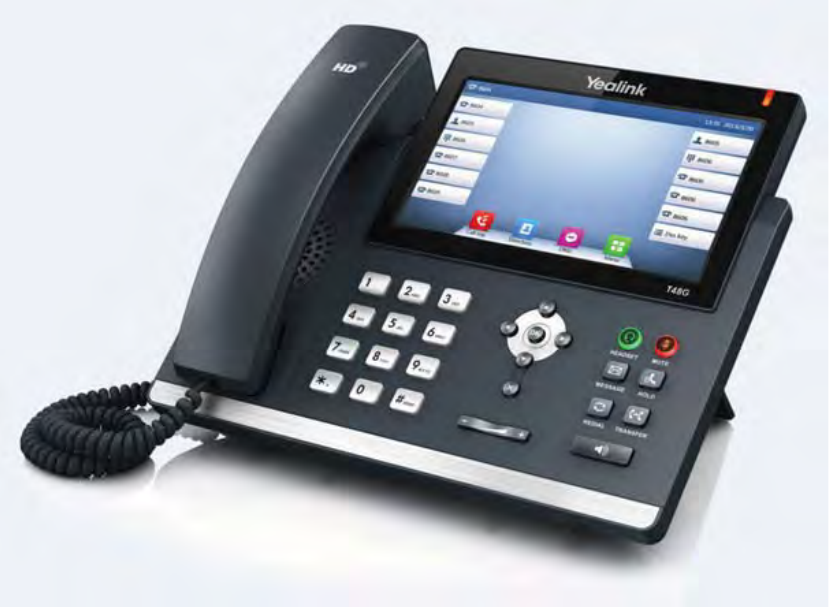

%QR[TKIJV
Copyright © 2013 YEALINK NETWORK TECHNOLOGY CO., LTD.
Copyright © 2013 Yealink Network Technology CO., LTD. All rights reserved. No parts of this
publication may be reproduced or transmitted in any form or by any means, electronic or
mechanical, photocopying, recording, or otherwise, for any purpose, without the express
written permission of Yealink Network Technology CO., LTD. Under the law, reproducing includes
translating into another language or format.
When this publication is made available on media, Yealink Network Technology CO., LTD. gives
its consent to downloading and printing copies of the content provided in this file only for
private use but not for redistribution. No parts of this publication may be subject to alteration,
modification or commercial use. Yealink Network Technology CO., LTD. will not be liable for any
damages arising from use of an illegally modified or altered publication.
9CTTCPV[
THE SPECIFICATIONS AND INFORMATION REGARDING THE PRODUCTS IN THIS GUIDE ARE SUBJECT
TO CHANGE WITHOUT NOTICE. ALL STATEMENTS, INFORMATION, AND RECOMMENDATIONS IN
THIS GUIDE ARE BELIEVED TO BE ACCURATE AND PRESENTED WITHOUT WARRANTY OF ANY KIND,
EXPRESS OR IMPLIED. USERS MUST TAKE FULL RESPONSIBILITY FOR THEIR APPLICATION OF
PRODUCTS.
YEALINK NETWORK TECHNOLOGY CO., LTD. MAKES NO WARRANTY OF ANY KIND WITH REGARD
TO THIS GUIDE, INCLUDING, BUT NOT LIMITED TO, THE IMPLIED WARRANTIES OF MERCHANTABILITY
AND FITNESS FOR A PARTICULAR PURPOSE. Yealink Network Technology CO., LTD. shall not be
liable for errors contained herein nor for incidental or consequential damages in connection
with the furnishing, performance, or use of this guide.
&GENCTCVKQPQH%QPHQTOKV[
Hereby, Yealink Network Technology CO., LTD. declares that this phone is in conformity
with the essential requirements and other relevant provisions of the CE, FCC.
%'/CTM9CTPKPI
This device is marked with the CE mark in compliance with EC Directives 2006/95/EC and 2004/108/EC.
2CTV(%%4WNGU
This device is compliant with Part 15 of the FCC Rules. Operation is subject to the following two conditions:
1. This device may not cause harmful interference, and
2. This device must accept any interference received, including interference that may cause undesired

operation.
%NCUU$&KIKVCN&GXKEGQT2GTKRJGTCN
Note: This device is tested and complies with the limits for a Class B digital device, pursuant to Part 15 of the
FCC Rules. These limits are designed to provide reasonable protection against harmful interference in a
residential installation. This equipment generates, uses, and can radiate radio frequency energy and, if not
installed and used in accordance with the instructions, may cause harmful interference to radio
communications. However, there is no guarantee that interference will not occur in a particular installation.
If this equipment does cause harmful interference to radio or television reception, which can be
determined by turning the equipment off and on, the user is encouraged to try to correct the interference
by one or more of the following measures:
1. Reorient or relocate the receiving antenna.
2. Increase the separation between the equipment and receiver.
3. Connect the equipment into an outlet on a circuit different from that to which the receiver is connected.
4. Consult the dealer or an experience radio/TV technician for help.
9'''9CTPKPI
To avoid the potential effects on the environment and human health as a result of the
presence of hazardous substances in electrical and electronic equipment, end users of
electrical and electronic equipment should understand the meaning of the crossed-out
wheeled bin symbol. Do not dispose of WEEE as unsorted municipal waste and have to
collect such WEEE separately.
)07)2.+0(14/#6+10
Yealink SIP-T48G firmware contains third-party software under the GNU General Public License (GPL). Yealink
uses software under the specific terms of the GPL. Please refer to the GPL for the exact terms and conditions
of the license.
The original GPL license, source code of components licensed under GPL and used in Yealink products can
be downloaded online:
http://www.yealink.com/GPLOpenSource.aspx?BaseInfoCateId=293&NewsCateId=293&CateId=293.

About This Guide
ix
#DQWV6JKU)WKFG
Thank you for choosing the SIP-T48G IP Phone, an ultra-elegant gigabit IP Phone which is
exquisitely designed to provide business telephony features, such as Call Hold, Call
Transfer, Busy Lamp Field, Multicast Paging and Conference over an IP network.
This guide provides everything you need to quickly use your new phone. First, verify with
your system administrator that the IP network is ready for phone configuration. Also be
sure to read the Packaging Contents and Regulatory Notices sections in this guide
before you set up and use the SIP-T48G IP phone.
If this is your first time using the SIP-T48G IP phone, we recommend that you first refer to
the Quick Installation Guide and Quick Reference Guide, available online:
http://www.yealink.com/DocumentDownload.aspx?CateId=142&flag=142
Note
+P6JKU)WKFG
Topics provided in this guide include:
zChapter 1 Overview
zChapter 2 Getting Started
zChapter 3 Customizing Your Phone
zChapter 4 Basic Call Features
zChapter 5 Advanced Phone Features
5WOOCT[QH%JCPIGU
This section describes the changes to this guide for each release and guide version.
%JCPIGUHQT4GNGCUG)WKFG8GTUKQP
Major updates have occurred to the following sections:
zBluetooth Headset on page 61
zRemote PhoneBook on page 55
Shared Line, Busy Lamp Field List, Network Directory and Network Call Log features are
hidden for IP phones in neutral version, which are designed for BroadWorks environment.
Please contact your system administrator for more information.

User Guide for the SIP-T48G IP Phone
x
zLine Keys on page 66
zAnonymous Call on page 124
zTroubleshooting on page 153
zAppendix A - Time Zones on page 167

About This Guide
xi

Overview
1
6CDNGQH%QPVGPVU
About This Guide.........................................................................ix
In This Guide.............................................................................................................................ix
Summary of Changes ............................................................................................................ix
Changes for Release 71, Guide Version 71.150..............................................................ix
Table of Contents .........................................................................1
Overview.......................................................................................4
Hardware Component Instructions ..................................................................................... 4
Icon Instructions ...................................................................................................................... 6
LED Instructions........................................................................................................................ 8
User Interfaces......................................................................................................................... 9
Phone User Interface .......................................................................................................... 9
Web User Interface ............................................................................................................. 9
Documentations................................................................................................................... 11
Getting Started ...........................................................................14
Packaging Contents ............................................................................................................ 14
Phone Installation ................................................................................................................. 16
Phone Initialization................................................................................................................ 19
Phone Status.......................................................................................................................... 19
Basic Network Settings......................................................................................................... 20
Registration............................................................................................................................ 22
Idle Screen............................................................................................................................. 22
Customizing Your Phone............................................................25
General Settings ................................................................................................................... 25
Wallpaper........................................................................................................................... 25
Backlight ............................................................................................................................. 26
Contrast .............................................................................................................................. 27
Language........................................................................................................................... 28
Time & Date........................................................................................................................ 29
Administrator Password .................................................................................................... 31
Key as Send........................................................................................................................ 32
Keypad Lock...................................................................................................................... 32

User Guide for the SIP-T48G IP Phone
2
Audio Settings ....................................................................................................................... 36
Volume................................................................................................................................ 36
Ring Tones........................................................................................................................... 37
Contact Management........................................................................................................ 39
Directory ............................................................................................................................. 39
Local Directory .................................................................................................................. 41
Blacklist................................................................................................................................ 53
Remote PhoneBook ........................................................................................................ 55
Call History Management ................................................................................................... 57
System Customizations......................................................................................................... 59
Headset Use ....................................................................................................................... 59
Bluetooth Headset ............................................................................................................ 61
DSS Keys .............................................................................................................................. 66
Account Management.................................................................................................... 78
Dial Plan .............................................................................................................................. 79
Emergency Number ......................................................................................................... 85
Live Dialpad ....................................................................................................................... 86
Hotline ................................................................................................................................. 87
Basic Call Features.....................................................................90
Placing Calls .......................................................................................................................... 90
Answering Calls..................................................................................................................... 92
Ending Calls ........................................................................................................................... 94
Redialing Numbers ...............................................................................................................94
Recent Call In Dialing ..........................................................................................................94
Auto Answer .......................................................................................................................... 95
Auto Redial............................................................................................................................ 96
Call Completion.................................................................................................................... 98
Call Return ............................................................................................................................. 99
Call Mute ............................................................................................................................. 100
Call Hold/Resume............................................................................................................... 100
Do Not Disturb (DND) ......................................................................................................... 101
Call Forward ........................................................................................................................ 105
Call Transfer ......................................................................................................................... 113
Call Waiting ......................................................................................................................... 115
Conference......................................................................................................................... 116
Local Conference........................................................................................................... 116
Network Conference...................................................................................................... 117
Call Park ............................................................................................................................... 119
Call Pickup........................................................................................................................... 120
Anonymous Call..................................................................................................................124
Anonymous Call Rejection................................................................................................ 125
Advanced Phone Features .....................................................127

Overview
3
Busy Lamp Field (BLF) ......................................................................................................... 127
Call Recording .................................................................................................................... 130
Hot Desking.......................................................................................................................... 132
Intercom............................................................................................................................... 134
Outgoing Intercom Calls................................................................................................ 134
Incoming Intercom Calls................................................................................................ 135
Multicast Paging ................................................................................................................. 137
Sending RTP Stream ........................................................................................................ 137
Receiving RTP Stream ..................................................................................................... 139
Music on Hold...................................................................................................................... 140
Automatic Call Distribution (ACD)................................................................................... 141
Messages ............................................................................................................................. 144
Short Message Service (SMS)......................................................................................... 144
Voice Mail ........................................................................................................................ 147
Message Waiting Indicator (MWI) ................................................................................ 149
Troubleshooting........................................................................153
Regulatory Notices...................................................................164
Service Agreements........................................................................................................... 164
Limitations of Liability.......................................................................................................... 164
Safety Instructions ............................................................................................................... 164
Appendix A - Time Zones........................................................167
Index..........................................................................................169
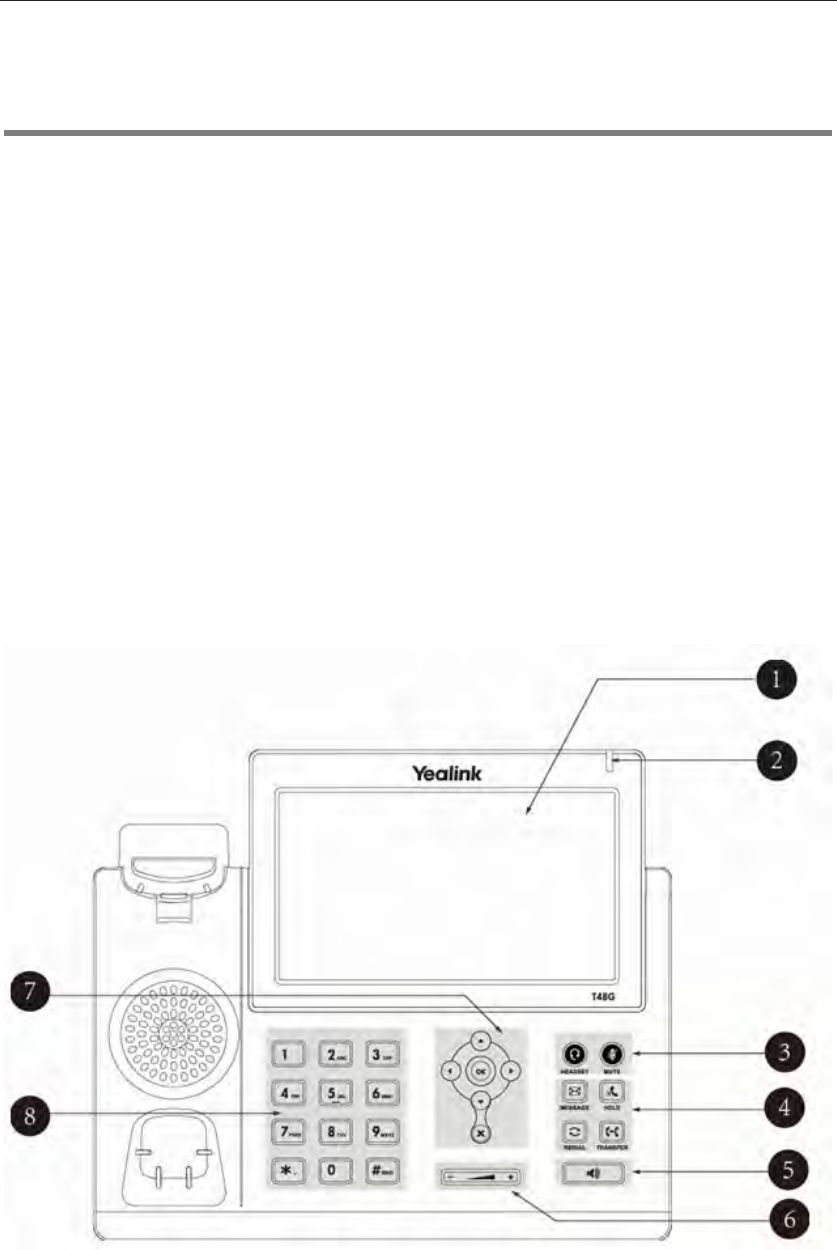
User Guide for the SIP-T48G IP Phone
4
Overview
This chapter provides the overview of the SIP-T48G IP phone. Topics include:
zHardware Component Instructions
zIcon Instructions
zLED Instructions
zUser Interfaces
zDocumentations
If you require additional information or assistance with your new phone, contact your
system administrator.
*CTFYCTG%QORQPGPV+PUVTWEVKQPU
The main hardware components of the SIP-T48G IP phone are the LCD screen and the
keypad.
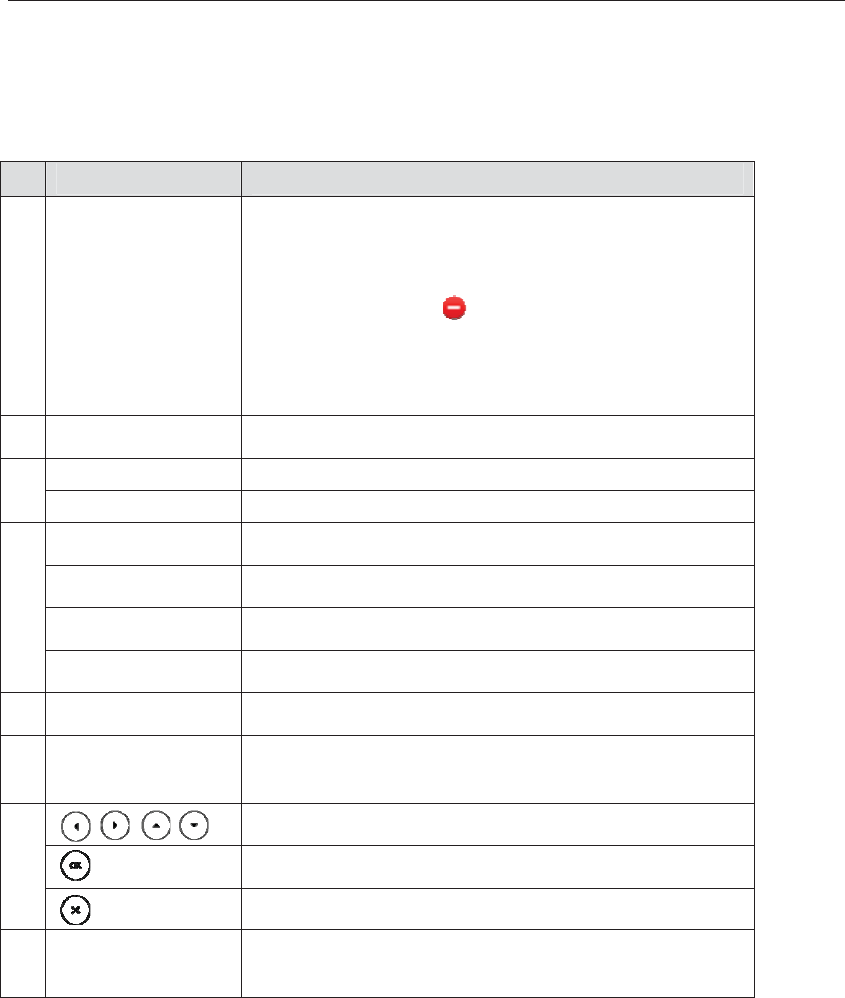
Overview
5
Hardware component instructions of the SIP-T48G IP phone are:
Item Description
Ԙ LCD Screen
Shows information about calls, messages, soft keys, time,
date and other relevant data:
• Call information—caller ID, call duration
• Icons (for example, )
• Missed call text or second incoming caller information
• Prompt text (for example, "Saving file, please wait")
• Time and date
ԙ Power Indicator LED Indicates phone power and some feature statuses.
HEADSET Key Toggles and indicates the headset mode.
Ԛ
MUTE Key Toggles and indicates mute feature.
MESSAGE Key Accesses voice messages.
HOLD Key Places a call on hold or resumes a held call.
REDIAL Key Redials a previously dialed number.
ԛ
TRANSFER Key Transfers a call to another party.
Ԝ Speakerphone Key Toggles the hands-free speakerphone mode.
ԝ Volume Key Adjusts the volume of the handset, headset, speaker,
and ringer.
Scroll through the displayed information.
Confirms actions or answers incoming calls.
Ԟ
Cancels actions or rejects incoming calls.
ԟ
Keypad Provides the digits, letters and special characters in
context-sensitive applications.
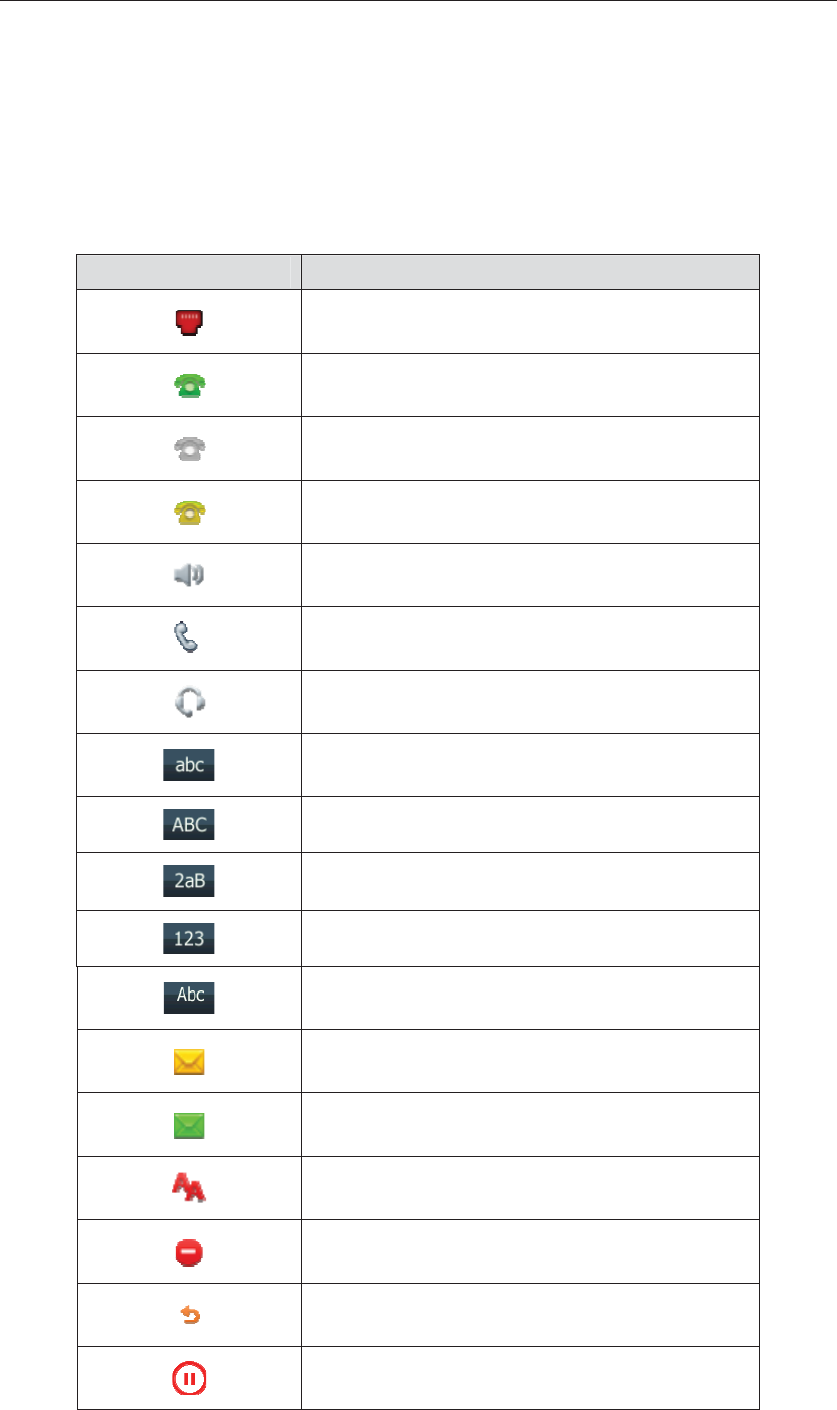
User Guide for the SIP-T48G IP Phone
6
+EQP+PUVTWEVKQPU
Icons appearing on the LCD screen are described in the following table:
Icons Description
Network is unavailable
Registered successfully
Register failed
Registering
Hands-free speakerphone mode
Handset mode
Headset mode
Multi-lingual lowercase letters input mode
Multi-lingual uppercase letters input mode
Alphanumeric input mode
Numeric input mode
Multi-lingual uppercase and lowercase letters
input mode
Voice Mail
Text Message
Auto Answer
Do Not Disturb
Call Forward
Call Hold
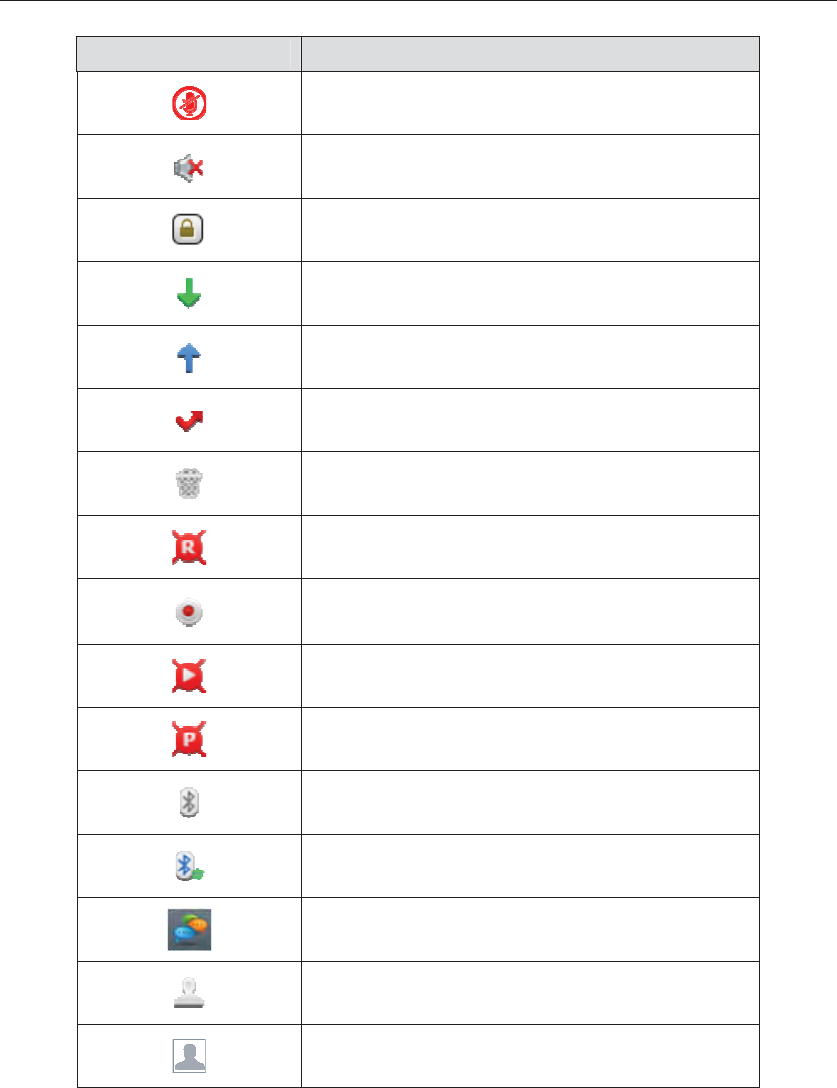
Overview
7
Icons Description
Call Mute
Ringer volume is 0
Keypad Lock
Received Calls
Placed Calls
Missed Calls
Recording box is full
A call cannot be recorded
Recording starts successfully
Recording cannot be started
Recording cannot be stopped
Bluetooth
Bluetooth headset is both paired and connected
Conference
The contact icon
The default caller photo

User Guide for the SIP-T48G IP Phone
8
.'&+PUVTWEVKQPU
Power Indicator LED
LED Status Description
Solid red The phone is initializing.
Fast flashing red The phone is ringing.
Slow flashing red The phone receives a text message or voice mail.
Off The phone is powered off, powered on or idle.

Overview
9
7UGT+PVGTHCEGU
Two ways to customize configurations of your SIP-T48G IP phone:
zThe user interface on the IP phone.
zThe user interface in a web browser on your PC.
The hardware components keypad and LCD screen constitute the phone user
interface, which allows the user to execute all call operation tasks and basic
configuration changes directly on the phone. In addition, you can use the web user
interface to access all configuration settings. In many cases, it is possible to use either
the phone user interface and/or the web user interface interchangeably. However, in
some cases, it is only possible to use one or the other interface to operate the phone
and change settings.
2JQPG7UGT+PVGTHCEG
You can customize your phone by pressing the Menu soft key to access the phone user
interface. The Advanced option is only accessible to the administrator, and the default
administrator password is “admin” (case-sensitive). For more information on customizing
your phone with the available options from the phone user interface, refer to
Customizing Your Phone on page 25.
9GD7UGT+PVGTHCEG
In addition to the phone user interface, you can also customize your phone via web
user interface. In order to access the web user interface, you need to know the IP
address of your new phone. To obtain the IP address, press the OK key on the phone.
Enter the IP address (e.g., http://192.168.0.10 or 192.168.0.10) in the address bar of web
browser on your PC. The default administrator user name and password are both
“admin” (case-sensitive).
The options you can use to customize the IP phone via phone user interface and/or via
web user interface are listed in the following table:
Options Phone User Interface Web User Interface
Status
--IPv4
--MAC
--Firmware
--Network
--Phone

User Guide for the SIP-T48G IP Phone
10
Options Phone User Interface Web User Interface
--Accounts
Basic Call Features
--Auto Answer
--Auto Redial
--Call Completion
--Call Forward
--Call Waiting
--Call Park
--Call Pickup
--Call Return
--Conference
--Anonymous Call
--Anonymous Call Rejection
--DND
Basic Phone Settings
--Language
--Time & Date
--Administrator Password
--Ring Tones
--Contrast
--Wallpaper
--Backlight
--Keypad Lock
--Phone Volume
--Call History Management
--Contact Management
--Local Directory
--Blacklist
--Remote Phone Book
--LDAP
--Dial Plan
--DSS Keys
--Key as Send
--Hotline
--Live Dialpad
--Emergency Number
Advanced Phone Features
--BLF
--Call Recording
--Hot Desking

Overview
11
--Intercom
--Multicast Paging
--Music on Hold
--ACD
--Messages
SIP Account
--User Options
--Register Status
--Account Status
--Label
--Display Name
--Register Name
--User Name
--Password
--SIP Server 1/2
--Server Option
--Registrar Port
--Outbound Status
--Outbound Proxy
--NAT Traversal
--STUN Status
--STUN Server
Note
&QEWOGPVCVKQPU
The following table shows documentations available for the SIP-T48G IP phone.
Name Contents Where found Format/ Language
Quick Installation
Guide
Basic setup of the
phone
In the
package PDF/English
Quick Reference
Guide
Basic call features
and phone
customizations
In the
package PDF/English
User Guide
Phone/Web user
interface settings
Basic call features
and advanced
phone features
CD attached
in the package PDF/English
The table above lists most of the feature options. Please refer to the relevant sections for
more information.

User Guide for the SIP-T48G IP Phone
12
Note
You can also download the latest documentations online:
http://www.yealink.com/DocumentDownload.aspx?CateId=142&flag=142.

Overview
13

User Guide for the SIP-T48G IP Phone
14
)GVVKPI5VCTVGF
This chapter provides the following basic installation instructions and information for
obtaining the best performance with the SIP-T48G IP phone. Topics include:
zPackaging Contents
zPhone Installation
zPhone Initialization
zPhone Status
zBasic Network Settings
zRegistration
zIdle Screen
If you require additional information or assistance with your new phone, contact your
system administrator.
2CEMCIKPI%QPVGPVU
The following components are included in your SIP-T48G IP phone package:
z SIP-T48G IP Phone
z Phone Stand

Getting Started
15
z Wall Mount Bracket (Optional)
z Power Adapter (Optional)
z Handset & Handset Cord
z Ethernet Cable
z Quick Installation Guide & Quick Reference Guide

User Guide for the SIP-T48G IP Phone
16
zCD-ROM
Check the list before installation. If you find anything missing, contact your system
administrator.
2JQPG+PUVCNNCVKQP
If your phone is already installed, proceed to Phone Initialization on page 19.
This section introduces how to install the phone:
1) Attach the stand or the optional wall mount bracket
2) Connect the handset and optional headset
3) Connect the network and power
1) Attach the stand or the optional wall mount bracket
Desk Mount Method

Getting Started
17
Wall Mount Method (Optional)
Note
2) Connect the handset and optional headset
Note
3) Connect the network and power
You have two options for power and network connections. Your system administrator
will advise you which one to use.
zAC power (Optional)
zPower over Ethernet (PoE)
AC Power (Optional)
To connect the AC power:
The headset, wireless headset adapter EHS36 and Bluetooth USB dongle BT40 should be
purchased separately.
The EXT port can also be used to connect an expansion module EXP40.
For more information on how to use EHS36, EXP40 and Bluetooth USB Dongle BT40, refer
to Yealink EHS36 User Guide, Yealink EXP40 User Guide and Yealink Bluetooth USB Dongle
BT40 User Guide.
The wall mount bracket should be purchased separately. For more information on how
to attach the wall mount bracket, refer to Yealink Wall Mount Quick Installation Guide
for T4X IP Phones.
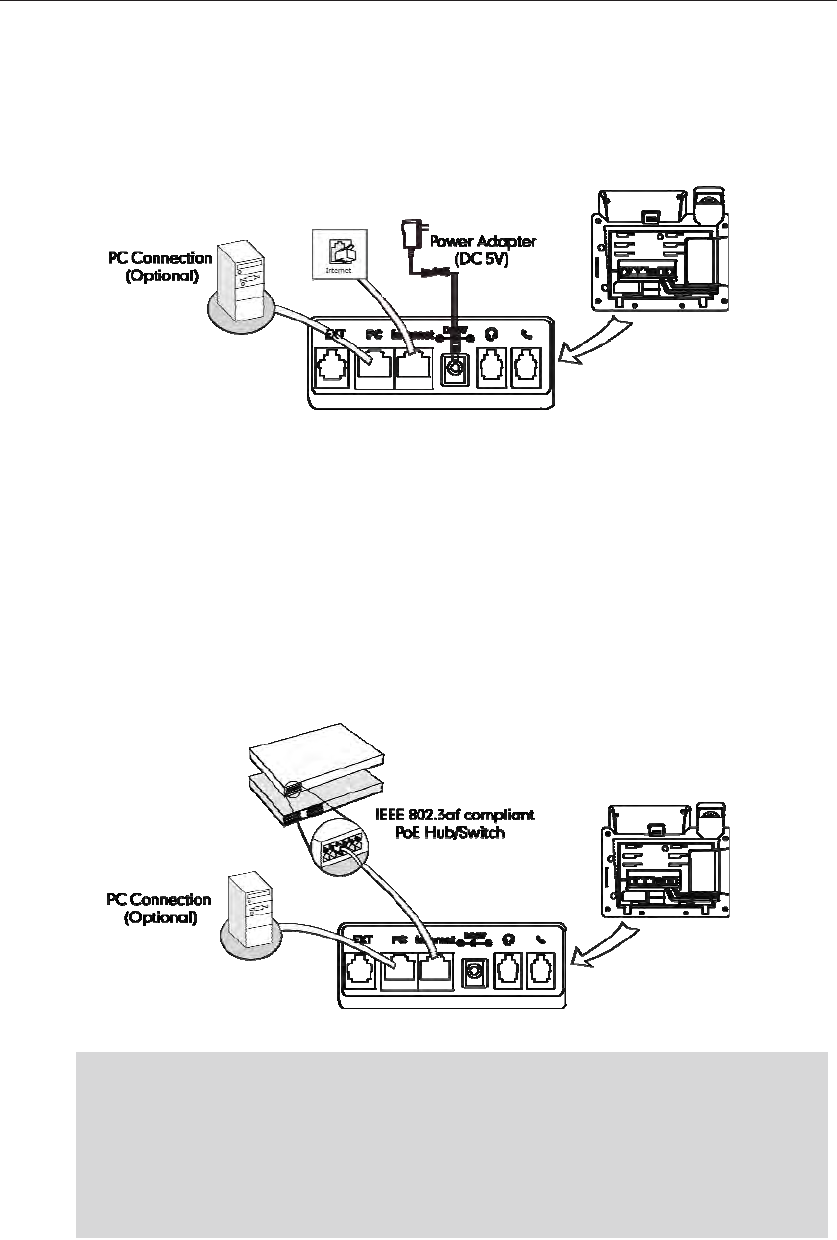
User Guide for the SIP-T48G IP Phone
18
1. Connect the DC plug on the power adapter to the DC5V port on the phone and
connect the other end of the power adapter into an electrical power outlet.
2. Connect the included or a standard Ethernet cable between the Internet port on
the phone and the one on the wall or switch/hub device port.
Power over Ethernet
With the included or a regular Ethernet cable, the SIP-T48G IP phone can be powered
from a PoE-compliant switch or hub.
To connect the PoE:
1. Connect the Ethernet cable between the Internet port on the phone and an
available port on the in-line power switch/hub.
Note If in-line power switch/hub is provided, you don’t need to connect the phone to the
power adapter. Make sure the switch/hub is PoE-compliant.
The phone can also share the network with another network device such as a PC
(personal computer). It is an optional connection.
Important! Do not unplug or remove power to the phone while it is updating firmware
and configurations.
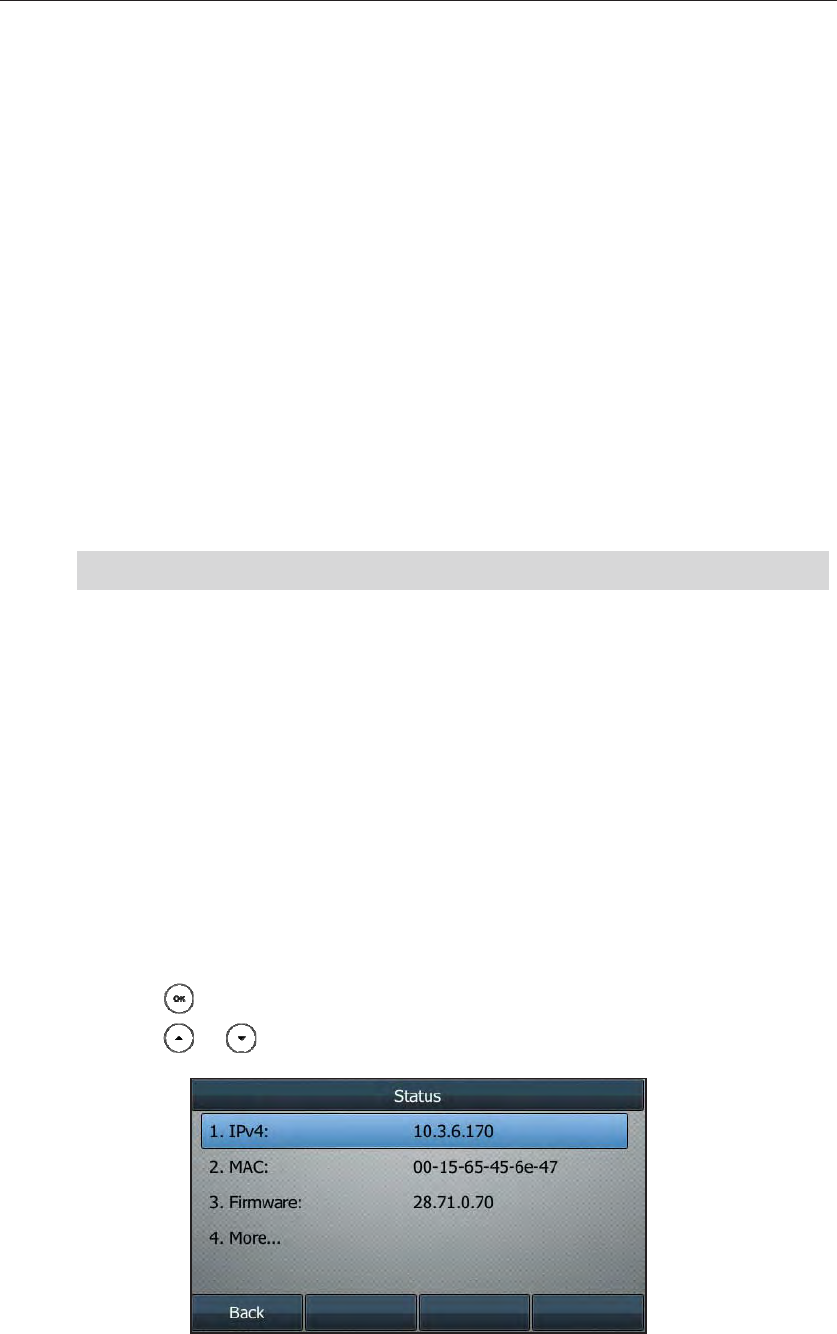
Getting Started
19
2JQPG+PKVKCNK\CVKQP
After your phone is powered on, the system boots up and performs the following steps:
Automatic Phone Initialization
The phone finishes the initialization by loading the saved configuration. The LCD screen
displays "Initializing…Please wait" during this process
DHCP (Dynamic Host Configuration Protocol)
The phone attempts to contact a DHCP server in your network to obtain valid IPv4
network settings (e.g., IP address, subnet mask, default gateway address and DNS
address) by default.
Note
2JQPG5VCVWU
You can view phone status via phone user interface or web user interface.
Available information of phone status includes:
zNetwork status (e.g., IPv4 status, IPv6 status, IP address mode and MAC address).
zPhone status (e.g., device model, firmware version and product ID).
zAccount status (e.g., register status of SIP accounts).
To view the phone status via phone user interface:
1. Press , or press Menu->Status.
2. Press or to scroll through the list and view the specific information.
To view the phone status via web user interface:
If your network does not use DHCP, proceed to Basic Network Settings on page 15.
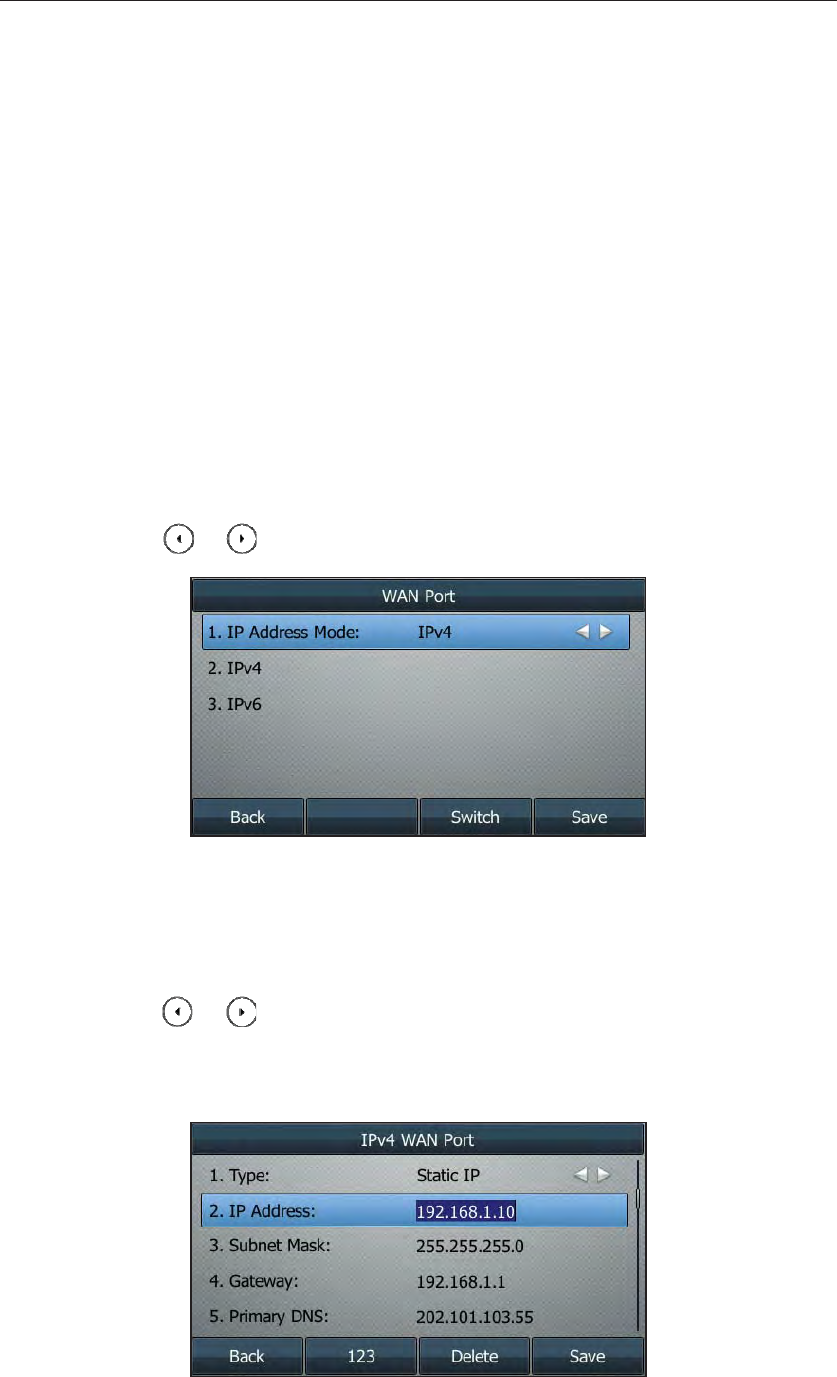
User Guide for the SIP-T48G IP Phone
20
1. Open the web browser on your computer.
2. Enter the IP address in the browser’s address bar, and then press the Enter key.
3. Enter the user name (admin) and password (admin) in the login page.
4. Click Confirm to login.
The phone status is displayed on the first page of the web user interface.
$CUKE0GVYQTM5GVVKPIU
If your phone cannot contact a DHCP server for any reason, you need to configure
network settings manually. The IP phone can support either or both IPv4 and IPv6
addresses.
To configure the IP address mode via phone user interface:
1. Press Menu->Advanced (password: admin) ->Network->WAN Port.
2. Press or to select IPv4, IPv6 or IPv4 & IPv6 from the IP Address Mode field.
3. Press the Save soft key to accept the change or the Back soft key to cancel.
To configure a static IPv4 address via phone user interface:
1. Press Menu->Advanced (password: admin) ->Network->WAN Port->IPv4.
2. Press or , or the Switch soft key to select the Static IP from the Type field.
3. Enter the desired values in the IP Address, Subnet Mask, Gateway, Primary DNS and
Secondary DNS fields respectively.
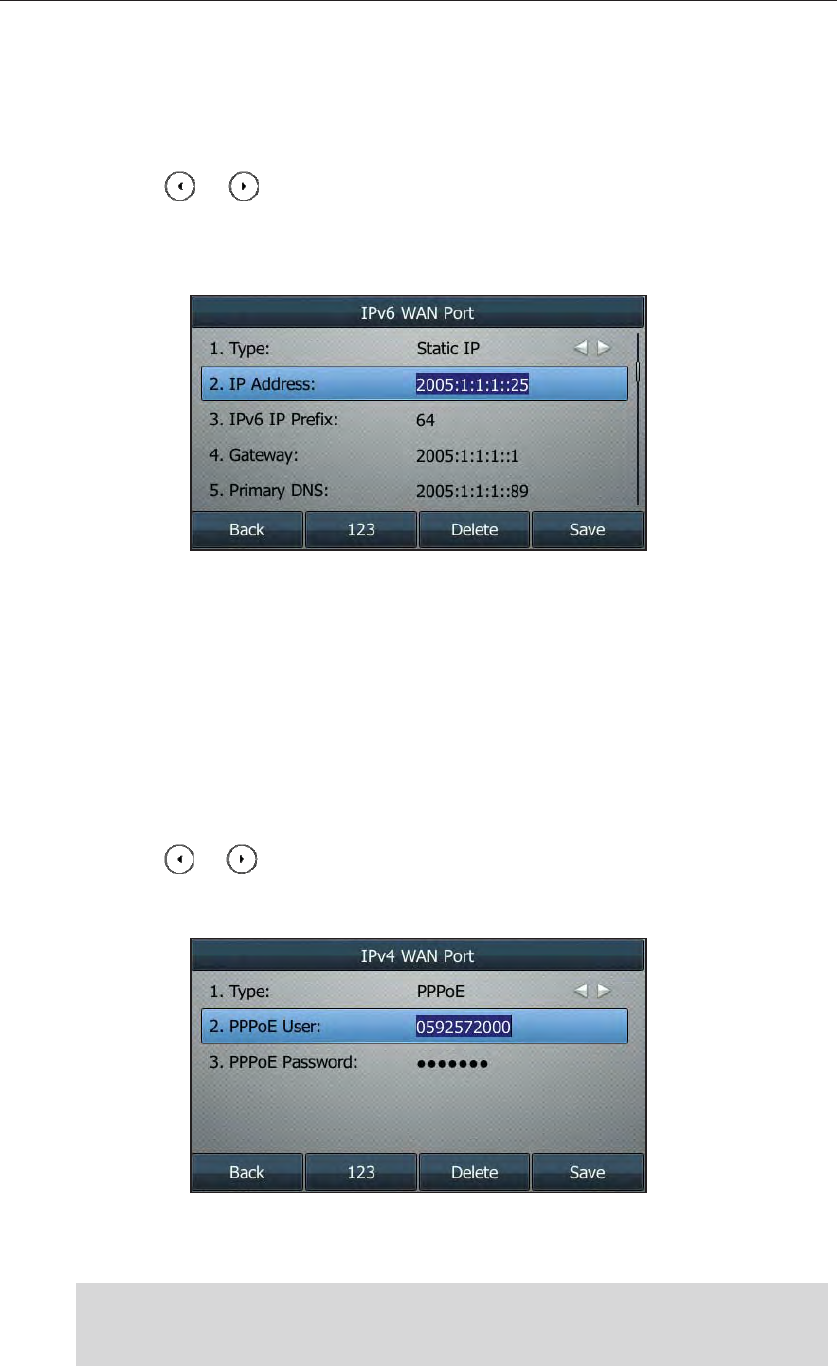
Getting Started
21
4. Press the Save soft key to accept the change or the Back soft key to cancel.
To configure a static IPv6 address via phone user interface:
1. Press Menu->Advanced (password: admin) ->Network->WAN Port->IPv6.
2. Press or , or the Switch soft key to select the Static IP from the Type field.
3. Enter the desired values in the IP Address, IPv6 IP Prefix, Gateway, Primary DNS and
Secondary DNS fields respectively.
4. Press the Save soft key to accept the change or the Back soft key to cancel.
If you are using an xDSL modem, you can connect your phone to the Internet via PPPoE
mode. Set the WAN port as a PPPoE port. The PPPoE port will perform a PPP negotiation
to obtain the IP address. Contact your system administrator for the PPPoE user name
and password.
To configure PPPoE via phone user interface:
1. Press Menu->Advanced (password: admin) ->Network->WAN Port->IPv4.
2. Press or , or the Switch soft key to select the PPPoE from the Type field.
3. Enter the user name and password in the corresponding fields.
4. Press the Save soft key to accept the change or the Back soft key to cancel.
Note Using the wrong network parameters may result in inaccessibility of your phone and may
also have an impact on your network performance. For more information on these
parameters, contact your system administrator.
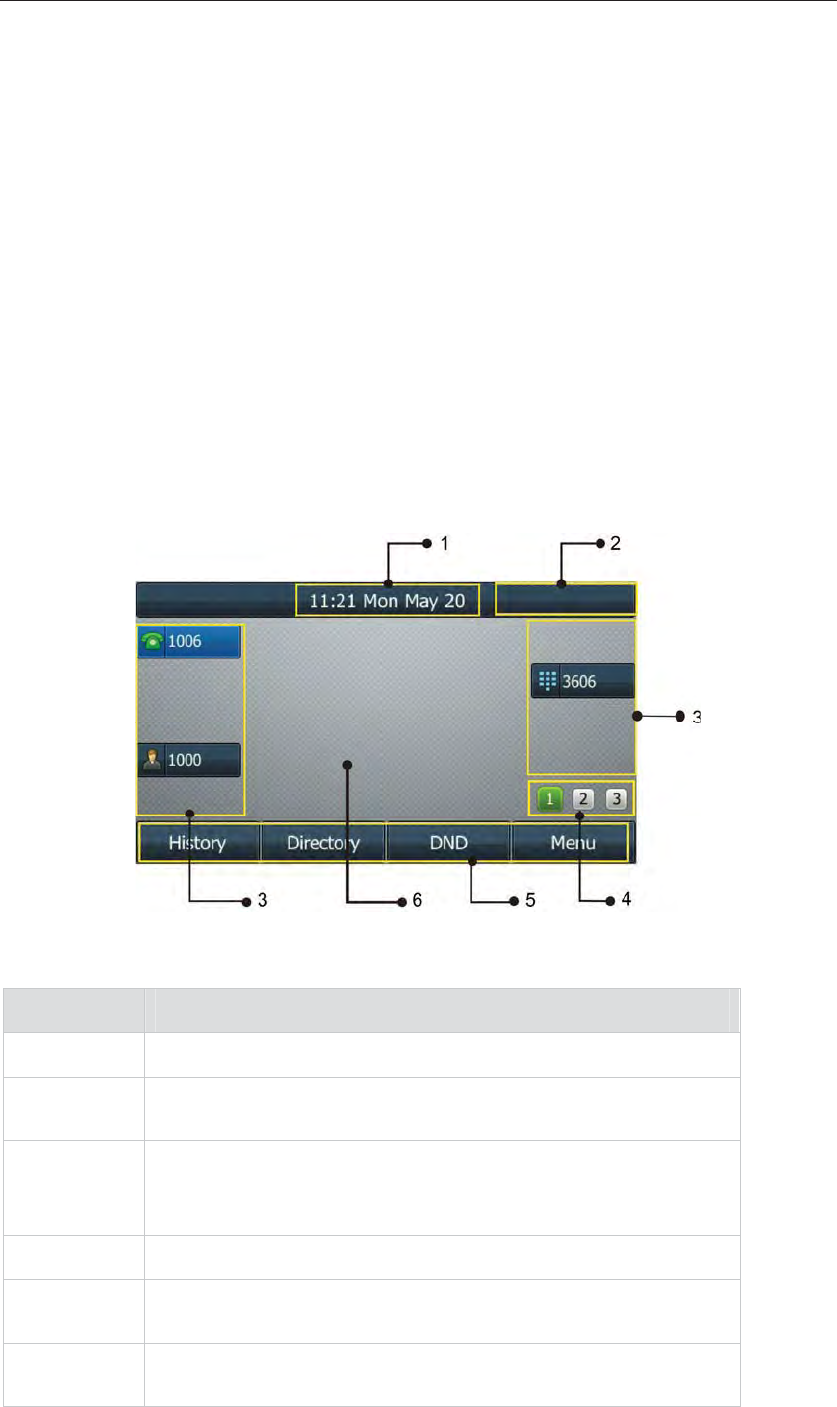
User Guide for the SIP-T48G IP Phone
22
4GIKUVTCVKQP
Generally, your phone will be deployed with multiple other phones. In this case, your
system administrator will configure the phone parameters beforehand, so that after you
start up your phone, the phone will be registered and ready for use. If your phone is not
registered, you may have to register it. For more information on how to register your
phone, refer to Account Management on page 78.
+FNG5ETGGP
If the phone has successfully started up, the idle LCD screen will be shown as below.
Idle Screen description:
No. Description
1 This area shows the phone’s time and date.
2 This area shows the phone feature status. For more information,
refer to Icon Instructions on page 6.
3
This area shows the line key labels. You can customize the line key
as other functions. For more information, refer to Line Keys on
page 66.
4 This area shows three page icons.
5 This area shows the soft key labels. The default soft key labels are
“History”, “Directory”, “DND” and “Menu”.
6 This area shows the wallpaper. You can customize the wallpaper.
For more information, refer to Wallpaper on page 25.

Getting Started
23

User Guide for the SIP-T48G IP Phone
24

Customizing Your Phone
25
%WUVQOK\KPI;QWT2JQPG
You can customize your SIP-T48G IP phone by personally configuring certain settings, for
example, contrast, time & date and ring tones. You can add contacts to the phone’s
local directory manually or from call history. You can also personalize different ring
tones for different callers.
This chapter provides basic operating instructions for customizing your phone. Topics
include:
zGeneral Settings
zAudio Settings
zContact Management
zCall History Management
zSystem Customizations
If you require additional information or assistance with your new phone, contact your
system administrator.
)GPGTCN5GVVKPIU
9CNNRCRGT
You can customize the wallpaper of the SIP-T48G IP phone. You can change the
wallpaper image via phone user interface or web user interface. You can also upload
custom wallpaper images via web user interface. The file format of wallpaper image
must be .jpg, .png or .bmp. Contact your system administrator for the detailed
requirement of the file format.
To change the wallpaper via phone user interface:
1. Press Menu->Basic->Display->Wallpaper.
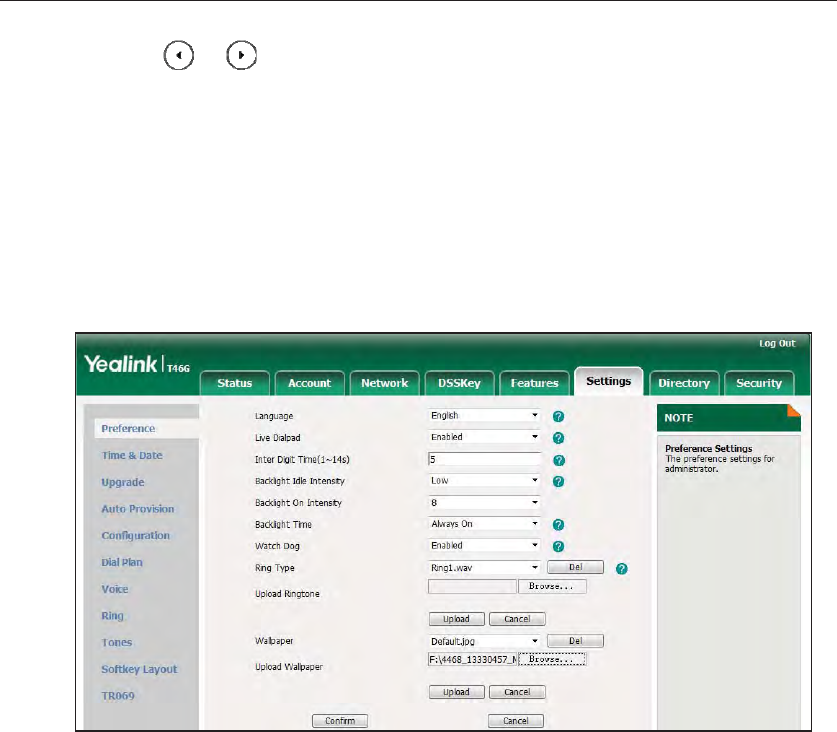
User Guide for the SIP-T48G IP Phone
26
2. Press or , or the Switch soft key to select the desired wallpaper image.
3. Press the Save soft key to accept the change or the Back soft key to cancel.
Wallpaper is configurable via web user interface at the path Settings->Preference.
To upload the customized wallpaper via web user interface:
1. Click on Settings->Preference.
2. In the Upload Wallpaper field, click Browse to select the wallpaper image from your
local system.
3. Click Upload to upload the file.
4. Click Confirm to accept the change.
The customized wallpaper appears in the pull-down list of Wallpaper.
$CEMNKIJV
You can configure backlight to adjust the brightness of the LCD screen. Backlight On
Intensity is used to adjust the backlight intensity of the LCD screen. Backlight time
specifies the delay time to turn off or dusky the backlight when the IP phone is inactive.
Backlight Idle Intensity decides whether the IP phone turns off or dusky the backlight of
the LCD screen after a period of inactivity.
You can configure the backlight status on the LCD screen as the following types:
zAlways On: Backlight is on permanently.
z1min, 2min, 5min, 10min, 30min: Backlight goes out or turns dusky when the phone has
been inactive for approximately 1min, 2min, 5min, 10min or 30min.
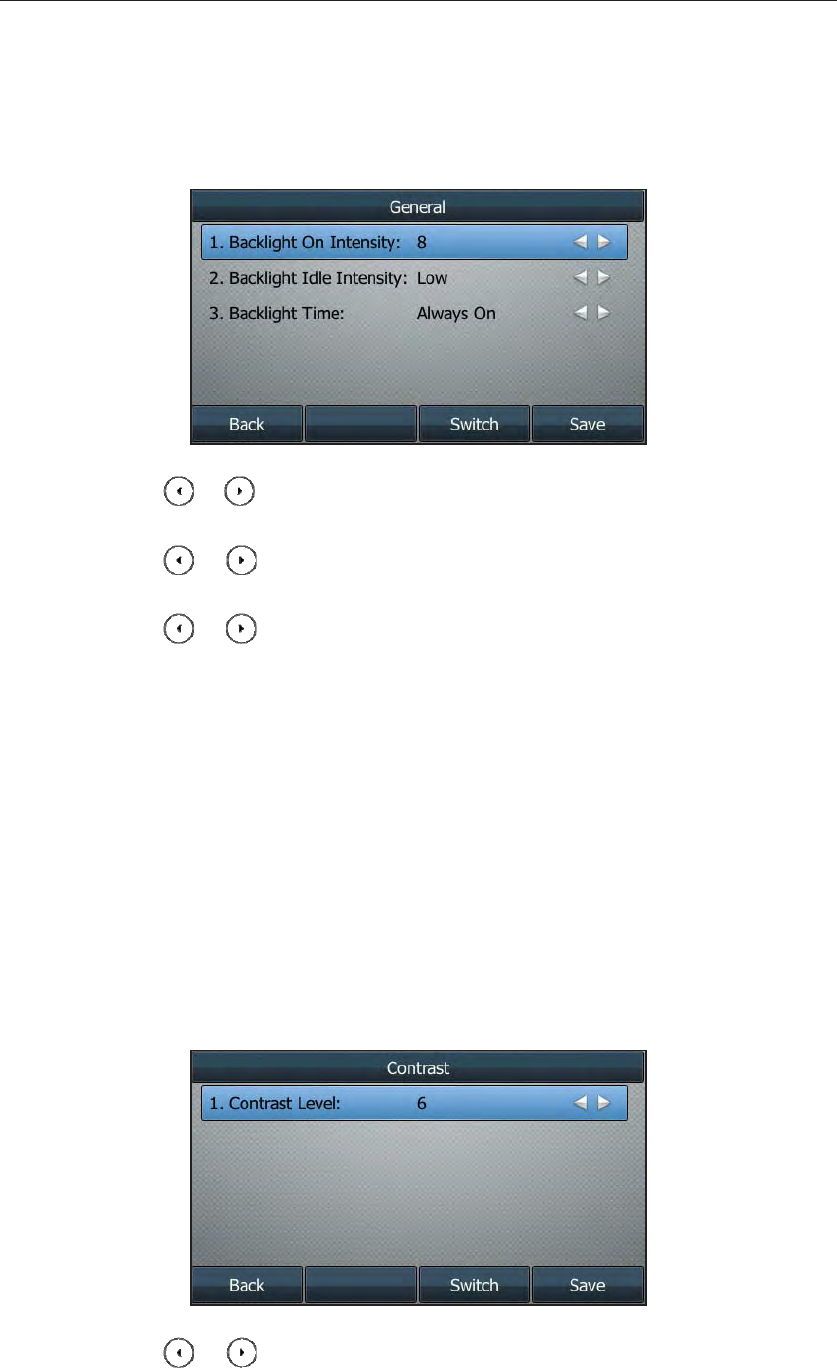
Customizing Your Phone
27
To configure the backlight via phone user interface:
1. Press Menu->Basic->Display->General.
2. Press or , or the Switch soft key to select the desired level from the
Backlight On Intensity field.
3. Press or , or the Switch soft key to select the desired value from the
Backlight Idle Intensity field.
4. Press or , or the Switch soft key to select the desired time from the
Backlight Time field.
5. Press the Save soft key to accept the change or the Back soft key to cancel.
Backlight is configurable via web user interface at the path Settings->Preference.
%QPVTCUV
You can configure the contrast of the expansion module (EXP40) to a comfortable level.
Ensure the expansion module has been connected to the phone.
To configure the contrast via phone user interface:
1. Press Menu->Advanced (password: admin) ->Phone Settings->Contrast.
2. Press or , or the Switch soft key to increase or decrease the intensity of
contrast.
The default contrast level is 6.
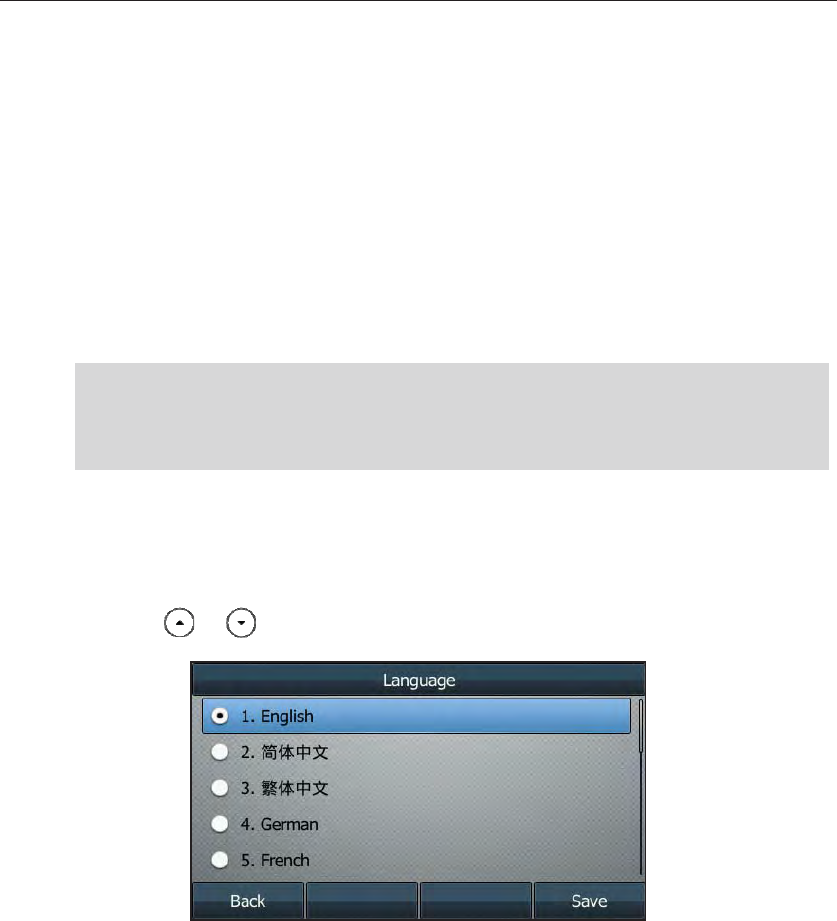
User Guide for the SIP-T48G IP Phone
28
3. Press the Save soft key to accept the change or the Back soft key to cancel.
.CPIWCIG
The default language of the phone user interface is English. The phone will detect and
use the same language as which of your web browser for the web user interface. If the
language of your web browser is not supported by the phone, the web user interface
will use English by default. You can change the language for the phone user interface
and the web user interface respectively.
Note
To change the language for the phone user interface:
1. Press Menu->Basic->Language.
2. Press or to select the desired language.
3. Press the Save soft key to accept the change.
Text displayed on the phone user interface will change to the selected language.
To change the language for the web user interface:
1. Click on Settings->Preference.
Not all of the supported languages are available for selection. The available languages
depend on the language packs currently loaded to the IP phone. Please contact your
system administrator for more information on the available languages of your new
phone.
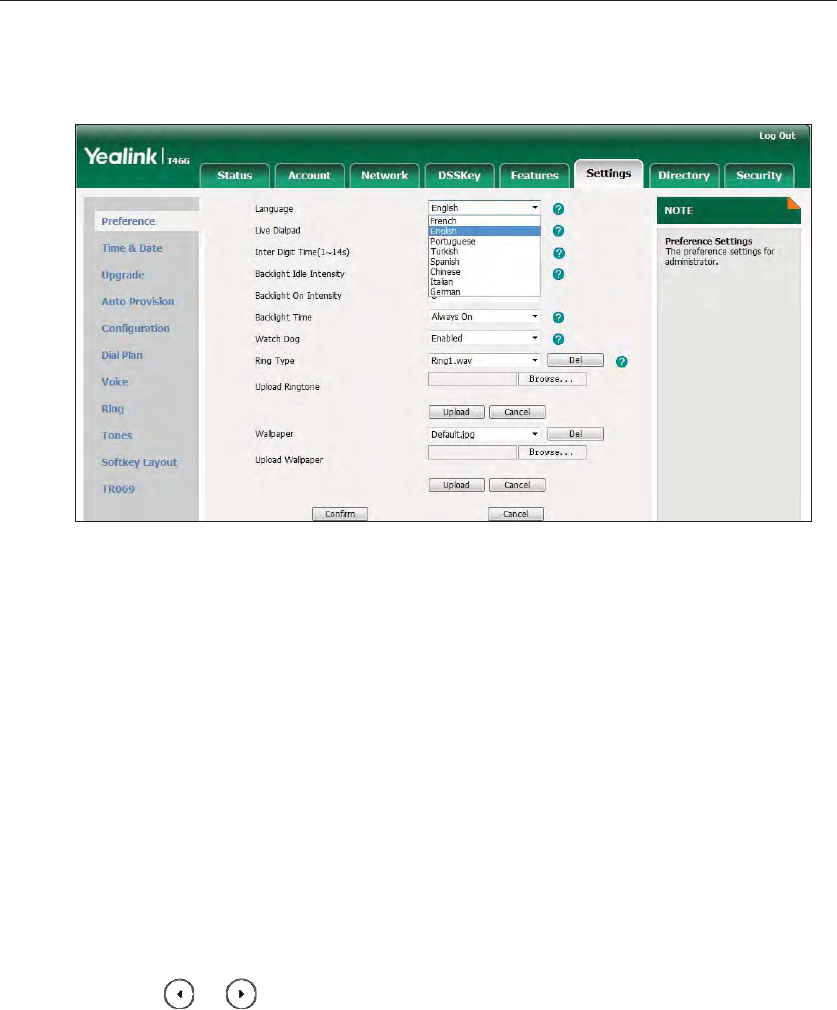
Customizing Your Phone
29
2. Select the desired language from the pull-down list of Language.
3. Click Confirm to accept the change.
Text displayed on the web user interface will change to the selected language.
6KOG&CVG
The time and date are displayed on the LCD screen when the phone is idle. You can
configure the phone to obtain the time and date from the SNTP server automatically, or
configure the time and date manually. If the phone cannot obtain the time and date
from the Simple Network Time Protocol (SNTP) server, contact your system administrator
for more information.
To configure the SNTP settings via phone user interface:
1. Press Menu->Basic->Time & Date->General->SNTP Settings.
2. Press or , or the Switch soft key to select the time zone that applies to your
area from the Time Zone field.
The default time zone is "+8 China(Beijing)".
3. Enter the domain names or IP addresses in the NTP Server 1 and NTP Server 2 fields
respectively.
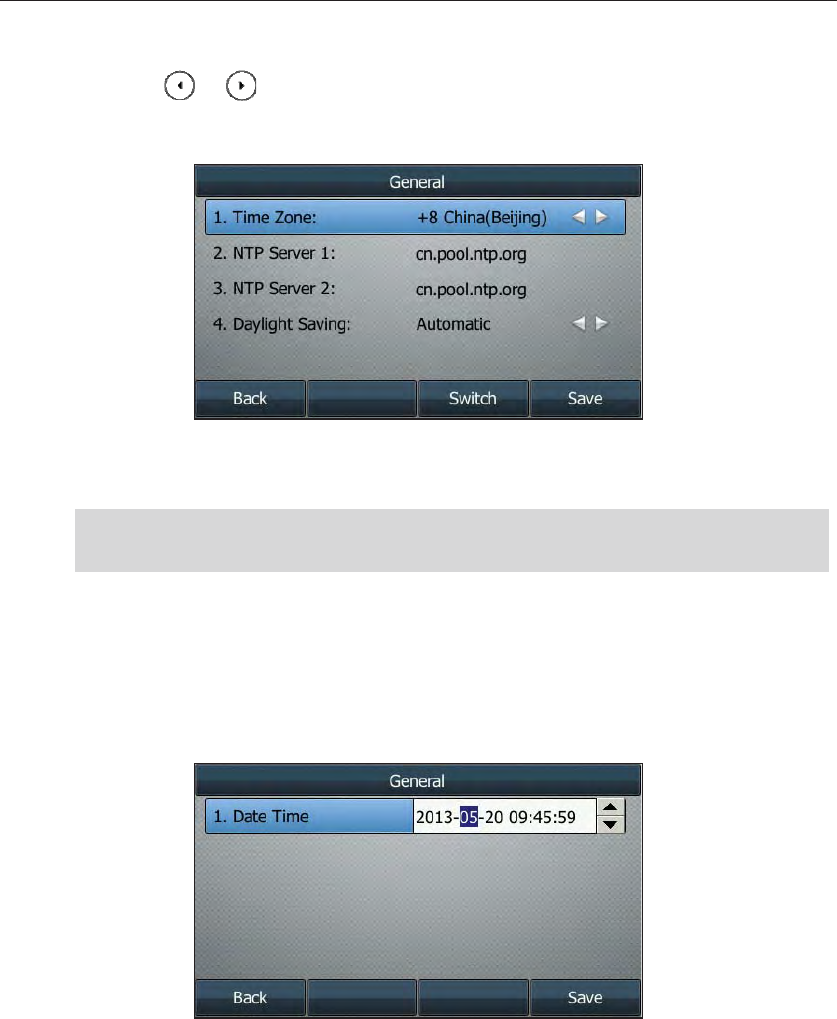
User Guide for the SIP-T48G IP Phone
30
4. Press or , or the Switch soft key to select the desired value from the
Daylight Saving field.
5. Press the Save soft key to accept the change or the Back soft key to cancel.
Note
To configure the time and date manually via phone user interface:
1. Press Menu->Basic->Time & Date->General->Manual Settings.
2. Enter the specific date and time.
3. Press the Save soft key to accept the change.
The time and date displayed on the LCD screen will change accordingly.
To configure the date and time format via phone user interface:
1. Press Menu->Basic->Time & Date->Format.
Please refer to Appendix A - Time Zones for the list of available time zones on the IP
phone.
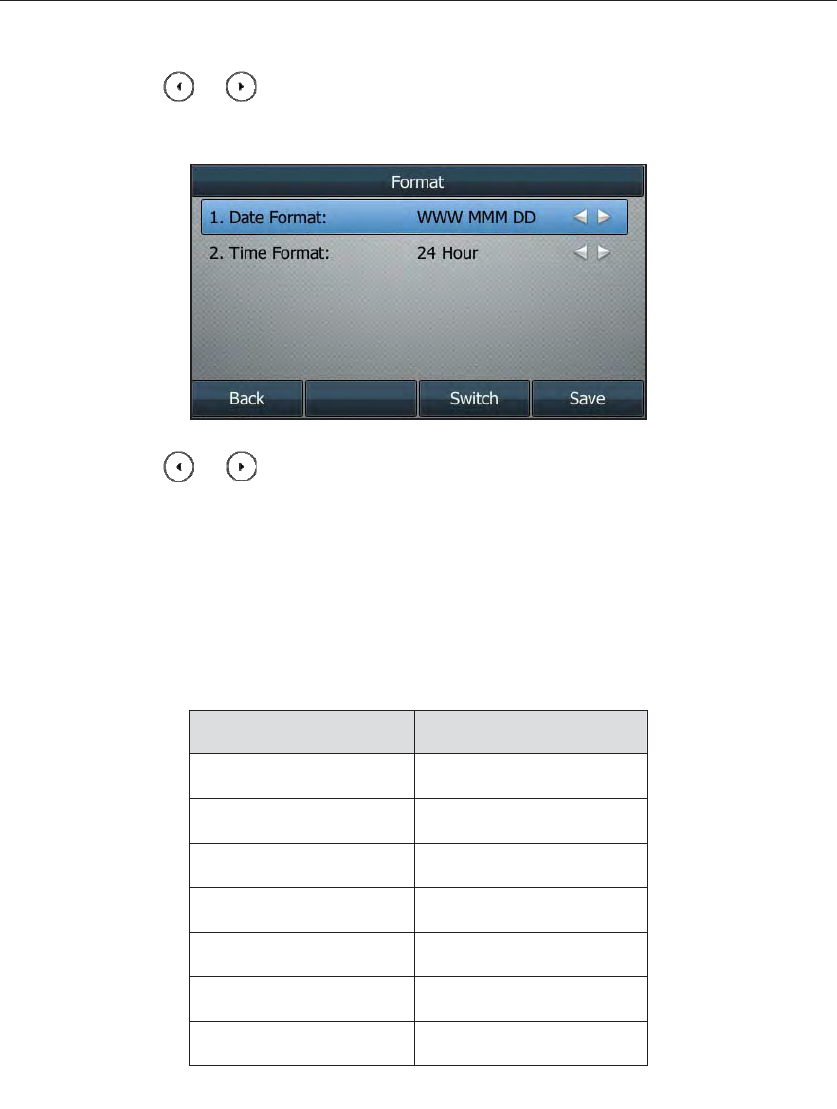
Customizing Your Phone
31
2. Press or , or the Switch soft key to select the desired date format from the
Date Format field.
3. Press or , or the Switch soft key to select the desired time format (12 Hour or
24 Hour) from the Time Format field.
4. Press the Save soft key to accept the change or the Back soft key to cancel.
There are 7 available date formats. For example, for the date format “WWW DD MMM”,
“WWW” represents the abbreviation of the week, “DD” represents the two-digit day,
and “MMM” represents the first three letters of the month.
The date formats you need to know:
Date Format Example (2013-7-27)
WWW MMM DD Sat Jul 27
DD-MMM-YY 27-Jul-13
YYYY-MM-DD 2013-07-27
DD/MM/YYYY 27/07/2013
MM/DD/YY 07/27/13
DD MMM YYYY 27 Jul 2013
WWW DD MMM Sat 27 Jul
Time and date is configurable via web user interface at the path Settings->Time & Date.
#FOKPKUVTCVQT2CUUYQTF
The Advanced option is only accessible to the administrator. The default administrator
password is “admin”. For security reasons, you should change the default administrator
password as soon as possible.
To change the administrator password via phone user interface:
1. Press Menu->Advanced (password: admin) ->Set Password.
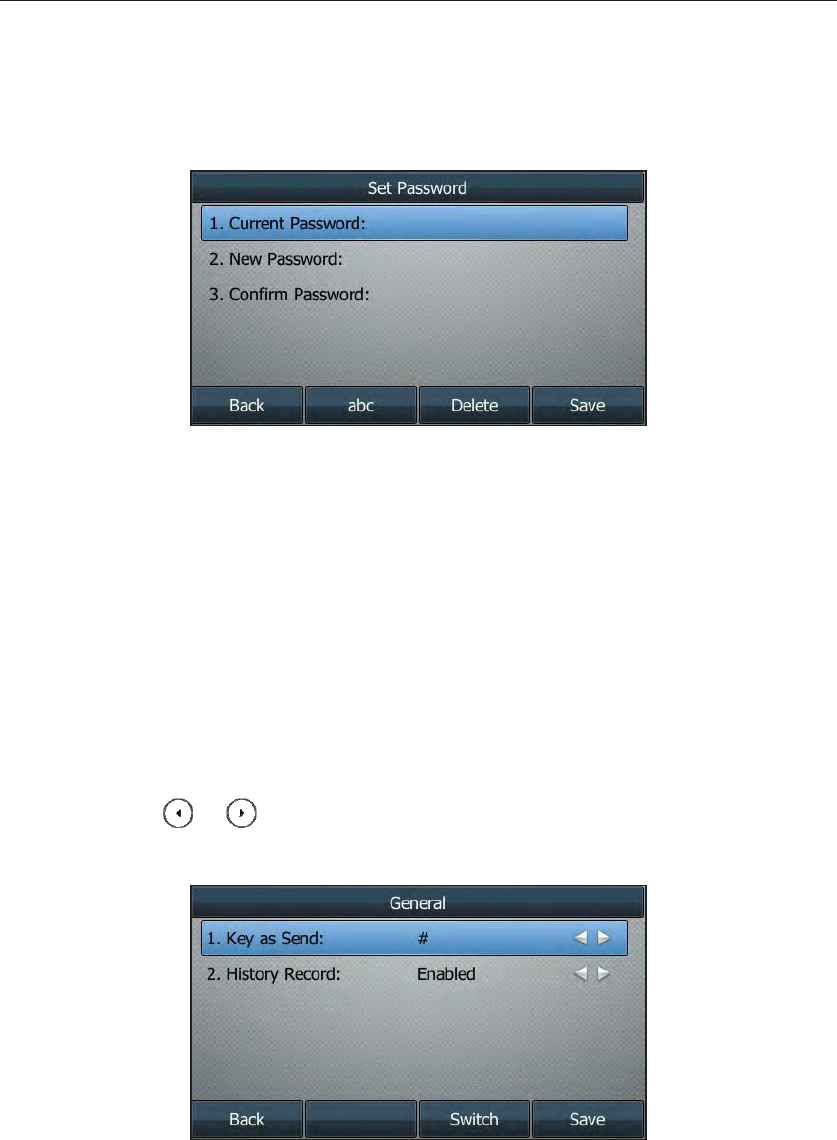
User Guide for the SIP-T48G IP Phone
32
2. Enter the old password in the Current Password field.
3. Enter the new password in the New Password field.
4. Enter the new password again in the Confirm Password field.
5. Press the Save soft key to accept the change or the Back soft key to cancel.
Administrator password is configurable via web user interface at the path
Security->Password.
-G[CU5GPF
You can set the "#" or "*" to perform as a send key while dialing.
To configure key as send via phone user interface:
1. Press Menu->Call Features->Others->General.
2. Press or , or the Switch soft key to select # or * from the Key as Send field, or
select Disabled to disable this feature.
3. Press the Save soft key to accept the change or the Back soft key to cancel.
Key as send is configurable via web user interface at the path Features->General
Information.
-G[RCF.QEM
You can lock the keypad of your phone temporarily when you are not using it. This
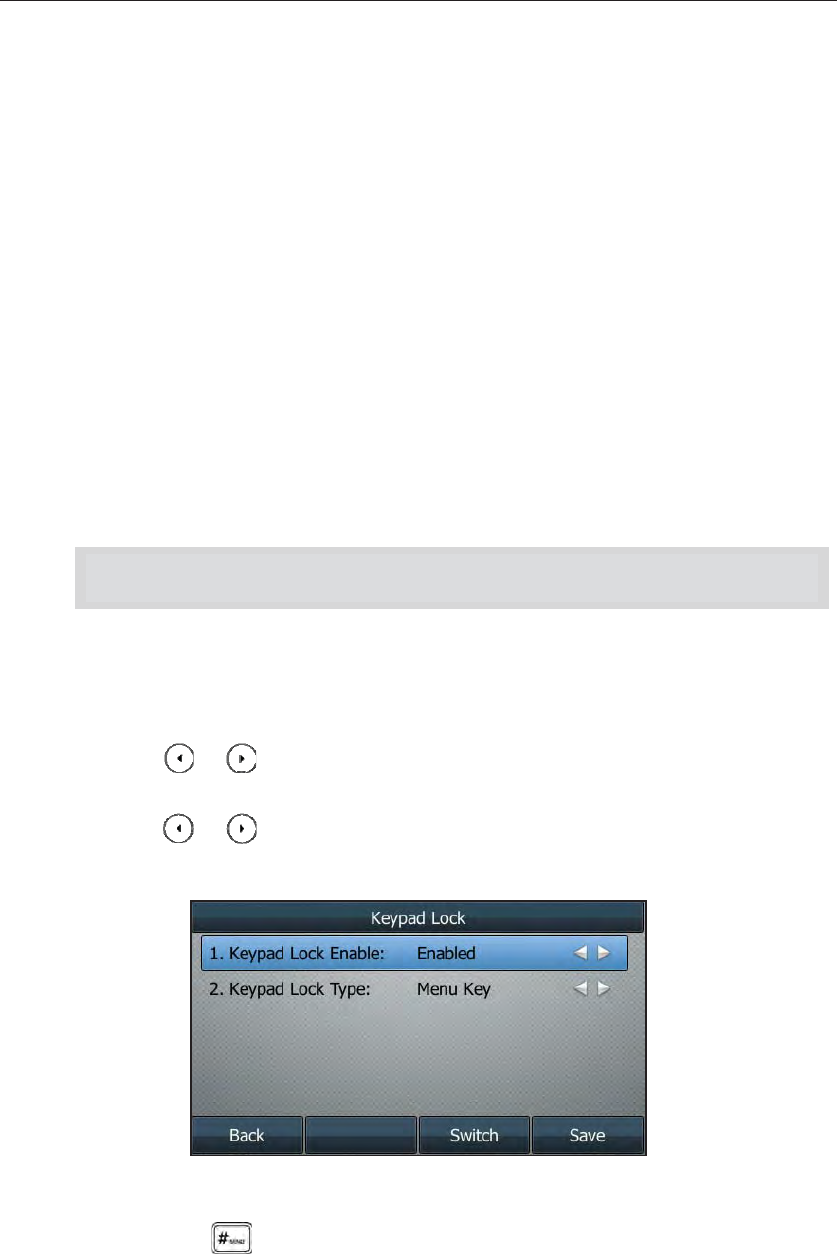
Customizing Your Phone
33
feature helps to protect your phone from unauthorized use.
Keypad lock consists of the following:
Menu Key: The Menu soft key is locked. You cannot access the menu of the
phone until unlocked.
Function Keys: The function keys are locked. You cannot use the MESSAGE,
REDIAL, HOLD, MUTE, TRANSFER, OK, X, navigation keys, soft
keys and line keys until unlocked.
All Keys: All keys are locked except the Volume key. You are only
allowed to dial emergency numbers, reject incoming calls by
pressing the X key, answer incoming calls by lifting the handset,
pressing the Speakerphone key, the HEADSET key or the OK key,
mute an active call by pressing the X key, place an active call
on hold by pressing the Hold soft key, resume the held call by
pressing the Resume soft key, and end the call by hanging up
the handset or pressing the Speakerphone key.
Note
To activate the keypad lock via phone user interface:
1. Press Menu->Advanced (password: admin) ->Phone Settings->Keypad Lock.
2. Press or , or the Switch soft key to select Enabled from the Keypad Lock
Enable field.
3. Press or , or the Switch soft key to select the desired type from the Keypad
Lock Type field.
4. Press the Save soft key to accept the change.
Long press to lock the keypad immediately when the phone is idle.
The emergency number setting, if desired, must be made before lock activation. For
more information, refer to Emergency Number on page 78.
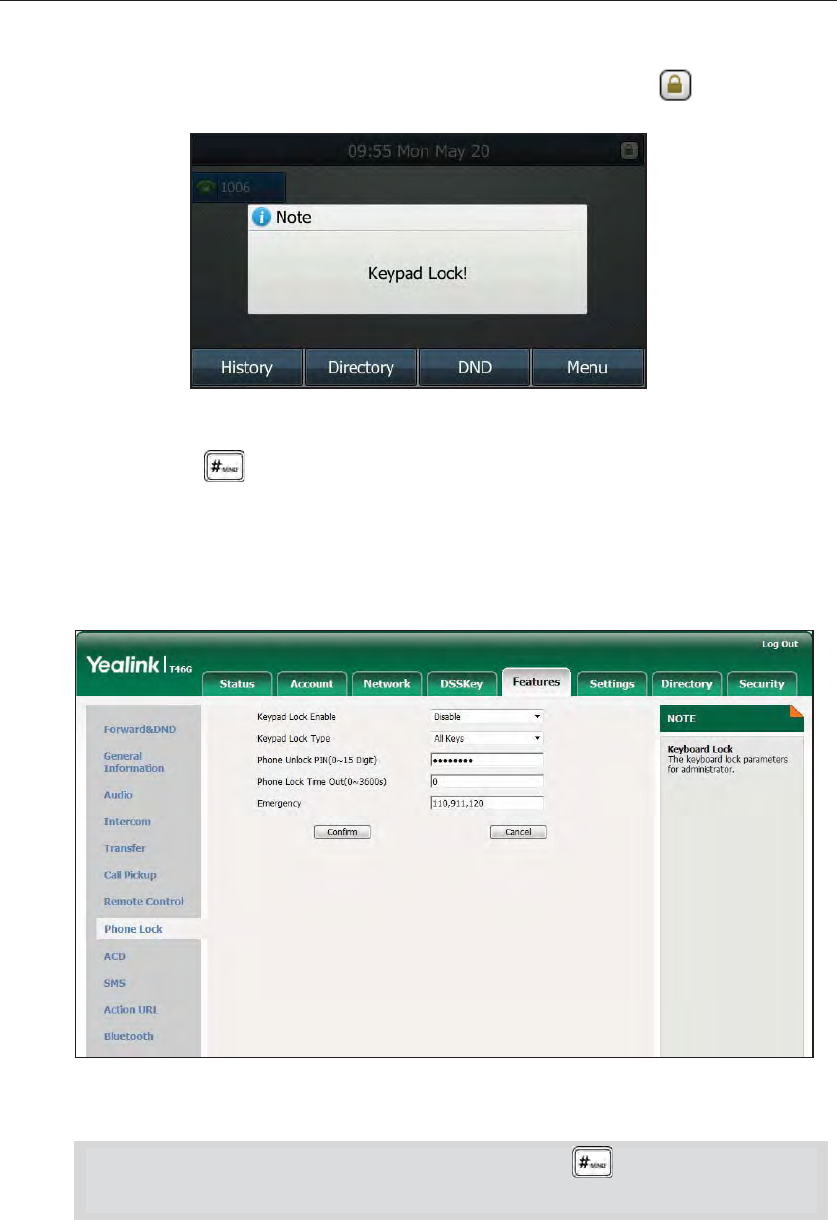
User Guide for the SIP-T48G IP Phone
34
The LCD screen prompts “Keypad Lock!” and displays the icon .
You can configure the interval (in seconds) to automatically lock the keypad instead of
long pressing .
To configure the interval of automatic keypad lock via web user interface:
1. Click on Features->Phone Lock.
2. Enter the desired time in the Phone Lock Time Out (0~3600s) field.
3. Click Confirm to accept the change.
Note
To unlock the keypad, you must know the keypad unlock PIN of the phone. The default
keypad unlock PIN is “123”.
To change the keypad unlock PIN via phone user interface:
The default timeout is 0 second, that is, you can long press to lock the keypad
only.
tlfttik dlk
ifiblibitf
l
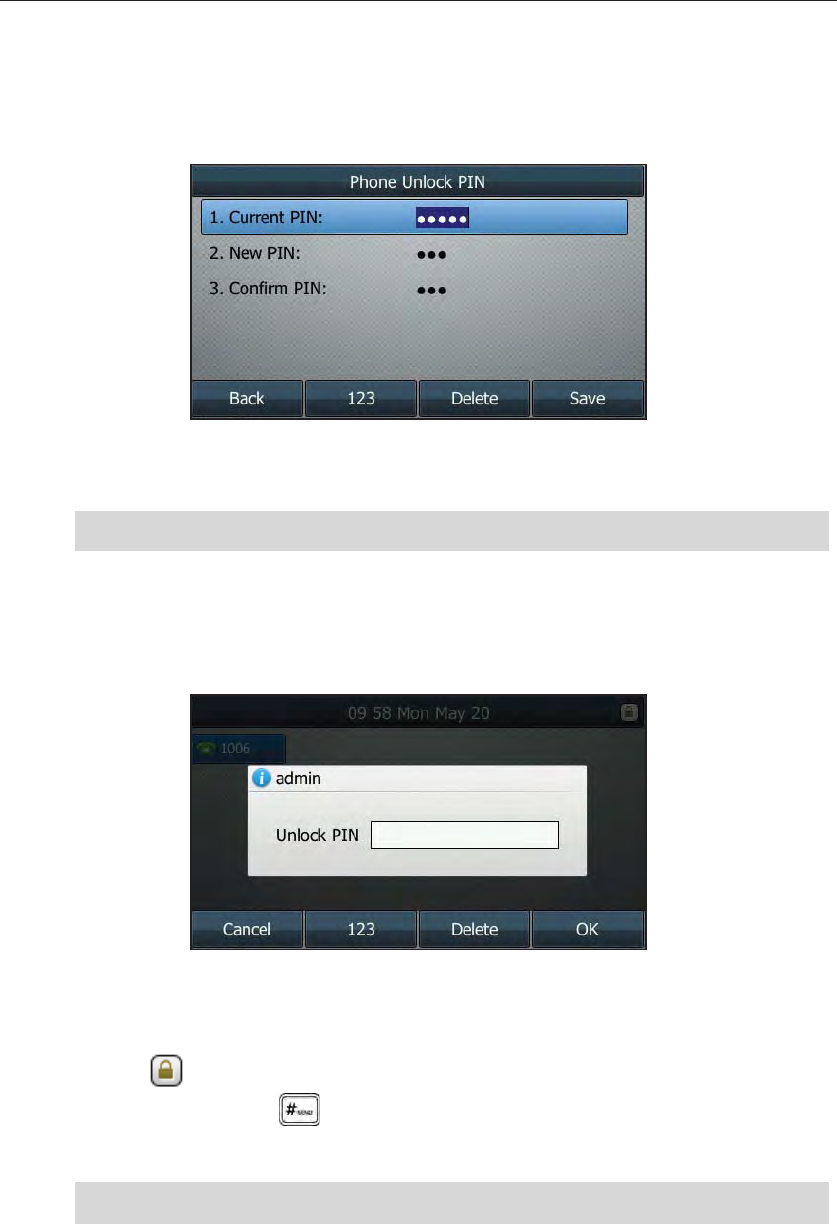
Customizing Your Phone
35
1. Press Menu->Basic->Phone Unlock PIN.
2. Enter the desired values in the Current PIN, New PIN and Confirm PIN fields
respectively.
3. Press the Save soft key to accept the setting or the Back soft key to cancel.
Note
To unlock the keypad via phone user interface:
1. Press any locked key, the LCD screen prompts “Unlock PIN”.
2. Enter the PIN in the Unlock PIN field.
3. Press the OK soft key to unlock the keypad.
The icon disappears from the LCD screen.
You can long press or wait for a period of time (if configured) to lock the
keypad again.
Note
To deactivate the keypad lock via phone user interface:
1. Press Menu->Advanced (password: admin) ->Phone Settings->Keypad Lock.
The unlock PIN length must be within 15 characters.
You can also unlock the keypad by administrator password.
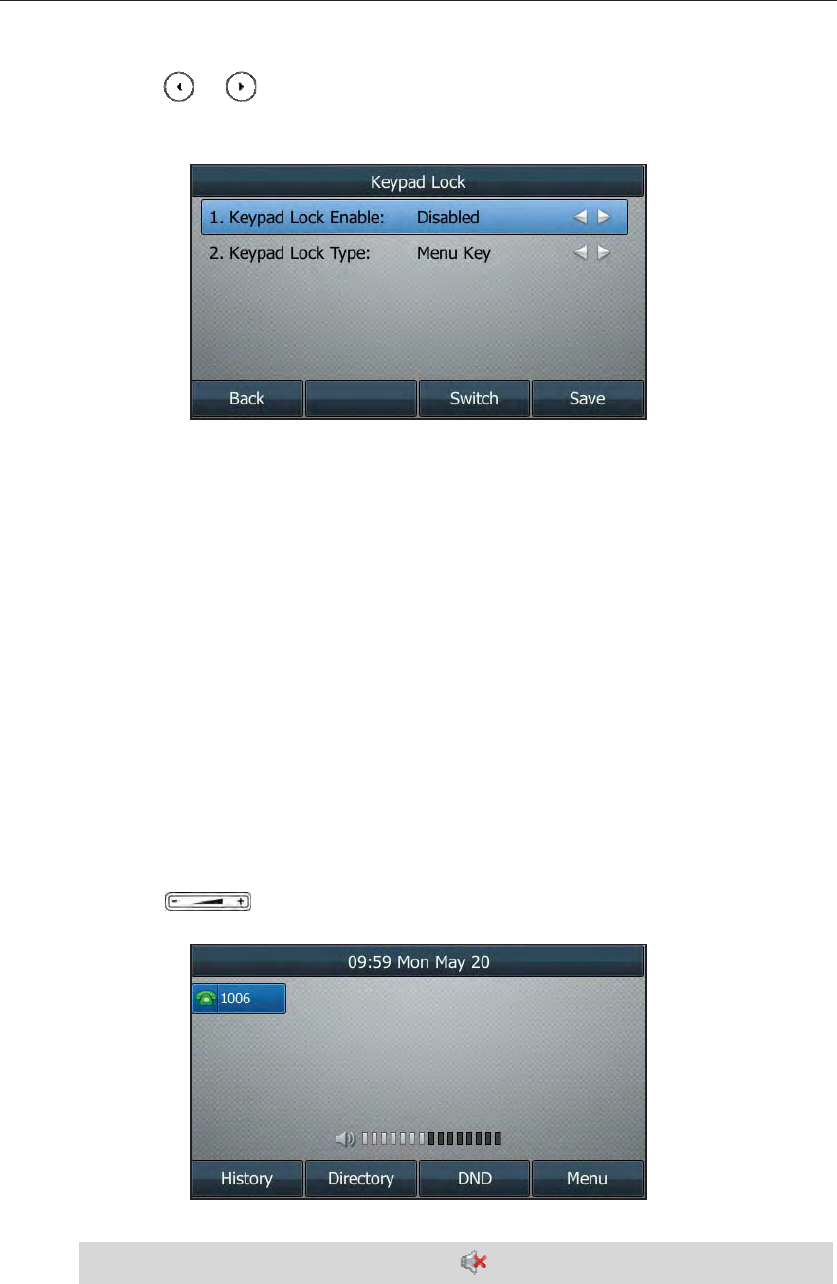
User Guide for the SIP-T48G IP Phone
36
2. Press or , or the Switch soft key to select Disabled from the Keypad Lock
Enable field.
3. Press the Save soft key to accept the change.
Keypad lock is configurable via web user interface at the path Features->Phone Lock.
#WFKQ5GVVKPIU
8QNWOG
You can press the volume key to adjust the ringer volume when the phone is idle. You
can also press the volume key to adjust the receiver volume of currently engaged
audio devices (handset, speakerphone or headset) when the phone is in use.
To adjust the volume when the phone is idle:
1. Press to adjust the ringer volume.
Note If ringer volume is adjusted to minimum, the icon will appear on the LCD screen.
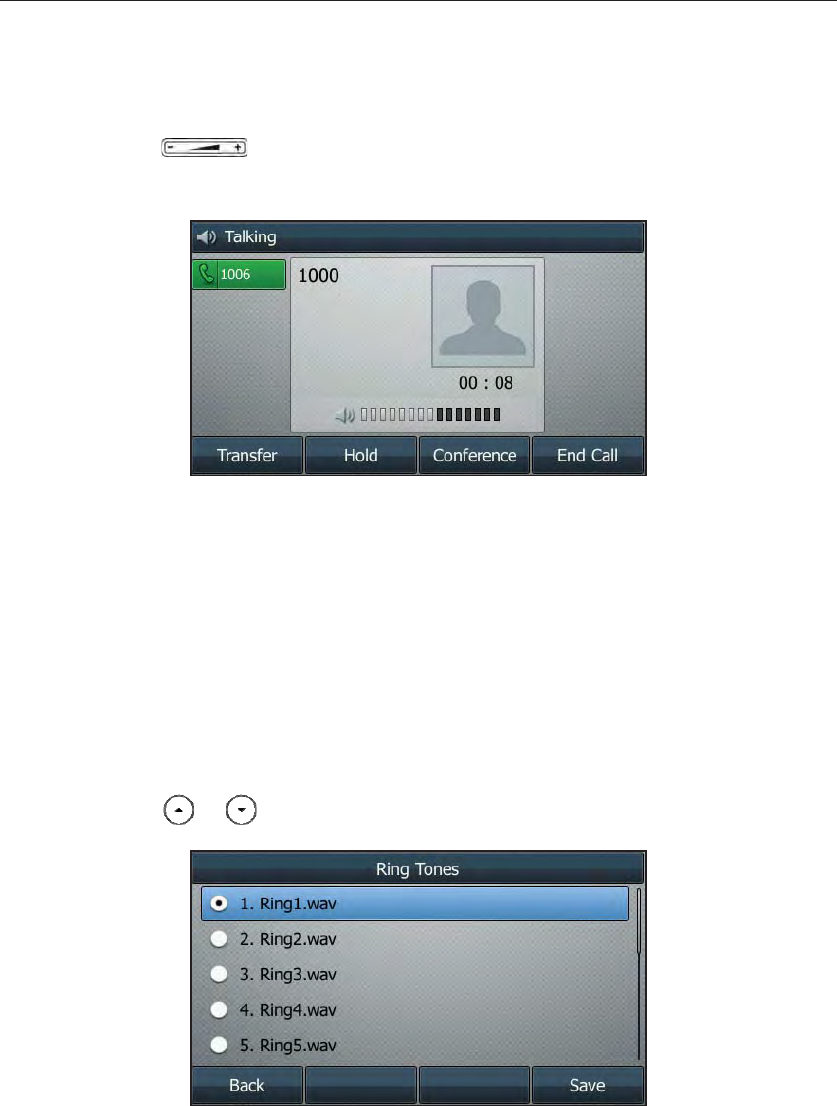
Customizing Your Phone
37
To adjust the volume when the phone is during a call:
1. Press to adjust the volume of currently engaged audio device (handset,
speakerphone or headset).
4KPI6QPGU
Ring tones are used to indicate incoming calls. You can select different ring tones to
distinguish different accounts registered on your phone, or to distinguish your phone
from your neighbor’s.
To select a ring tone for the phone via phone user interface:
1. Press Menu->Basic->Sound->Ring Tones.
2. Press or to select the desired ring tone.
3. Press the Save soft key to accept the change or the Back soft key to cancel.
To select a ring tone for the account via web user interface:
1. Click on Account.
2. Select the desired account from the pull-down list of Account.
3. Click on Basic.
4. Select the desired ring tone from the pull-down list of Ring Type.
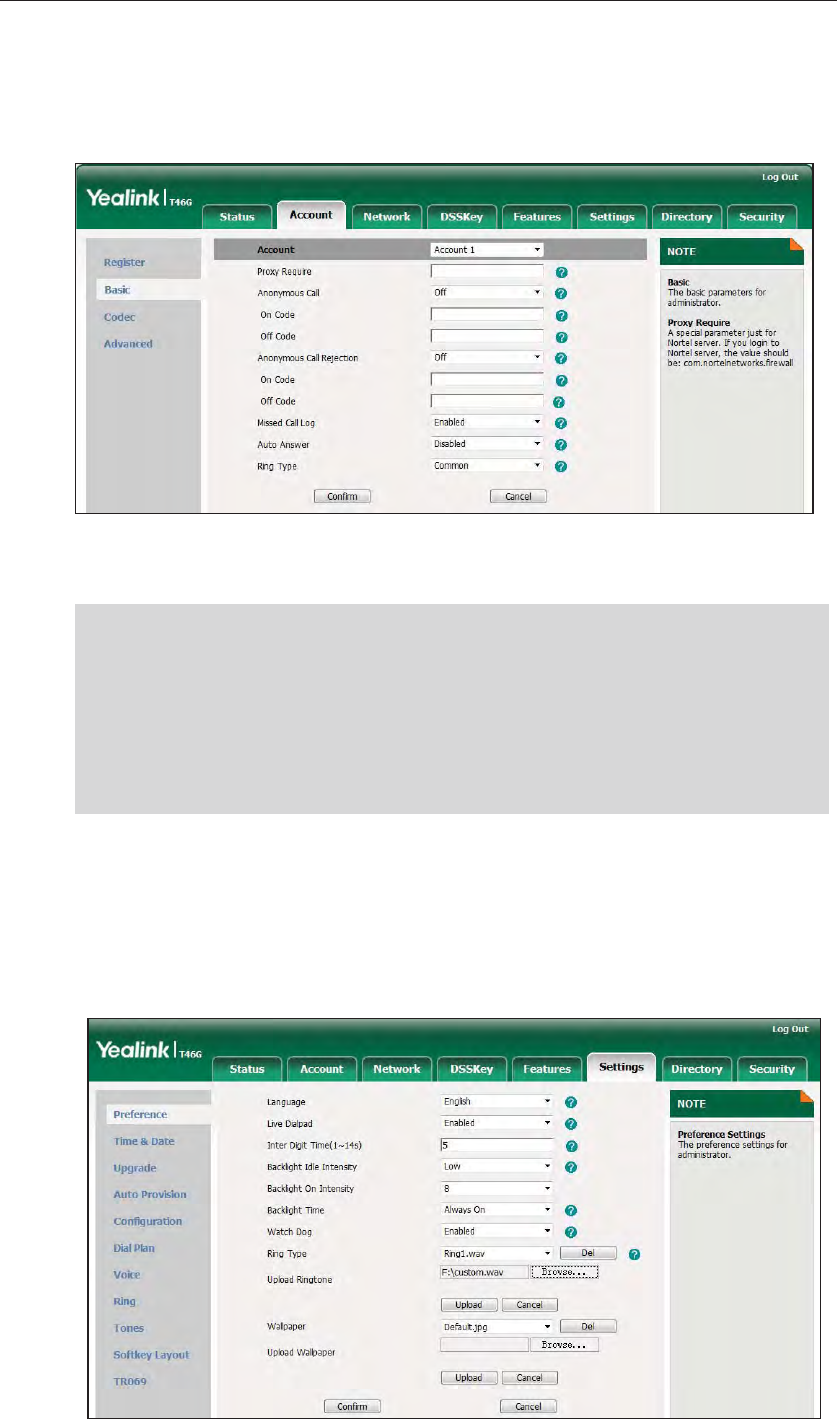
User Guide for the SIP-T48G IP Phone
38
If Common is selected, this account will use the ring tone selected for the phone.
Refer to the above instruction.
5. Click Confirm to accept the change.
Note
To upload a custom ring tone for your phone via web user interface:
1. Click on Settings->Preference.
2. In the Local Ringtone field, click Browse to locate a ring tone (the file format must
be .wav) file from your local system.
A ring tone for the account is configurable via web user interface only.
The ring tone for an incoming call on the phone may be different. For example, when
the phone receives an incoming call from a contact stored in the local directory, it will
play the ring tone assigned to the contact in the local directory (refer to Adding
Contacts). If no ring tone is assigned to the contact, the phone will play the ring tone
assigned to the associated group (refer to Groups). Otherwise, the phone will play the
ring tone assigned to the account. If no ring tone is assigned to the contact and
account, the phone will play the ring tone assigned to the phone.

Customizing Your Phone
39
3. Click Upload to upload the file.
Note
%QPVCEV/CPCIGOGPV
This section provides the operating instructions for managing contacts. Topics include:
zDirectory
zLocal Directory
zBlacklist
zRemote PhoneBook
&KTGEVQT[
Directory provides easy access to frequently used lists. The lists may contain Local
Directory, History, Remote Phone Book and LDAP.
To configure the directory via web user interface:
1. Click on Directory->Setting.
2. In the Directory block, select the desired list from the Disabled column and then
click .
The selected list appears in the Enabled column.
3. Repeat the step 2 to add more lists to the Enabled column.
4. To remove a list from the Enabled column, select the desired list and then click .
5. To adjust the display order of enabled lists, select the desired list and then click
or .
All custom ring tone files must be within 100KB. Uploading custom ring tones for your
phone is configurable via web user interface only.
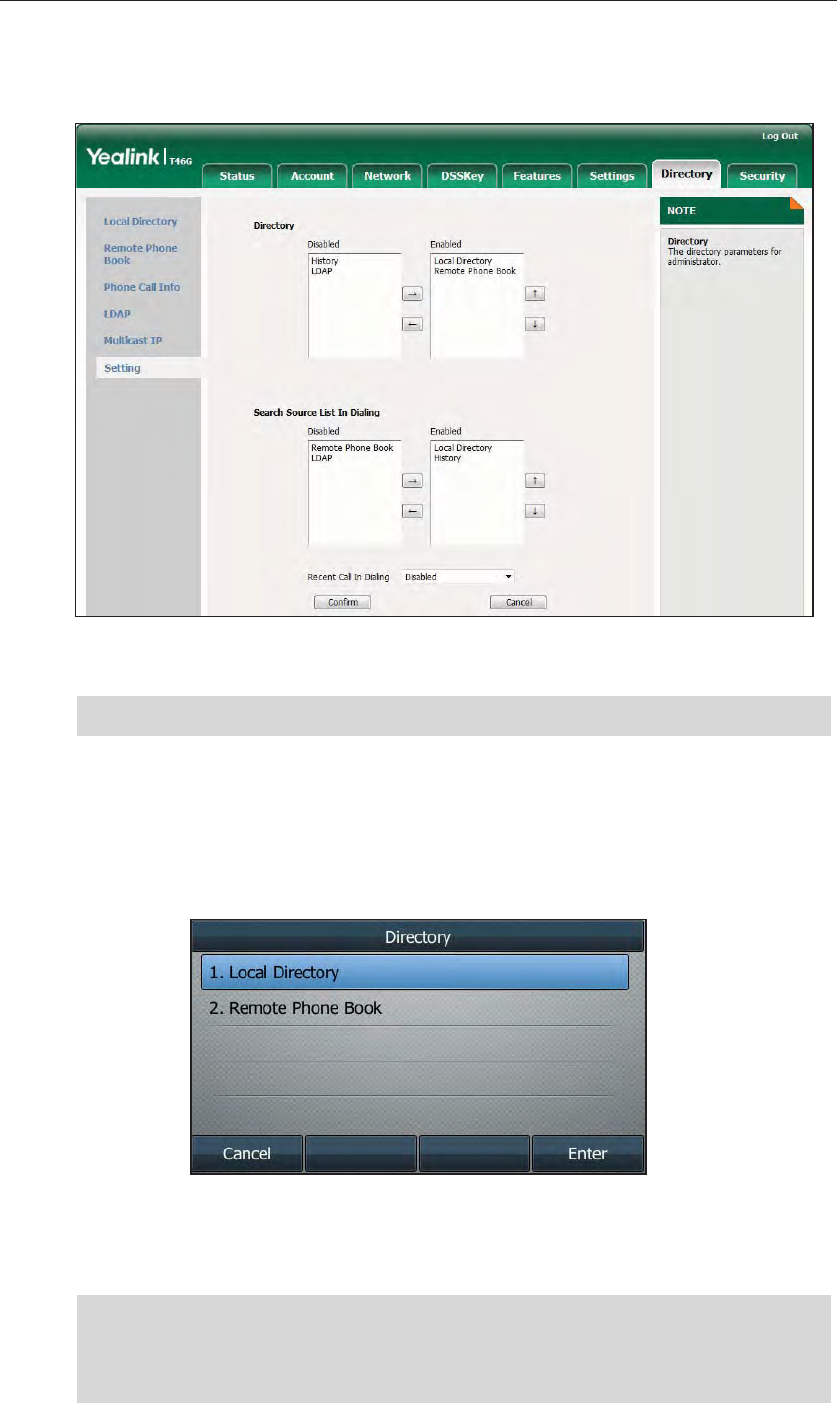
User Guide for the SIP-T48G IP Phone
40
The LCD screen displays the list(s) in the adjusted order.
6. Click Confirm to accept the change.
Note
To check directory via phone user interface:
1. Press the Directory soft key when the phone is idle.
The LCD screen displays the enabled list(s) in the directory.
If there is only one list in the directory, press the Directory soft key to enter this list
directly.
Note
Directory is configurable via web user interface only.
If the remote phone book and LDAP are not configured in advance, you cannot see
remote phone book and LDAP lists on the phone user interface. For more information on
remote phone book, refer to Remote PhoneBook on page 49. For more information on
the LDAP, contact your system administrator.
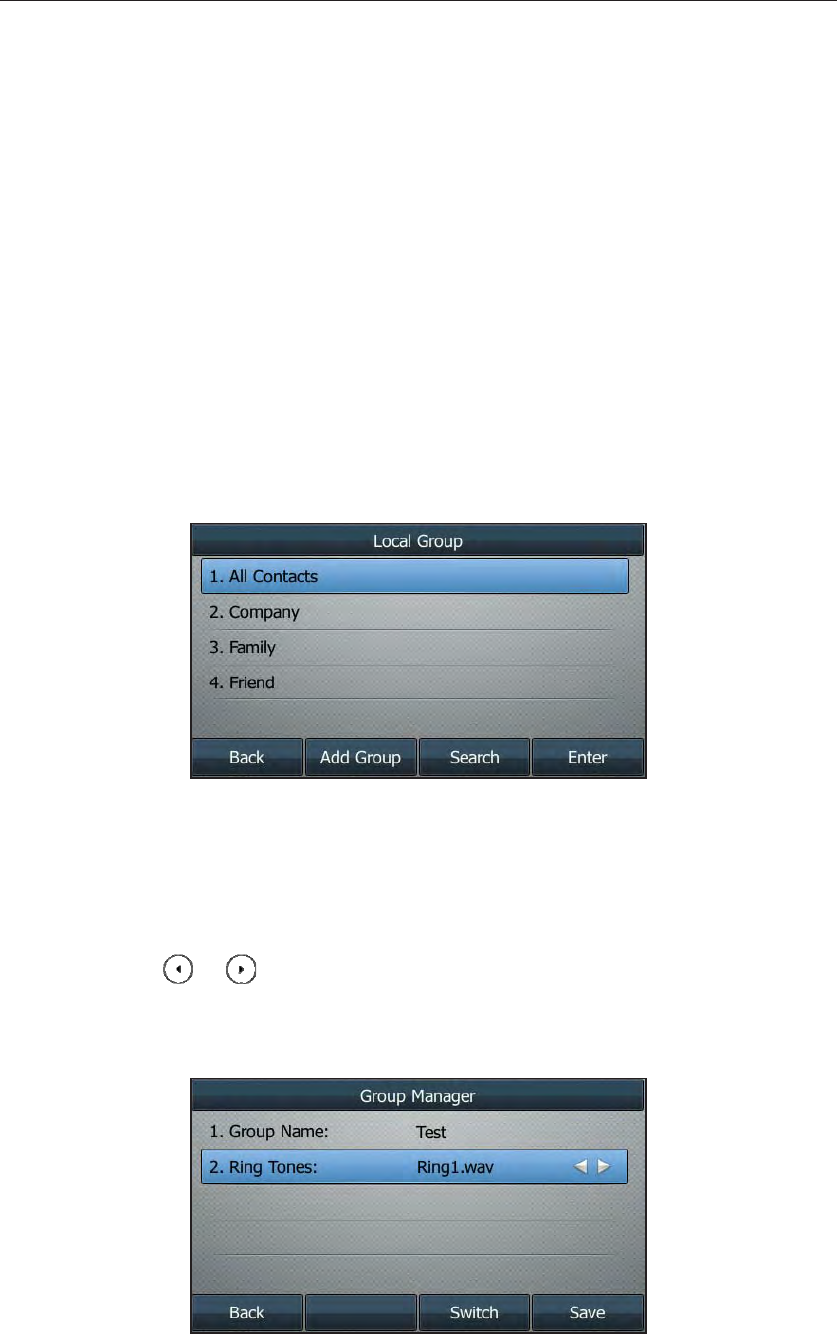
Customizing Your Phone
41
.QECN&KTGEVQT[
The built-in phone directory can store the names and phone numbers of your contacts.
You can store up to 1000 contacts and 50 groups in your phone's local directory. There
are four default groups in the local directory: All Contacts, Company, Family and Friend.
You can add new groups and contacts; edit, delete or search for a contact; or simply
dial a contact number from the local directory.
)TQWRU
To add a group to the local directory:
1. Press the Directory soft key.
The IP phone enters the local directory directly as there is only Local Directory in the
directory by default.
If Local Directory is removed from the directory, press Menu->Directory->Local
Group to enter the local directory.
2. Press the Add Group soft key.
3. Enter the desired group name in the Group Name field.
4. Press or to select the desired group ring tone from the Ring Tones field.
If Auto is selected, this group will use the ring tone assigned to the account. For
more information on the ring tone for the account, refer to Ring Tones on page 37.
5. Press the Save soft key to accept the change or the Back soft key to cancel.
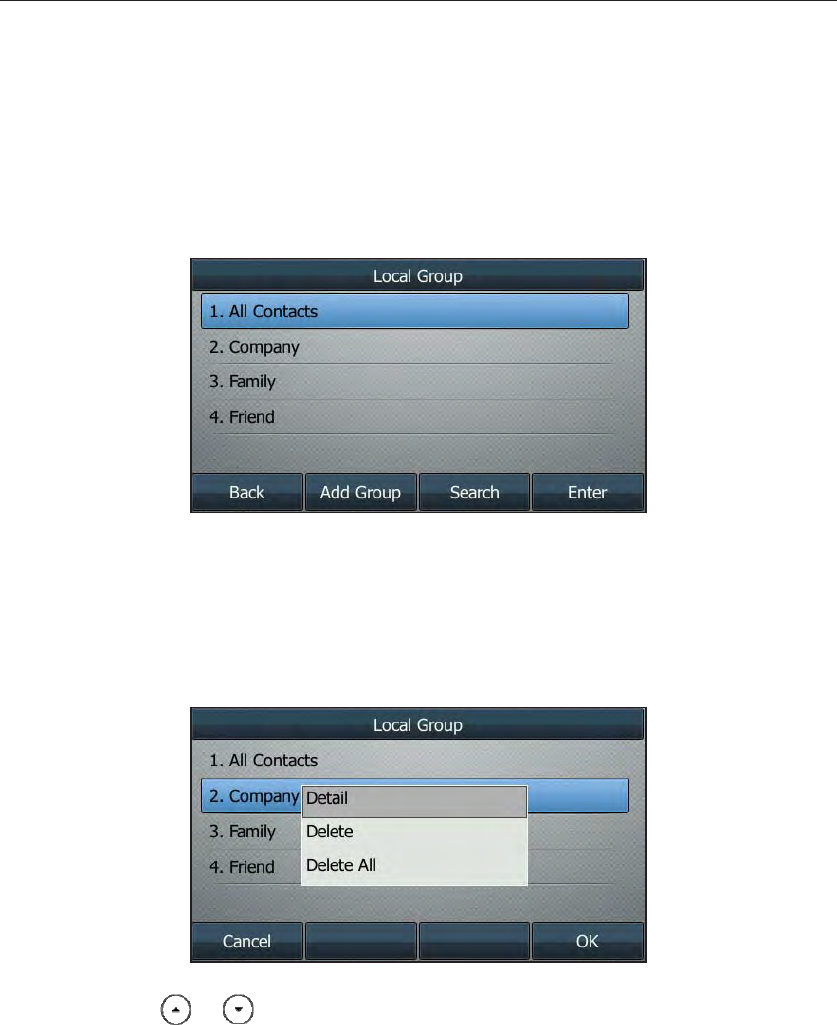
User Guide for the SIP-T48G IP Phone
42
You can also edit or delete the Company, Family and Friend contact groups.
To edit a group in the local directory:
1. Press the Directory soft key.
The IP phone enters the local directory directly as there is only Local Directory in the
directory by default.
If Local Directory is removed from the directory, press Menu->Directory->Local
Group to enter the local directory.
2. Select the desired contact group.
3. Press the Option soft key and then select Detail from the prompt list.
4. Press or to highlight the group information and then edit.
5. Press the Save soft key to accept the change or the Back soft key to cancel.
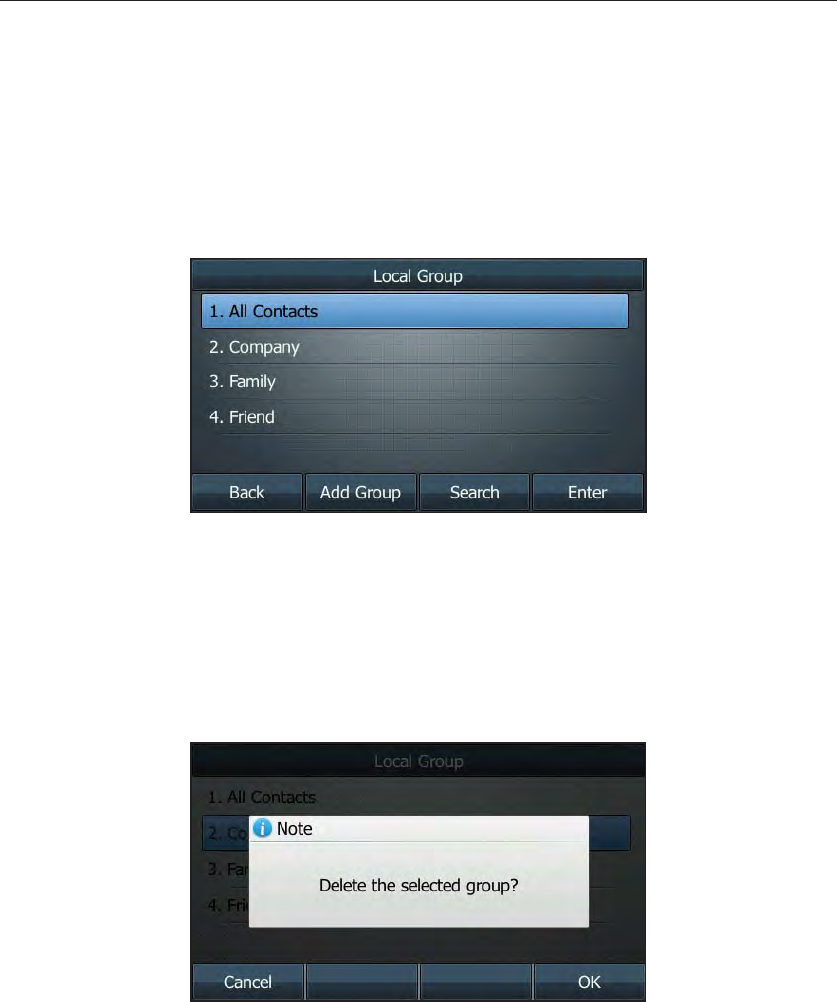
Customizing Your Phone
43
To delete a group from the local directory:
1. Press the Directory soft key.
The IP phone enters the local directory directly as there is only Local Directory in the
directory by default.
If Local Directory is removed from the directory, press Menu->Directory->Local
Group to enter the local directory.
2. Select the desired contact group.
3. Press the Option soft key and then select Delete from the prompt list.
The LCD screen prompts the following warning:
4. Press the OK soft key to confirm the deletion or the Cancel soft key to cancel.
#FFKPI%QPVCEVU
You can add contacts to the local directory in the following ways:
zManually
zFrom call history
zFrom remote phone book
Adding Contacts Manually
To add a contact to the local directory manually:
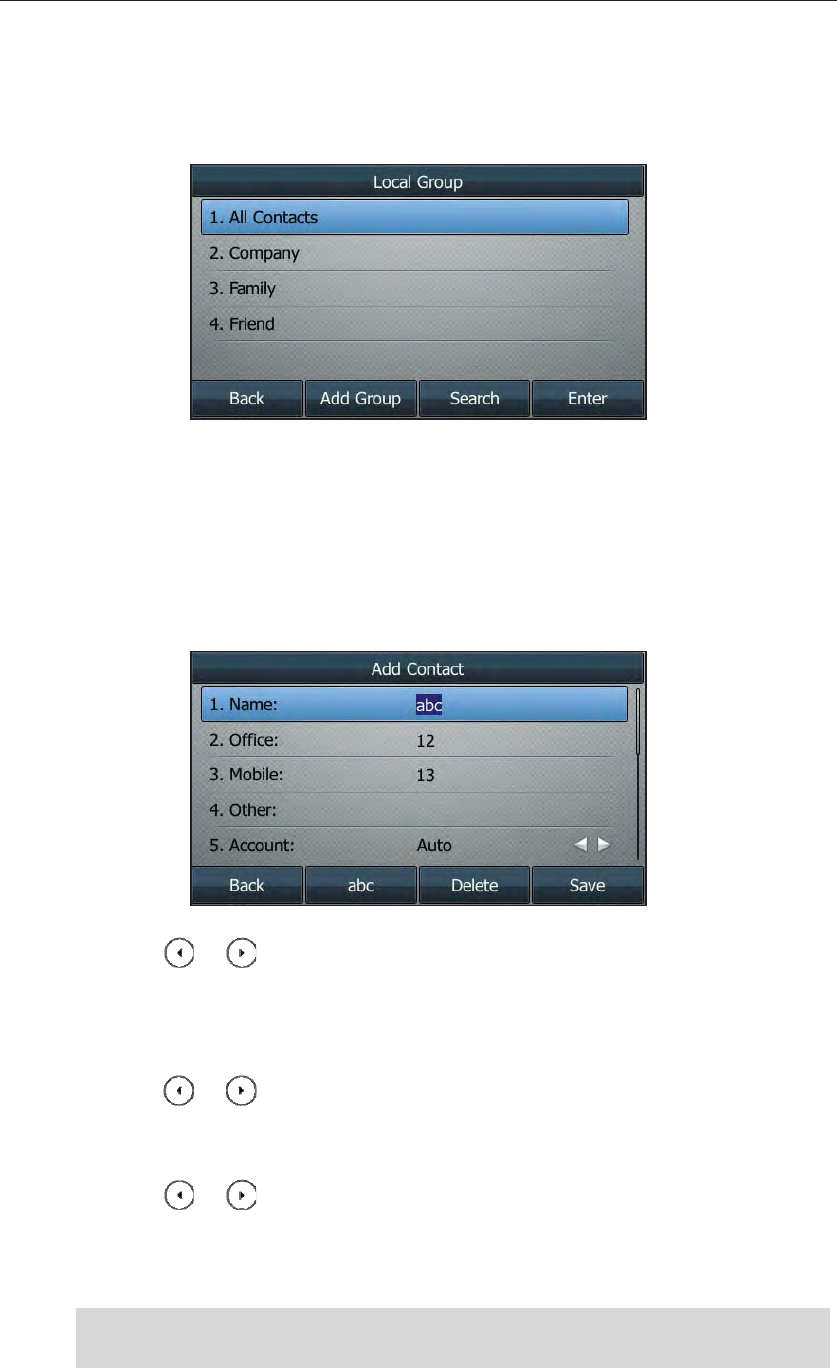
User Guide for the SIP-T48G IP Phone
44
1. Press the Directory soft key.
The IP phone enters the local directory directly as there is only Local Directory in the
directory by default.
If Local Directory is removed from the directory, press Menu->Directory->Local
Group to enter the local directory.
2. Select the desired contact group and press the Enter soft key.
3. Press the Add soft key.
4. Enter the name and the office, mobile or other numbers in the corresponding fields.
5. Press or , or the Switch soft key to select the desired account from the
Account field.
If Auto is selected, the phone will use the first available account when placing calls
to the contact from the local directory.
6. Press or , or the Switch soft key to select the desired ring tone from the Ring
field.
If Auto is selected, this contact will use the ring tone assigned to the group.
7. Press or , or the Switch soft key to select the desired photo from the Photo
field.
8. Press the Save soft key to accept the change or the Back soft key to cancel.
Note If the contact has existed in the directory, the LCD screen will prompt “Contact name
already existed!”.
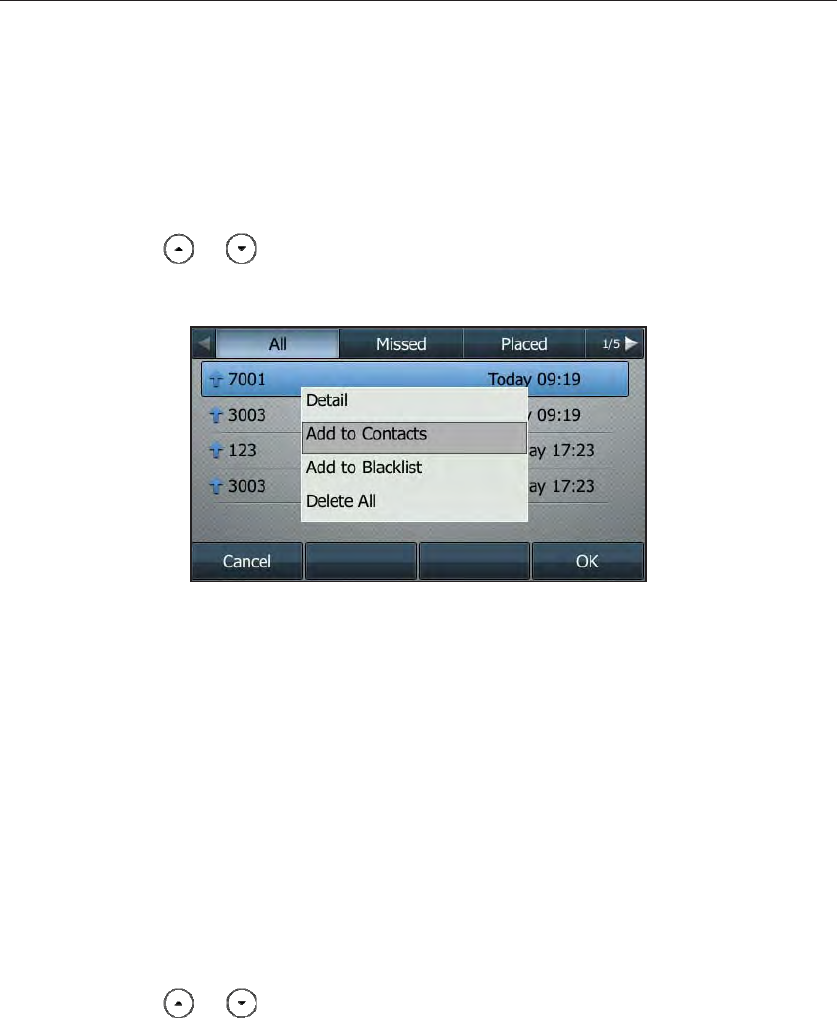
Customizing Your Phone
45
Adding Contacts from Call History
To add a contact to the local directory from the call history:
1. Press the History soft key.
2. Press or to highlight the desired entry.
3. Press the Option soft key, and then select Add to Contacts from the prompt list.
4. Enter the contact name.
5. Press the Save soft key to accept the change.
The entry is successfully saved to the local directory.
Adding Contacts from remote phone book
To add a contact to the local directory from remote phone book:
1. Press Directory->Remote Phone Book.
If Remote Phone Book is removed from the directory, press
Menu->Directory->Remote Phone Book to enter remote phone book.
2. Select the desired remote group and press the Enter soft key.
3. Press or to highlight the desired entry.
4. Press the Option soft key, and then select Add to Contacts from the prompt list.
5. Press the Save soft key to save the contact to the local directory.
If the contact has already existed in the local directory, the LCD screen will prompt
"Overwrite the original contact?". Press the OK soft key to overwrite the original
contact in the local directory or the Cancel soft key to cancel.
For more information on remote phone book operating, refer to Remote PhoneBook on
page 55.
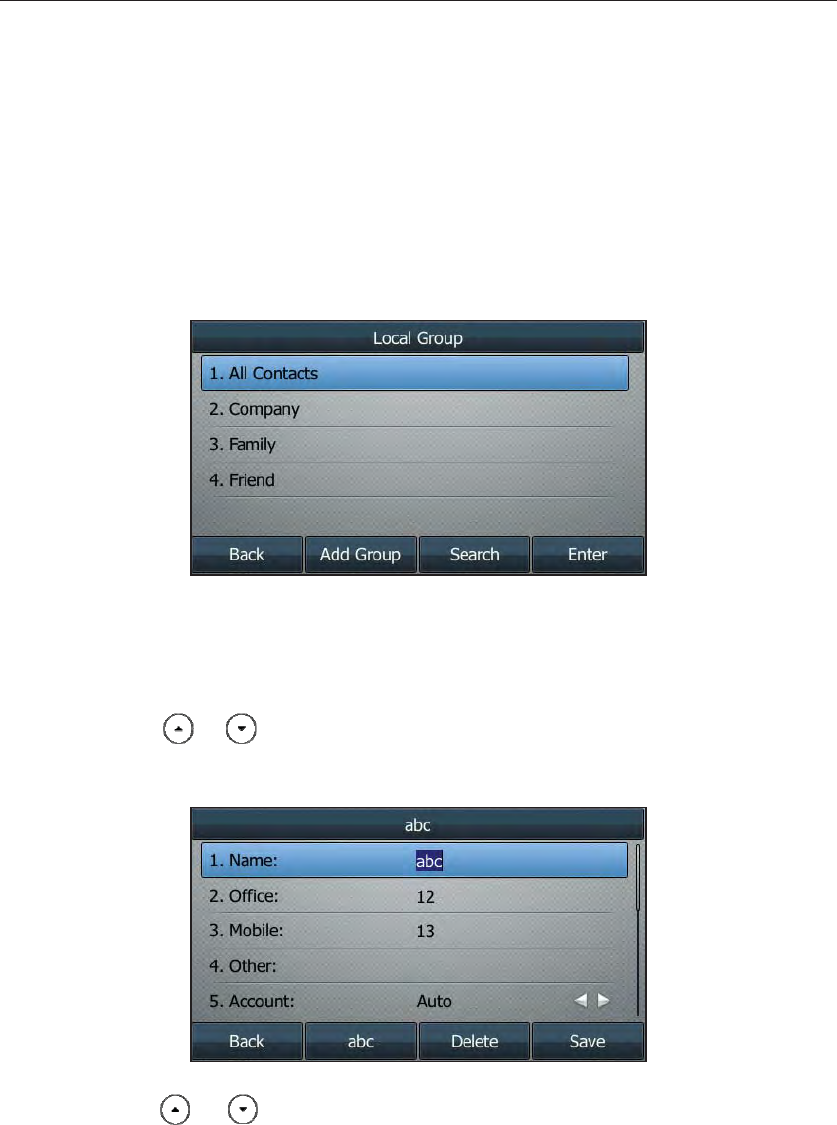
User Guide for the SIP-T48G IP Phone
46
'FKVKPI%QPVCEVU
To edit a contact in the local directory:
1. Press the Directory soft key.
The IP phone enters the local directory directly as there is only Local Directory in the
directory by default.
If Local Directory is removed from the directory, press Menu->Directory->Local
Group to enter the local directory.
2. Select the desired contact group and press the Enter soft key.
3. Press or to highlight the desired contact.
4. Press the Option soft key, and then select Detail from the prompt list.
5. Press or to highlight the contact information and then edit.
6. Press the Save soft key to accept the change or the Back soft key to cancel.
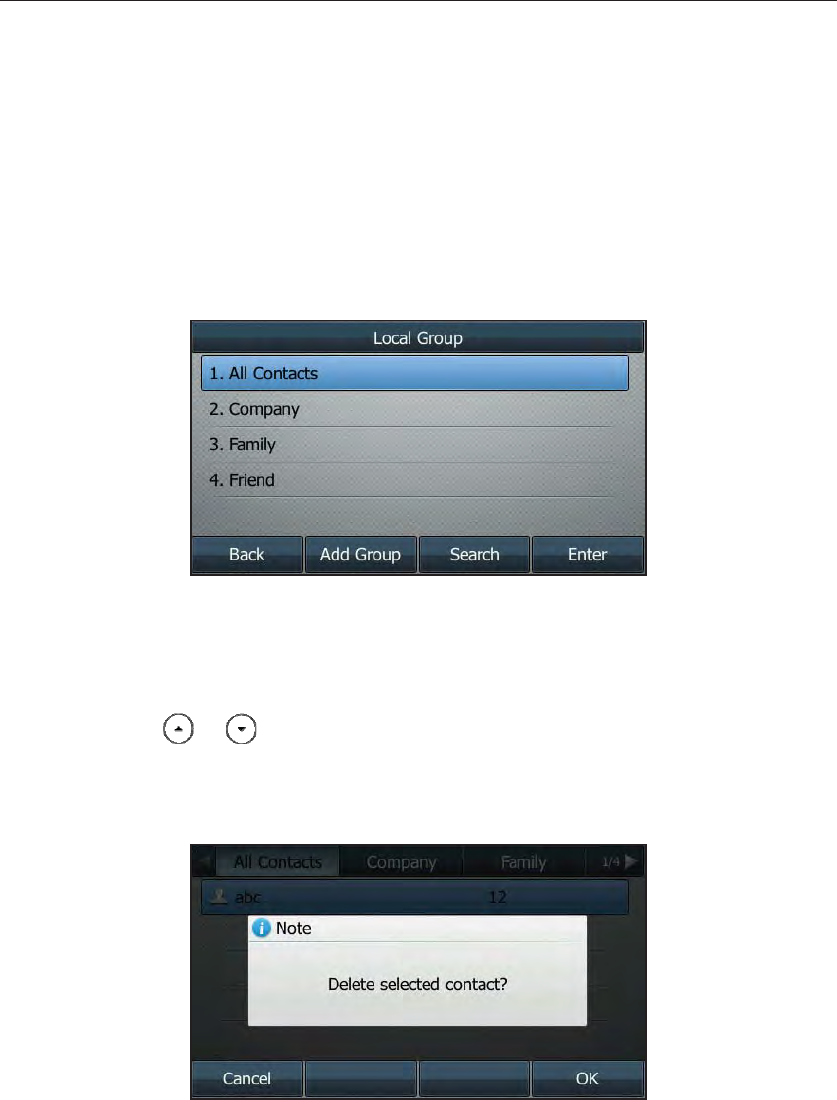
Customizing Your Phone
47
&GNGVKPI%QPVCEVU
To delete a contact from the local directory:
1. Press the Directory soft key.
The IP phone enters the local directory directly as there is only Local Directory in the
directory by default.
If Local Directory is removed from the directory, press Menu->Directory->Local
Group to enter the local directory.
2. Select the desired contact group and press the Enter soft key.
3. Press or to highlight the desired contact.
4. Press the Option soft key, and then select Delete from the prompt list.
The LCD screen prompts the following warning:
5. Press the OK soft key to confirm the deletion or the Cancel soft key to cancel.
You can also delete all contacts by pressing the Option soft key, and then select Delete
All.
7RNQCFKPI%QPVCEV2JQVQU
To upload a new custom photo for the contact via web user interface:
1. Click on Directory->Local Directory.
2. Click Browse, and then select a photo from your local computer.
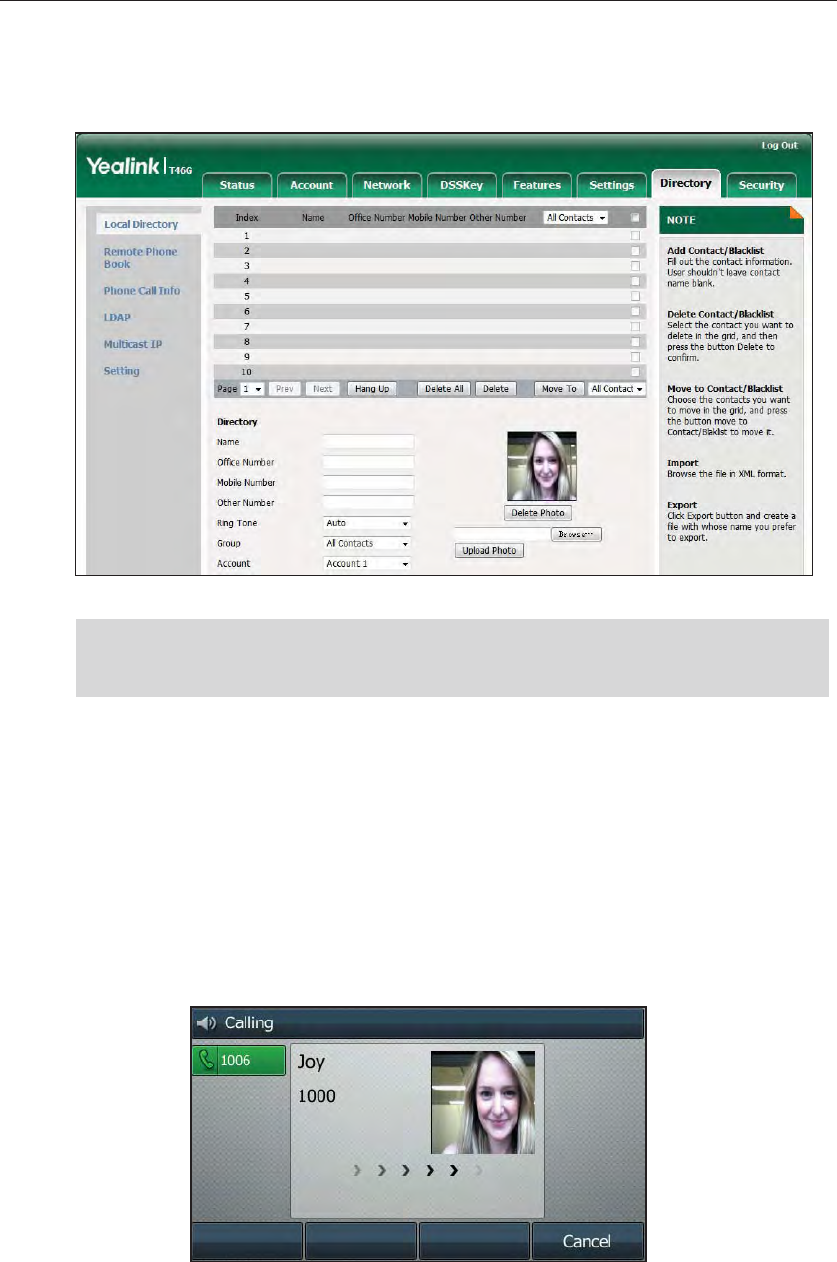
User Guide for the SIP-T48G IP Phone
48
3. Click Upload Photo to upload the photo.
You can also click Delete Photo to delete the photo.
Note
To change the custom photo for the contact via web user interface:
1. Click on Directory->Local Directory.
2. Click to select the desired entry which you want to edit.
3. Select the desired photo from the pull-down list of Photo.
4. Click Edit to accept the change.
When you place a call to the contact or receive a call from the contact, the LCD
screen will show the contact photo.
The phone only supports the .png, .jpg and .bmp format files.
You can only delete the custom photo.
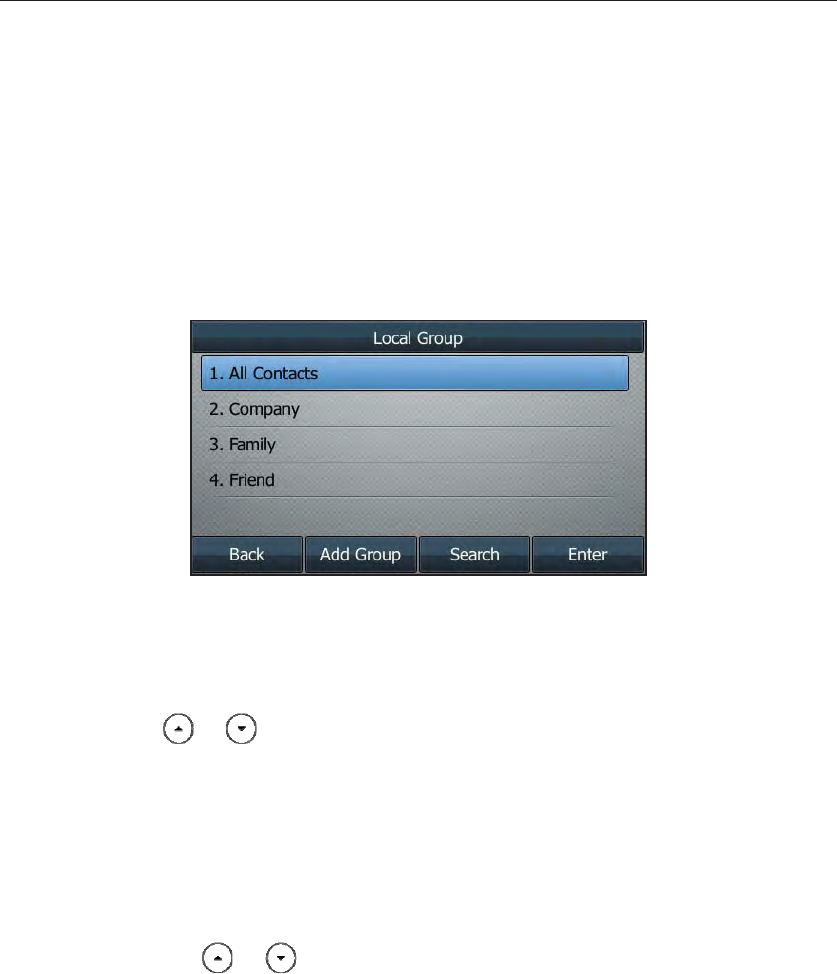
Customizing Your Phone
49
2NCEKPI%CNNUVQ%QPVCEVU
To place a call to a contact from the local directory:
1. Press the Directory soft key.
The IP phone enters the local directory directly as there is only Local Directory in the
directory by default.
If Local Directory is removed from the directory, press Menu->Directory->Local
Group to enter the local directory.
2. Select the desired contact group and press the Enter soft key.
3. Press or to highlight the desired contact.
4. Do one of the following:
If only one number of the contact is stored in the local directory, press the Send soft
key to dial out the number.
If multiple numbers of the contact are stored in the local directory, press the Send soft
key to display a list of numbers.
Press or to highlight the desired number.
Press the Send soft key to dial out the number.
5GCTEJKPIHQT%QPVCEVU
To search for a contact in the local directory:
1. Press the Directory soft key.
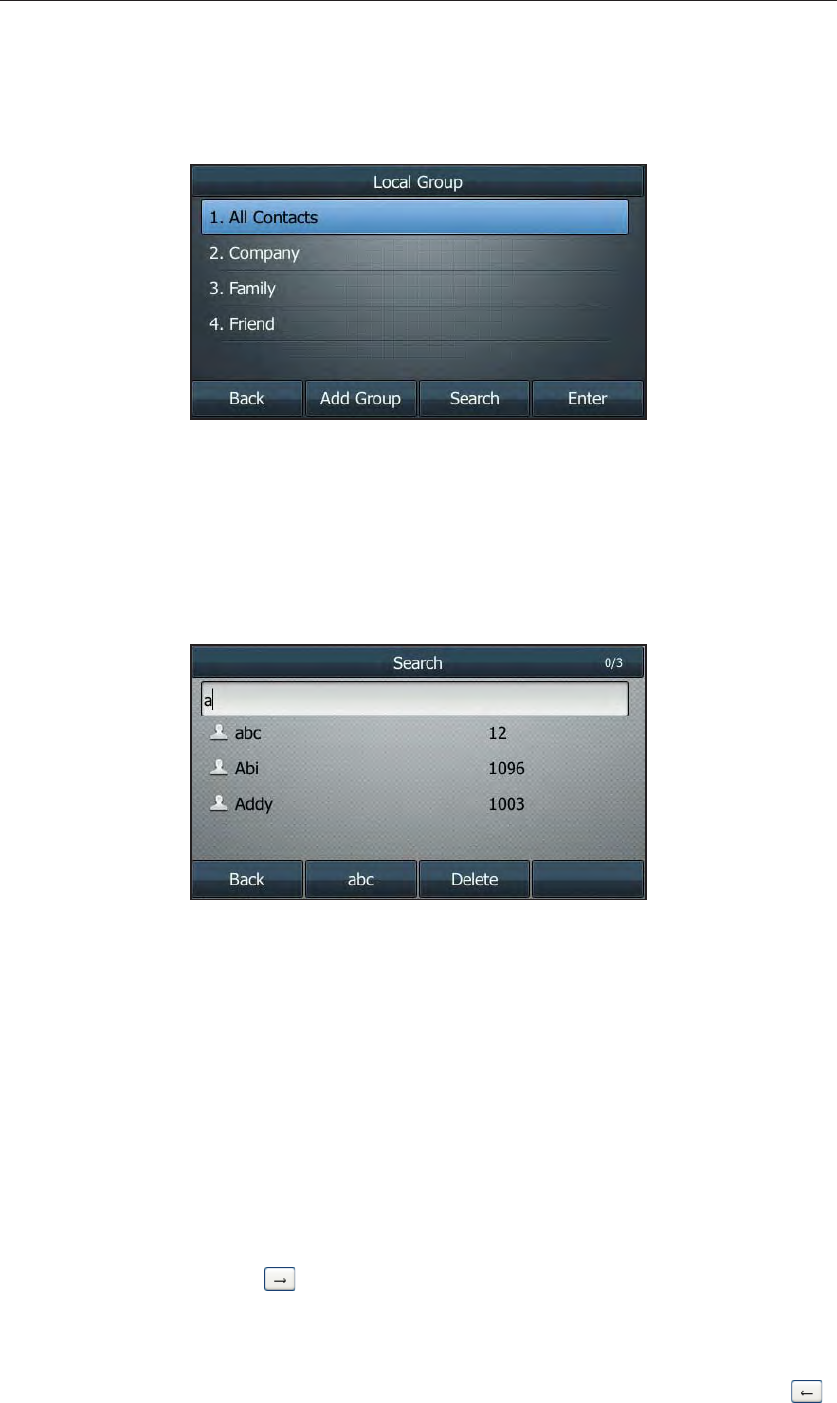
User Guide for the SIP-T48G IP Phone
50
The IP phone enters the local directory directly as there is only Local Directory in the
directory by default.
If Local Directory is removed from the directory, press Menu->Directory->Local
Group to enter the local directory.
2. Press the Search soft key.
3. Enter a few continuous characters of the contact name or the contact number
using the keypad.
The contacts whose name or phone number matches the characters entered will
appear on the LCD screen. You can dial from the result list.
5GCTEJ5QWTEG.KUVKP&KCNKPI
You can search for a contact from the desired lists when the phone is in the dialing
screen. The lists can be Local Directory, History, Remote Phone Book and LDAP.
To configure search source list in dialing via web user interface:
1. Click on Directory->Setting.
2. In the Search Source List In Dialing block, select the desired list from the Disabled
column and click .
The selected list appears in the Enabled column.
3. Repeat step 2 to add more lists to the Enabled column.
4. To remove a list from the Enabled column, select the desired list and then click .
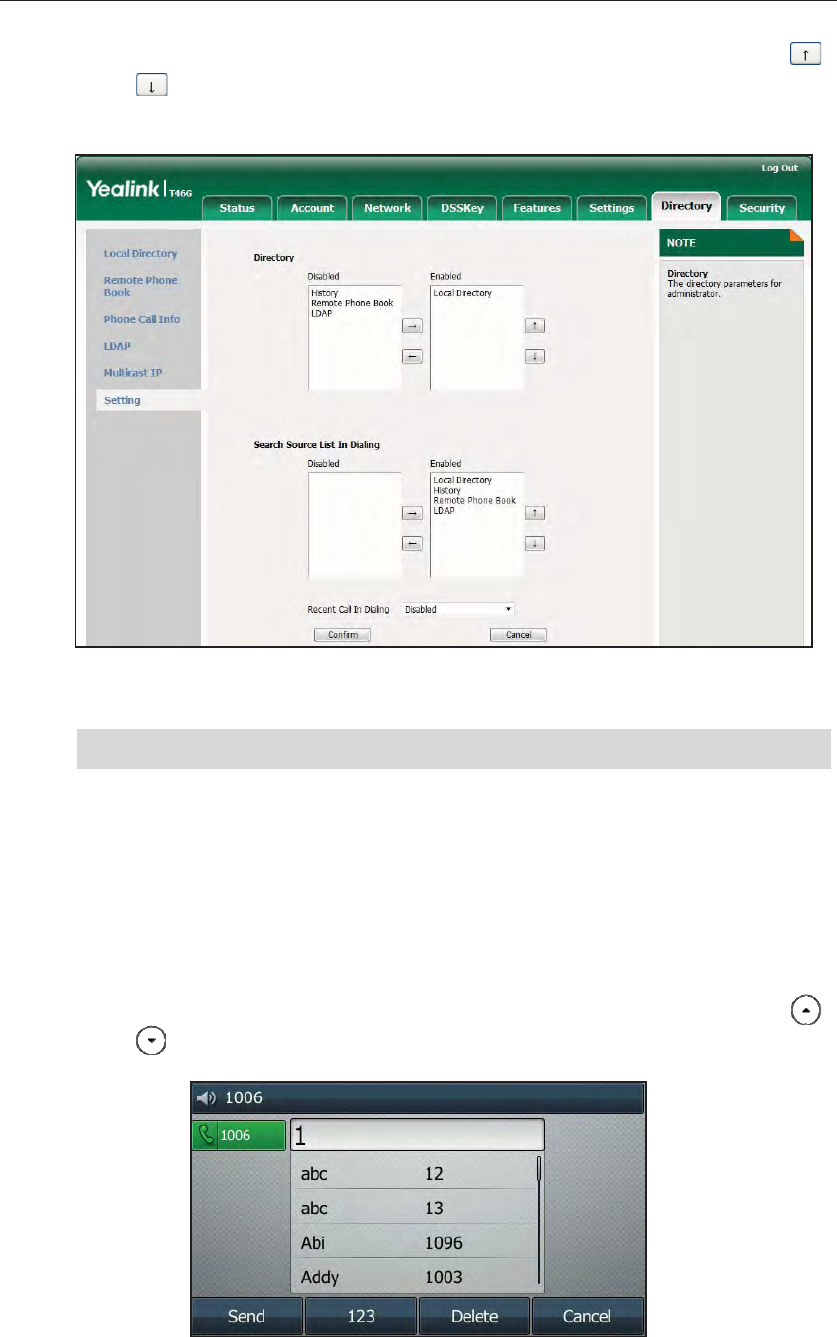
Customizing Your Phone
51
5. To adjust the display order of the enabled list, select the desired list, and click
or .
The LCD screen displays the search results in the adjusted order.
6. Click Confirm to accept the change.
Note
To search for an entry in the enabled search source lists:
1. Pickup the handset, press the speakerphone key or press the line key.
2. Enter a few continuous characters of the entry’s name or the entry’s phone number
using the keypad.
The entries in the enabled search source lists whose name or phone number
matches the characters entered will appear on the LCD screen. You can press
or to scroll to the desired entry and then place a call to the entry.
Search source list in dialing is configurable via web user interface only.
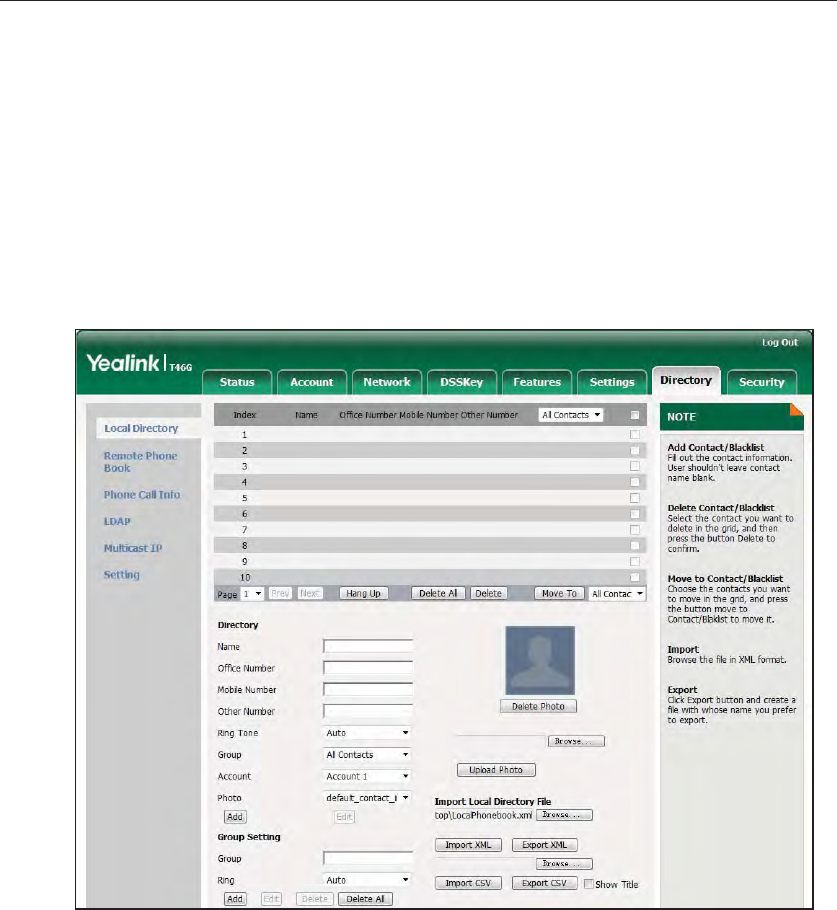
User Guide for the SIP-T48G IP Phone
52
+ORQTVKPI'ZRQTVKPI%QPVCEV.KUVU
You can manage your phone’s local directory via phone user interface or web user
interface. But you can only import or export the contact list via web user interface.
To import an XML file of contact list via web user interface:
1. Click on Directory->Local Directory.
2. Click Browse to locate a contact list file (file format must be .xml) from your local
system.
3. Click Import XML to import the contact list.
The web user interface prompts "The original contact will be covered, Continue?".
4. Click OK to complete importing the contact list.
To import a CSV file of contact list via web user interface:
1. Click on Directory->Local Directory.
2. Click Browse to locate a contact list file (file format must be .csv) from your local
system.
3. (Optional.)Check the Show Title checkbox.
It will prevent importing the title of the contact information which is located in the
first line of the CSV file.
4. Click Import CSV to import the contact list.
5. (Optional.) Mark the On radio box in the Delete Old Contacts field.
It will delete all existing contacts while importing the contact list.
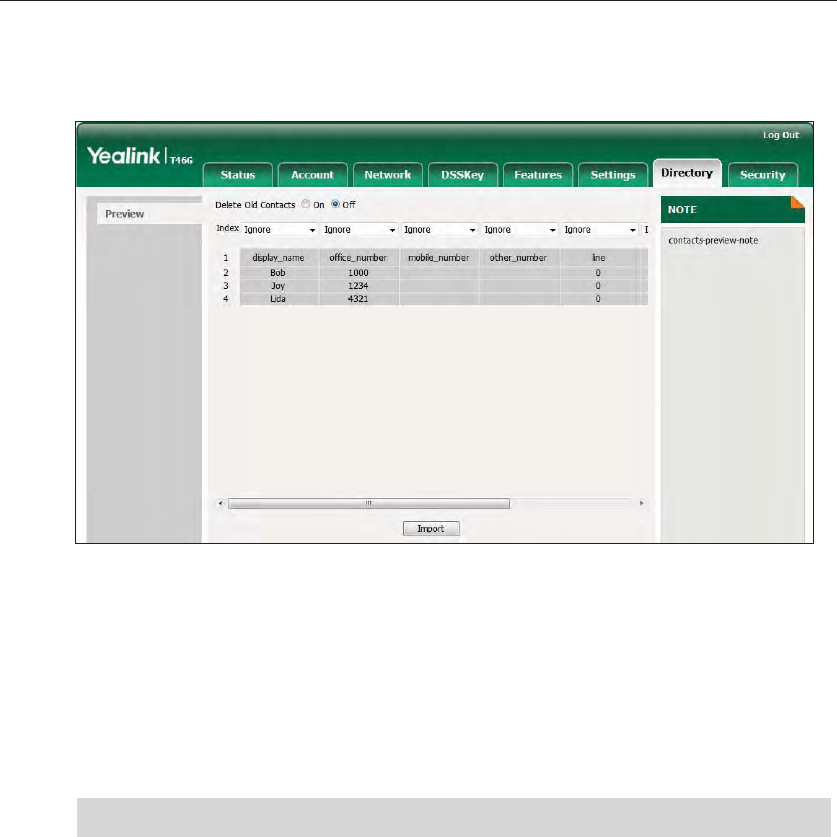
Customizing Your Phone
53
6. (Optional.) Select the contact information you want to import into the local
directory from the pull down list of Index.
7. Click Import to complete importing the contact list.
To export a contact list via web user interface:
1. Click on Directory->Local Directory.
2. Click Export XML (or Export CSV).
3. Click Save to save the contact list to your local system.
Note
$NCEMNKUV
The built-in phone directory can store the names and phone numbers for a blacklist.
You can store up to 30 contacts; add, edit, delete or search for a contact in the
blacklist directory; even call a contact from the blacklist directory, but incoming calls
from the blacklist directory contacts will be rejected automatically.
To add a contact to the blacklist directory manually:
1. Press Menu->Directory ->Blacklist.
2. Press the Add soft key.
Importing/exporting contact lists is available via web user interface only.
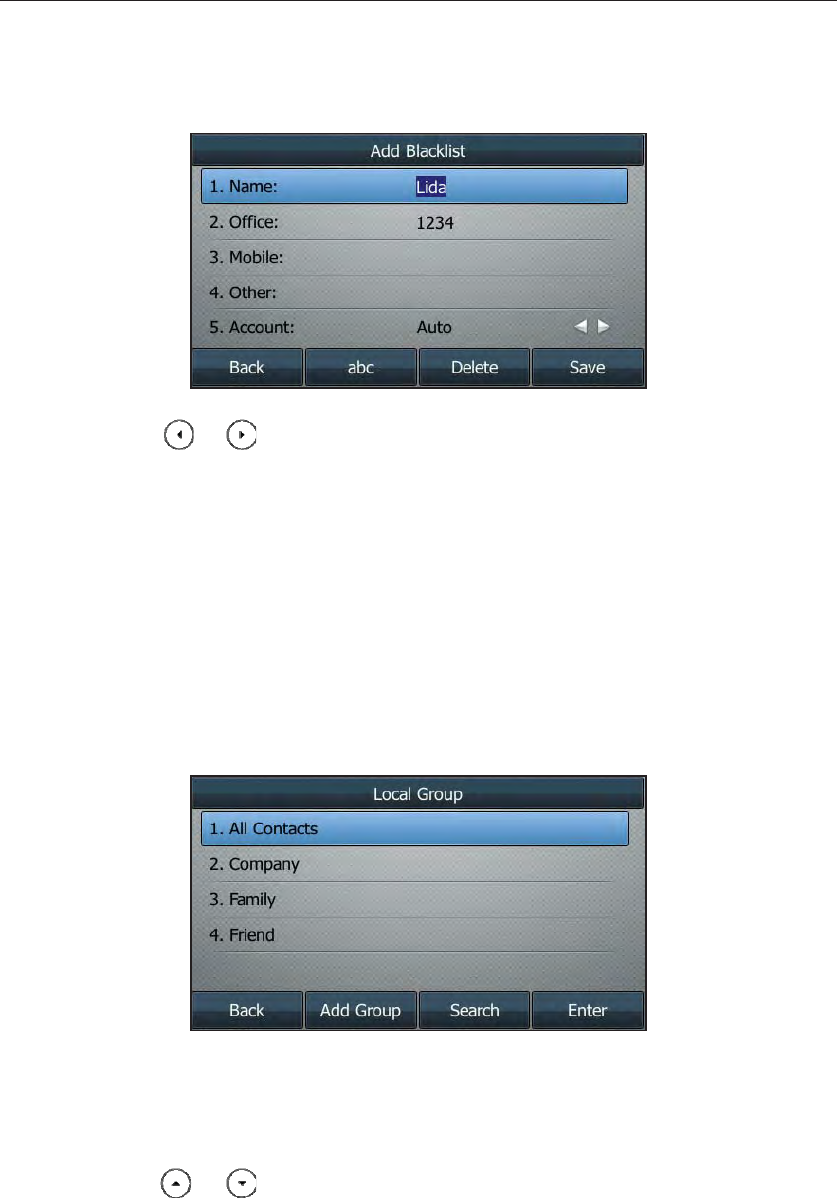
User Guide for the SIP-T48G IP Phone
54
3. Enter the name and the office, mobile or other numbers in the corresponding fields.
4. Press or , or the Switch soft key to select the desired account from the
Account field.
If Auto is selected, the phone will use the first available account when placing calls
to the contact from the blacklist directory.
5. Press the Save soft key to accept the change or the Back soft key to cancel.
To add a contact to the blacklist directory from the local directory:
1. Press Directory soft key.
The IP phone enters the local directory directly as there is only Local Directory in the
directory by default.
If Local Directory is removed from the directory, press Menu->Directory->Local
Group to enter the local directory.
2. Select the desired contact group and press the Enter soft key.
3. Press or to highlight the desired contact.
4. Press the Option soft key and then select Add to Blacklist from the prompt list.
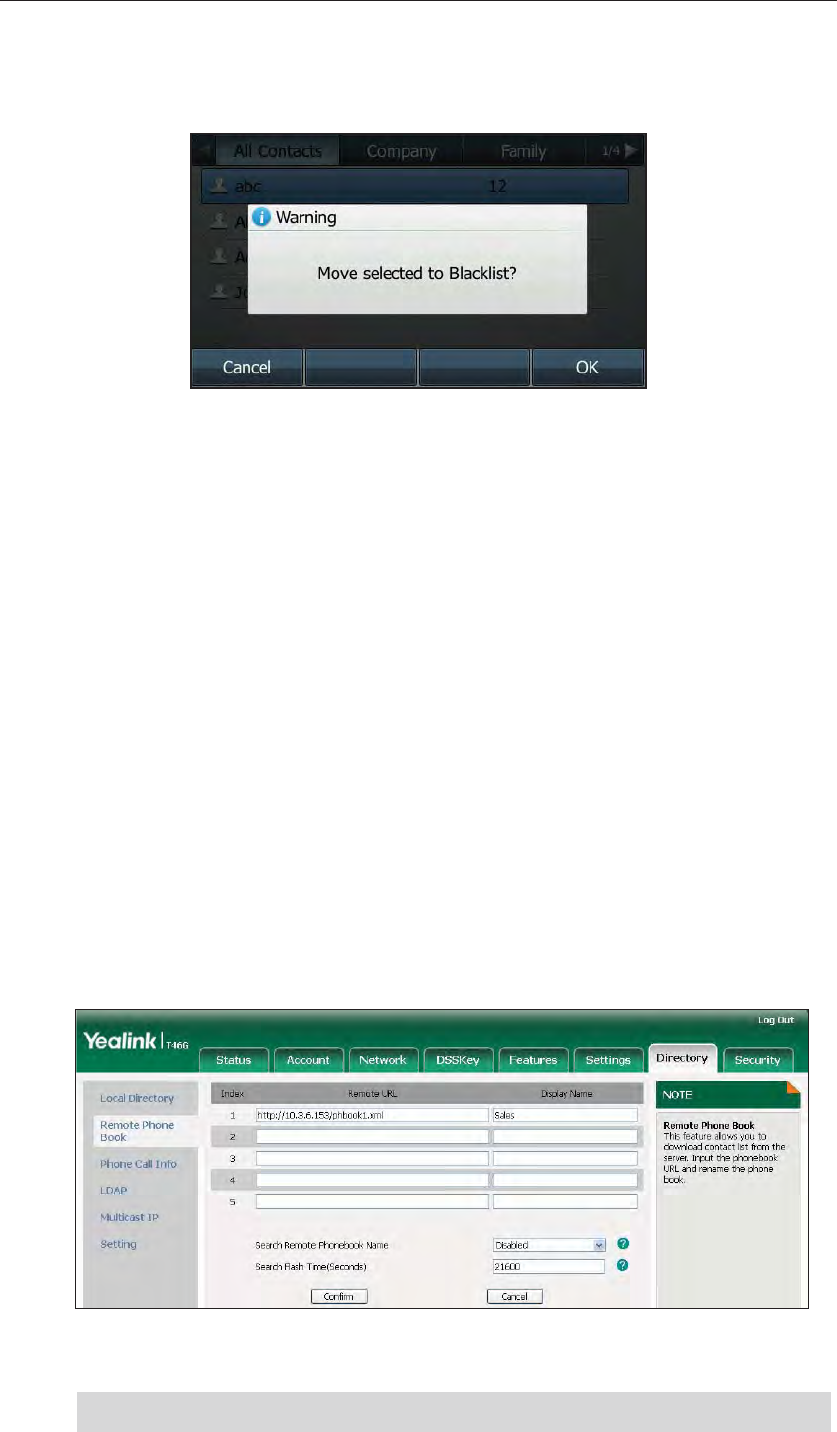
Customizing Your Phone
55
The LCD screen prompts the following warning:
5. Press the OK soft key to confirm the setting.
For operating instructions on editing, deleting, placing calls to and/or searching for
contacts in the blacklist directory, refer to the operating instructions of Local Directory
on page v.
4GOQVG2JQPG$QQM
You can add local contacts, search for a contact, or simply dial a contact number
from the corporate directory.
You can configure your new phone to access up to 5 corporate directories. All remote
phone books must be less than 0.5MB in size. For the access URL of the corporate
directory, contact your system administrator.
To configure an access URL for remote phone book via web user interface:
1. Click on Directory->Remote Phone Book.
2. Enter the access URL in the Remote URL field.
3. Enter the name in the Display Name field.
4. Click Confirm to accept the change.
Note An access URL for remote phone book is configurable via web user interface only.
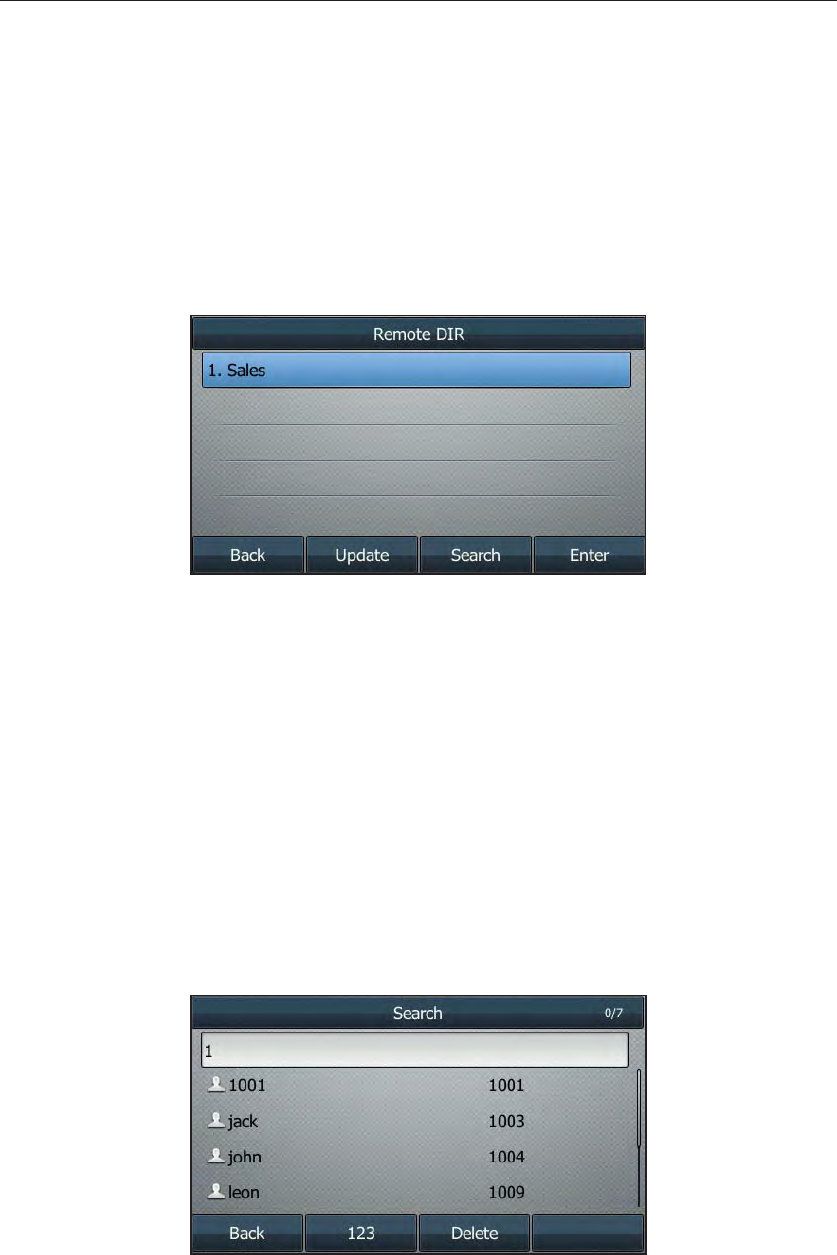
User Guide for the SIP-T48G IP Phone
56
To access your corporate directory via phone user interface:
1. Press Directory->Remote Phone Book.
If Remote Phone Book is removed from the directory, press
Menu->Directory->Remote Phone Book to enter remote phone book.
2. Select the desired remote group, and then press the Enter soft key.
The phone connects to load the corporate directory, and then the corporate
contact list appears on the LCD screen.
3. Press the Back soft key to back to the previous interface.
To search for a contact in the corporate directory:
1. Press Menu->Directory->Remote Phone Book.
If Remote Phone Book is added to the directory, press Directory->Remote Phone
Book to enter remote phone book.
2. Select the desired remote group, and then press the Enter soft key to load the
corporate directory.
3. Press the Search soft key.
4. Enter a few continuous characters of the contact name or continuous numbers of
the contact number using the keypad.
The contacts whose name or phone number matches the characters entered will
appear on the LCD screen. You can place a call from the result list.
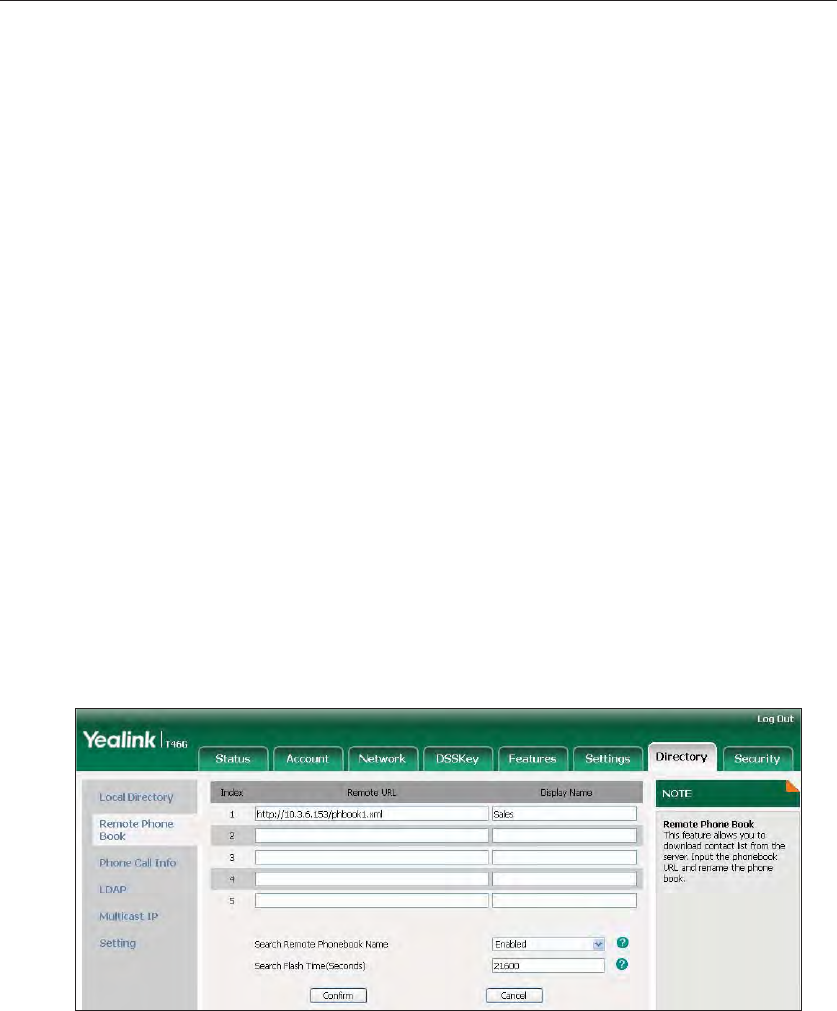
Customizing Your Phone
57
To place a call from the corporate directory:
1. Press Menu->Directory->Remote Phone Book.
If Remote Phone Book is added to the directory, press Directory->Remote Phone
Book to enter remote phone book.
2. Select the desired remote group, and then press the Enter soft key to load the
corporate directory.
3. Select the desired contact in the corporate directory.
4. Press the Send soft key.
In addition, you can enable the phone to present the caller identity stored in the
corporate directory when receiving a call.
To enable the presentation of caller identity stored in remote phone book via web user
interface:
1. Click on Directory->Remote Phone Book.
2. Select Enabled from the pull-down list of Search Remote Phonebook Name.
3. Enter the refresh period in the Search Flash Time (Seconds) field.
The default value is 21600 seconds.
4. Click Confirm to accept the change.
%CNN*KUVQT[/CPCIGOGPV
The SIP-T48G IP phone maintains call history lists of Missed calls, Placed calls, Received
calls and Forwarded calls. Call history lists support 400 entries in all. You can view the call
history, place a call, add a contact or delete an entry from the call history list. You
should enable history record in advance.
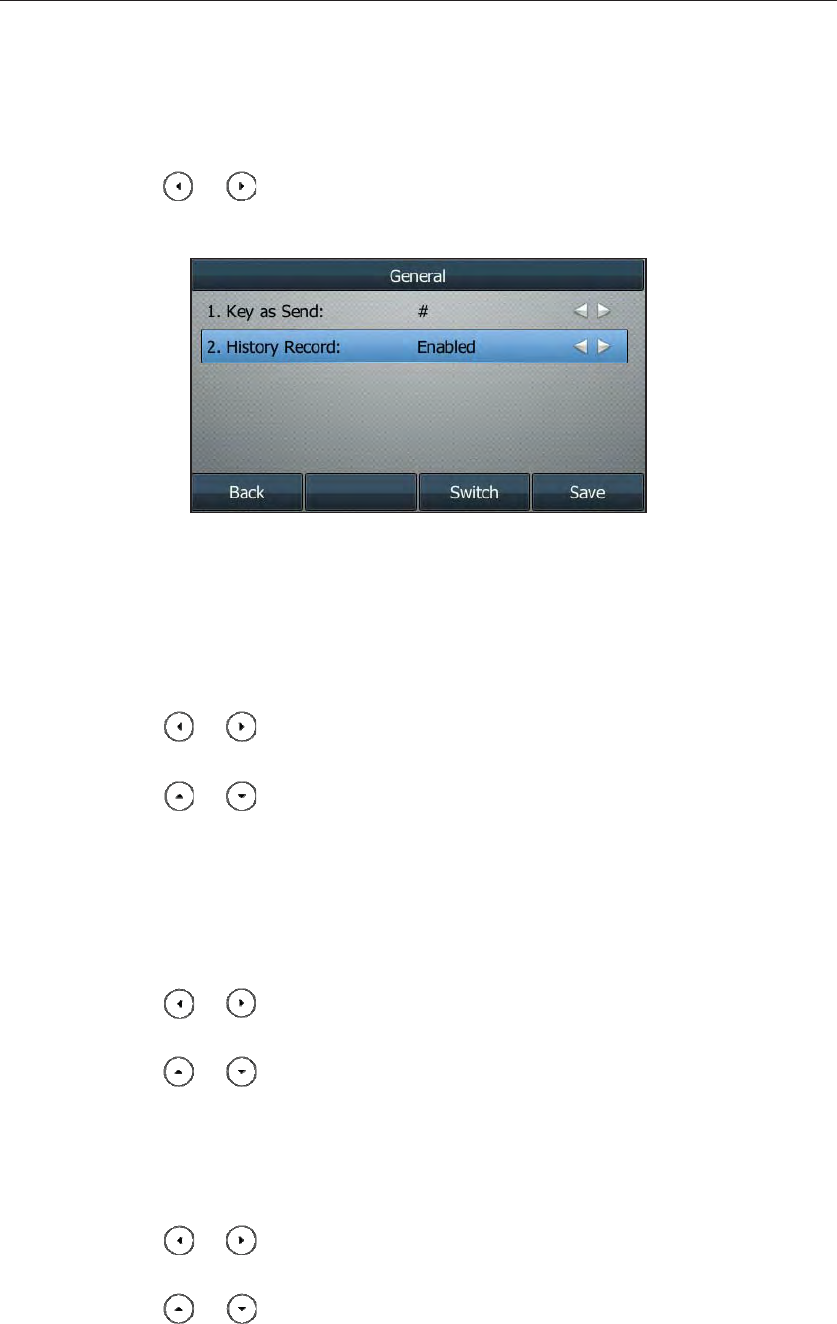
User Guide for the SIP-T48G IP Phone
58
To enable history record via phone user interface:
1. Press Menu->Call Features->Others->General.
2. Press or , or the Switch soft key to select Enabled from the History Record
field.
3. Press the Save soft key to accept the change or the Back soft key to cancel.
To view the call history:
1. Press the History soft key.
The LCD screen displays all call records.
2. Press or to switch between All, Missed, Placed, Received and Forwarded
call lists.
3. Press or to select the desired entry.
4. Press the Option soft key, and then select Detail from the prompt list.
The detailed information of the entry appears on the LCD screen.
To place a call from the call history list:
1. Press the History soft key.
2. Press or to switch between All, Missed, Placed, Received and Forwarded
call lists.
3. Press or to select the desired entry.
4. Press the Send soft key.
To add a contact to the local directory (or blacklist directory) from the call history list:
1. Press the History soft key.
2. Press or to switch between All, Missed, Placed, Received and Forwarded
call lists.
3. Press or to select the desired entry.
4. Press the Option soft key, and then select Add to Contacts (or Add to Blacklist) from
the prompt list.
5. Enter the desired values in the corresponding fields.

Customizing Your Phone
59
6. Press the Save soft key.
For more information, refer to Contact Management on page 39.
To delete an entry from the call history list:
1. Press the History soft key.
2. Press or to switch between All, Missed, Placed, Received and Forwarded
call lists.
3. Press or to select the desired entry.
4. Press the Delete soft key.
To delete all entries from the call history list:
1. Press the History soft key.
2. Press or to switch between All, Missed, Placed, Received and Forwarded
call lists.
3. Press the Option soft key, and then select Delete All from the prompt list.
4. Press the OK soft key.
The LCD screen prompts "Delete all records?".
5. Press the OK soft key to confirm the deletion or the Cancel soft key to cancel.
5[UVGO%WUVQOK\CVKQPU
*GCFUGV7UG
If you want to use a wired headset, physically connect your headset and activate the
headset mode for use. For more information on physically connecting a headset, refer
to Phone Installation on page 16.
If you want to use a wireless headset, insert the Bluetooth USB dongle into the USB port on
the back of the phone. For more information on using a Bluetooth headset, refer to
Bluetooth Headset on page 61.
This section provides the introduction of the wired headset.
Note
*GCFUGV/QFG#EVKXCVKQP&GCEVKXCVKQP
To activate the headset mode:
1. Press on the phone.
The HEADSET key LED illuminates solid green when the headset mode is activated.
Press the line key or the Answer soft key to answer an incoming call. The call will be
If both a Bluetooth headset and a wired headset are connected, only the Bluetooth
headset can be used.
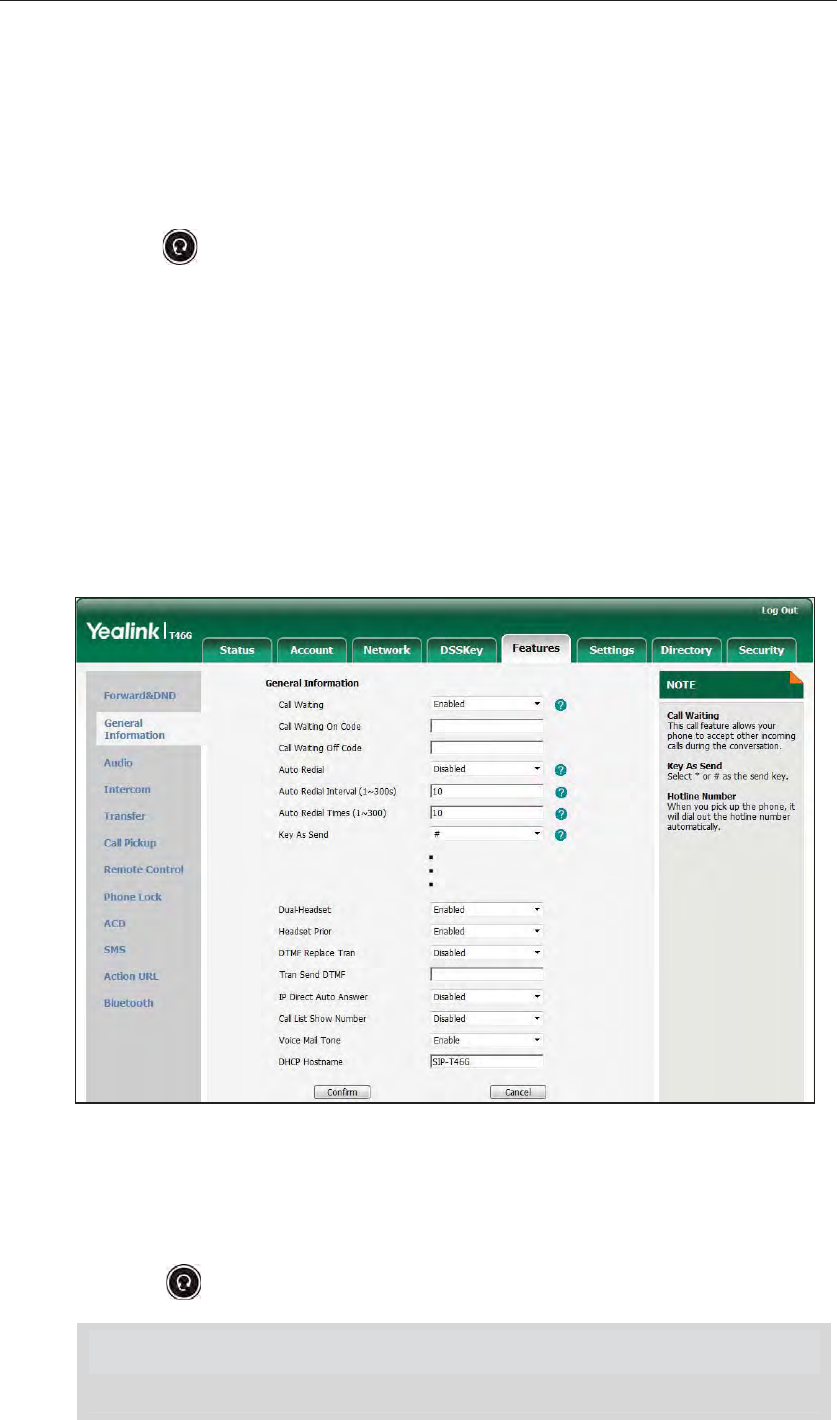
User Guide for the SIP-T48G IP Phone
60
connected to your headset automatically.
Enter the desired number and press the Send soft key, then the phone will place a
call using the headset automatically. For more information on using the headset to
place a call, refer to Placing Calls on page 90.
To deactivate the headset mode:
1. Press again on the phone.
The HEADSET key LED goes out when the headset mode is deactivated.
*GCFUGV2TKQT
You can use headset in priority when enabling headset prior. This feature is especially
useful for permanent or full-time headset users.
To enable headset prior via web user interface:
1. Click on Features->General Information.
2. Select Enabled from the pull-down list of Headset Prior.
3. Click Confirm to accept the change.
To use headset prior, you should activate the headset mode in advance:
1. Physically connect the headset.
2. Press to activate the headset mode.
Note If headset prior is enabled, the headset mode will not be deactivated until you press the
HEADSET key again.
Headset prior is configurable via web user interface only.
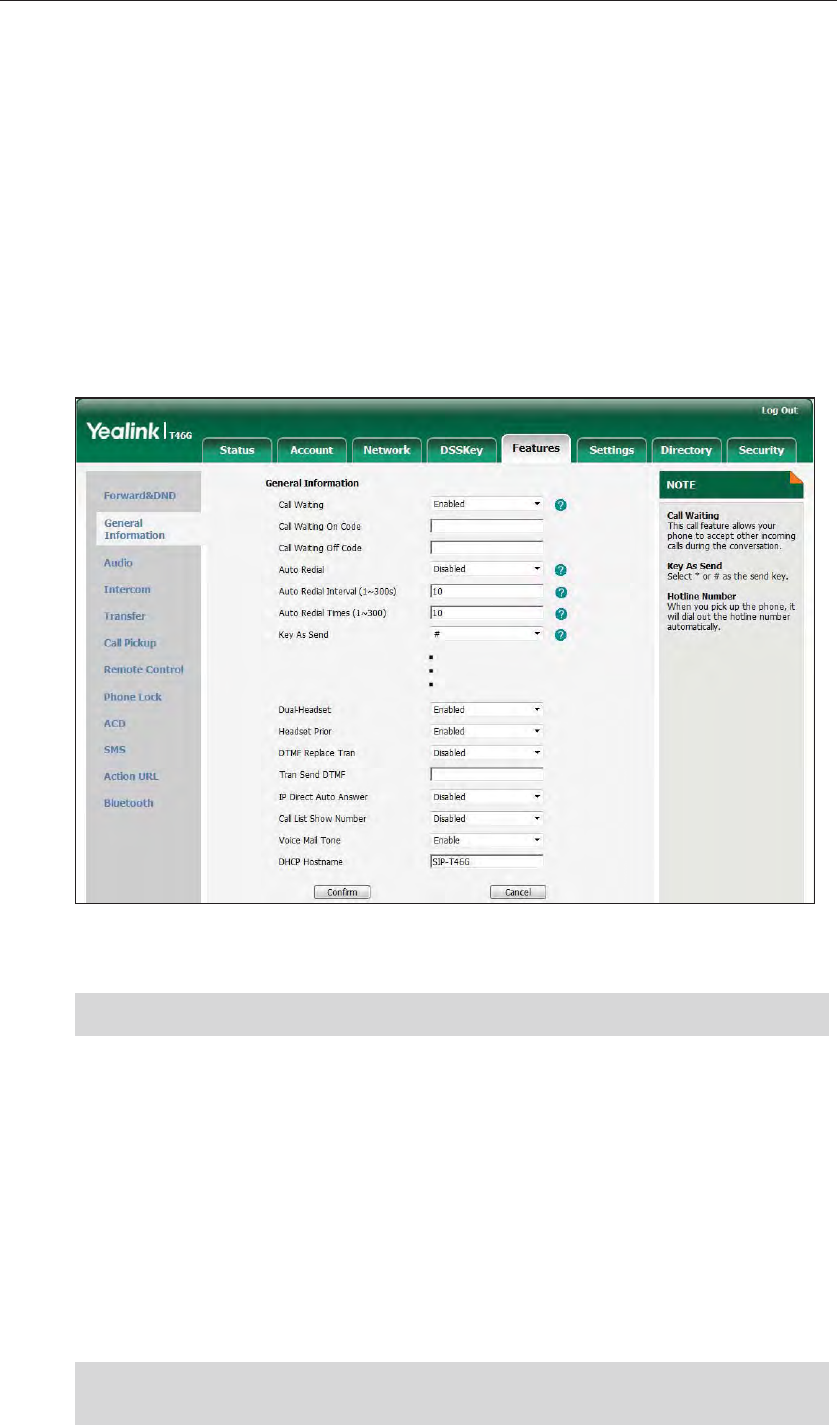
Customizing Your Phone
61
&WCN*GCFUGV
You can use two headsets when enabling dual headset. To use this feature, you must
physically connect headsets to the headset jack and handset jack respectively. Once
the phone connects to a call, the headset connected to the headset jack will have
full-duplex capabilities, while the one connected to the handset jack will only be able
to listen.
To enable dual headset via web user interface:
1. Click on Features->General Information.
2. Select Enabled from the pull-down list of Dual-Headset.
3. Click Confirm to accept the change.
Note
$NWGVQQVJ*GCFUGV
The SIP-T48G IP phone supports Bluetooth. Bluetooth enables low-bandwidth wireless
connections within a range of 10 meters (32 feet). The best performance is in the 1- to
2-meter (3- to 6-foot) range.
You can activate/deactivate the Bluetooth mode, and then pair and connect the
Bluetooth headset with your phone. You can also disconnect and delete your
Bluetooth headset from the phone.
Note
Dual headset is configurable via web user interface only.
Ensure that the Bluetooth USB dongle is properly connected into the USB port on the
back of the phone. For more information, refer to Phone Installation on page 11.
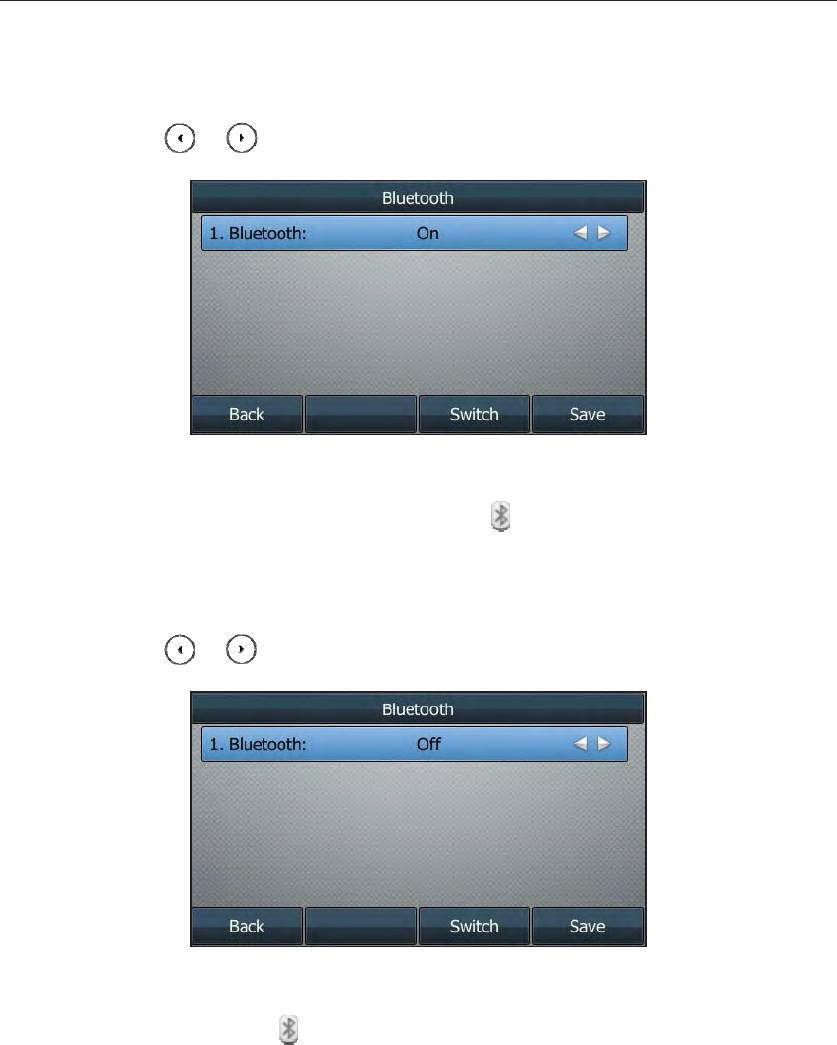
User Guide for the SIP-T48G IP Phone
62
To activate the Bluetooth mode via phone user interface:
1. Press Menu->Basic->Bluetooth.
2. Press or , or the Switch soft key to select On from the Bluetooth field.
3. Press the Save soft key to accept the change.
The LCD screen displays the Bluetooth icon .
To deactivate the Bluetooth mode via phone user interface:
1. Press Menu->Basic->Bluetooth.
2. Press or , or the Switch soft key to select Off from the Bluetooth field.
3. Press the Save soft key to accept the change.
The Bluetooth icon disappears from the phone.
Bluetooth mode is configurable via web user interface at the path Features->Bluetooth.
Before you pair a Bluetooth headset, check the indicator on the Bluetooth headset to
make sure the Bluetooth headset is discoverable. For more information, refer to the
documentation from the Bluetooth headset manufacturer.
To pair and connect your Bluetooth headset to your phone:
1. Press Menu->Basic->Bluetooth.
2. Press the Scan soft key to search the Bluetooth devices.
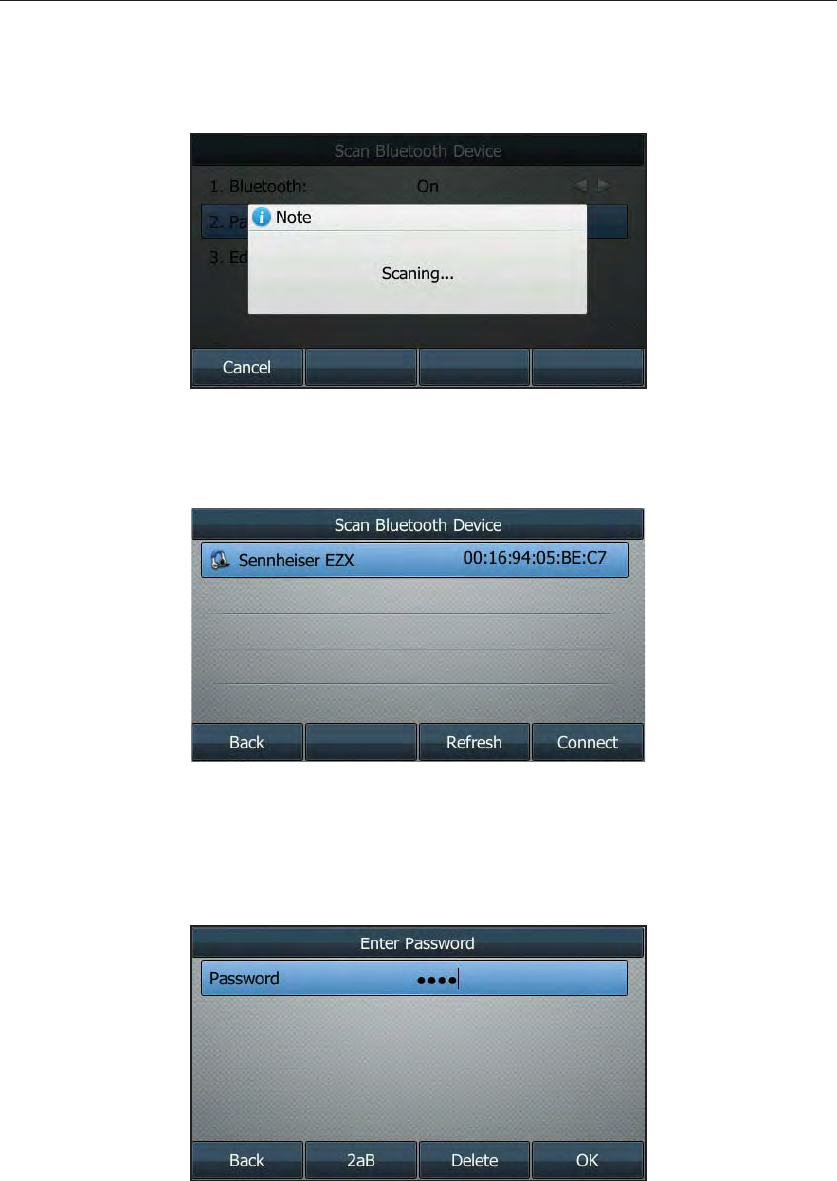
Customizing Your Phone
63
The LCD screen prompts the following message:
The phone proceeds to scan the local Bluetooth devices. When the phone
completes scan, it will display the found Bluetooth devices on the LCD screen.
3. Select the desired Bluetooth headset and press Connect soft key.
4. Enter the PIN in the Password field.
The default PIN is “0000” or “1234”.
5. Press the OK soft key.
After a while, the Bluetooth headset is automatically connected to your phone.
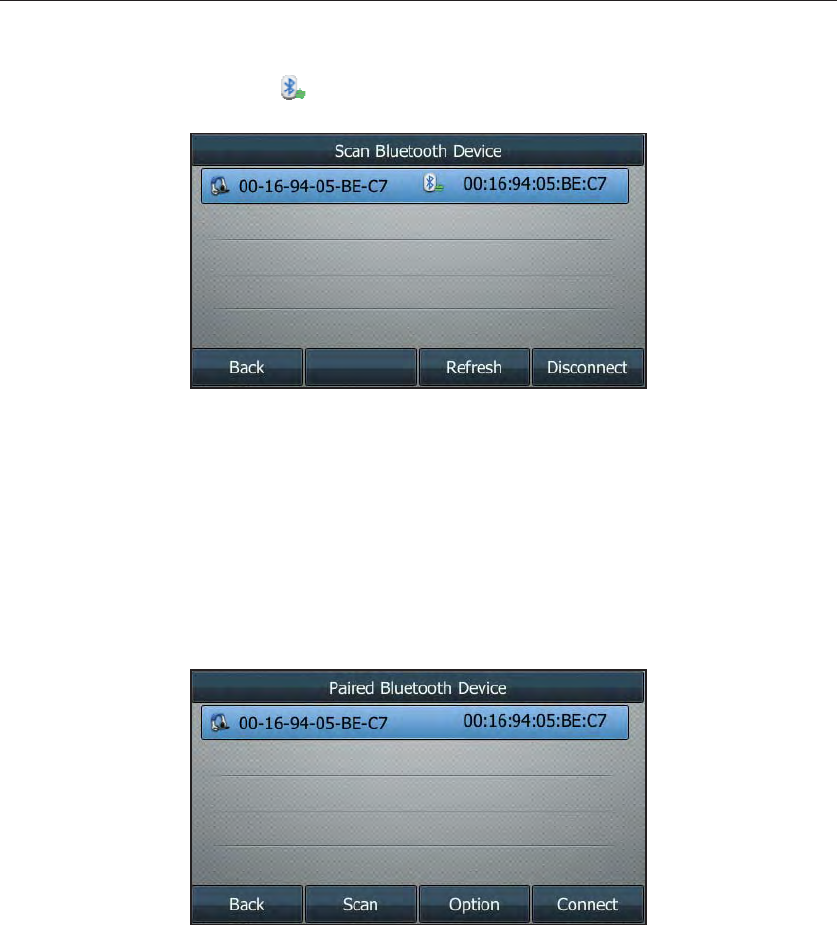
User Guide for the SIP-T48G IP Phone
64
The Bluetooth icon appears on the LCD screen.
With the Bluetooth headset paired and connected, you can use the Bluetooth headset
to place and answer calls. For more information, refer to the documentation from the
Bluetooth headset manufacturer.
To view the Bluetooth headset information:
1. Press Menu->Basic->Bluetooth->Paired Bluetooth Device.
The LCD screen displays a list of paired and connected Bluetooth headsets.
2. Select the desired Bluetooth headset.
3. Press the Option soft key, and then select Detail from the prompt list to view the
Bluetooth headset information:
zDevice Name: the name of the Bluetooth headset.
zMAC Address: the MAC address of the Bluetooth headset.
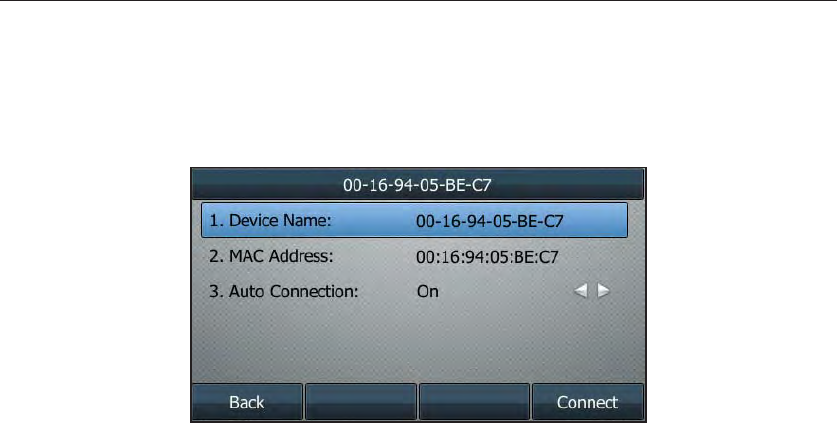
Customizing Your Phone
65
zAuto Connection: Enables or disables the Bluetooth headset to connect with the
phone automatically.
To change the priority of paired Bluetooth devices
˖
1. Press Menu->Basic->Bluetooth->Paired Bluetooth Device.
2. Select the desired Bluetooth headset.
3. Press the Option soft key, and then select Move Up or Move Down from the prompt
list.
The top one has the highest priority. When there is no Bluetooth headset connected,
the phone will automatically connect to the Bluetooth headset with the highest
priority.
You can disconnect the Bluetooth headset from your phone. When you disconnect the
Bluetooth headset, it still displays in the Paired Bluetooth Device list. You can easily
connect it to your phone again.
To disconnect your Bluetooth headset from your phone:
1. Press Menu->Basic->Bluetooth->Paired Bluetooth Device.
2. Select the connected Bluetooth headset.
3. Press the Disconnect soft key.
The Bluetooth headset is disconnected. To connect it to your phone again, press
the Connect soft key.
You can delete your Bluetooth headset from your phone. When you delete the
Bluetooth headset, it disappears from the Paired Bluetooth Device list. To connect it to
your phone again, you need to scan and connect it again.
To delete your Bluetooth headset from your phone:
1. Press Menu->Basic->Bluetooth->Paired Bluetooth Device.
2. Select the Bluetooth headset you want to delete.
3. Press the Option soft key, and then select Delete from the prompt list.
The LCD screen prompts the following warning “Delete the selected item?”.

User Guide for the SIP-T48G IP Phone
66
4. Press the OK soft key to confirm the deletion or the Cancel soft key to cancel.
Note
&55-G[U
Two types of DSS keys: Line Keys and Programmable Keys. Details will be introduced in
the following. The SIP-T48G IP phone supports 27 line keys.
.KPG-G[U
You can assign predefined functionalities to line keys. You can also define a label for
line key feature which will appear on the LCD screen. Line keys allow you to quickly
access features such as call return and voice mail. The line key LEDs will indicate the
monitored status when the line keys are assigned with particular features, such as BLF.
The default key type of line key 1-6 is Line. The default key type of line key 7-27 is N/A,
which indicates that this line key provides no functionality until configuration.
To assign functionality to the line key via phone user interface:
1. Press Menu->Call Features->DSS Keys.
2. Select the desired line key, and then press the Enter soft key.
3. Select the desired key type from the Type field.
4. (Optional.) Select the desired key event type from the Key Event field.
5. (Optional.) Select the desired line from the Account ID field.
6. (Optional.) Enter a string that will appear on the LCD screen in the Label field.
7. (Optional.) Enter the corresponding value in the Value field.
8. (Optional.) Enter the corresponding value in the Extension field.
9. Press the Save soft key to accept the change or the Back soft key to cancel.
Line key is configurable via web user interface at the path DSSKey->Line Key.
Note
You can also delete all headsets by pressing the Option soft key and then select Delete
All. For more information, refer to the above steps.
If you cannot connect a Bluetooth headset to the phone successfully, we recommend
you to delete the Bluetooth headset in the Paired Bluetooth Device list (if existed) before
pairing it.
When the phone is idle, you can also long press the line key to configure it directly on the
phone.
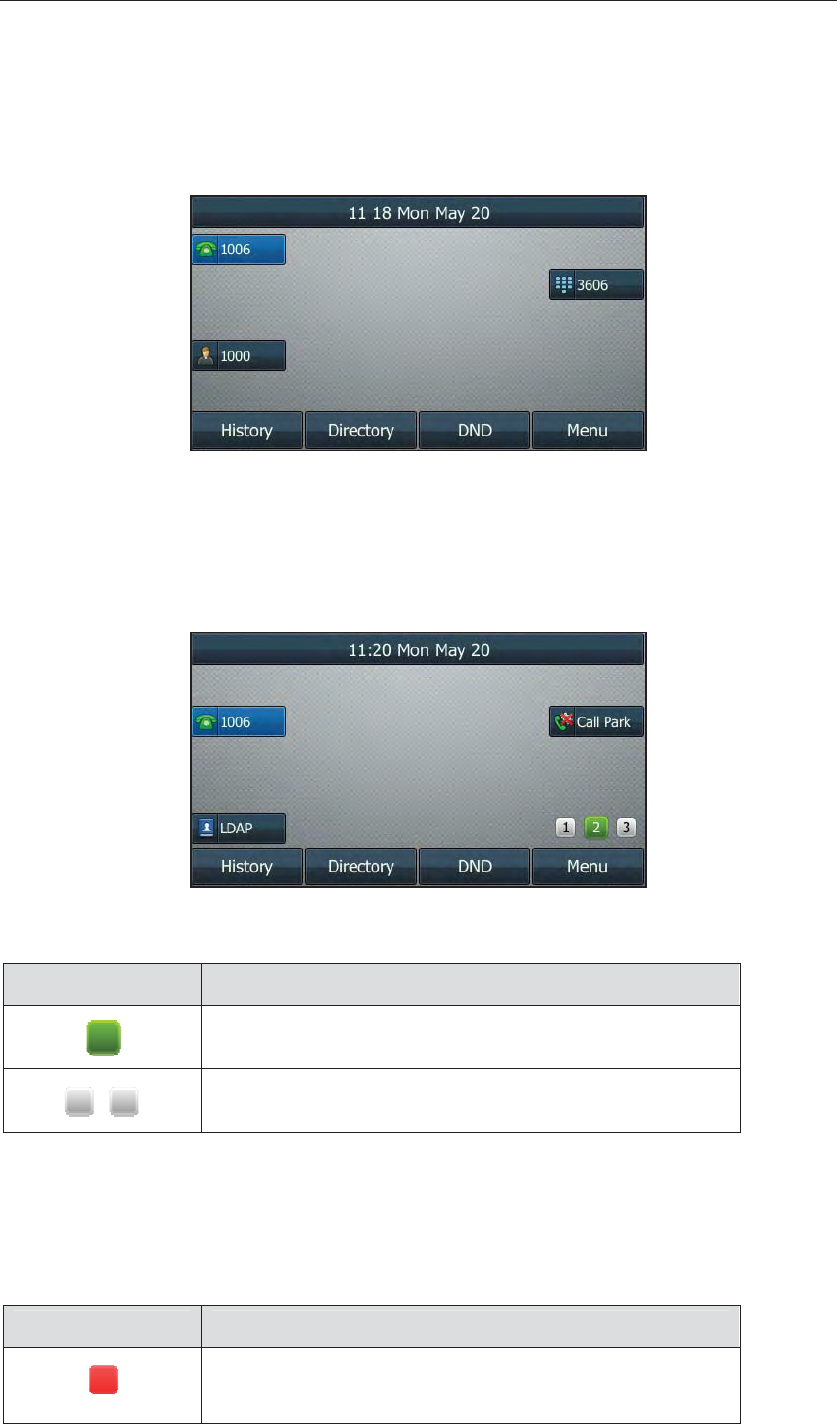
Customizing Your Phone
67
You can assign functionalities to 27 line keys. These 27 line keys are indicated on three
pages. When you assign functionality to line keys located in line key 1-10, the labels of
line keys are indicated on the first page. The following figure shows an example:
When you assign functionality to line key located in line key 11-27, the label of the line
key 10-18 are indicated on the second page, and the labels of the line key 19-27 are
indicated on the third page. The right bottom line key is used to switch pages. The
following figure shows an example:
The following table lists the page icon status:
Icons Description
Indicates the current page of line keys.
Indicates the non-current page of line keys.
You can configure the page icon and page switch key LED to indicate different
statuses. This feature is disabled by default. For more information on the page switch
key LED status, refer to LED Instructions on page 8.
The following table lists the page icon status to indicate different statuses:
Icons Description
Fast flashing:
The BLF monitored user receives an incoming call on the
2
3
1
1
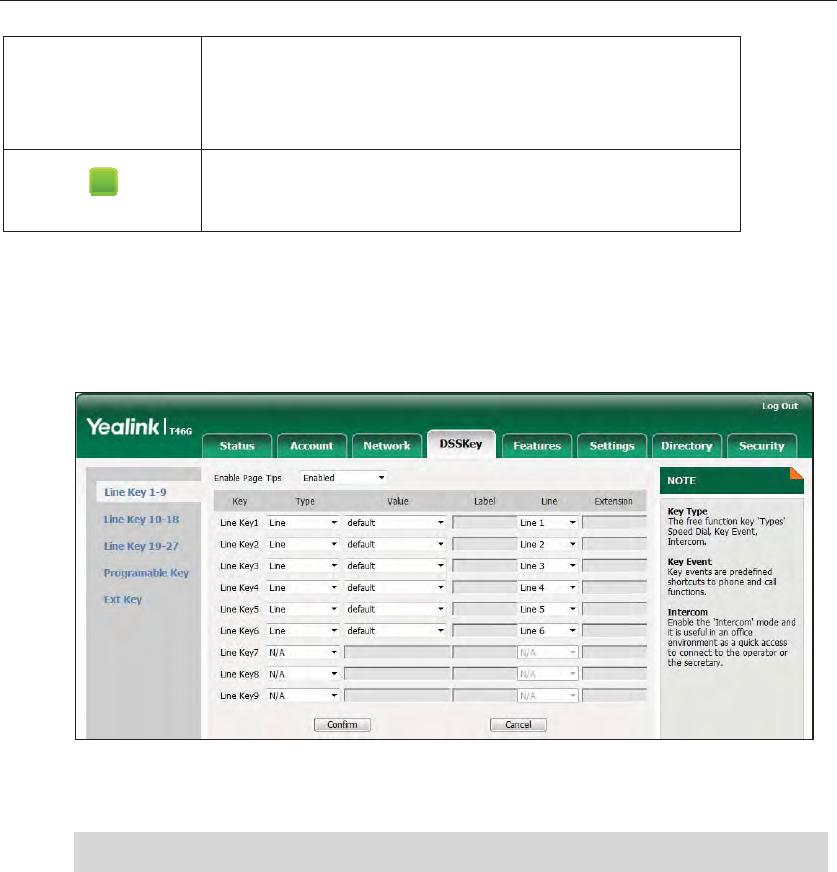
User Guide for the SIP-T48G IP Phone
68
non-current page.
Solid red:
There is a parked call on the non-current page.
Fast flashing:
The line receives an incoming call on the non-current page.
To configure the page icon to indicate status via web user interface:
1. Click on DSSKey->Line Key.
2. Select Enabled from the pull-down list of Enable Page Tips.
3. Click Confirm to accept the change.
Note
Line key features are explained in the following subchapters in detail:
zLine
zSpeed Dial
zVoice Mail
zDirected Pickup
zGroup Pickup
zDTMF
zPrefix
zLocal Group
zXML Group
zXML Brower
zLDAP
zConference
1
The page icon status is configurable via web user interface only.

Customizing Your Phone
69
zForward
zTransfer
zHold
zDND
zSMS
zGroup Listening
zZero Touch
zURL
zKeypad Lock
zDirectory
For more information, contact your system administrator.
Line
You can use this key feature to accept the incoming calls, place active calls on hold or
resume a held call. It performs the same as a hard line key.
Dependencies: Type (Line)
Account ID (the account this feature will be applied to)
Value (Default/Lock/Float)
Usage: When receiving an incoming call, the DSS key LED flashes green:
1. Press the DSS key to accept the incoming call.
2. Press the DSS key to place the active call on hold.
3. Press the DSS key again to resume the held call.
If you select Lock from the Value field, the line keys located in the same position of the
other page will be automatically assigned Line feature with Lock filled in the Value field.
Then you can use this key on every page. This feature is only applicable to line key 1-9.
If you select Float from the Value field, the phone will automatically switch to the page
the line key located, when the line key receives an incoming call.
Speed Dial
You can use this key feature to speed up dialing the numbers often used or hard to
remember.
Dependencies: Type (Speed Dial)
Account ID (the account this feature will be applied to)
Label (key label displayed on the LCD screen)
Value (the number you want to dial out)
Usage: Press the DSS key to dial out the number specified in the Value field, using the
account selected from the Account ID field.

User Guide for the SIP-T48G IP Phone
70
Voice Mail
You can use this key feature to connect voice mail quickly. For more information, refer
to Voice Mail on page 147.
Dependencies: Type (Key Event)
Key Event (Voice Mail)
Account ID (the account this feature will be applied to)
Label (key label displayed on the LCD screen)
Value (the voice mail access code)
Usage: Press the DSS key to dial out the voice mail access code, you can follow the
voice prompt to listen to the voice mails.
Directed Pickup
You can use this key feature to answer someone else’s incoming call on the phone.
Dependencies: Type (Key Event)
Key Event (Directed Pickup)
Account ID (the account this feature will be applied to)
Label (key label displayed on the LCD screen)
Value (the directed pickup code followed by the specific phone
number)
Usage: Press the DSS key on your phone when the specific phone number receives an
incoming call. The call is answered on your phone.
Group Pickup
You can use this key feature to answer incoming calls in a group that is associated with
their own group.
Dependencies: Type (Key Event)
Key Event (Group Pickup)
Account ID (the account this feature will be applied to)
Label (key label displayed on the LCD screen)
Value (the group pickup feature code)
Usage: Press the DSS key on your phone when a phone number in the group receives
an incoming call. The call is answered on your phone.
DTMF
You can use this key feature to send the specification of arbitrary key sequences via
DTMF.
Dependencies: Type (Key Event)
Key Event (DTMF)

Customizing Your Phone
71
Label (key label displayed on the LCD screen)
Value (DTMF sequence)
Note
Usage: Press the DSS key during an active call to send the key sequence specified in the
Value field.
Prefix
You can use this key feature to add a specified prefix number before the dialed
number.
Dependencies: Type (Key Event)
Key Event (Prefix)
Label (key label displayed on the LCD screen)
Value (the prefix number)
Usage: Press the DSS key when the phone is idle, then the phone will enter into the
dialing screen and display the prefix number which you specified in the Value field. You
can enter other digits and then dial out.
Local Group
You can use this key feature to access the contact group in the local directory quickly.
For more information, refer to Local Directory on page v.
Dependencies: Type (Key Event)
Key Event (Local Group)
Local Group (the contact group name you want to access)
Label (key label displayed on the LCD screen)
Usage: Press the DSS key to access the contact group specified in the Local Group field.
XML Group
You can use this key feature to access remote group in your corporate directory quickly.
You should configure remote phone book in advance. For more information, refer to
Remote PhoneBook on page 55.
Dependencies: Type (Key Event)
Key Event (XML Group)
XML Group (the remote group name you want to access if remote
phone book is configured)
Label (key label displayed on the LCD screen)
Usage: Press the DSS key to access the remote group specified in the XML Group field.
XML Browser
You can use this key feature to access the XML browser quickly. The XML browser allows
DTMF sequence can only contain "0-9", "*", "#" and "A-D".

User Guide for the SIP-T48G IP Phone
72
you to create custom services which meet your functional requirements on the server.
You can customize practical applications, such as weather report, stock information,
Google search, etc.
Dependencies: Type (Key Event)
Key Event (XML Browser)
Label (key label displayed on the LCD screen)
Value (the access URL for XML browser)
Usage: Press the DSS key to access the XML browser specified in the Value field.
LDAP
You can use this key feature to access the LDAP search interface quickly.
Dependencies: Type (Key Event)
Key Event (LDAP)
Label (key label displayed on the LCD screen)
Usage:
1. Press the DSS key to access the LDAP search interface.
2. Enter a few continuous characters of the contact name or continuous numbers of
the contact number using the keypad.
The contacts whose name or phone number matches the characters entered will
appear on the LCD screen.
Conference
You can use this key feature to set up a conference call. For more information, refer to
Conference on page 116.
Dependencies: Type (Key Event)
Key Event (Conference)
Label (key label displayed on the LCD screen)
Value (the number you want to add to the conference)
Usage: Press the DSS key during an active call to set up a conference with the number
specified in the Value field.
Note
Forward
You can use this key feature to forward an incoming call to someone else. For more
information, refer to Call Forward on page 105.
Dependencies: Type (Key Event)
Key Event (Forward)
When leaving the Value field blank, the DSS key performs the same as the Conference
soft key during a call.

Customizing Your Phone
73
Label (key label displayed on the LCD screen)
Value (the number you want to forward to)
Usage:
1. Press the DSS key to forward an incoming call to the number specified in the Value
field.
2. When call forward is in phone mode, press the DSS key to activate call forward for
the phone.
3. When call forward is in custom mode, press the DSS key to access the custom call
forward interface. You can activate or deactivate call forward for one or all
accounts.
Note
Transfer
You can use this key feature to handle the call differently depending on the transfer
mode on DSS key when there is an active call on the phone.
Dependencies: Type (Key Event)
Key Event (Transfer)
Label (key label displayed on the LCD screen)
Value (the number you want to transfer to)
Usage:
zWhen the transfer mode on DSS key is Blind Transfer, press the DSS key to complete the
blind transfer to the number specified in the Value field.
zWhen the transfer mode on DSS key is Attended Transfer, press the DSS key to dial out
the number specified in the Value field, and then perform the attended or
semi-attended transfer.
zWhen the transfer mode on DSS key is New Call, press the DSS key to place a new call
to the number specified in the Value field.
Note
Hold
You can use this key feature to place an active call on hold or retrieve a held call.
Transfer mode via DSS key is configurable via web user interface at the path
Features->Transfer. For more information on how to configure the transfer mode via DSS
key, refer to Busy Lamp Field (BLF) on page 116.
When leaving the Value field blank, the DSS key performs the same as the TRANSFER key
or the Transfer soft key during a call. For more information, refer to Call Transfer on page
104.
If the Value field is left blank, the DSS key performs the same as the Forward soft key
when receiving an incoming call.
When call forward is activated, the forward key LED will illuminate solid green.

User Guide for the SIP-T48G IP Phone
74
Dependencies: Type (Key Event)
Key Event (Hold)
Label (key label displayed on the LCD screen)
Usage:
1. Press the DSS key during an active call to place the call on hold.
2. Press the DSS key again to retrieve the held call.
DND
You can use this key feature to activate or deactivate DND. You can also use this key
feature to access the custom DND interface. For more information, refer to Do Not
Disturb (DND) on page 101.
Dependencies: Type (Key Event)
Key Event (DND)
Label (key label displayed on the LCD screen)
Usage:
When DND is in phone mode:
1. Press the DSS key to activate DND.
2. Press the DSS key again to deactivate DND.
When DND is in custom mode:
1. Press the DSS key to access the custom DND interface. You can activate or
deactivate DND for one or all accounts.
Note
SMS
You can use this key feature to access text message quickly. For more information, refer
to Short Message Service (SMS) on page 144.
Dependencies: Type (Key Event)
Key Event (SMS)
Label (key label displayed on the LCD screen)
Usage: Press the DSS key when the phone is idle to access text message.
Group Listening
You can use this key feature to activate the Speakerphone and Handset/Headset
mode at the same time. It is suitable for the group conversation which has more than
one person at one side. You are able to speak and listen through the handset/headset,
meanwhile the others nearby can only listen through the speaker.
Dependencies: Type (Key Event)
Key Event (Group Listening)
When DND is activated, the DND key LED will illuminate solid green, and the incoming
calls will be rejected automatically.

Customizing Your Phone
75
Label (key label displayed on the LCD screen)

User Guide for the SIP-T48G IP Phone
76
Usage:
1. During a call, press the DSS key to activate the group listening mode.
You can then speak and listen through the handset/headset, other people at your
side can listen through speaker at the same time.
2. Press the DSS key again to deactivate the group listening mode.
Zero Touch
You can use this key feature to configure auto provision and network parameters
quickly.
Dependencies: Type (Key Event)
Key Event (Zero Touch)
Label (key label displayed on the LCD screen)
Usage:
1. Press the DSS key to access the zero touch screen.
2. Press the OK soft key within a few seconds.
3. Configure the network parameters in the corresponding fields.
4. Press the Next soft key.
5. Configure the auto provision parameters in the corresponding fields.
6. Press the OK soft key.
The phone will reboot to update configurations.
URL
You can use this key feature to trigger the phone to send an HTTP GET request
containing a specific URL.
Dependencies: Type (URL)
Label (key label displayed on the LCD screen)
URL (the URL contained in the HTTP GET request)
Usage: Press the DSS key to trigger the phone to send an HTTP GET request containing
the URL specified in the URL field.
Keypad Lock
You can use this key feature to immediately lock the keypad of your phone instead of
long pressing . For more information, refer to Keypad Lock on page 32.
Dependencies: Type (Key Event)
Key Event (Keypad Lock)
Label (key label displayed on the LCD screen)
Usage: Press the DSS key to immediately lock the keypad of your phone instead of long
pressing .
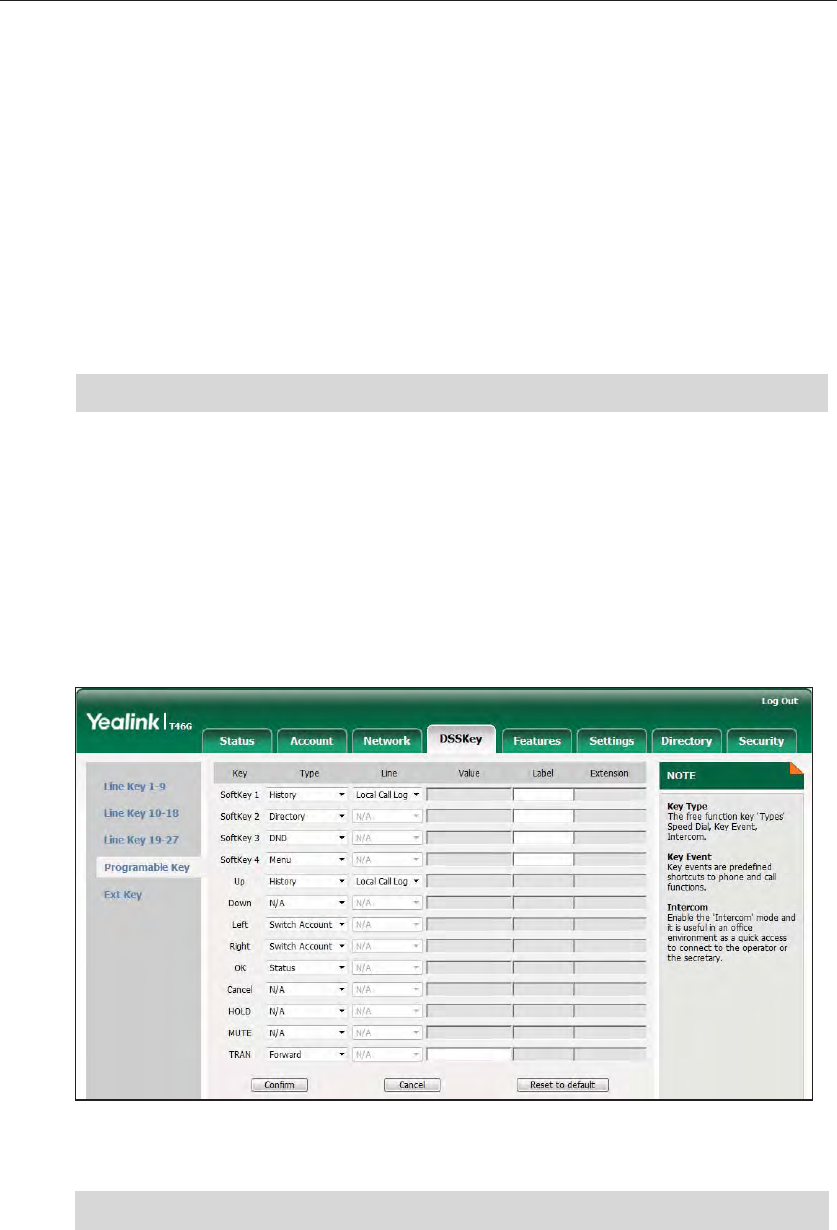
Customizing Your Phone
77
Directory
You can use this key feature to easily access frequently used lists. For more information,
refer to Directory on page 39.
Dependencies: Type (Key Event)
Key Event (Directory)
Label (key label displayed on the LCD screen)
Usage: Press the DSS key to immediately access to frequently used lists.
Note
2TQITCOOCDNG-G[U
You can customize the soft keys, navigation keys and function keys.
To customize the programmable keys via web user interface:
1. Click on DSSKey->Programmable Key.
2. Customize specific features for these keys.
3. Click Confirm to accept the change.
Note Programmable keys are configurable via web user interface only.
The DSS key performs the same function as the Directory soft key when the phone is idle.
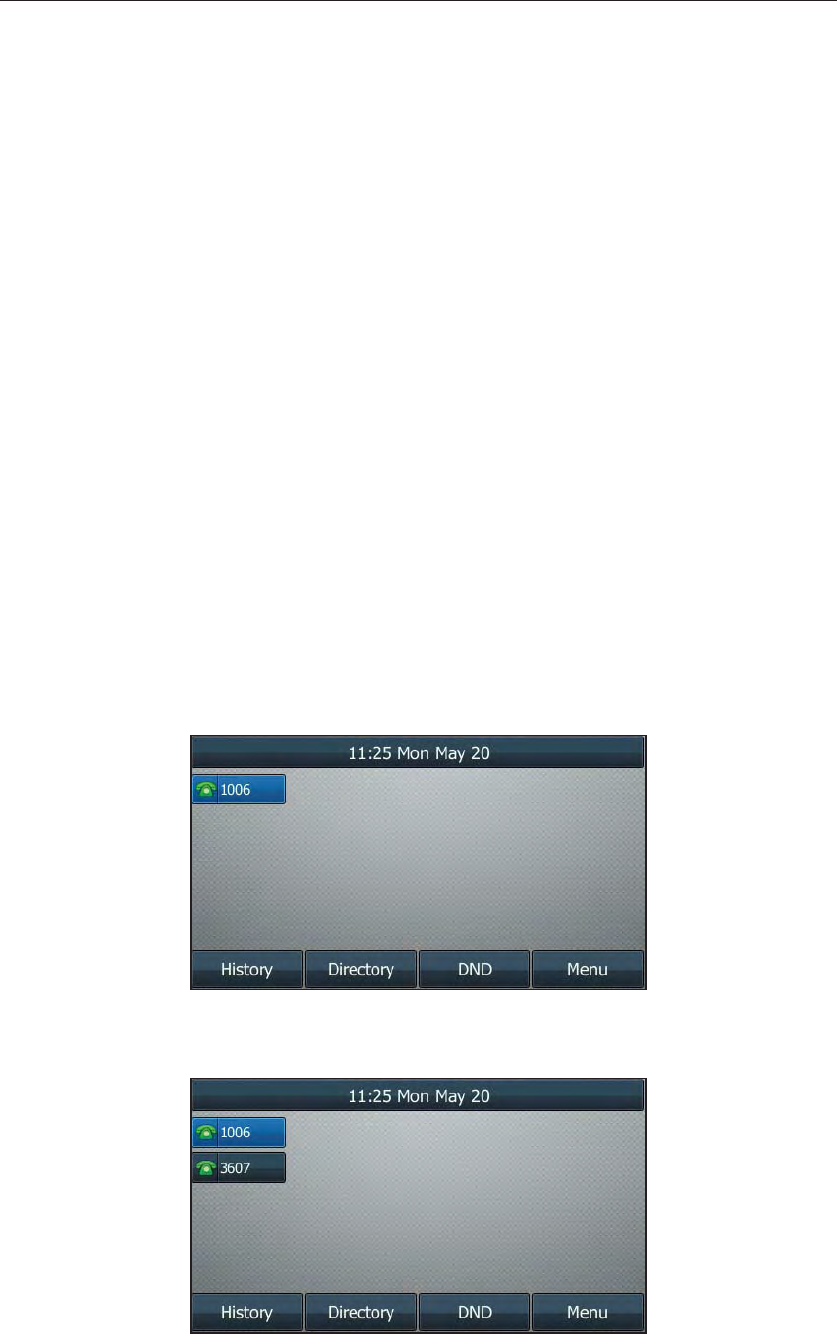
User Guide for the SIP-T48G IP Phone
78
#EEQWPV/CPCIGOGPV
You can register one or multiple accounts on the SIP-T48G IP phone. You can also
configure each line key to associate with an account or configure multiple line keys to
associate with an account.
#EEQWPV4GIKUVTCVKQP
To register an account via phone user interface:
1. Press Menu->Advanced (password: admin) ->Account.
2. Select the desired account and then press the Enter soft key.
3. Select Enabled from the Account Status field.
4. Enter the desired values in Label, Display Name, Register Name, User Name,
Password and SIP Server1/2 fields respectively. Contact your system administrator
for more information.
5. Press the Save soft key to accept the change or the Back soft key to cancel.
You can repeat steps 2 to 5 to register more accounts.
The following figures show single or multiple accounts registered on the phone:
Single account:
Multiple accounts:

Customizing Your Phone
79
To disable an account via phone user interface:
1. Press Menu->Advanced (password: admin) ->Account.
2. Select the desired account and then press the Enter soft key.
3. Select Disabled from the Account Status field.
4. Press the Save soft key to accept the change or the Back soft key to cancel.
Registering an account is configurable via web user interface at the path
Account->Register.
/WNVKRNG.KPG-G[URGT#EEQWPV
You can configure multiple line keys to associate with an account. This enhances call
visualization and simplifies call handling.
If this is the case, the LCD screen resembles the following figure:
Incoming calls to this account will be distributed evenly among the available line keys.
Outgoing calls will be distributed similarly.
Your phone can be configured to have a combination of accounts with a single line
key and accounts with multiple line keys.
&KCN2NCP
Dial plan is a string of characters that governs the way your SIP-T48GIP phone processes
the inputs received from your phone keypad. The SIP-T48G IP phone supports the
following dial plan features:
zReplace Rule
zDial-now
zArea Code
zBlock Out

User Guide for the SIP-T48G IP Phone
80
Basic expression syntaxes you need to know:
Syntax Description
.
The dot "." can be used as a placeholder or multiple placeholders for
any character. Example:
"12." would match "123", "1234", "12345", "12abc", etc.
x An "x" can be used as a placeholder for any character. Example:
"12x" would match "121", "122", "123", "12a", etc.
[]
The square brackets "[]" can be used as a placeholder for a single
character which matches any of a set of characters. Example:
"91[5-7]1234" would match "9151234", "9161234", "9171234", etc.
()
The parentheses "( )" can be used to group together patterns, for
instance, to logically combine two or more patterns. Example:
"([1-9])([2-7])3" would match "923", "153", "773",etc.
$
The “$” should be followed by the sequence number of a parenthesis.
The “$” plus the sequence number means the whole character or
characters placed in the parenthesis. The number directs to the right
parenthesis when there are more than one. Example:
A replace rule configuration: Prefix: "9([5-7])(.)", Replace: "5$2". When
you enter "96123" to dial out on your phone, the number will be
replaced as "5123" and then dialed out. “$2” means the characters in
the second parenthesis, that is, “123”.
4GRNCEG4WNG
You can configure one or more replace rules (at most 100) to remove the specified
string and replace it with another string. You can configure a pattern with wildcards
(refer to the expression syntax in the table above), so that any string that matches the
pattern will be replaced. This feature is convenient for you to dial out a long number. For
example, a replace rule is configured as "Prefix: 1" and "Replace: 1234567", when you try
to dial out the number “1234567”, you just need to enter “1” on the phone and then
press the Send soft key.
To add a replace rule via web user interface:
1. Click on Settings->Dial Plan->Replace Rule.
2. Enter the string (e.g., 2xx) in the Prefix field.
3. Enter the string (e.g., 12345) in the Replace field.
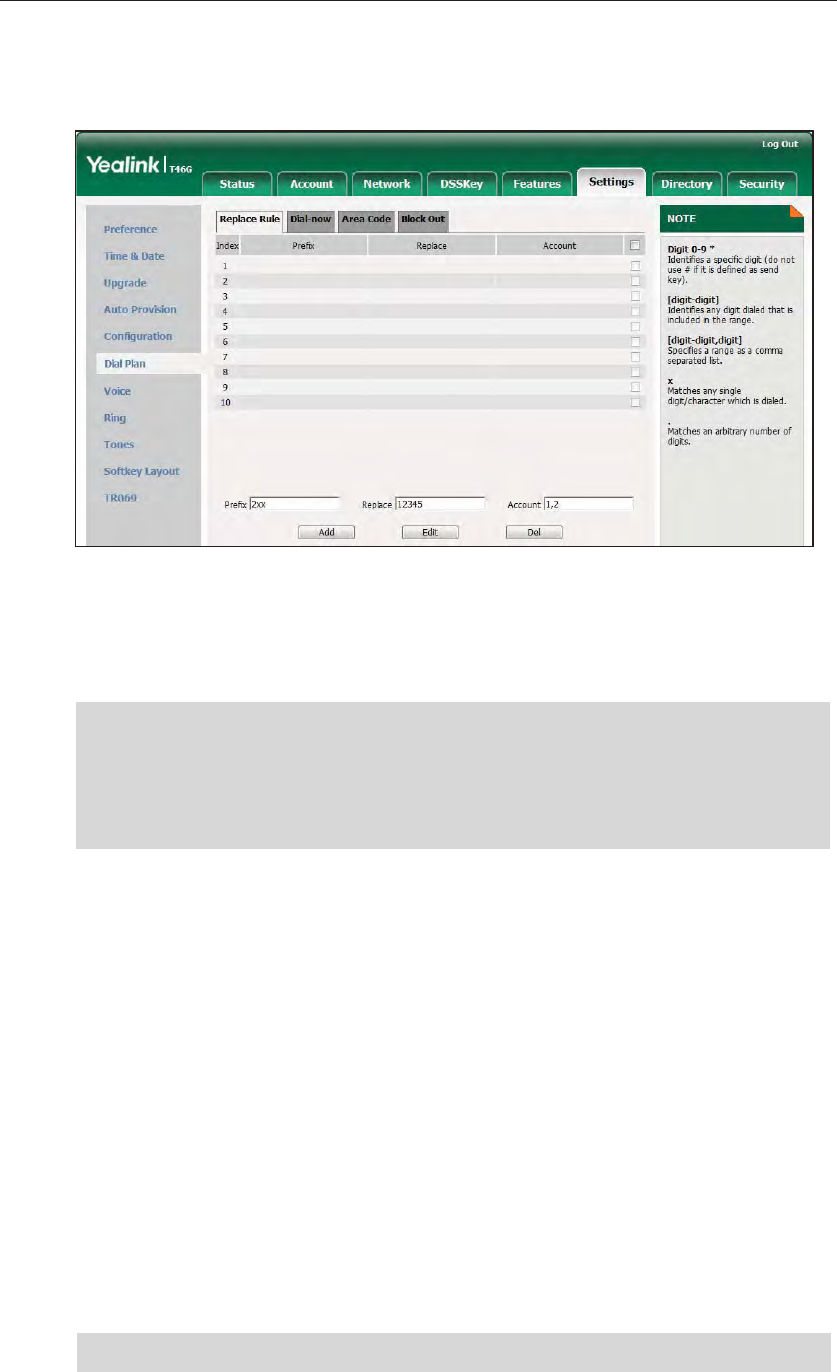
Customizing Your Phone
81
4. Enter the desired line ID in the Account field or leave it blank.
5. Click Add to add the replace rule.
When you enter the number “234” using the keypad and then press the Send soft
key, the phone will dial out “12345” instead.
Note
To edit a replace rule via web user interface:
1. Click on Settings->Dial Plan->Replace Rule.
2. Select the desired replace rule by checking the checkbox.
3. Edit the values in the Prefix and Replace fields.
4. Enter the desired line ID in the Account field or leave it blank.
5. Click Edit to accept the change.
To delete one or more replace rules via web user interface:
1. Click on Settings->Dial Plan->Replace Rule.
2. Select the one or more replace rules by checking the checkbox(es).
3. Click Del to delete the replace rule(s).
Note
Valid values of Account field can be one or more digits among 1, 2, 3, 4, 5 and 6. Every
two digits must be separated by a “,”. For example, when you enter the value “1, 2” in
the Account field, this replace rule will apply to account1 and account2.
If you leave the Account field blank or enter 0, then the replace rule will apply to all
accounts.
Replace rule is configurable via web user interface only.
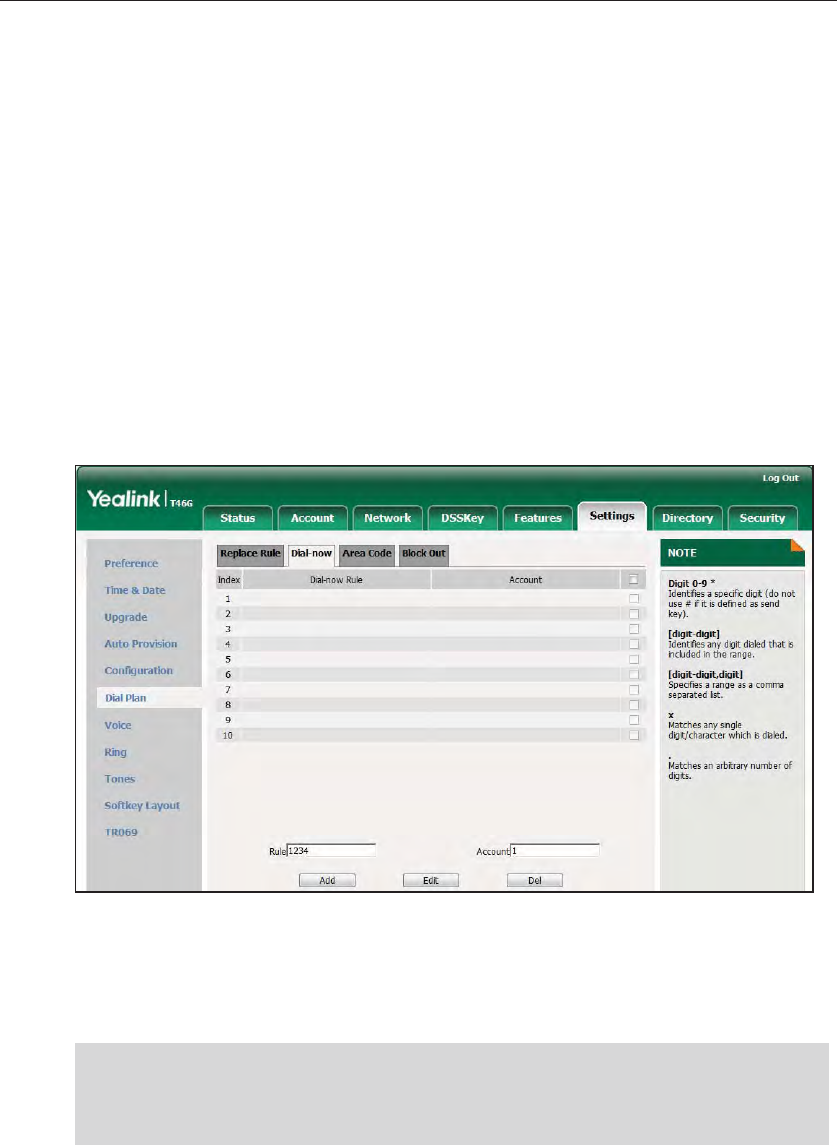
User Guide for the SIP-T48G IP Phone
82
&KCNPQY
You can configure one or more dial-now rules (at most 100) on your phone. When the
dialed number matches the dial-now string, the number will be dialed out
automatically. For example, a dial-now rule is configured as "2xx", then any entered
three-digit string beginning with 2 will be dialed out automatically on the phone.
To add a dial-now rule via web user interface:
1. Click on Settings->Dial Plan->Dial-now.
2. Enter the desired value (e.g., 1234) in the Rule field.
3. Enter the desired line ID in the Account field or leave it blank.
For more information on the valid value of the Account field, refer to Replace Rule
on page 80.
4. Click Add to add the dial-now rule.
When you enter the number “1234” using the keypad, the phone will dial out “1234”
automatically without pressing any key.
Note
Delay Time for Dial-Now Rule
You can configure the delay time for dial-now rules. That is, you can configure your
phone to dial out the phone number automatically, which matches a dial-now rule,
after the specified delay time.
To configure the delay time for dial-now rule via web user interface:
1. Click on Features->General Information.
You can also edit or delete the dial-now rule, refer to Replace Ruleon page 73for more
information.
Dial-now rule is configurable via web user interface only.
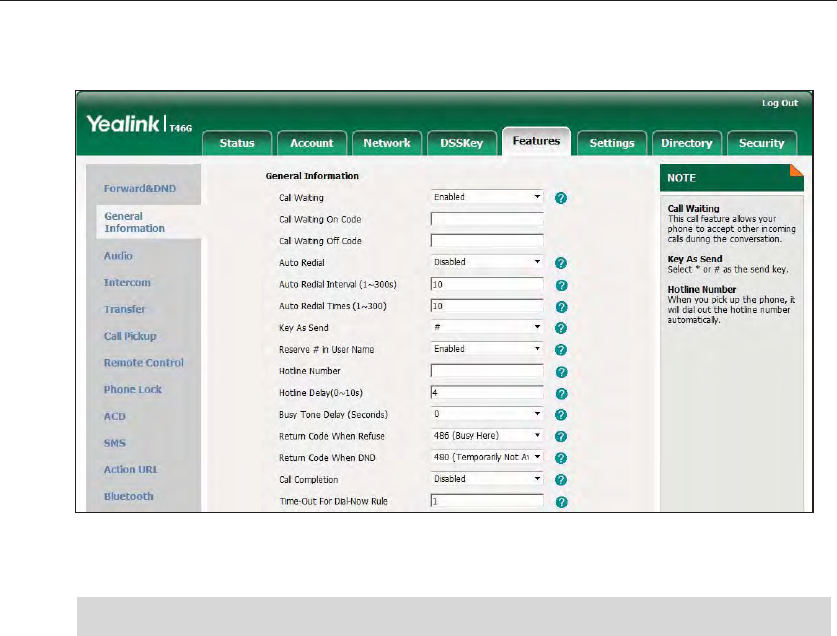
Customizing Your Phone
83
2. Enter the time within 1-14 (in seconds) in the Time-Out For Dial-Now Rule field.
3. Click Confirm to accept the change.
Note
#TGC%QFG
Area codes are also known as Numbering Plan Areas (NPAs). They usually indicate
geographical areas in a country. This feature is necessary only when dialing the number
outside the code area. For example, area code is configured as "Code: 011, Min
Length: 4, Max Length: 11". When you dial out the number "56789" (the length of the
number is between 4 and 11), the phone will add the area code and dial out the
number "01156789".
To configure the area code and lengths via web user interface:
1. Click on Settings->Dial Plan->Area Code.
2. Enter the desired values in the Code, Min Length (1-15) and Max Length (1-15)
fields.
3. Enter the desired line ID in the Account field or leave it blank.
Delay time for dial-now rule is configurable via web user interface only.
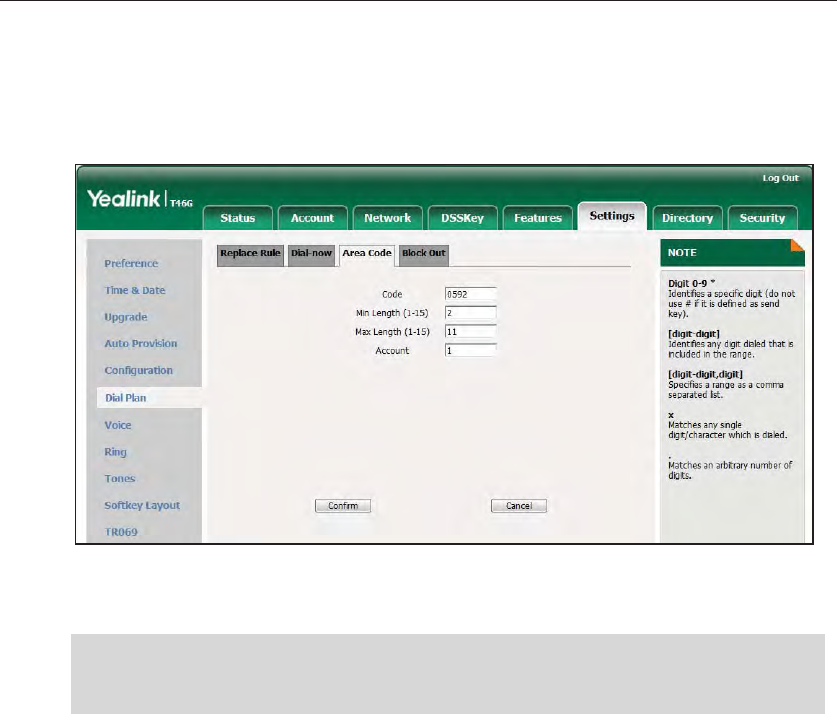
User Guide for the SIP-T48G IP Phone
84
For more information on the valid value of the Account field, refer to Replace Rule
on page 80.
4. Click Confirm to accept the change.
Note
$NQEM1WV
You can block some specific numbers (at most 10) from being dialed on your phone.
When you dial a block out number on your phone, the dialing will fail and the LCD
screen will prompt "Forbidden Number".
To add a block out number via web user interface:
1. Click on Settings->Dial Plan->Block Out.
2. Enter the desired value in the BlockOut Number field.
3. Enter the desired line ID in the Account field or leave it blank.
The default values of minimum and maximum length are 1 and 15 respectively.
Area code is configurable via web user interface only.
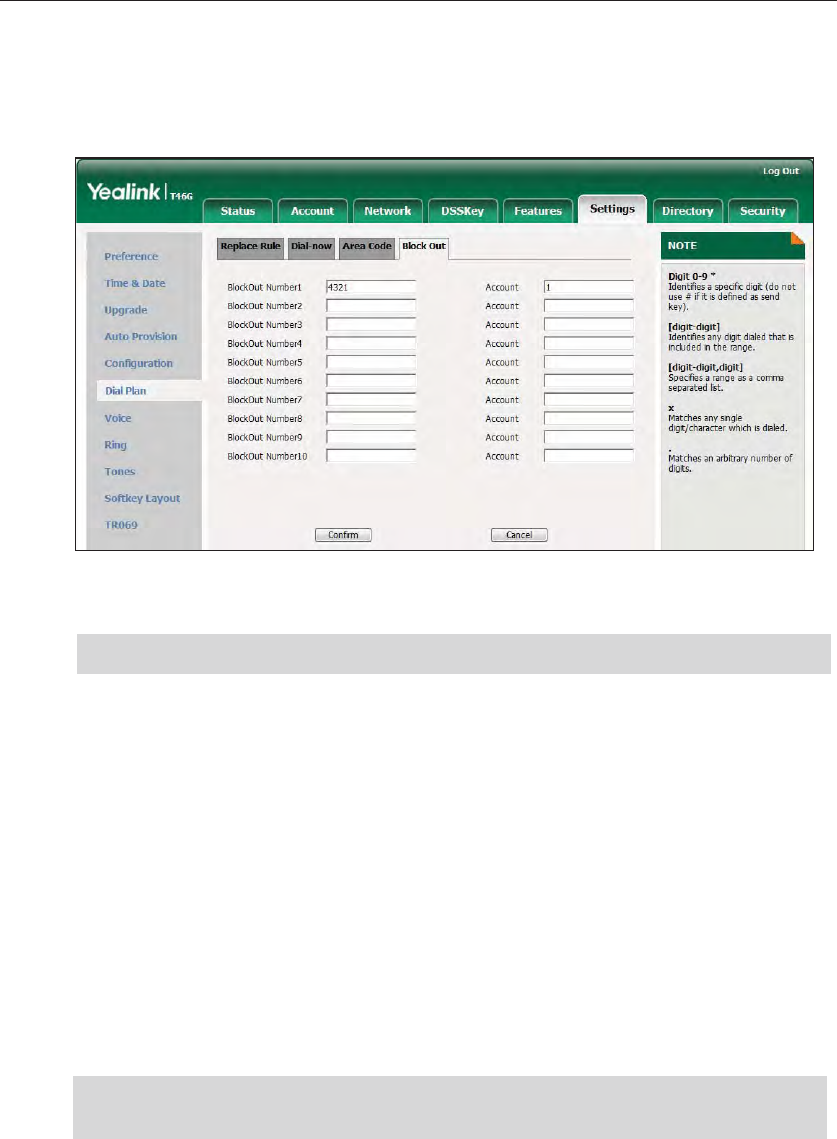
Customizing Your Phone
85
For more information on the valid value of the Account field, refer to Replace Rule
on page 80.
4. Click Confirm to add the block out number.
Note
'OGTIGPE[0WODGT
Public telephone networks in countries around the world have a single emergency
telephone number (emergency services number), that allows a caller to contact local
emergency services for assistance when necessary. The emergency telephone number
may differ from country to country. It is typically a three-digit number so that it can be
easily remembered and dialed quickly. Some countries have a different emergency
number for each of the different emergency services.
You can specify the emergency telephone numbers on the IP phone for contacting the
emergency services in an emergency situation.
Note
To specify emergency numbers via web user interface:
1. Click on Features->Phone Lock.
2. Enter the emergency number in the Emergency field.
Contact your local phone service provider for available emergency numbers in your
area.
Block out number is configurable via web user interface only.
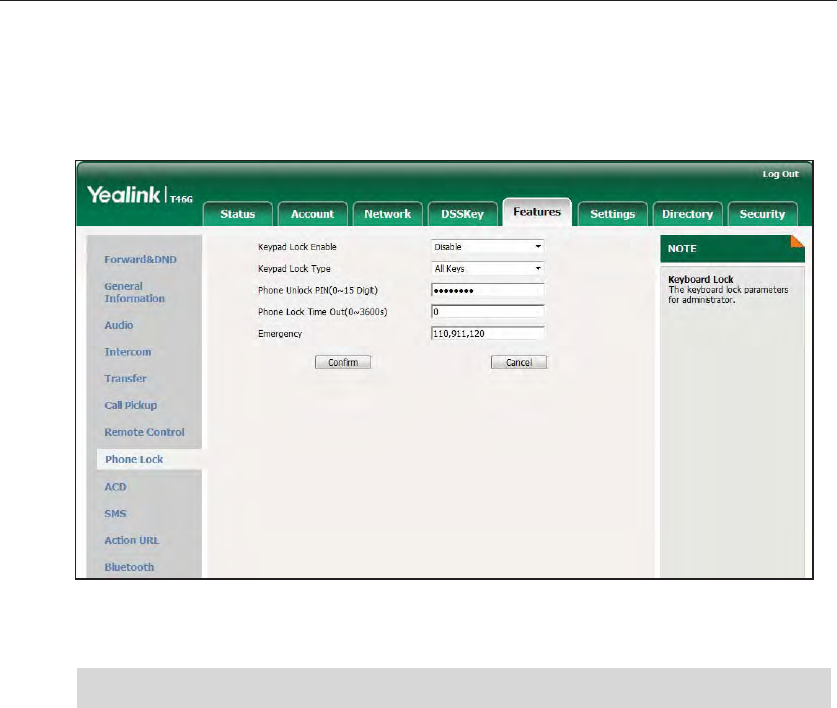
User Guide for the SIP-T48G IP Phone
86
For multiple emergency numbers, enter “,” between every two numbers. The
default emergency numbers are 110, 911 and 120.
3. Click Confirm to accept the change.
Note
.KXG&KCNRCF
You can enable live dialpad on the SIP-T48G IP phone, which enables the IP phone to
automatically dial out the phone number without pressing any other key. You can also
configure a delay, where the phone will dial out the phone number automatically after
the specified period of time.
To enable the live dialpad via web user interface:
1. Click on Settings->Preference.
2. Select Enabled from the pull-down list of Live Dialpad.
Emergency number is configurable via web user interface only.
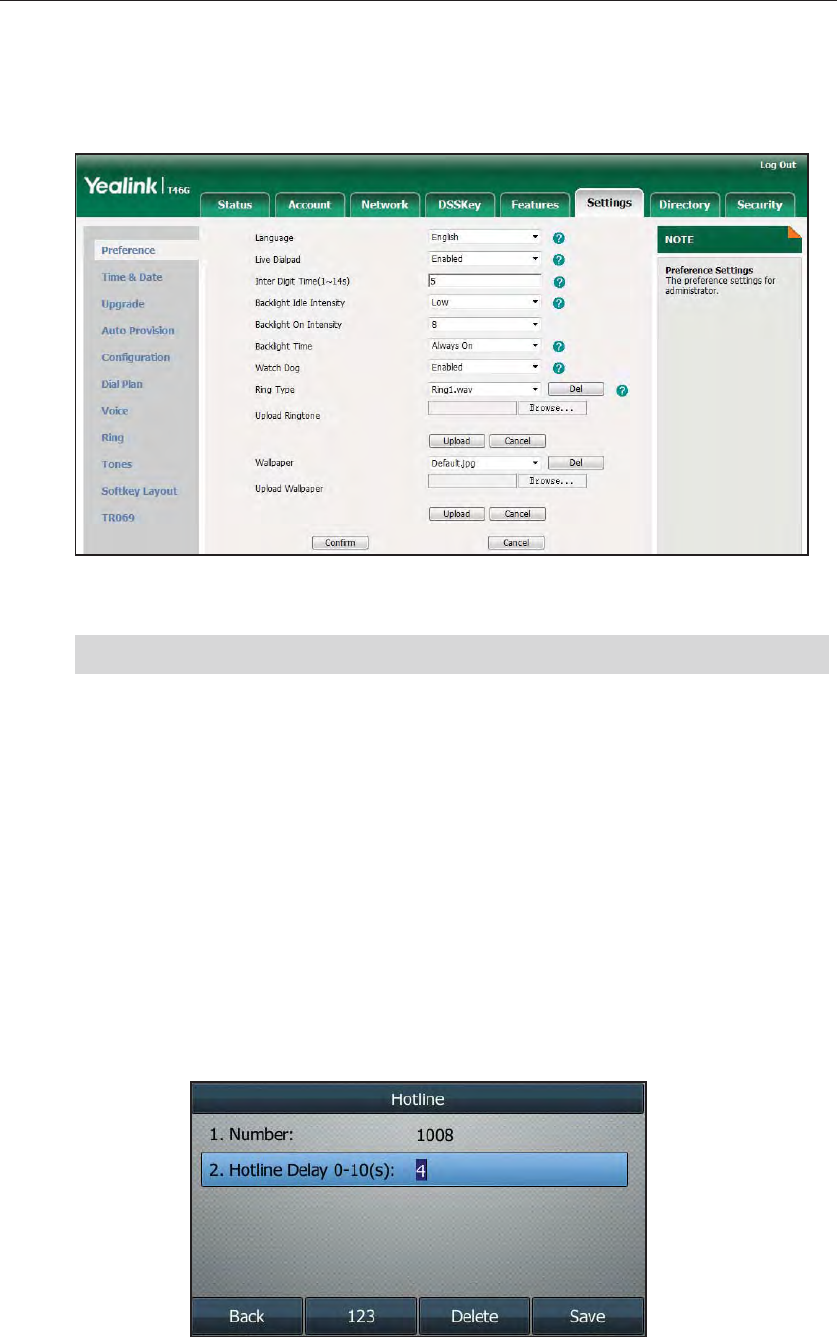
Customizing Your Phone
87
3. Enter the desired delay time in the Inter Digit Time (1~14s) field.
The default delay time is 4s.
4. Click Confirm to accept the change.
Note
*QVNKPG
You can dial a hotline number immediately upon lifting the handset, pressing the
speakerphone key or the line key. You can also configure a delay, where the phone will
dial out the hotline number automatically after the specified period of time.
To configure the hotline number via phone user interface:
1. Press Menu->Call Features->Others->Hotline.
2. Enter the desired number in the Number field.
3. Enter the delay time in the Hotline Delay 0-10(s) field.
4. Press the Save soft key to accept the change or the Back soft key to cancel.
Live dialpad is configurable via web user interface only.

User Guide for the SIP-T48G IP Phone
88
Hotline is configurable via web user interface at the path Features->General
Information.

Customizing Your Phone
89

User Guide for the SIP-T48G IP Phone
90
$CUKE%CNN(GCVWTGU
The SIP-T48G IP phone is designed to be easily used like a regular phone on a public
switched telephone network (PSTN). You can place calls, answer calls, transfer a call to
someone else, or conduct a conference call.
This chapter provides basic operating instructions for the SIP-T48G IP phone. Topics
include:
zPlacing Calls
zAnswering Calls
zEnding Calls
zRedialing Numbers
zRecent Call In Dialing
zAuto Answer
zAuto Redial
zCall Completion
zCall Return
zCall Mute
zCall Hold/Resume
zDo Not Disturb (DND)
zCall Forward
zCall Transfer
zCall Waiting
zConference
zCall Park
zCall Pickup
zAnonymous Call
zAnonymous Call Rejection
If you require additional information or assistance with your new phone, contact your
system administrator.
2NCEKPI%CNNU
You can place a call in three ways using your SIP-T48G IP phone:
zUsing the handset
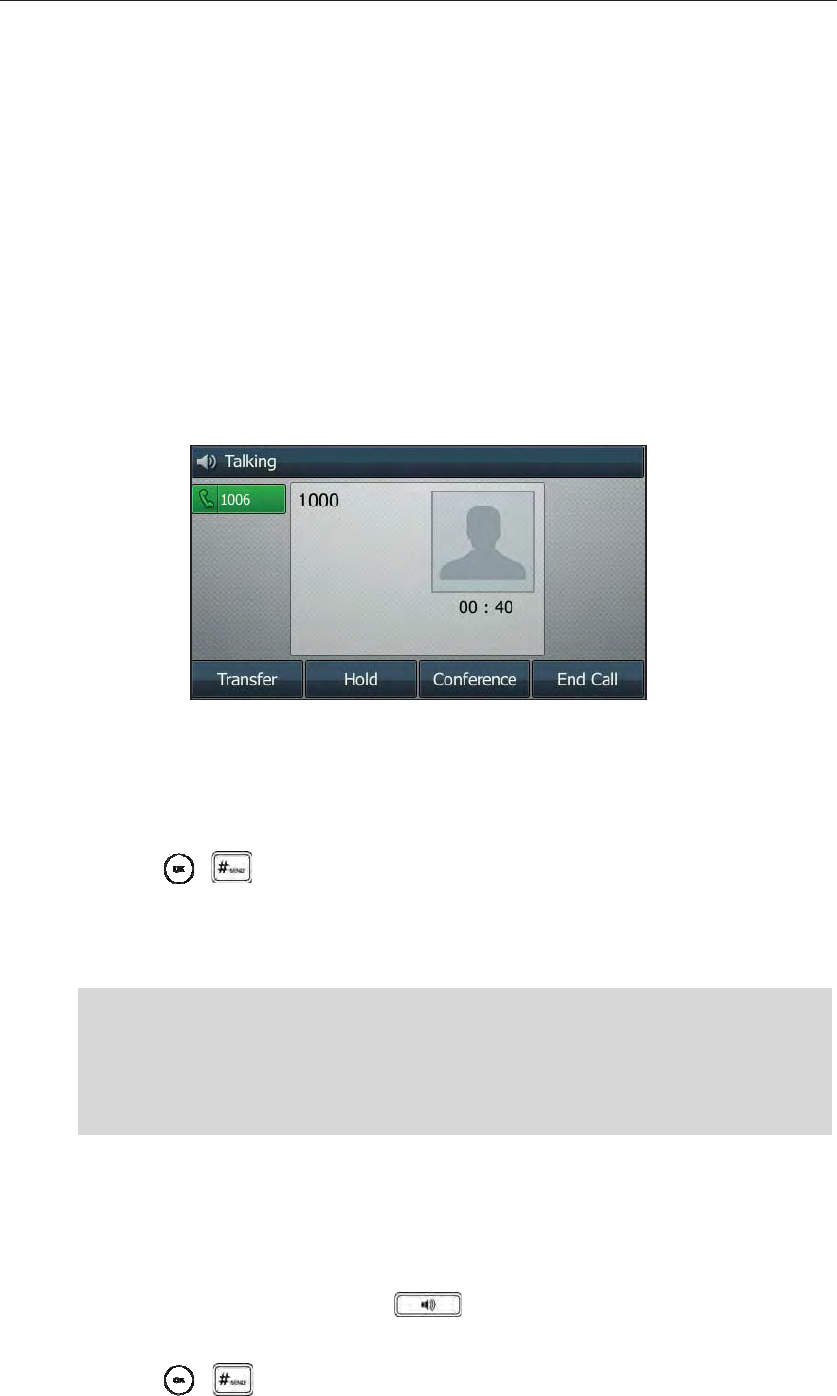
Basic Call Features
91
zUsing the speakerphone
zUsing the headset
You can also dial the number first, and then choose the way you want to speak to the
other party.
You can also search and dial a contact from call history, local directory or remote
phone book. For more information, refer to Contact Management on page 39 and Call
History Management on page 57.
During a call, you can alternate between Speakerphone, Headset, and Handset
modes by pressing the Speakerphone key, the HEADSET key, or picking up the handset.
The call duration of active calls is visible on the LCD screen. In the figure below, the call
to the number”1000” has lasted 40 seconds.
To place a call using the handset:
1. Pick up the handset.
2. Enter the desired number using the keypad.
3. Press , , or the Send soft key.
The # key is configured as a send key by default. You can also set the * key as the send
key, or set neither. For more information, refer to theKey as Send on page 32.
Note
To place a call using the hands-free speakerphone mode:
Do one of the following:
-With the handset on-hook, press or the line key to obtain a dial tone.
Enter the desired number using the keypad.
Press , or the Send soft key.
You can also dial using the SIP URI or IP address. To obtain the IP address of a phone,
press the OK key. The maximum SIP URI or IP address length is 32 characters. For example,
SIP URI: 3606@sip.com, IP: 192.168.1.15.
Your phone may not support direct IP dialing. Contact your system administrator for
more information.
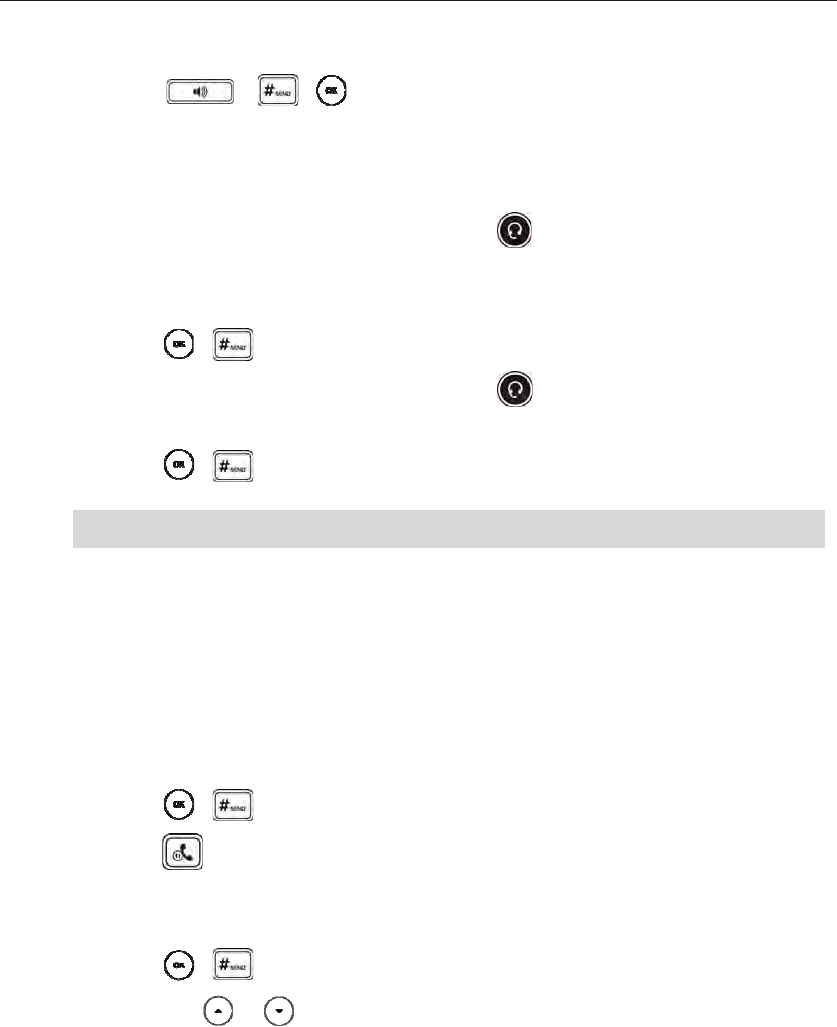
User Guide for the SIP-T48G IP Phone
92
-With the handset on-hook, enter the desired number using the keypad.
Press , , or the Send soft key.
To place a call using the headset:
Do one of the following:
-With the optional headset connected, press to activate the headset mode.
Press the line key to obtain a dial tone.
Enter the desired number using the keypad.
Press , , or the Send soft key.
-With the optional headset connected, press to activate the headset mode.
Enter the desired number using the keypad.
Press , , or the Send soft key.
Note
To place multiple calls:
You can have more than one call on your SIP-T48G IP phone. To place a new call during
an active call, do one of the following:
-Press the line key. The active call is placed on hold.
Enter the desired number using the keypad.
Press , , or the Send soft key.
-Press or the Hold soft key to place the original call on hold.
Press the New Call soft key.
Enter the desired number using the keypad.
Press , , or the Send soft key.
You can press or to switch between calls, and then press the Resume soft key
to retrieve the desired call.
#PUYGTKPI%CNNU
When you are not in another call, you can answer a call in three ways:
zUsing the handset
zUsing the speakerphone
To permanently use the headset mode, refer to Headset Prior on page 54.

Basic Call Features
93
zUsing the headset
Note
Answering When Not in Another Call
Call duration and destination will always appear on the LCD screen for the active call.
To answer a call using the handset:
1. Pick up the handset.
To answer a call using the hands-free speakerphone mode:
Do one of the following:
-Press .
-With the handset on-hook and the headset mode deactivated, press the Answer soft
key.
-With the handset on-hook and the headset mode deactivated, press the line key (the
line key LED flashes green).
To answer a call using the headset:
Do one of the following:
-Press .
-With the headset mode activated, press the Answer soft key.
-With the headset mode activated, press the line key (the line key LED flashes green).
Answering When in Another Call
If you have an active call, and an incoming call arrives on the phone, do one of the
following:
-Press the Answer soft key.
The incoming call is answered and the original call is placed on hold.
-Press to access the new call.
Press or the Answer soft key.
The incoming call is answered and the original call is placed on hold.
You can ignore incoming calls by pressing the X key, the Reject soft key or the Silence
soft key. You can also activate Do Not Disturb mode to ignore the incoming calls without
ring on your phone. For more information, refer to Do Not Disturb (DND) on page 93.
You can forward incoming calls to someone else by pressing the Forward soft key. For
more information, refer to Call Forward on page 97.

User Guide for the SIP-T48G IP Phone
94
'PFKPI%CNNU
To end a call:
Do one of the following:
-If you are using the handset, press the End Call soft key or hang up the handset.
-If you are using the headset, press the End Call soft key.
-If you are using the speakerphone, press or the End Call soft key.
Note
4GFKCNKPI0WODGTU
To redial the last dialed number from your phone:
1. Press twice.
A call to your last dialed number is attempted.
To redial a previously dialed number from your phone:
1. Press when the phone is idle.
2. Press or to select the desired entry from the placed calls list, and then
press or the Send soft key.
4GEGPV%CNN+P&KCNKPI
To view the placed calls list when the phone is in the pre-dialing interface, you should
enable recent call in dialing in advance.
To enable recent call in dialing via web user interface:
1. Click on Directory->Setting.
To end a call placed on hold, you can press the End Call soft key to end the call directly,
or press the Resume soft key to resume the call before ending it.
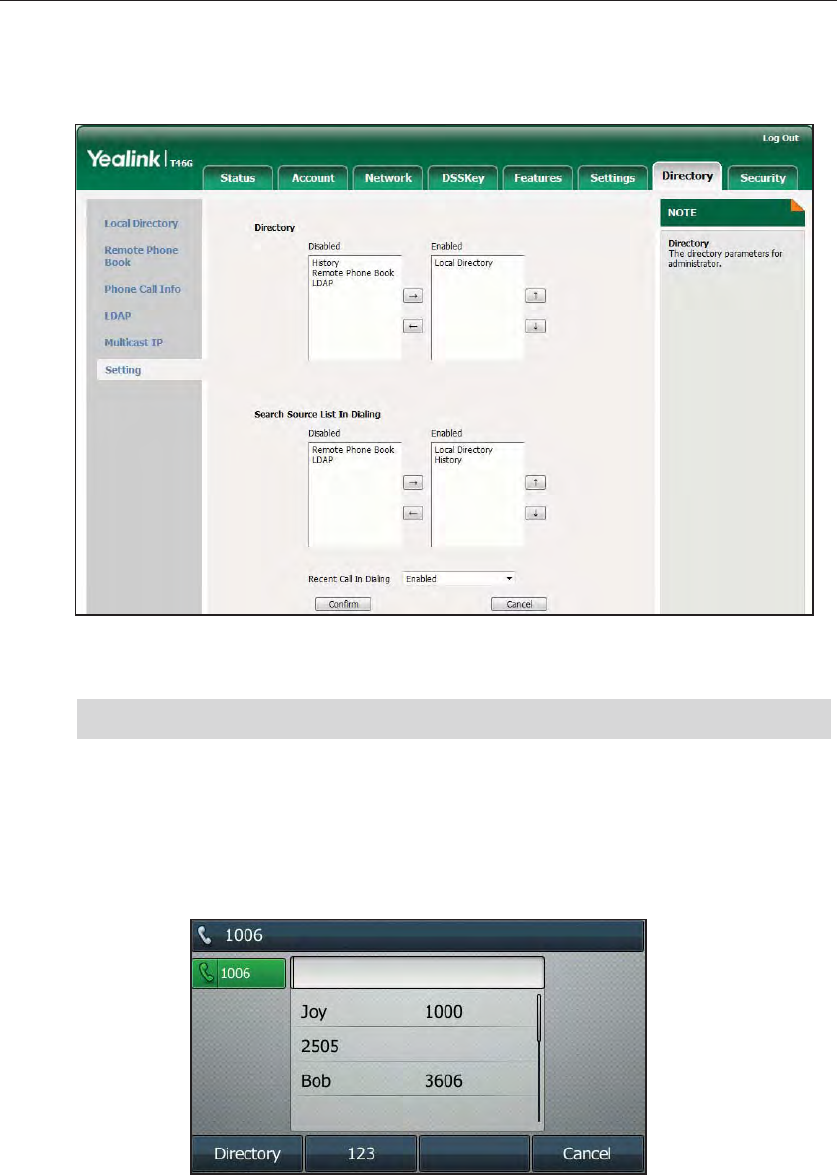
Basic Call Features
95
2. Select Enabled from the pull-down list of Recent Call In Dialing.
3. Click Confirm to accept the change.
Note
To view placed calls list when the phone is in the pre-dialing interface:
1. Pick up the handset, press the speakerphone key or press the line key.
The LCD screen displays the placed calls list.
#WVQ#PUYGT
You can use auto answer to automatically answer an incoming call on a line. Auto
answer is configurable on a per-line basis.
To configure auto answer via phone user interface:
Recent call in dialing is configurable via web user interface only.
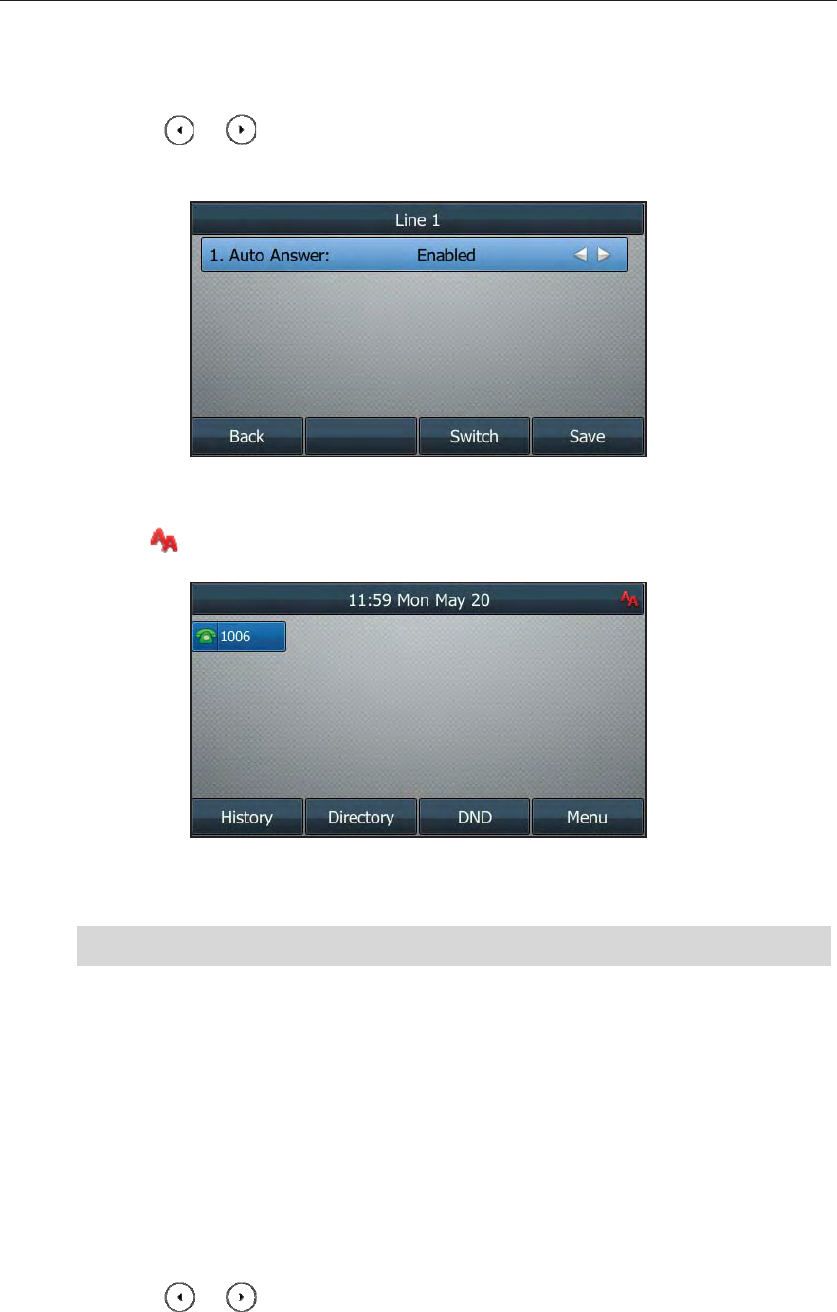
User Guide for the SIP-T48G IP Phone
96
1. Press Menu->Call Features->Auto Answer.
2. Select the desired line and then press the Enter soft key.
3. Press or , or the Switch soft key to select Enabled from the Auto Answer
field.
4. Press the Save soft key to accept the change or the Back soft key to cancel.
The icon appears on the LCD screen.
Auto answer is configurable via web user interface at the path Account->Basic.
Note
#WVQ4GFKCN
You can enable auto redial to redial the phone number automatically when the called
party is busy. You can also configure the times settings for auto redial and the time to
wait between redial attempts.
To configure auto redial via phone user interface:
1. Press Menu->Call Features->Others->Auto Redial.
2. Press or , or the Switch soft key to select Enabled from the Auto Redial field.
3. Enter the desired time (in seconds) in the Redial Interval field.
The default time interval (in seconds) is 10.
4. Enter the desired times in the Redial Times field.
Auto answer is only applicable when there is no other call in progress on the phone.
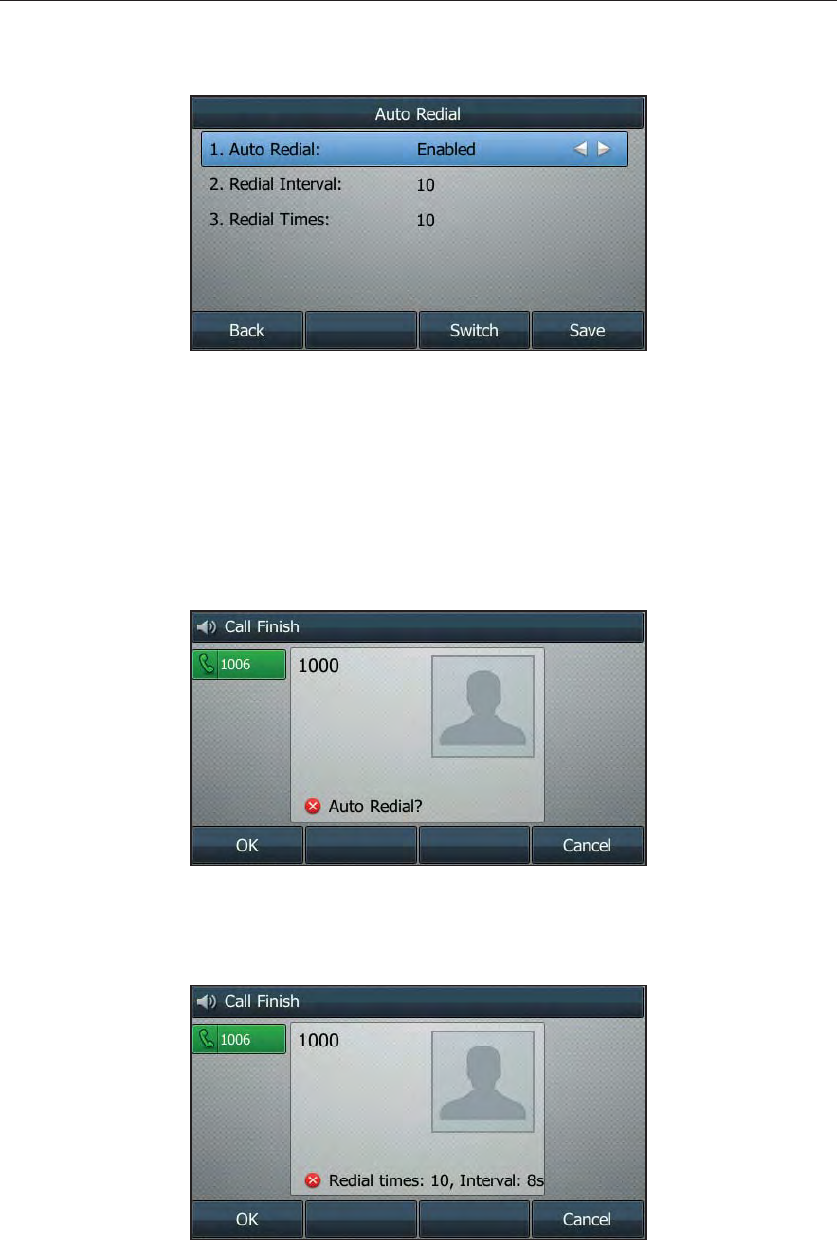
Basic Call Features
97
The default value is 10.
5. Press the Save soft key to accept the change or the Back soft key to cancel.
Auto redial is configurable via web user interface at the path Features->General
Information.
To use auto redial:
When the called party is busy, the LCD screen prompts the following:
1. Press the OK soft key to activate auto redial. The following prompt will appear on
the LCD screen of the phone:
2. Wait for a period of time or press the OK soft key to redial the phone number.
The phone will retry as many times as configured until the called party is idle.
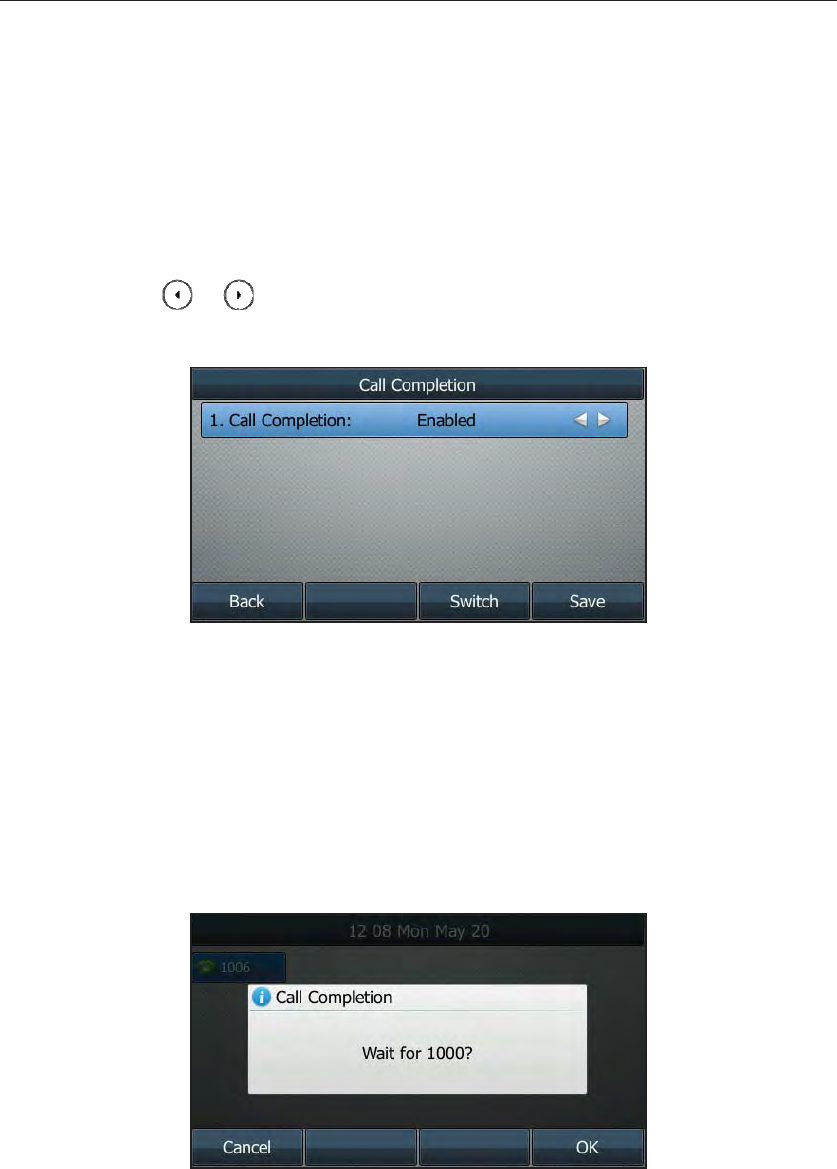
User Guide for the SIP-T48G IP Phone
98
%CNN%QORNGVKQP
You can use call completion to notify the caller who failed to reach a desired callee
when the callee becomes available to receive a call.
To configure call completion via phone user interface:
1. Press Menu->Call Features->Others->Call Completion.
2. Press or , or the Switch soft key to select Enabled from the Call Completion
field.
3. Press the Save soft key to accept the change or the Back soft key to cancel.
Call completion is configurable via web user interface at the path Features->General
Information.
To use call completion:
When the called party is busy, the following prompt will appear on the LCD screen of
the phone:
1. Press the OK soft key, the phone returns to the idle screen and call completion is
activated.
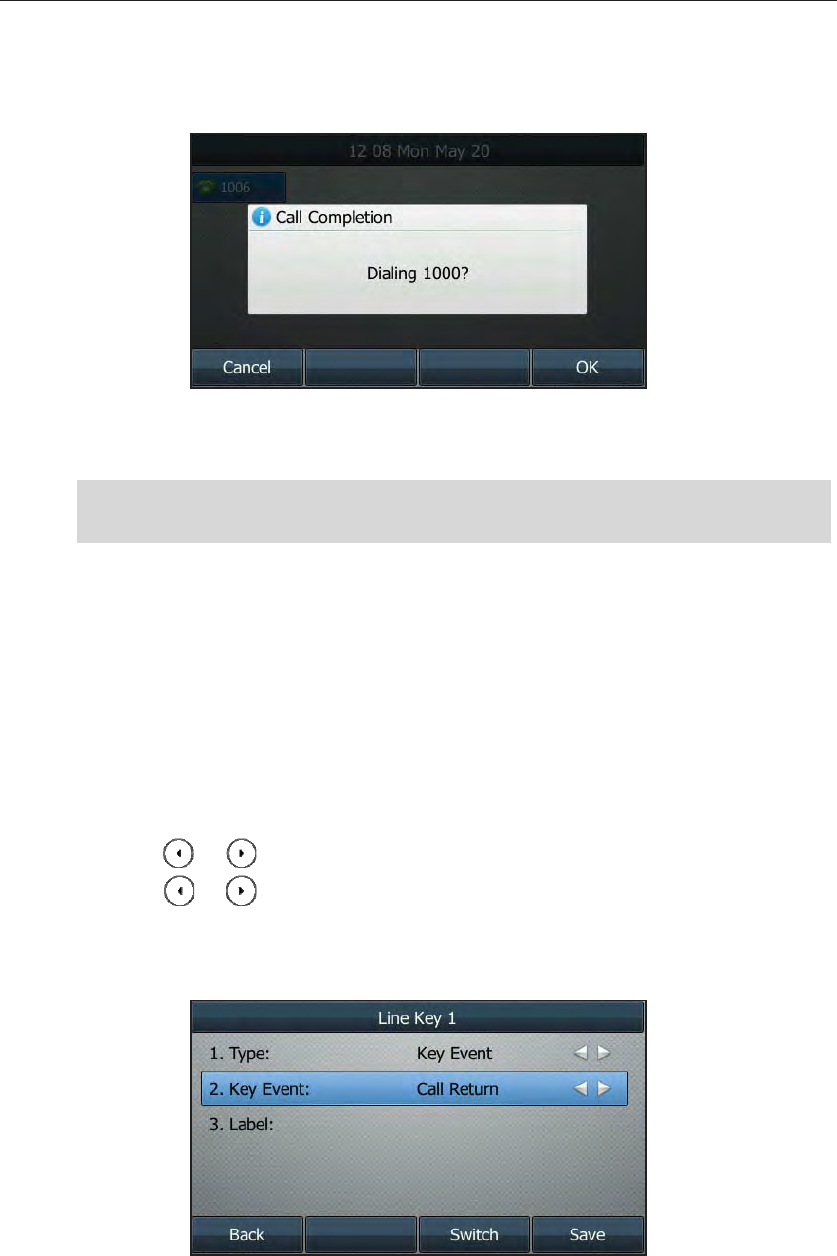
Basic Call Features
99
2. When the called party becomes idle, the LCD screen prompts the following:
3. Press the OK soft key to redial the number.
Note
%CNN4GVWTP
You can press a call return key to place a call back to the last incoming call.
To configure a call return key via phone user interface:
1. Press Menu->Call Features->DSS Keys.
2. Select a desired DSS key.
3. Press or , or the Switch soft key to select Key Event from the Type field.
4. Press or , or the Switch soft key to select Call Return from the Key Event
field.
5. (Optional.) Enter a string that will appear on the LCD screen in the Label field.
6. Press the Save soft key to accept the change or the Back soft key to cancel.
Call return key is configurable via web user interface at the path DSSKey->Line key.
Call completion is not available on all servers. For more information, contact your system
administrator.
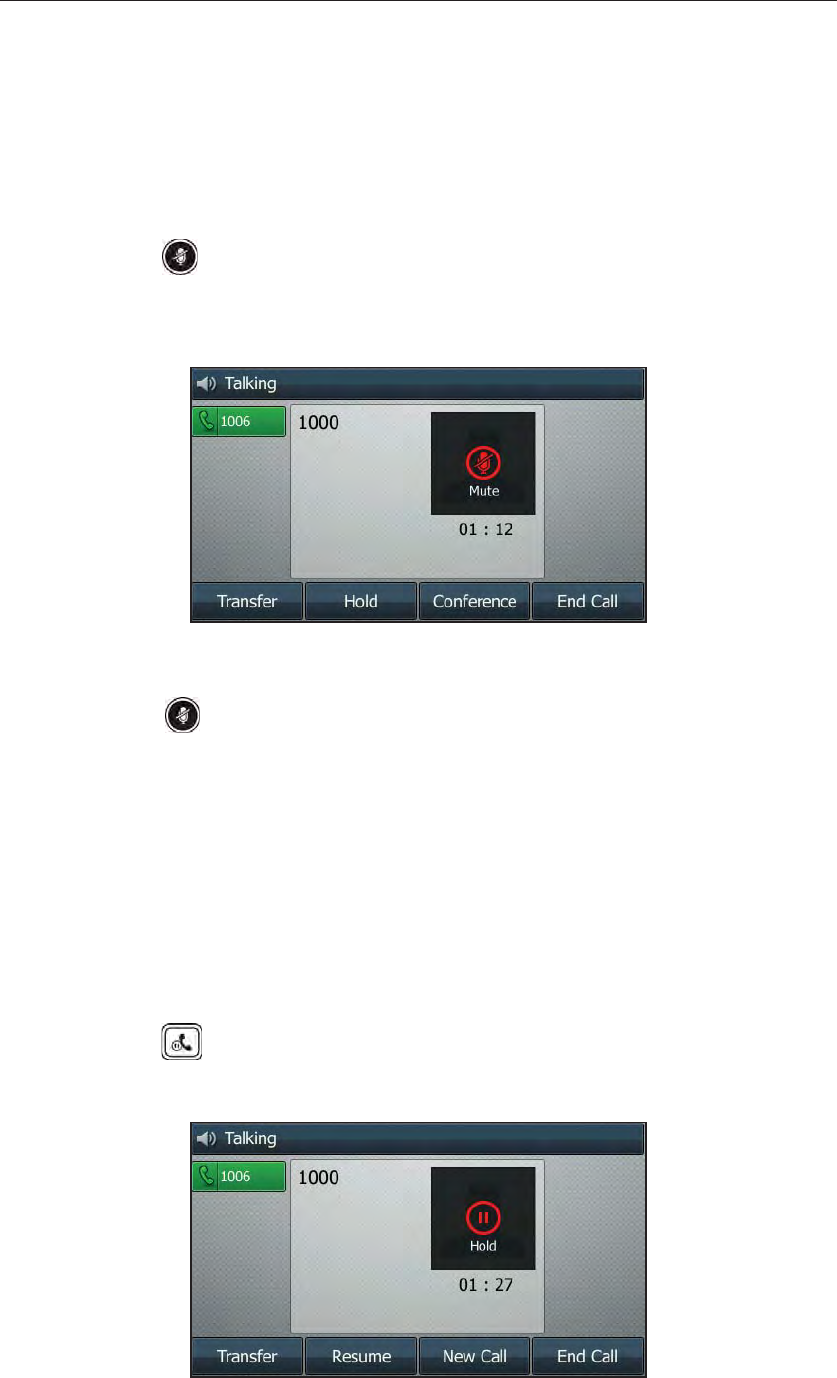
User Guide for the SIP-T48G IP Phone
100
%CNN/WVG
You can mute the microphone of the active audio device during an active call, and
then the other party cannot hear you.
To mute a call:
1. Press during an active call.
The LCD screen indicates that the call is on mute. The mute key LED illuminates solid
red when the call is on mute.
To un-mute a call:
1. Press again to un-mute the call.
%CNN*QNF4GUWOG
You can place an active call on hold. Only one active call can be in progress at any
time. Other calls can be made and received while placing the original call on hold.
When you place a call on hold, your IP PBX may play music on hold to the other party
while waiting.
To place a call on hold:
1. Press or the Hold soft key during a call.
The LCD screen indicates that the call is on hold.

Basic Call Features
101
The line key LED flashes green. The phone will beep softly every 30 seconds to remind
you that you still have a call on hold.
To resume a held call:
1. Press or the Resume soft key.
Multiple Calls on Hold:
If multiple calls are placed on hold, do one of the following:
-Press or to switch between the calls, and then press the Resume soft key to
retrieve the desired call.
-Press the corresponding line key to retrieve the call.
If more than two calls are on hold, a numbered prompt appears on the LCD screen, for
example "2/4", indicating that this is the second call out of four calls.
&Q0QV&KUVWTD&0&
You can use DND to reject incoming calls automatically on the phone. Callers will
receive a busy message.
You can enable/disable DND for the phone system, or you can customize DND for
each or all accounts. Two DND modes:
zPhone (default): DND is effective for the phone system.
zCustom: DND can be configured for each or all accounts.
You can receive incoming calls from authorized numbers when DND is enabled.
To configure the DND mode via web user interface:
1. Click on Features->Forward & DND.
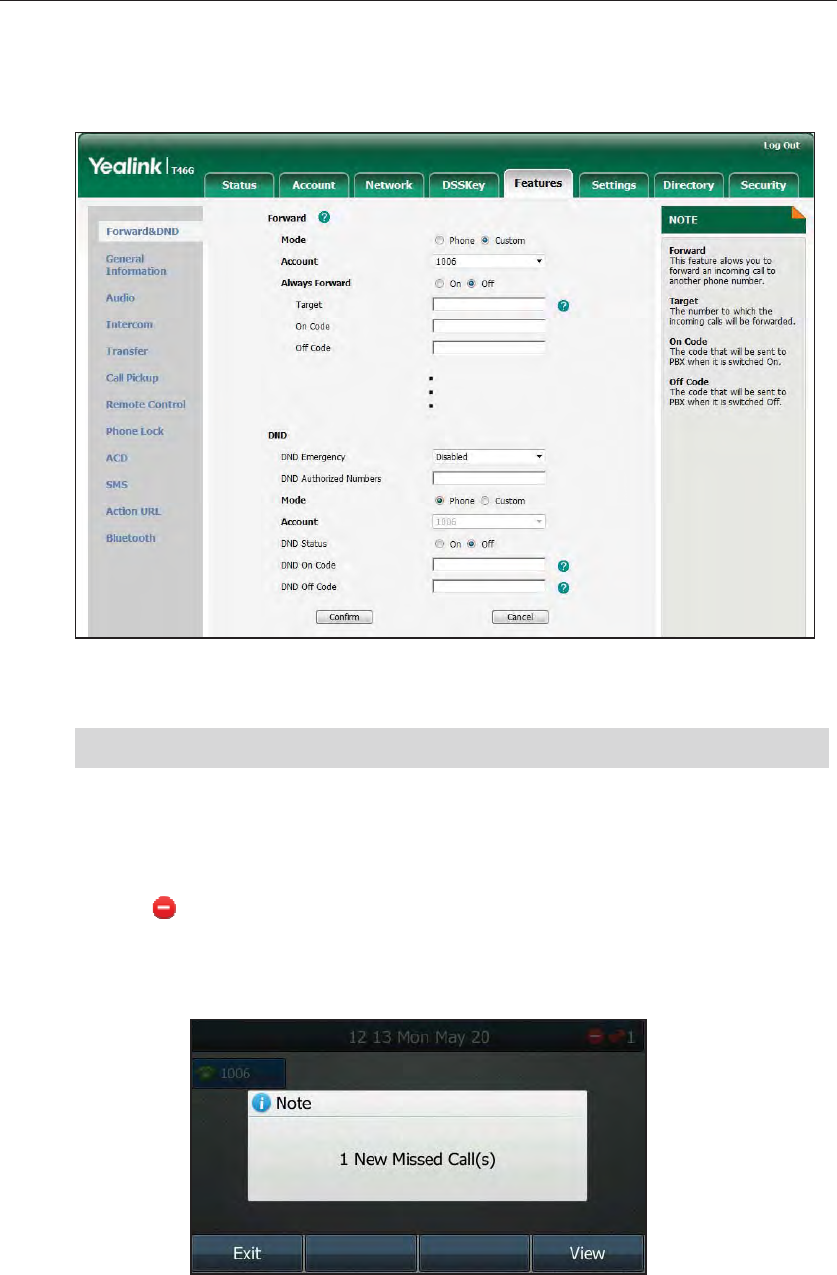
User Guide for the SIP-T48G IP Phone
102
2. In the DND block, mark the desired radio box in the Mode field.
3. Click Confirm to accept the change.
Note
To activate DND in phone mode:
1. Press the DND soft key when the phone is idle.
The icon on the idle screen indicates that DND is enabled.
Incoming calls will be rejected automatically and "n New Missed Call(s)" ("n"
indicates the number of the missed calls) will appear on the LCD screen.
To activate DND in custom mode for a specific account:
1. Press the DND soft key when the phone is idle.
DND mode is configurable via web user interface only.
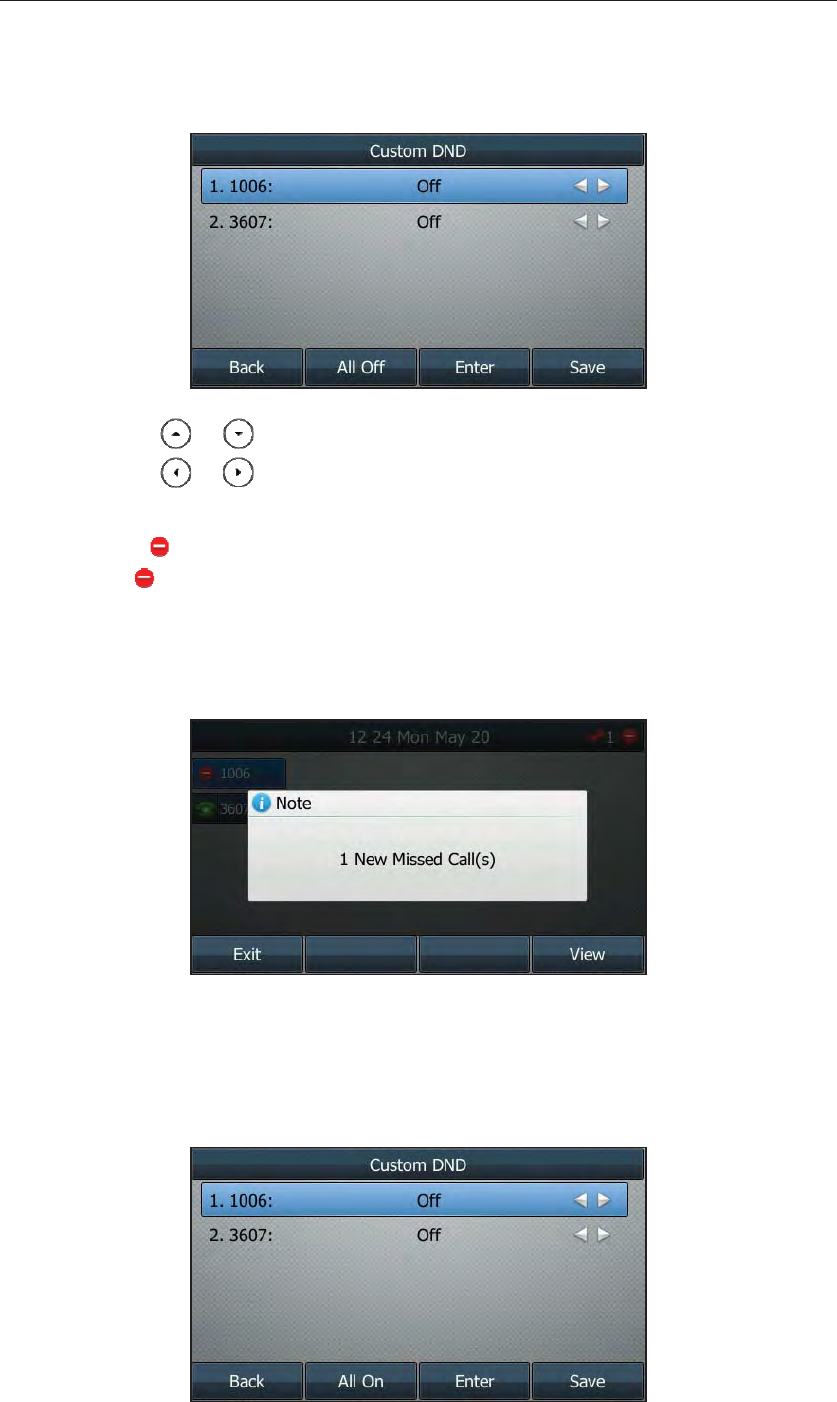
Basic Call Features
103
The LCD screen displays a list of accounts on the phone.
2. Press or to select the desired account.
3. Press or soft key to select On to activate DND.
4. Press the Save soft key to accept the change.
The icon appears on the idle screen, and the associated line icon changes
to .
Incoming calls on the specific line will be rejected automatically, and the LCD
screen will prompt "n New Missed Call(s)" ("n" indicates the number of the missed
calls).
To activate DND in custom mode for all accounts:
1. Press the DND soft key when the phone is idle.
The LCD screen displays a list of accounts registered on the phone.
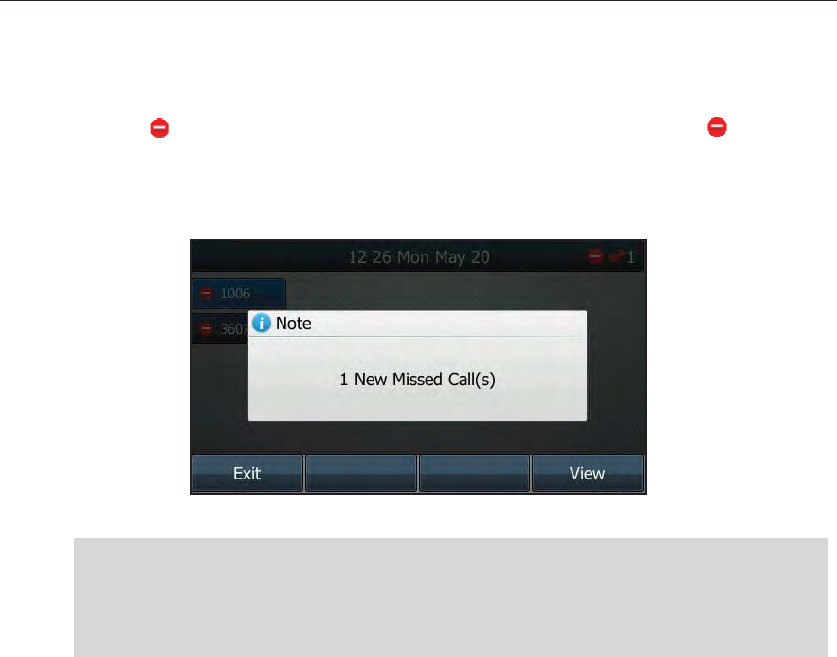
User Guide for the SIP-T48G IP Phone
104
2. Press the All On soft key to activate DND for all accounts.
3. Press the Save soft key to accept the change.
The icon appears on the idle screen, and all line icons change to .
Incoming calls will be rejected automatically, and the LCD screen will prompt "n
New Missed Call(s)" ("n" indicates the number of the missed calls).
Note
To configure the DND authorized numbers via web user interface:
1. Click on Features->Forward & DND.
2. Select Enabled from the pull-down list of DND Emergency.
3. Enter the numbers in the DND Authorized Numbers field.
For multiple numbers, enter “,” between every two numbers.
The prompt message displays only if Missed Call Log for the line is enabled. Missed call
log is configurable via web user interface at the path Account->Basic.
Do not disturb is local to the phone, and may be overridden by the server settings. For
more information, contact your system administrator.
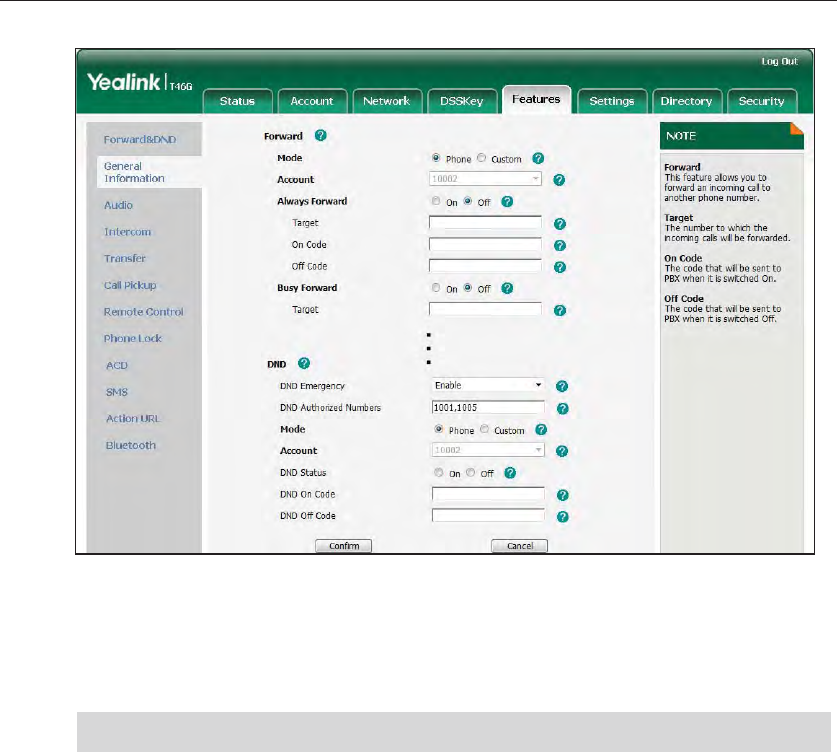
Basic Call Features
105
4. Click Confirm to accept the change.
When DND is enabled on the phone, the phone can still receive incoming calls from the
numbers specified in the DND Authorized Numbers field.
Note
%CNN(QTYCTF
You can configure your phone to forward incoming calls to another party by the static
forwarding. You can also forward calls while your phone is ringing, refer to the dynamic
forwarding.
Static Forwarding
Three types of static forwarding:
zAlways Forward: Incoming calls are immediately forwarded.
zBusy Forward: Incoming calls are immediately forwarded if the phone is busy.
zNo Answer Forward: Incoming calls are forwarded if not answered after a period of
time.
You can enable/disable call forward for the phone system, or you can customize call
forward for each or all accounts. Two call forward modes:
zPhone (default): Call forward is effective for the phone system.
zCustom: Call forward can be configured for each or all accounts.
DND authorized number is configurable via web user interface only.
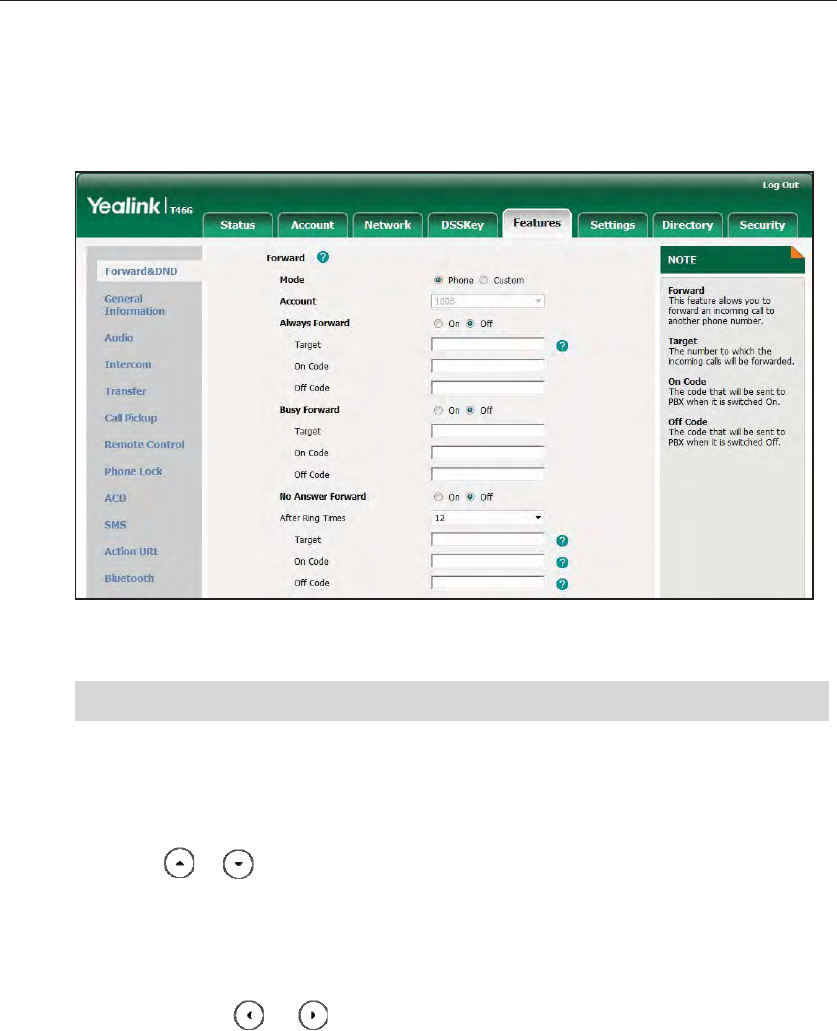
User Guide for the SIP-T48G IP Phone
106
To configure the call forward mode via web user interface:
1. Click on Features->Forward & DND.
2. In the Forward block, mark the desired radio box in the Mode field.
3. Click Confirm to accept the change.
Note
To enable call forward in phone mode:
1. Press Menu->Call Features->Call Forward.
2. Press or to select the desired forwarding type, and then press the Enter soft
key.
3. Depending on your selection:
a.) If you select Always Forward:
1) Press or , or the Switch soft key to select Enabled from the Always
Forward field.
2) Enter the destination number you want to forward all incoming calls to in
the Forward To field.
3) (Optional.) Enter the always forward on code or off code respectively in
the On Code or Off Code field.
Call forward mode is configurable via web user interface only.
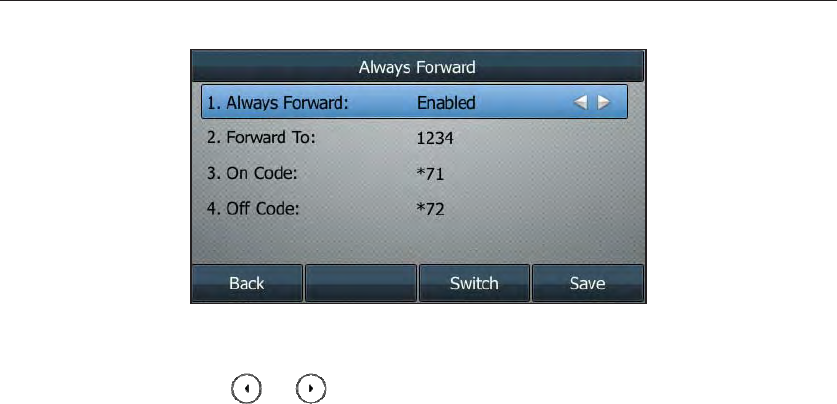
Basic Call Features
107
b.) If you select Busy Forward:
1) Press or , or the Switch soft key to select Enabled from the Busy
Forward field.
2) Enter the destination number you want to forward incoming calls to when
the phone is busy in the Forward To field.
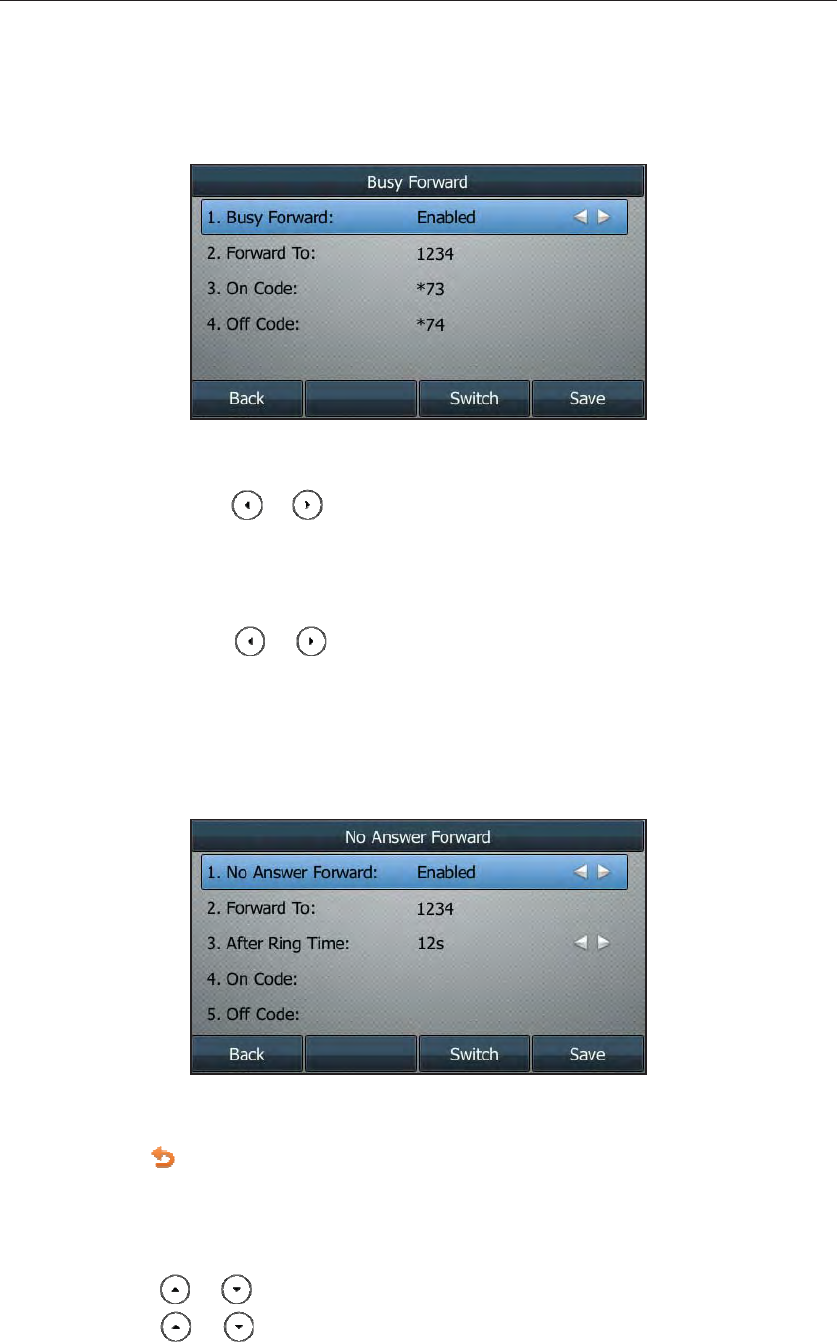
User Guide for the SIP-T48G IP Phone
108
3) (Optional.) Enter the busy forward on code or off code respectively in the
On Code or Off Code field.
c.) If you select No Answer Forward:
1) Press or , or the Switch soft key to select Enabled from the No
Answer Forward field.
2) Enter the destination number you want to forward unanswered incoming
calls to in the Forward To field.
3) Press or , or the Switch soft key to select the ring time to wait
before forwarding from the After Ring Time field.
The default ring time is 12 seconds.
4) (Optional.) Enter the no answer forward on code or off code respectively in
the On Code or Off Code field.
4. Press the Save soft key to accept the change or the Back soft key to cancel.
The icon on the idle screen indicates the call forward is enabled.
To enable call forward in custom mode:
1. Press Menu->Call Features->Call Forward.
2. Press or to select the desired account, and then press the Enter soft key.
3. Press or to select the desired forwarding type, and then press the Enter soft
key.
4. Depending on your selection:
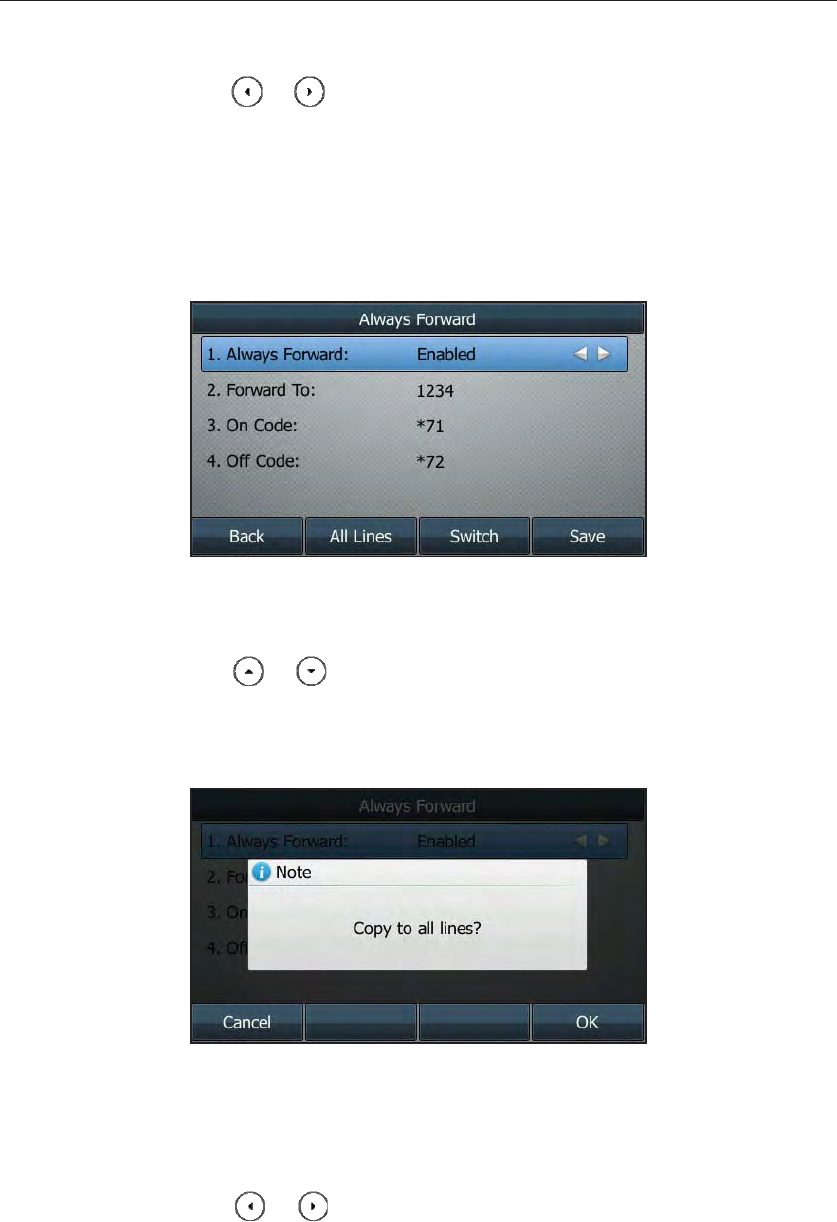
Basic Call Features
109
a.) If you select Always Forward, you can enable it for a specific account.
1) Press or , or the Switch soft key to select Enabled from the Always
Forward field.
2) Enter the destination number you want to forward all incoming calls to in
the Forward To field.
3) (Optional.) Enter the always forward on code or off code respectively in
the On Code or Off Code field.
You can also enable always forward for all accounts. After always forward was
enabled for a specific account, do the following:
1) Press or to highlight the Always Forward field.
2) Press the All Lines soft key.
The LCD screen prompts “Copy to all lines?”.
3) Press the OK soft key to accept the change or the Cancel soft key to
cancel.
b.) If you select Busy Forward, you can enable it for a specific account.
1) Press or , or the Switch soft key to select Enabled from the Busy
Forward field.
2) Enter the destination number you want to forward incoming calls to when
the phone is busy in the Forward To field.
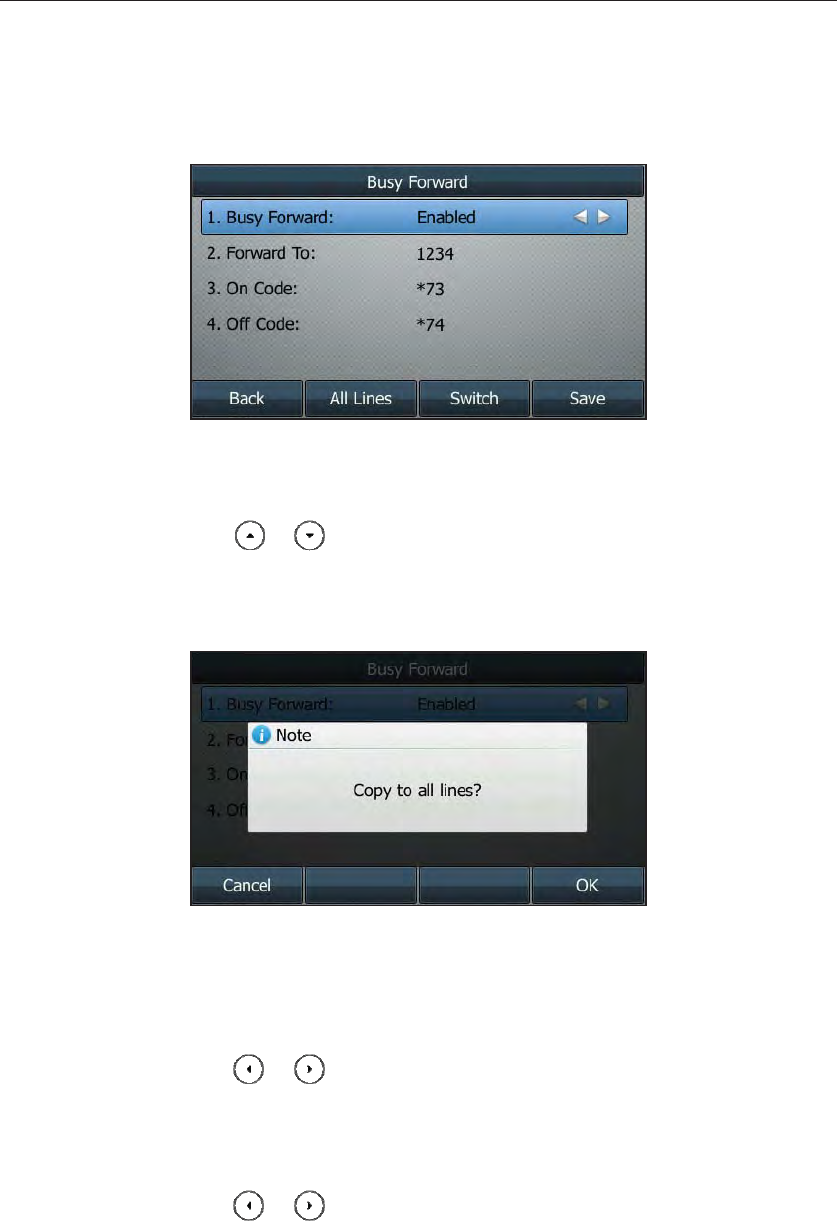
User Guide for the SIP-T48G IP Phone
110
3) (Optional.) Enter the busy forward on code or off code respectively in the
On Code or Off Code field.
You can also enable busy forward for all accounts. After busy forward was
enabled for a specific account, do the following:
1) Press or to highlight the Busy Forward field.
2) Press the All Lines soft key.
The LCD screen prompts “Copy to all lines?”.
3) Press the OK soft key to accept the change or the Cancel soft key to
cancel.
c.) If you select No Answer Forward, you can enable it for a specific account.
1) Press or , or the Switch soft key to select Enabled from the No
Answer Forward field.
2) Enter the destination number you want to forward unanswered incoming
calls to in the Forward To field.
3) Press or , or the Switch soft key to select the ring time to wait
before forwarding from the After Ring Time field.
The default ring time is 12 seconds.
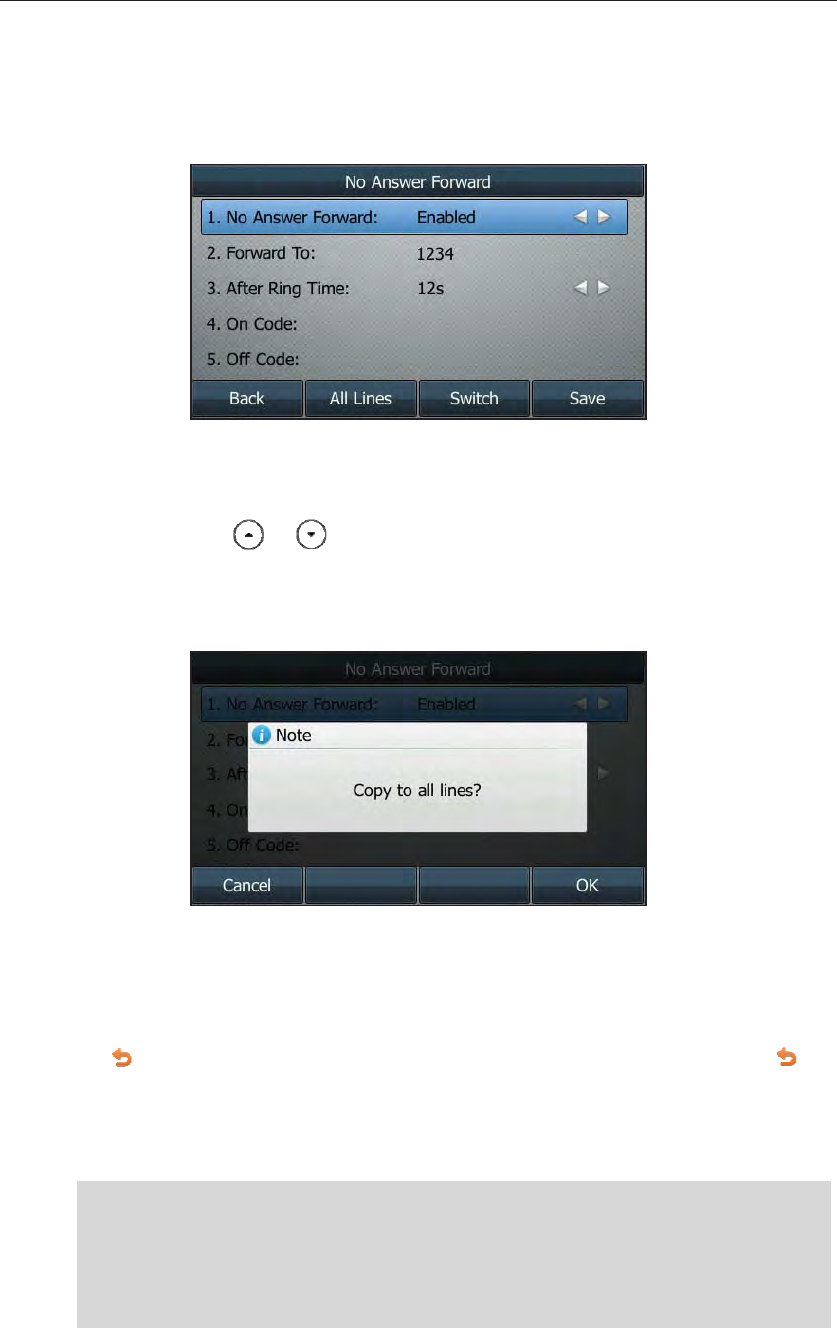
Basic Call Features
111
4) (Optional.) Enter the no answer forward on code or off code respectively in
the On Code or Off Code field.
You can also enable no answer forward for all accounts. After no answer
forward was enabled for a specific account, do the following:
1) Press or to highlight the No Answer Forward field.
2) Press the All Lines soft key.
The LCD screen prompts “Copy to all lines?”.
3) Press the OK soft key to accept the change or the Cancel soft key to
cancel.
5. Press the Save soft key to accept the change or the Back soft key to cancel.
The icon appears on the idle screen, and the associated line icon changes to .
Call forward is configurable via web user interface at the path Features->Forward &
DND.
Note You can also enter the SIP URL or IP address in the Forward To field. For more information
on using the SIP URL or IP address, refer to Placing Calls on page 82.
Call forward is local to the phone, and may be overridden by the server settings. Call
forward on code or off code may be different between servers. For more information,
contact your system administrator.
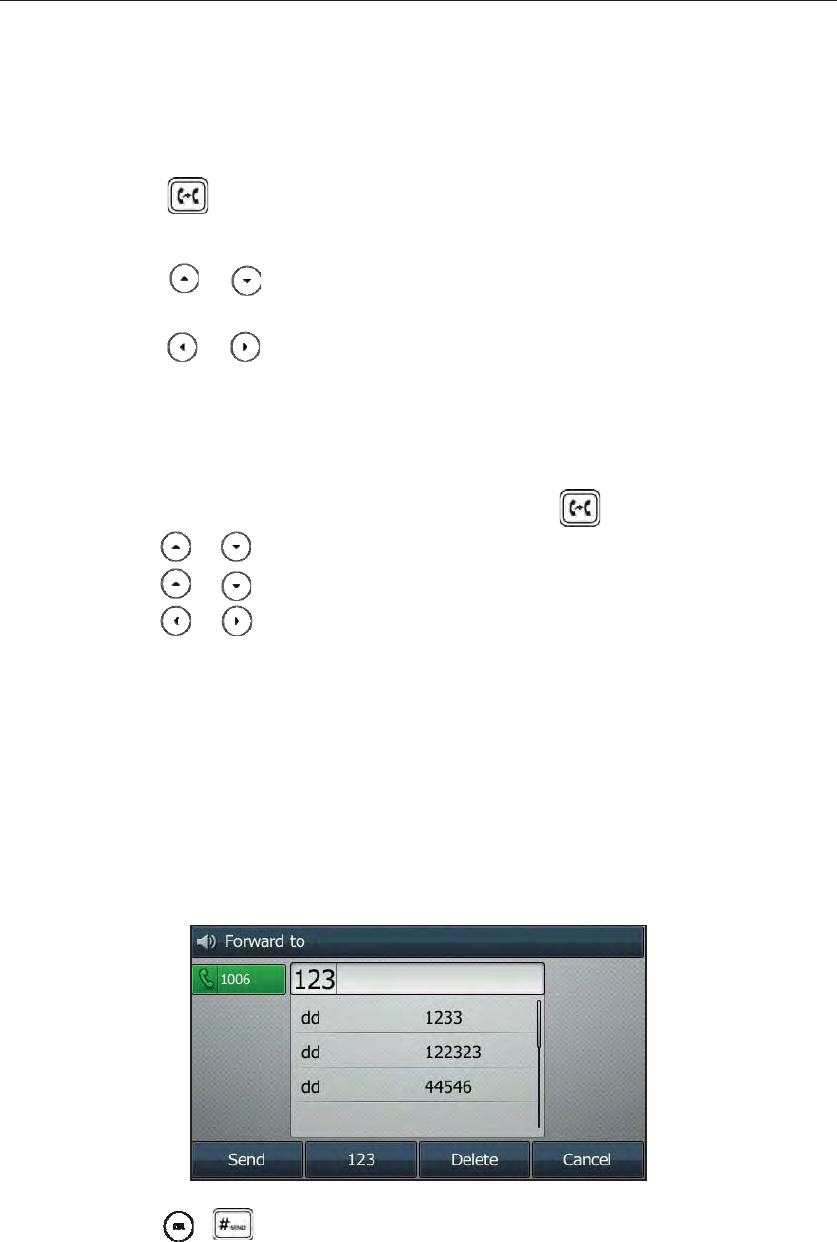
User Guide for the SIP-T48G IP Phone
112
To disable call forward in phone mode:
Do one of the following:
-Press when the phone is idle.
-Press Menu->Call Features->Call Forward.
Press or to select the desired forwarding type, then press the Enter soft
key.
Press or , or the Switch soft key to select Disabled to disable the call
forward.
Press the Save soft key to accept the change.
To disable call forward in custom mode for a specific account:
1. Press Menu->Call Features->Call Forward or press when the phone is idle.
2. Press or to select the desired account, then press the Enter soft key.
3. Press or to select the desired forwarding type, then press the Enter soft key.
4. Press or , or the Switch soft key to select Disabled to disable the call
forward.
5. Press the Save soft key to accept the change.
Dynamic Forwarding
To forward an incoming call to another party:
1. When the phone is ringing, press the Forward soft key.
2. Enter the number you want to forward the incoming call to.
3. Press , , or the Send soft key.
The LCD screen prompts a call forward message.
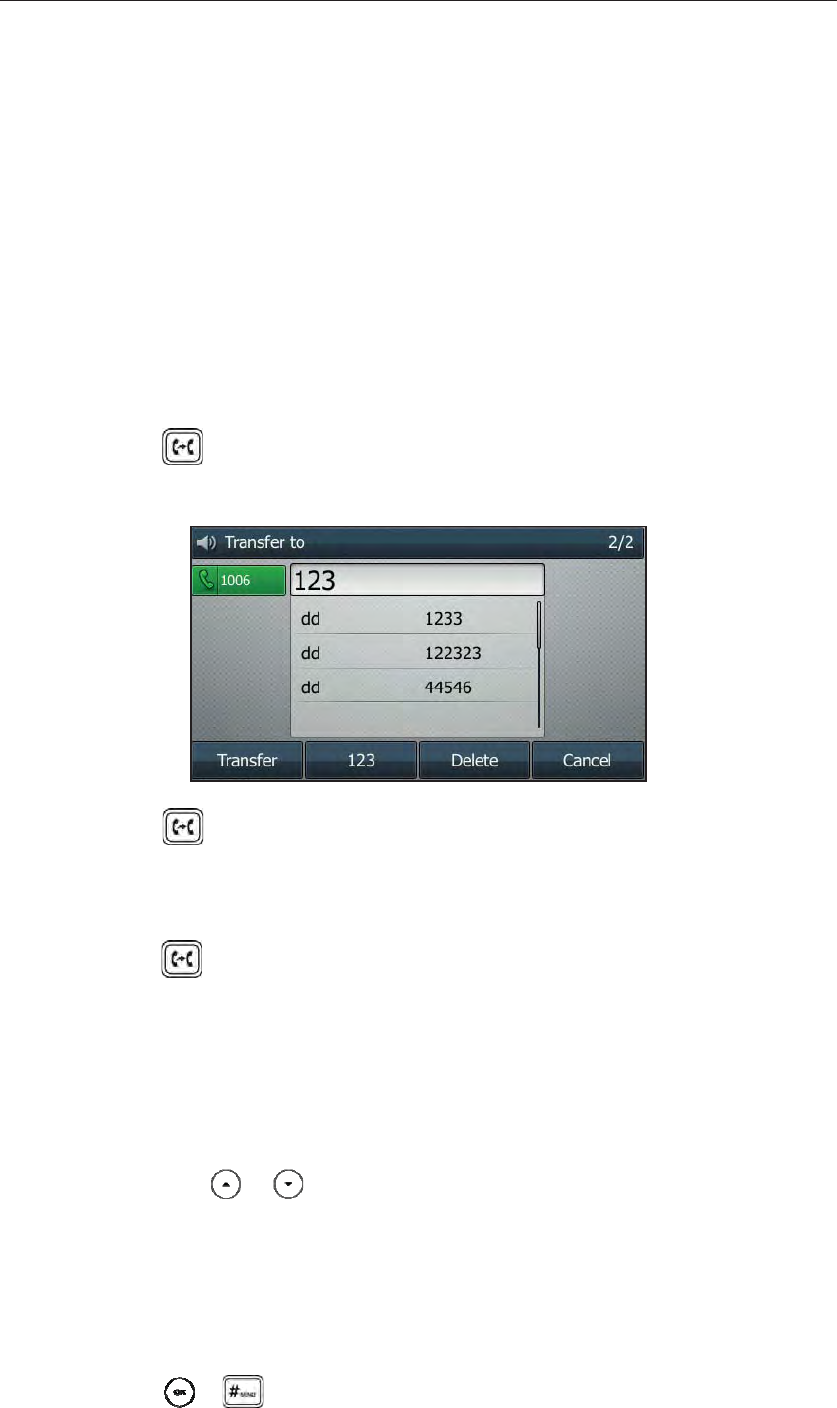
Basic Call Features
113
%CNN6TCPUHGT
You can transfer a call to another party in one of the three ways:
zBlind Transfer: Transfer a call directly to another party without consulting.
zSemi-Attended Transfer: Transfer a call when the target phone is ringing.
zAttended Transfer: Transfer a call with prior consulting.
To perform a blind transfer:
1. Press or the Transfer soft key during a call.
2. Enter the number you want to transfer the call to.
3. Press to complete the transfer.
Then the call is connected to the number to which you are transferring.
To perform a semi-attended transfer:
1. Press or the Transfer soft key during a call.
2. Do one of the following:
-Press the Directory soft key, and then select Local Directory. Select the desired group
and search for the contact (Directory should be configured in advance. Refer to
Directory on page 39 for more information).
-Press the Directory soft key, and then select Local Calllog. Select the desired list and
press or to select the entry (Directory should be configured in advance.
Refer to Directory on page 39 for more information).
Press the Directory soft key, and then select Remote Phone Book. Select the desired
group and search for the contact (Directory should be configured in advance.
Refer to Directory on page 39 and Remote PhoneBook on page 55 for more
information).
3. Press or to dial out.

User Guide for the SIP-T48G IP Phone
114
4. Press or the Transfer soft key to complete the transfer when receiving
ringback.

Basic Call Features
115
To perform an attended transfer:
1. Press or the Transfer soft key during a call.
2. Do one of the following:
Enter the number you want to transfer the call to.
-Press the Directory soft key, and then select Local Directory. Select the desired group
and search for the contact (Directory should be configured in advance. Refer to
Directory on page 39 for more information).
- Press the Directory soft key, and then select Local Calllog. Select the desired list and
press or to select the entry (Directory should be configured in advance.
Refer to Directory on page 39 for more information).
Press the Directory soft key, and then select Remote Phone Book. Select the desired
group and search for the contact (Directory should be configured in advance.
Refer to Directory on page 39 and Remote PhoneBook on page 55 for more
information).
3. Press or to dial out.
4. After the party answers the call, press or the Transfer soft key to complete the
transfer.
If you are using a handset, the transfer can be completed by hanging up the handset.
You can cancel the transfer before the call is connected by pressing the Cancel soft
key.
%CNN9CKVKPI
You can enable or disable call waiting on the phone. If call waiting is enabled, you can
receive another call when there is an active call on the phone. Otherwise, another
incoming call is automatically rejected by the phone with a busy message when there
is an active call on the phone. You can also enable or disable the phone to play a
warning tone when receiving another call.
To configure call waiting via phone user interface:
1. Press Menu->Call Features->Call Waiting.
2. Press or , or the Switch soft key to select Enabled from the Call Waiting
field.
3. Press or , or the Switch soft key to select Enabled from the Play Tone field.
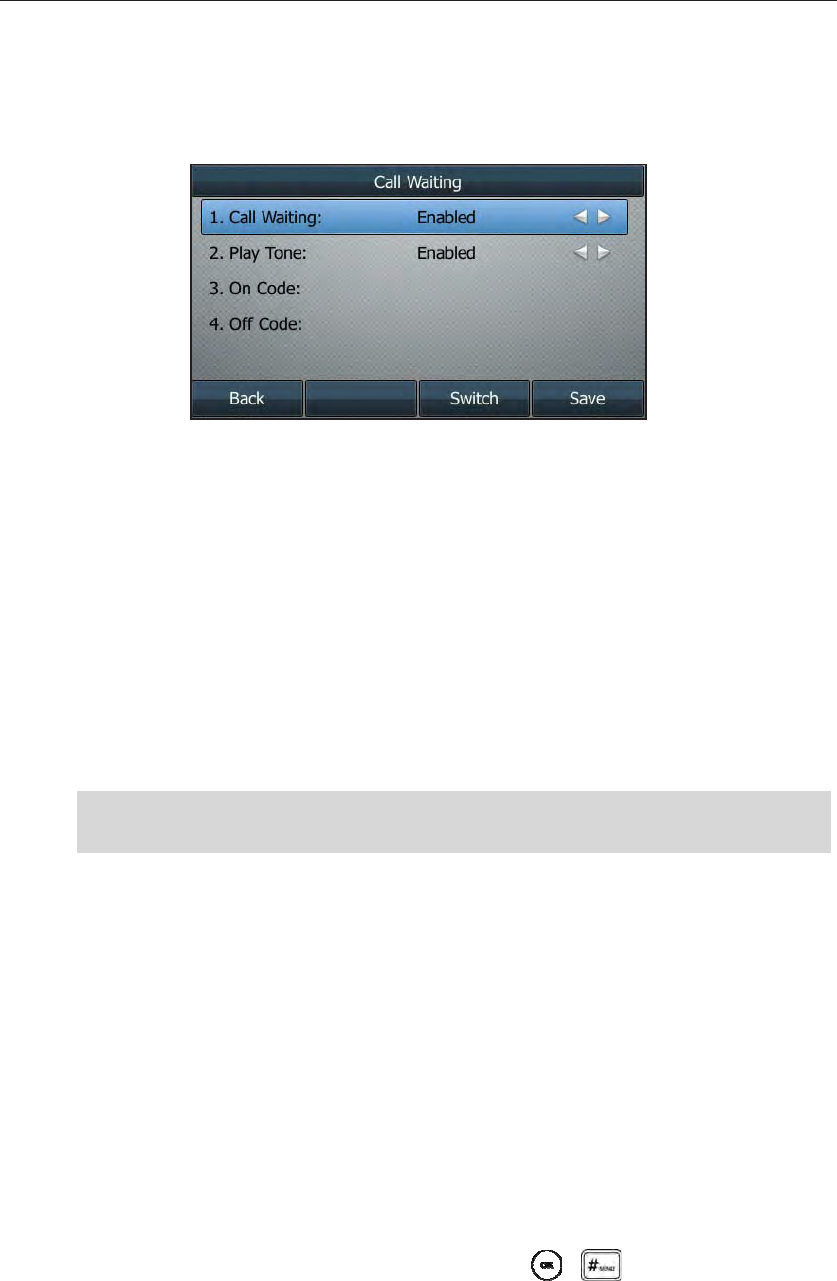
User Guide for the SIP-T48G IP Phone
116
4. (Optional.) Enter the call waiting on code or off code respectively in the On Code
or Off Code field.
5. Press the Save soft key to accept the change or the Back soft key to cancel.
Call waiting is configurable via web user interface at the path Features->General
Information.
%QPHGTGPEG
You can create a conference with two parties using the phone’s local conference. You
can create a conference between an active call and a call on hold by pressing the
Conference soft key. The SIP-T48G also supports network conference.
Note
.QECN%QPHGTGPEG
The SIP-T48G IP phone supports up to 3 parties (including yourself) in a conference call.
This is the default method of conference called Local Conference.
To set up a local conference call:
1. Place a call to the first party.
2. When the first party answers the call, press the Conference soft key to place a new
call.
The active call is placed on hold.
3. Enter the number of the second party and press , , or the Send soft key.
Network conference is not available on all servers. For more information, contact your
system administrator.
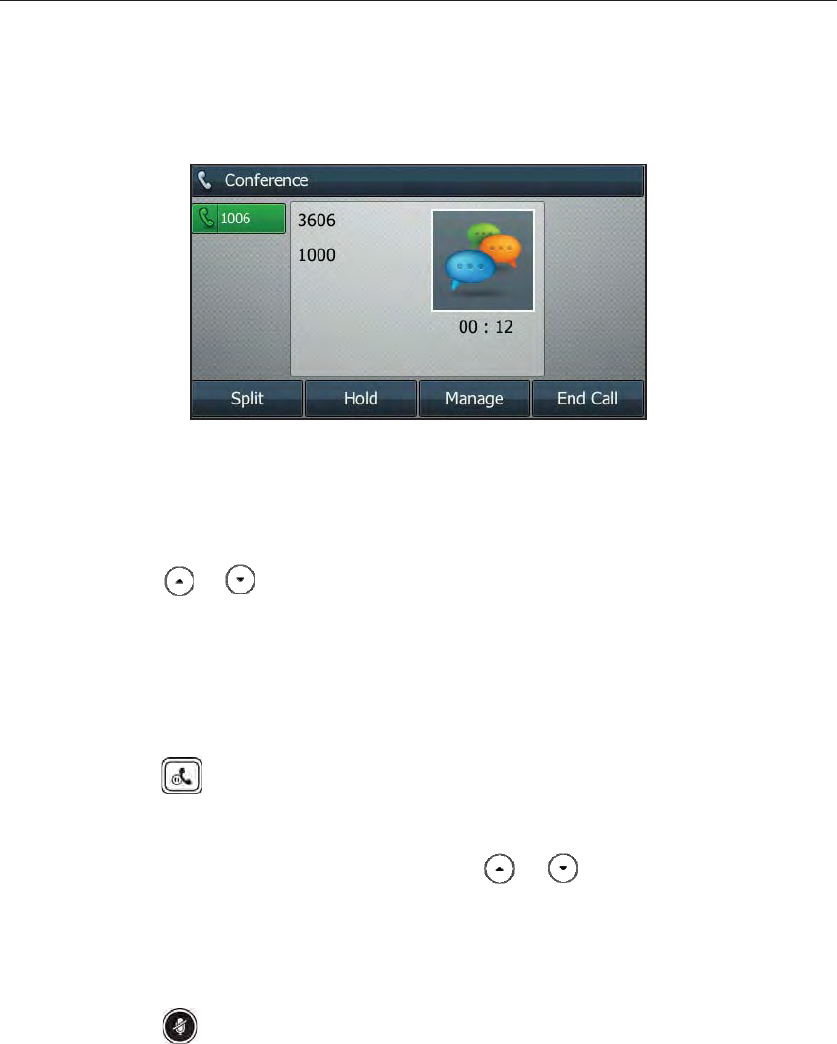
Basic Call Features
117
4. When the second party answers the call, press the Conference soft key again to
join all parties in the conference.
To join two calls in a conference:
1. Place two calls using two different accounts on the phone (for example, place the
first call using account 1, and then place the second call using account 2).
2. Press or to select the call for conference and make sure the call is active
(for example, select the call on account 1).
3. Press the Conference soft key to join the two calls in the conference on the
selected account.
During the conference call, you can do the following:
Press or the Hold soft key to place the conference on hold.
Press the Split soft key to split the conference call into two individual calls.
Press the Manage soft key, and then press or to select the desired party:
-Press the Far Mute soft key to forbid the party from speaking.
-Press the Remove soft key to remove the party from the conference call.
-Press the Back soft key to return to the previous interface.
Press to mute the conference call.
Press the End Call soft key to drop the conference call.
0GVYQTM%QPHGTGPEG
You can use network conference feature on the SIP-T48G IP phone to conduct a
conference with multiple participants.
This feature allows you to perform the following:
zJoin two calls together into a conference call.
zInvite another party into an active conference call.
To use this feature, contact your system administrator for the network conference URI in
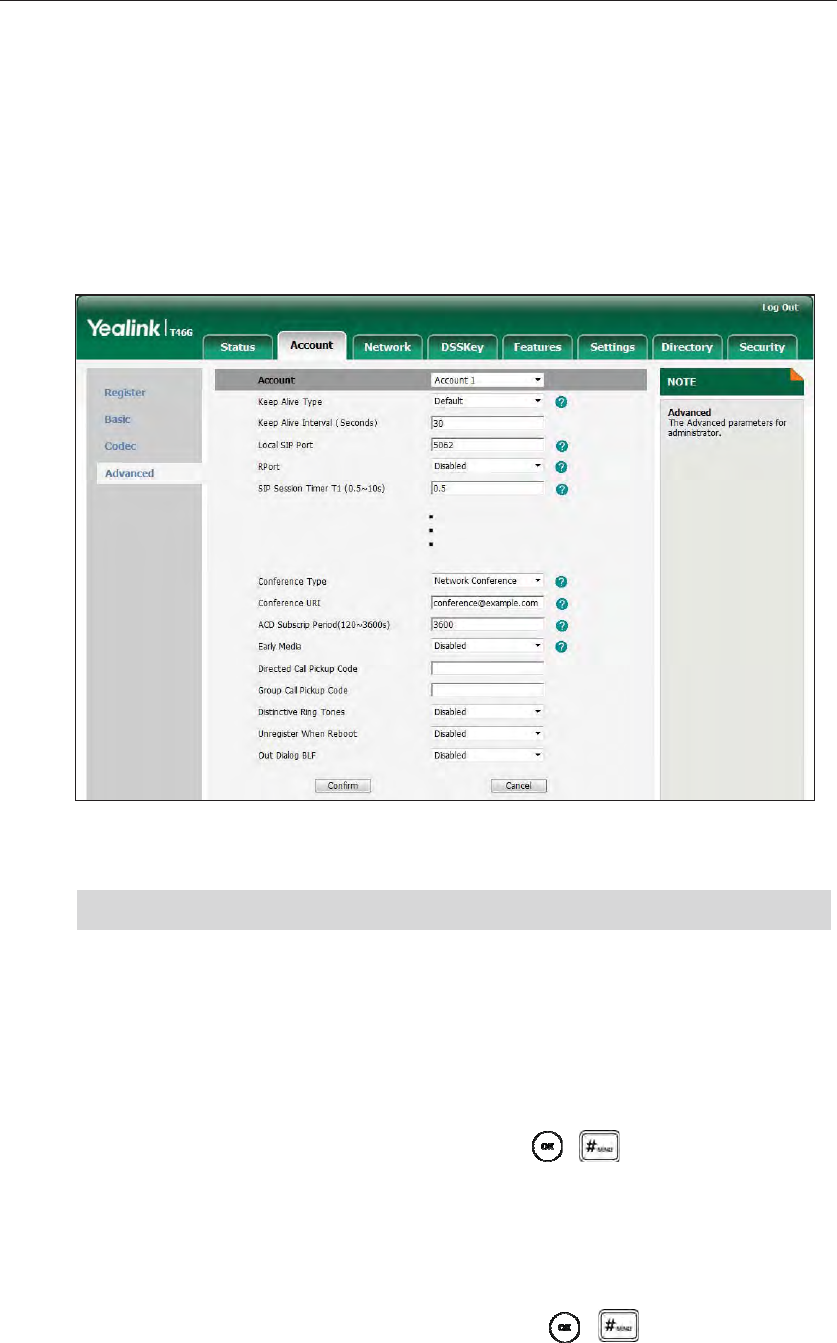
User Guide for the SIP-T48G IP Phone
118
advance.
To configure network conference via web user interface:
1. Click on Account->Advanced.
2. Select Network Conference from the pull-down list of Conference Type.
3. Enter the conference URI (e.g., conference@example.com) in the Conference URI
field.
4. Click Confirm to accept the change.
Note
To set up a network conference call:
1. Place a call to the first party.
2. Press the Conference soft key to place a new call.
The active call is placed on hold.
3. Enter the number of the second party and press , , or the Send soft key.
4. When the second party answers the call, press the Conference soft key to add the
second party to the conference.
5. Press the Conference soft key to place a new call.
The conference is placed on hold.
6. Enter the number of the new party and then press , , or the Send soft key.
7. When the new party answers the call, press the Conference soft key to add the new
party to the conference.
Network conference is configurable via web user interface only.
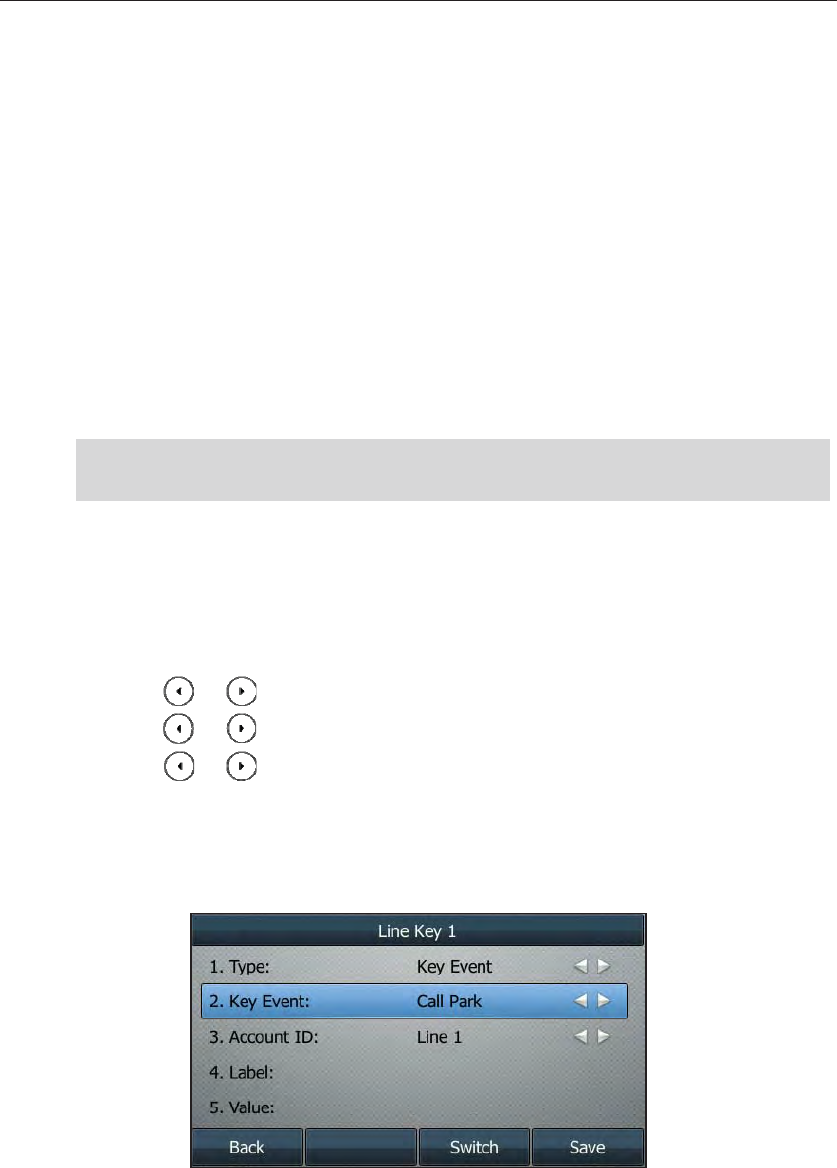
Basic Call Features
119
8. Repeat steps 5 to 7 until you have added all intended parties.
The procedures to set up a network conference call on specific servers may be different
from introduced above. Contact your system administrator for more information.
%CNN2CTM
You can use call park to place a call on hold, and then retrieve the call from another
phone in the system (for example, a phone in another office or conference room). You
can park an active call by pressing the call park key on the phone. If the call is parked
successfully, the response is either a voice prompt confirming that the call was parked,
or a visible prompt on the LCD screen.
Note
To configure a call park key via phone user interface:
1. Press Menu->Call Features->DSS Keys.
2. Select the desired DSS key.
3. Press or , or the Switch soft key to select Key Event from the Type field.
4. Press or , or the Switch soft key to select Call Park from the Key Event field.
5. Press or , or the Switch soft key to select the desired line from the Account
ID field.
6. Enter the call park code in the Value field.
7. (Optional.) Enter the string that will appear on the LCD screen in the Label field.
8. Press the Save soft key to accept the change or the Back soft key to cancel.
Call park key is configurable via web user interface at the path DSSKey->Line Key.
To use call park:
1. User on phone A places a call to phone B.
2. User on phone A wants to take the call in a conference room for privacy, then
Call park is not available on all servers. Contact your system administrator for more
information.
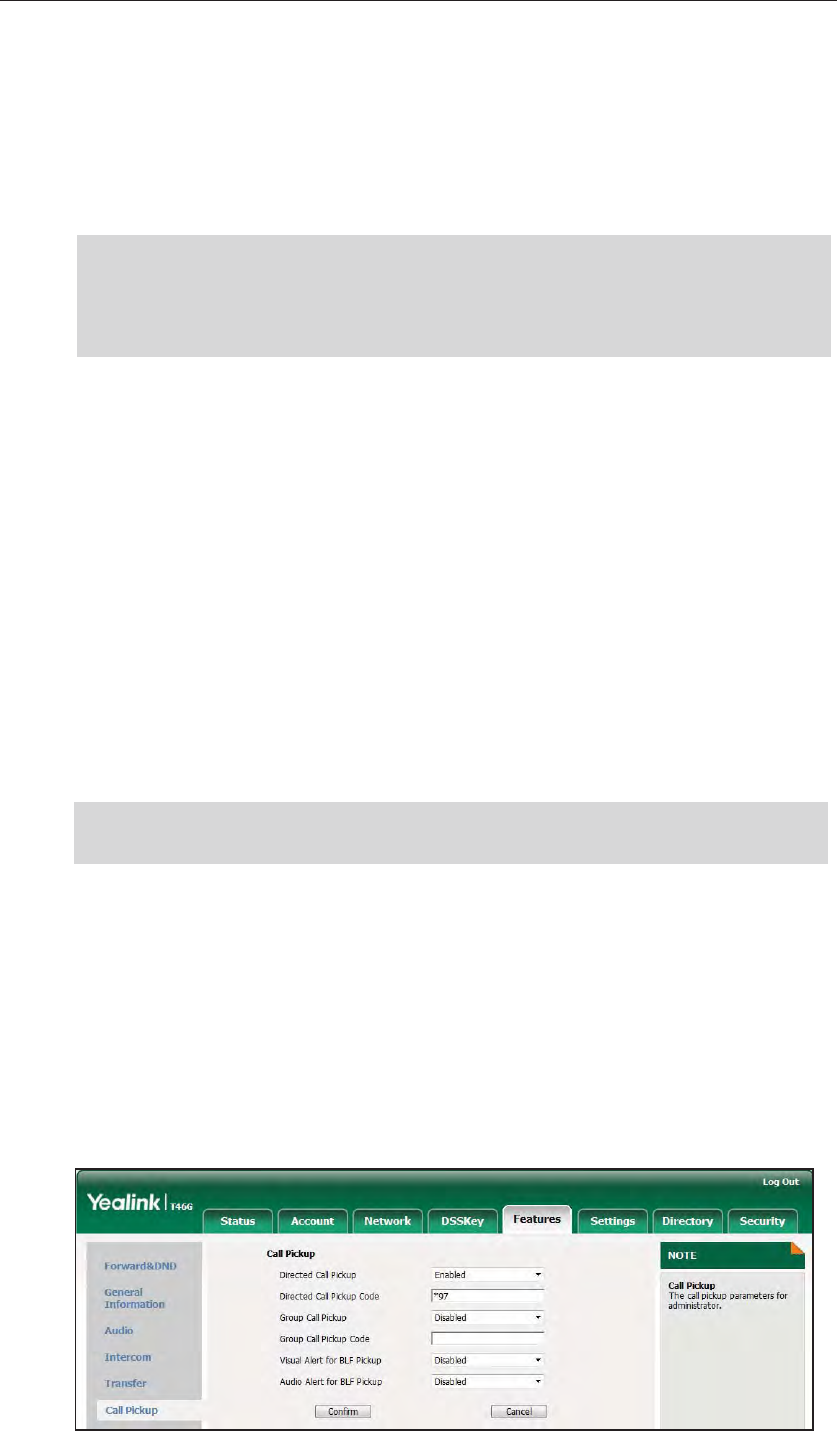
User Guide for the SIP-T48G IP Phone
120
presses the call park key on phone A.
3. User on phone A walks to an available conference room where the phone is
designated as phone C. The user dials the call park retrieve code to retrieve the
parked call.
The system establishes call between phone C and B.
Note
%CNN2KEMWR
You can use call pickup to answer someone else’s incoming call on the phone. The
SIP-T48G IP phone supports directed call pickup and group call pickup. Directed call
pickup is used for picking up a call that is ringing at a specific phone number. Group
call pickup is used for picking up a call that is ringing at any phone number in the group.
The pickup group should be predefined, contact your system administrator for more
information.
You can pick up an incoming call by using the DPickup/GPickup soft key. To use call
pickup, you need to configure the call pickup code beforehand on a global or per-line
basis via web user interface.
Note
Directed Call Pickup
To enable directed call pickup and configure the directed call pickup code on a
global basis via web user interface:
1. Click on Features->Call Pickup.
2. Select Enabled from the pull-down list of Directed Call Pickup.
3. Enter the directed call pickup code in the Directed Call Pickup Code field.
The call park code and call park retrieve code are predefined on the system server.
Contact your system administrator for more information.
If the parked call is not retrieved within a period of time assigned by the system, the
phone performing call park feature will receive call back.
If there are many incoming calls at the same time, pressing the GPickup soft key on the
phone will pick up the call that rings first.
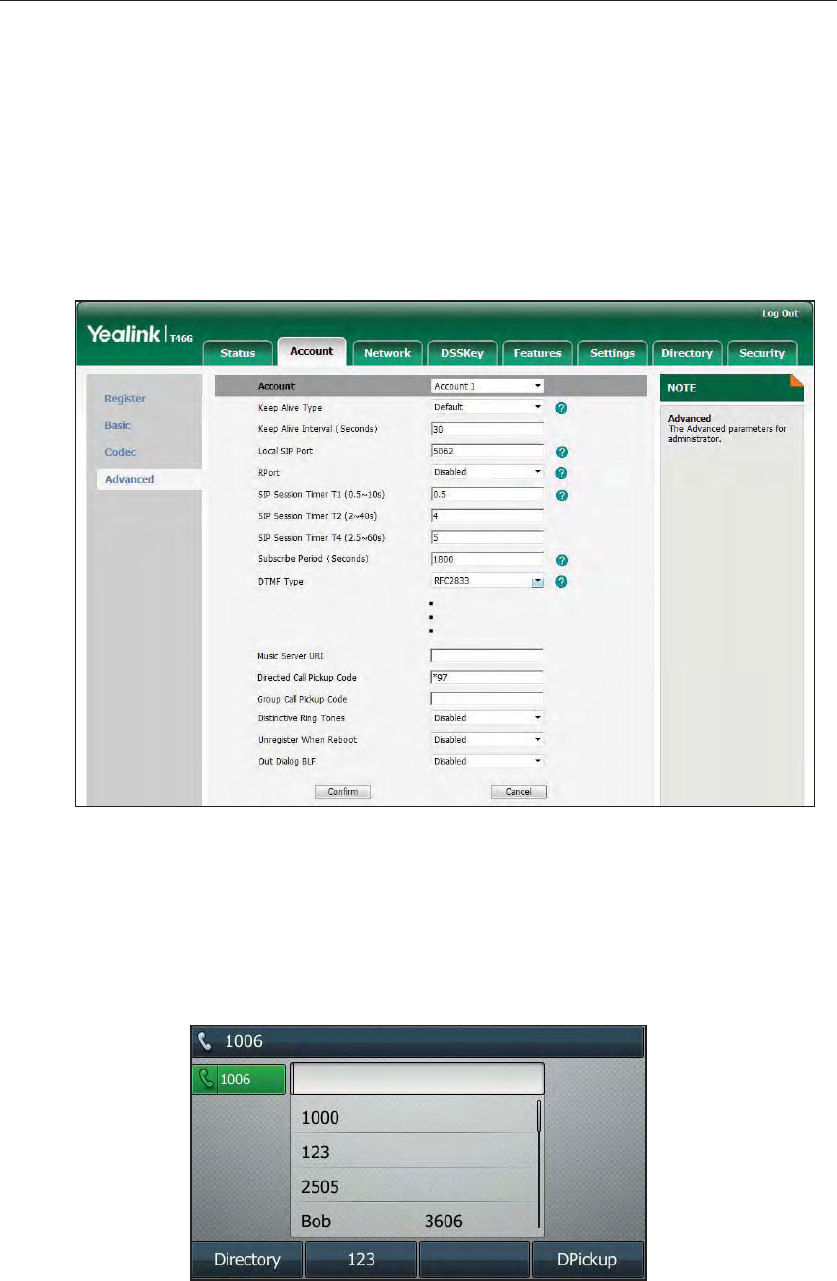
Basic Call Features
121
4. Click Confirm to accept the change.
To configure the directed call pickup code on a per-line basis via web user interface:
1. Click on Account.
2. Select the desired account from the pull-down list of Account.
3. Click on Advanced.
4. Enter the directed call pickup code in the Directed Call Pickup Code field.
5. Click Confirm to accept the change.
To pick up a call directly:
1. Pick up the handset.
2. The DPickup soft key appears on the LCD screen.
3. Press the DPickup soft key on your phone when a phone receives an incoming call.
4. Enter the phone number which receives an incoming call.
5. Press the DPickup soft key again.
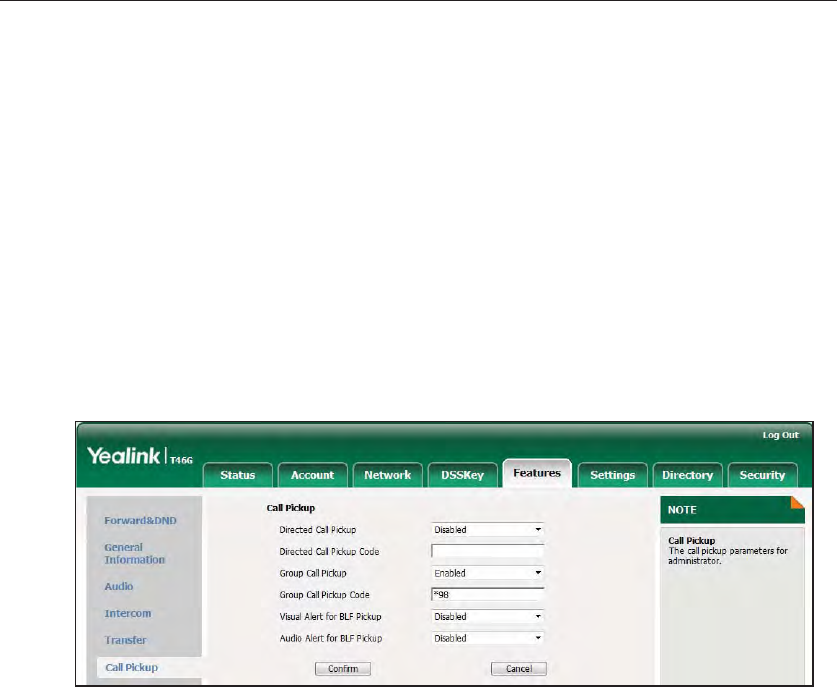
User Guide for the SIP-T48G IP Phone
122
The call is answered on your phone.
You can also configure a DSS key as a directed pickup key via phone user interface or
web user interface. You can pick up a call by pressing the directed pickup key directly.
Group Call Pickup
To enable the group call pickup and configure the group call pickup code on a global
basis via web user interface:
1. Click on Features->Call Pickup.
2. Select Enabled from the pull-down list of Group Call Pickup.
3. Enter the group call pickup code in the Group Call Pickup Code field.
4. Click Confirm to accept the change.
To configure the group call pickup code on a per-line basis via web user interface:
1. Click on Account.
2. Select the desired account from the pull-down list of Account.
3. Click on Advanced.
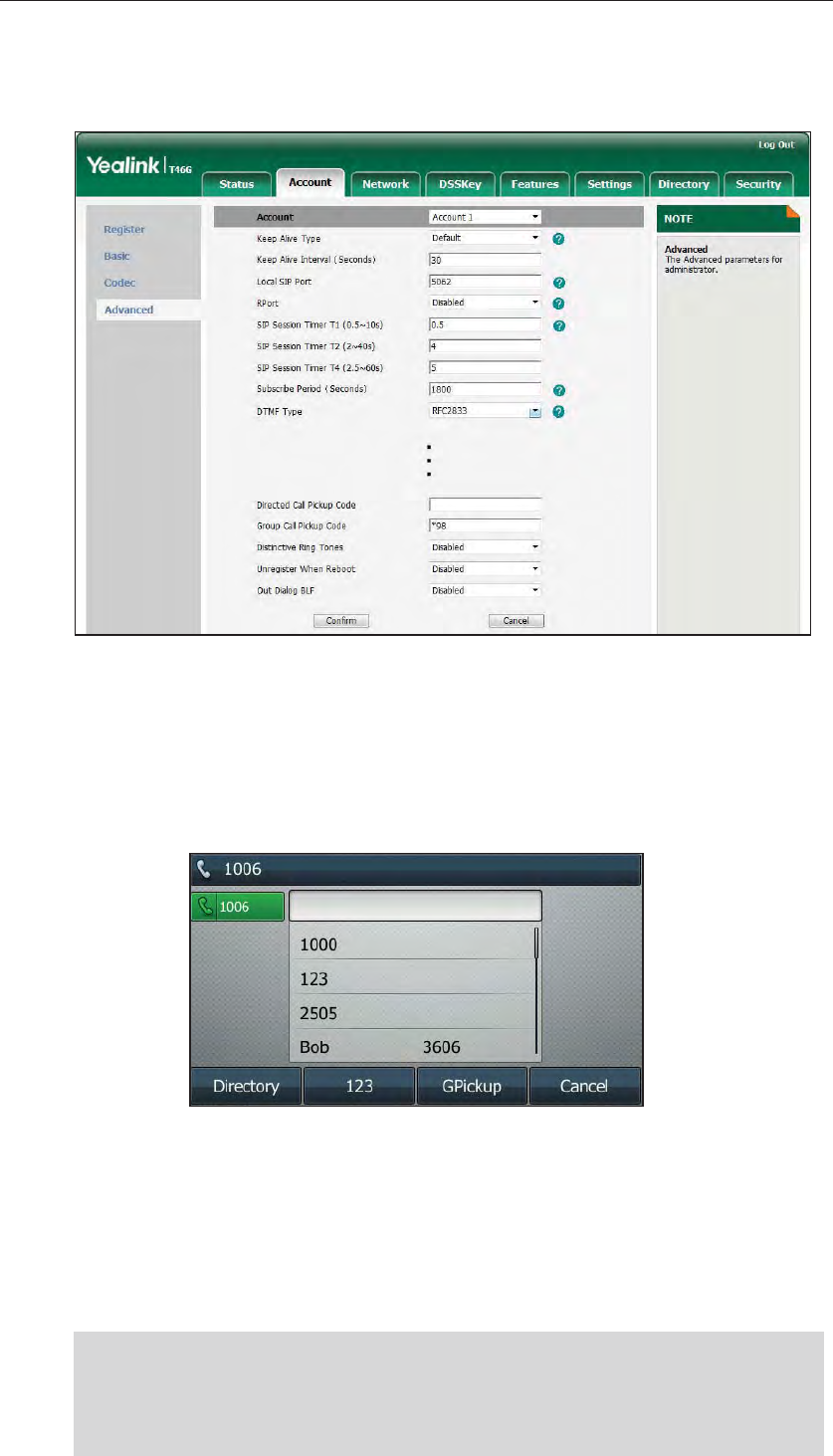
Basic Call Features
123
4. Enter the group call pickup code in the Group Call Pickup Code field.
5. Click Confirm to accept the change.
To pick up a call in the group:
1. Pick up the handset.
2. The GPickup soft key appears on the LCD screen.
3. Press the GPickup soft key on your phone when a phone in the group receives an
incoming call.
The call is answered on your phone.
You can also configure a DSS key as group pickup key via phone user interface or web
user interface. You can pick up a call by pressing the group pickup key directly.
Note The directed call pickup code and group call pickup code are predefined on the
system server. Contact your system administrator for more information.
The call pickup code configured on a per-line basis takes precedence over that
configured on a global basis.
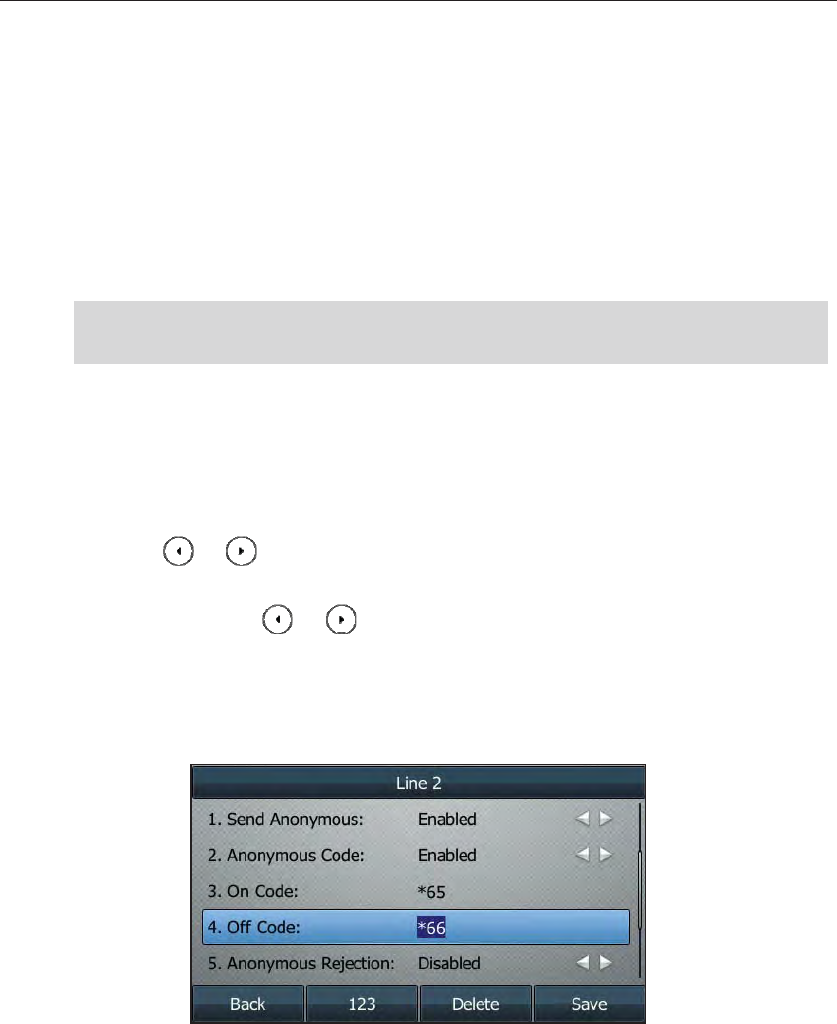
User Guide for the SIP-T48G IP Phone
124
#PQP[OQWU%CNN
You can use anonymous call to block the identity and phone number from showing up
to the called party when you call someone. For example, you want to call to consult
some of the services, but don’t want to be harassed. Anonymous call is configurable on
a per-line basis. You can also configure the phone to send anonymous code to the
server to activate/deactivate anonymous call on the server side.
Note
To configure anonymous call via phone user interface:
1. Press Menu->Call Features->Anonymous.
2. Select the desired line and then press Enter soft key.
3. Press or , or the Switch soft key to select Enabled from the Send
Anonymous field.
4. (Optional.) Press or , or the Switch soft key to select the desired value from
the Anonymous Code field.
5. (Optional.) Enter the anonymous call on code in the On Code field.
6. (Optional.) Enter the anonymous call off code in the Off Code field.
7. Press the Save soft key to accept the change or the Back soft key to cancel.
Anonymous call is configurable via web user interface at the path Account->Basic.
To place an anonymous call:
1. Using the specific line on the phone to place a call to phone B.
Anonymous call is not available on all servers. Contact your system administrator for the
anonymous call on code and off code.
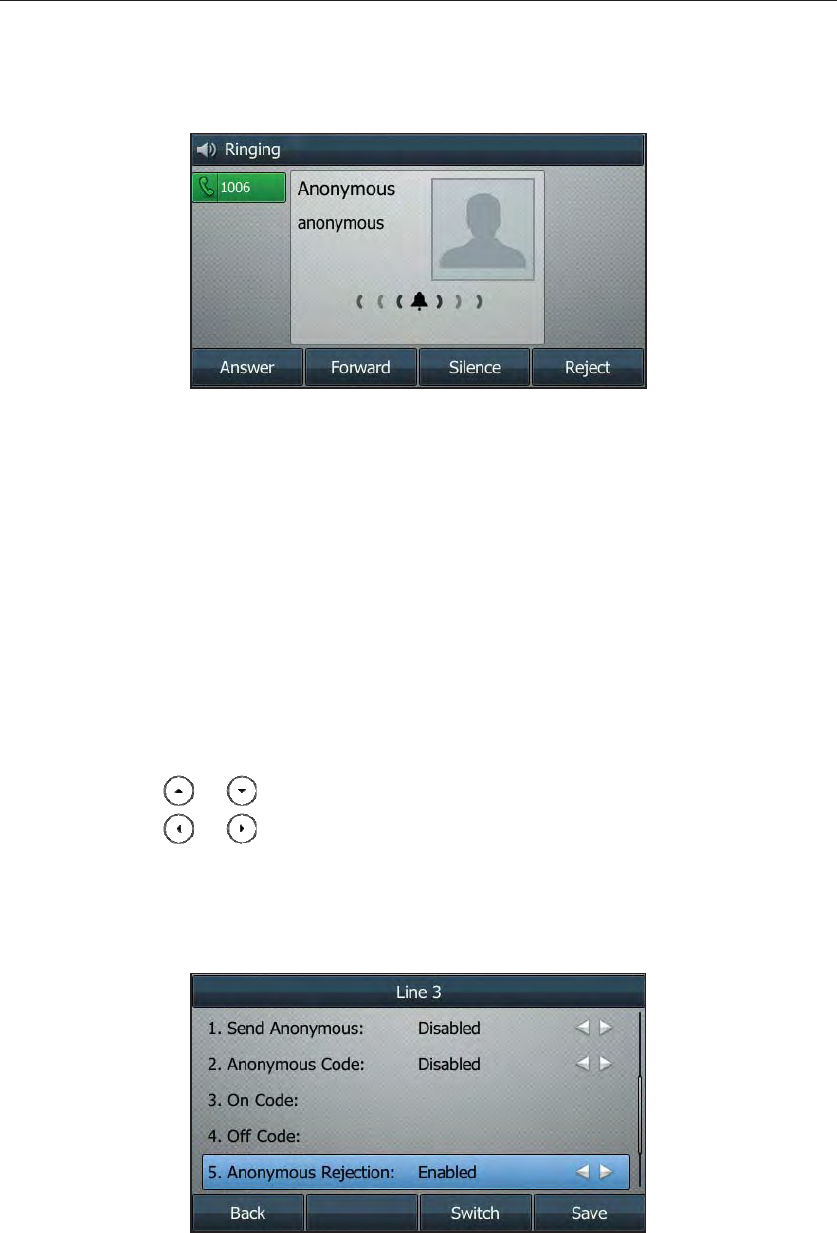
Basic Call Features
125
The LCD screen of phone B prompts an incoming call from anonymity.
#PQP[OQWU%CNN4GLGEVKQP
You can use anonymous call rejection to reject incoming calls from anonymous callers.
Anonymous call rejection automatically rejects incoming calls from callers who
deliberately block their identities and numbers from showing up. Anonymous call
rejection is configurable on a per-line basis.
To configure anonymous call rejection via phone user interface:
1. Press Menu->Call Features->Anonymous.
2. Select the desired line and then press Enter soft key.
3. Press or to scroll to the Anonymous Rejection field.
4. Press or , or the Switch soft key to select Enabled from the Anonymous
Rejection field.
5. (Optional.) Enter the anonymous call rejection on code in the On Code field.
6. (Optional.) Enter the anonymous call rejection off code in the Off Code field.
7. Press the Save soft key to accept the change or the Back soft key to cancel.
Anonymous call rejection is configurable via web user interface at the path
Account->Basic.

User Guide for the SIP-T48G IP Phone
126

Advanced Phone Features
127
#FXCPEGF2JQPG(GCVWTGU
This chapter provides operating instructions for the advanced features of the SIP-T48G IP
phone. Topics include:
zBusy Lamp Field (BLF)
zCall Recording
zHot Desking
zIntercom
zMulticast Paging
zMusic on Hold
zAutomatic Call Distribution (ACD)
zMessages
If you require additional information or assistance with your new phone, contact your
system administrator.
$WU[.COR(KGNF$.(
You can use BLF to monitor a specific line for status changes on the phone. For example,
you can configure a BLF key on the phone for monitoring the status of a friend’s line
(busy or idle). The BLF key LED illuminates solid red when the friend’s line is in use. For
more information on BLF key LED indications, refer to LED Instructions on page 8.
You can press a BLF key to dial out the monitored phone number when the monitored
line is idle. You can receive a visual and an audio alert (if enabled), and also pick up
the call when the monitored line receives an incoming call. For more information,
contact your system administrator.
To configure a BLF key via phone user interface:
1. Press Menu->Call Features->DSS Keys.
2. Select the desired DSS key.
3. Press or , or the Switch soft key to select BLF from the Type field.
4. Press or , or the Switch soft key to select the desired line from the Account
ID field.
5. Enter the phone number or extension you want to monitor in the Value field.
6. (Optional.) Enter the string that will appear on the LCD screen in the Label field.
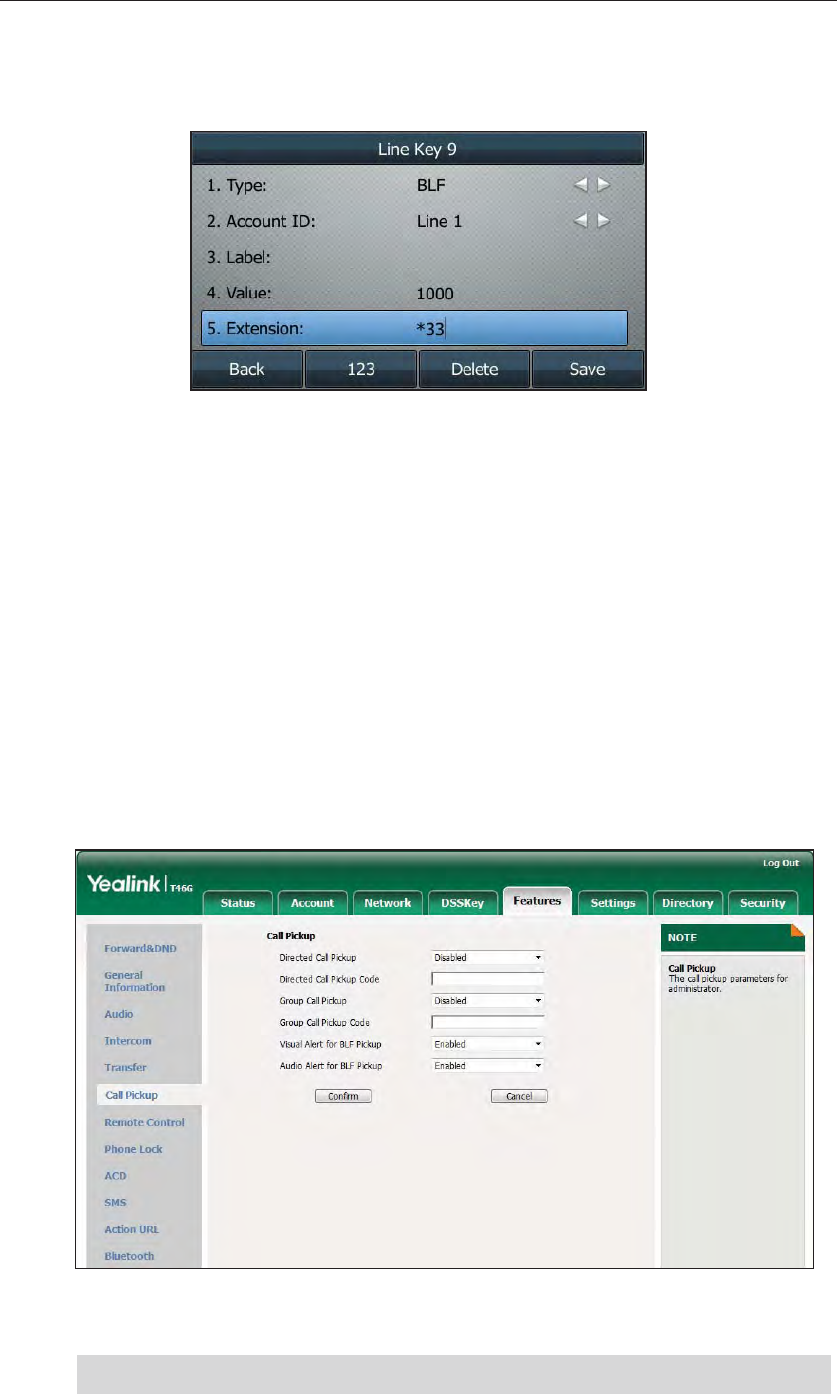
User Guide for the SIP-T48G IP Phone
128
7. (Optional.) Enter the pickup code in the Extension field.
8. Press the Save soft key to accept the change or the Back soft key to cancel.
BLF key is configurable via web user interface at the path DSSKey->Line Key.
You can enable audio alert for BLF pickup on the phone. This allows the monitoring
phone to play a warning tone when the monitored line receives an incoming call. You
can also enable visual alert for BLF pickup on the phone. This allows the LCD screen of
the monitoring phone to display the caller ID when the monitored line receives an
incoming call.
To enable visual and audio alert via web user interface:
1. Click on Features->Call Pickup.
2. Select Enabled from the pull-down list of Visual Alert for BLF Pickup.
3. Select Enabled from the pull-down list of Audio Alert for BLF Pickup.
4. Click Confirm to accept the change.
Note Visual and audio alerts are configurable via web user interface only.
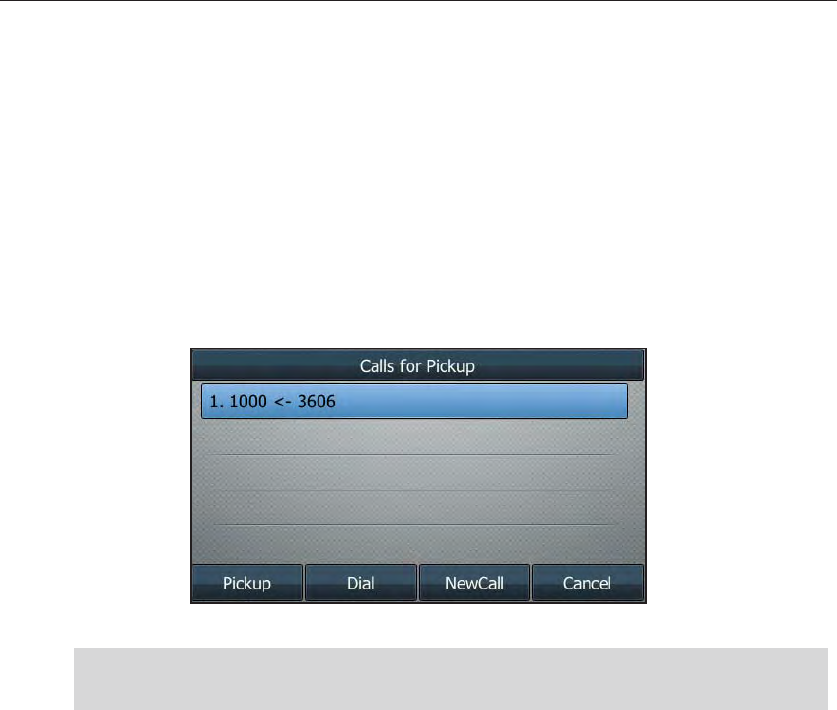
Advanced Phone Features
129
When the monitored line receives an incoming call, the followings occur on the phone:
zThe phone plays a warning tone (if enabled).
zThe BLF key LED flashes red.
zThe caller ID appears on the LCD screen (if enabled).
In the following figure, the LCD screen shows an incoming call from 3606 on the
monitored line.
Note
When there is an active call on the IP phone, you can transfer the active call to the
monitored phone number directly by pressing the BLF key. The phone transfers the
active call differently depending on the transfer mode via DSS key. For more
information on performing call transfer, refer to Call Transfer on page 113.
To configure the transfer mode via DSS key via web user interface:
1. Click on Features->Transfer.
2. Select the desired transfer mode from the pull-down list of Transfer Mode Via Dsskey.
Depending on your selection:
If you select Blind Transfer, press the BLF key to blind transfer the call to the monitored
phone number.
If you select Attended Transfer, press the BLF key to dial out the monitored phone
number. Then you can perform the attended or semi-attended transfer.
If your phone is locked and the type of the keypad lock is configured as Function Keys or
All Keys, you cannot use the Pickup, Dial, NewCall and Cancel soft keys until unlocked.
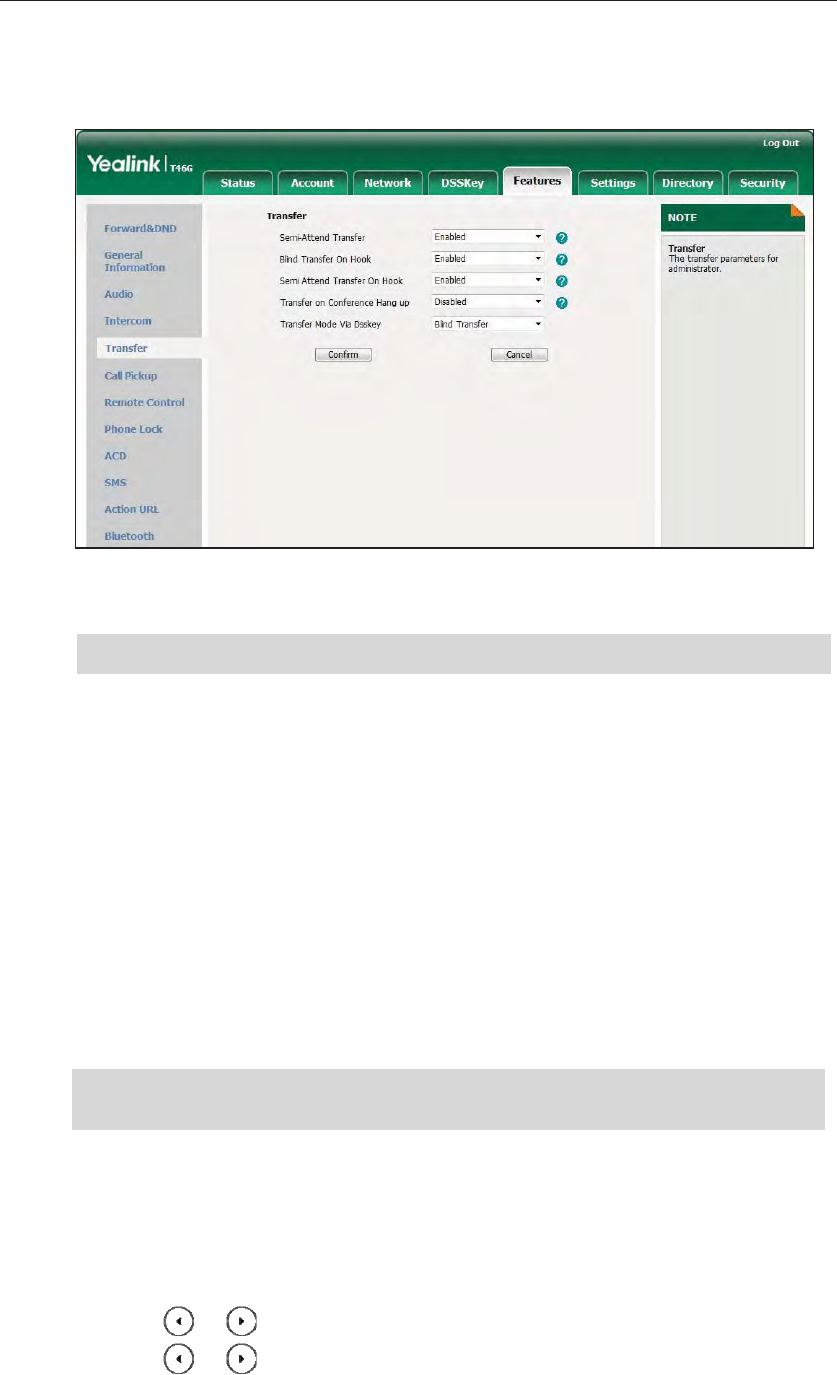
User Guide for the SIP-T48G IP Phone
130
If you select New Call, press the BLF key to place a new call to the monitored user.
3. Click Confirm to accept the change.
Note
%CNN4GEQTFKPI
You can record calls by pressing a record key on the phone. The SIP-T48G IP phone
supports record and URL record.
Two ways of call recording:
zRecord: The phone sends SIP INFO message containing a specific header “Record:
on/off” to trigger a recording.
zURL Record: The phone sends HTTP URL request to trigger a recording. Contact your
system administrator for the predefined URL.
Note
To configure a record key via phone user interface:
1. Press Menu->Call Features->DSS Keys.
2. Select the desired DSS key.
3. Press or , or the Switch soft key to select Key Event from the Type field.
4. Press or , or the Switch soft key to select Record from the Key Event field.
Call record is not available on all servers. Contact your system administrator for more
information.
Transfer mode via DSS key is configurable via web user interface only.
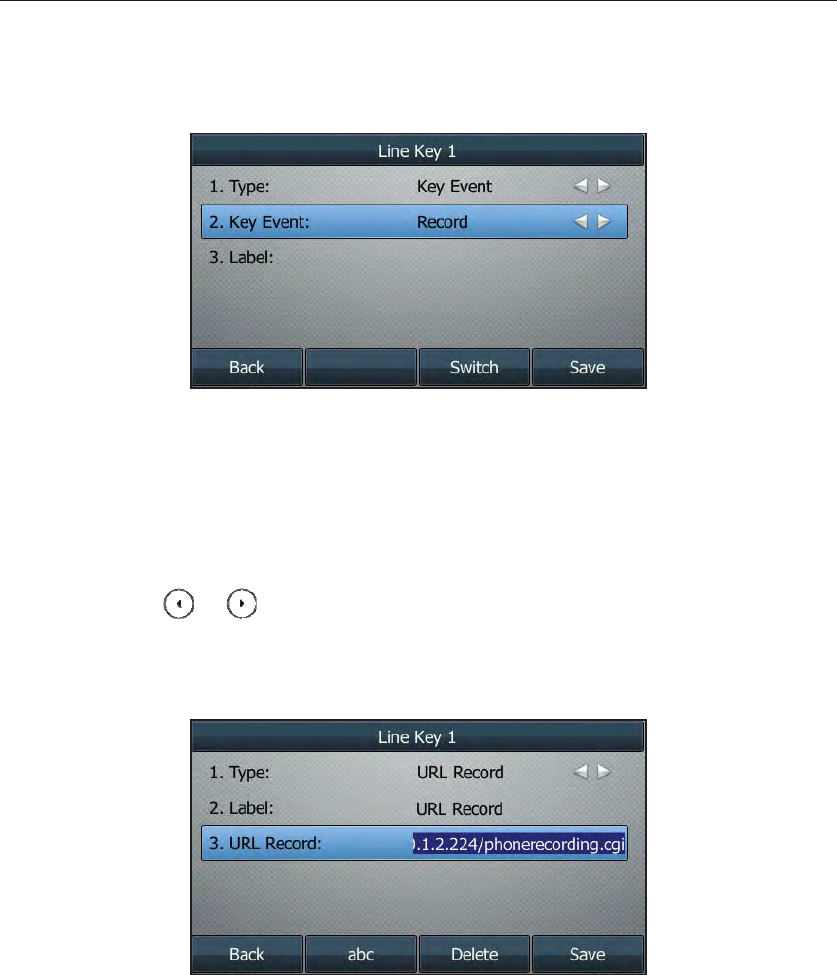
Advanced Phone Features
131
5. (Optional.) Enter a string that will appear on the LCD screen in the Label field.
6. Press the Save soft key to accept the change or the Back soft key to cancel.
To configure a URL record key via phone user interface:
1. Press Menu->Call Features->DSS Keys.
2. Select the desired DSS key.
3. Press or , or the Switch soft key to select URL Record from the Type field.
4. (Optional.) Enter a string that will appear on the LCD screen in the Label field.
5. Enter the URL (e.g., http://10.1.2.224/phonerecording.cgi) in the URL Record field.
6. Press the Save soft key to accept the change or the Back soft key to cancel.
Record and URL record key are configurable via web user interface at the path
DSSKey->Line Key.
The Record and URL Record keys control the recording, and are available:
zDuring an active call
zWhen calls are on hold or mute
zDuring a blind or attended transfer
zDuring a conference call
zWhen the phone prompts you to answer an incoming call
The Record and URL Record keys are not available when:
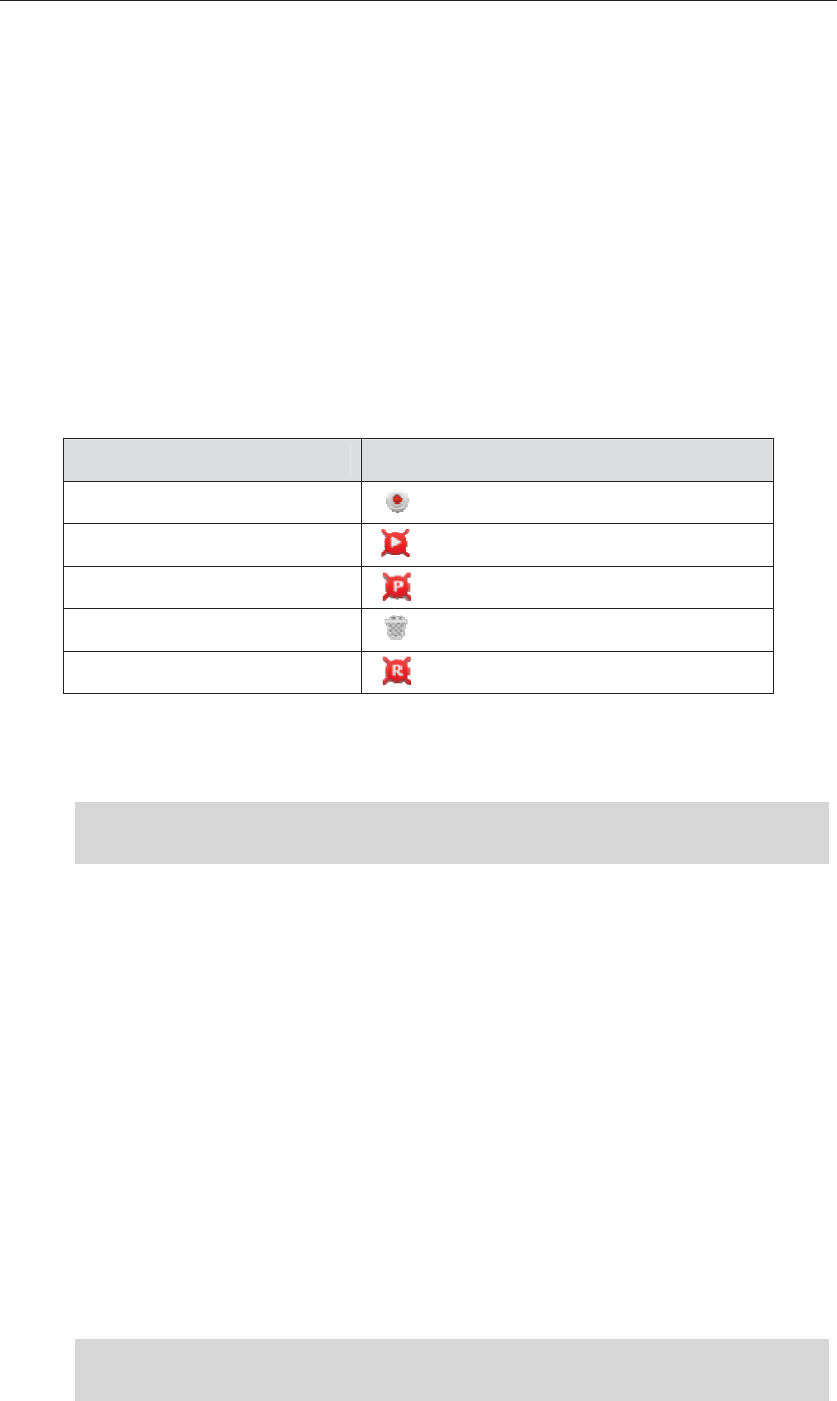
User Guide for the SIP-T48G IP Phone
132
zThere are no connected calls on your phone
zYou place a new call
To record a call:
1. Press the Record or URL Record key during a call.
If the recording starts successfully, the recording icon will appear on the LCD screen
and the Record or URL Record key LED will flash green.
2. Press the Record or URL Record key again to stop recording.
The recording icon disappears from the LCD screen and the Record or URL Record
key LED goes out.
Recording status indications you need to know:
Circumstance Icons on the LCD screen
A recording is started appears on the LCD screen
A recording cannot be started appears for 1 second
A recording cannot be
td
appears for 1 second, then goes back
The recording box is full appears for 1 second
The call cannot be recorded appears for 1 second
You can listen to the recordings stored on your server system. For example, you can dial
an access code to listen to the recordings.
Note
*QV&GUMKPI
Hot desking originates from the definition of being the temporary physical occupant of
a work station or surface by a particular employee. A primary motivation for hot desking
is cost reduction. This feature is regularly used in places where not all the employees are
in the office at the same time, or not in the office for very long at all, which means
actual personal offices would be often vacant, consuming valuable space and
resources.
You can use hot desking on the SIP-T48G IP phone to log out of the existing accounts
and then log into a new account. As a result, many users can share the phone resource
in different time. To use this feature, you need to configure a hot desking key in
advance.
Note
The way in which you listen to the recordings may be different on different servers.
Contact your system administrator for more information.
Hot desking is not available on all servers. Contact your system administrator for more
information.
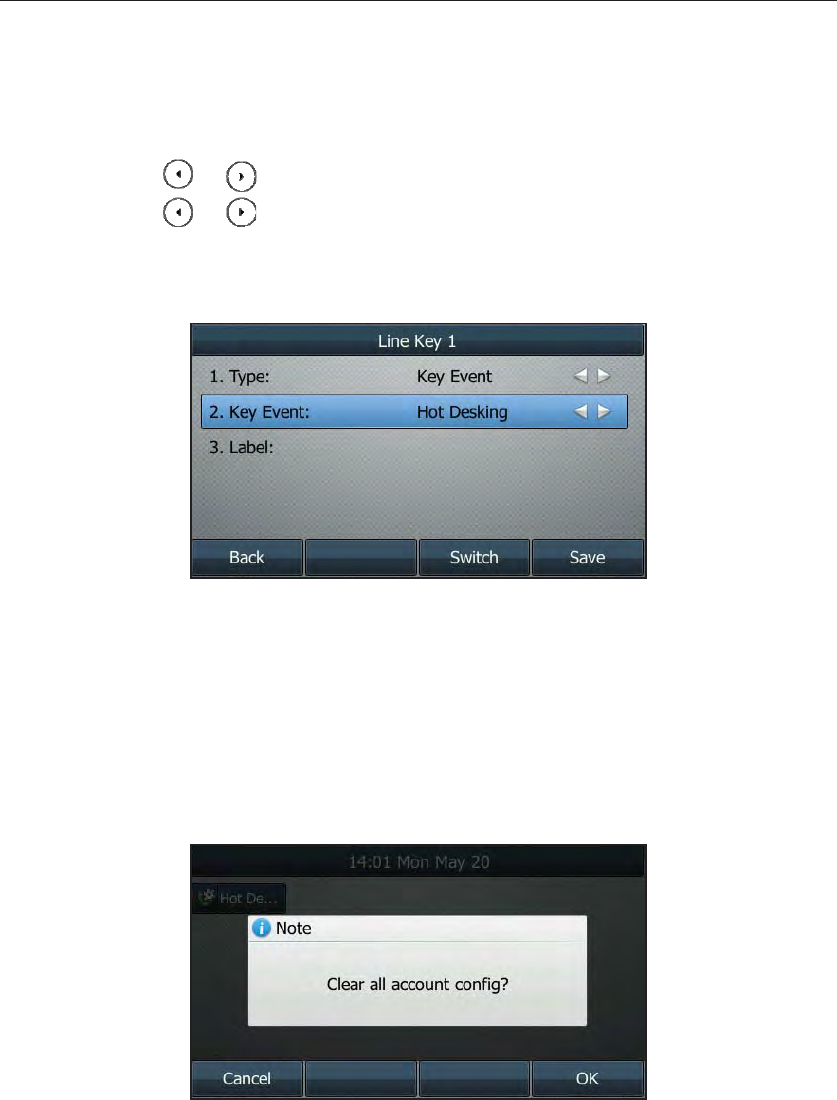
Advanced Phone Features
133
To configure a hot desking key via phone user interface:
1. Press Menu->Call Features->DSS Keys.
2. Select the desired DSS key.
3. Press or , or the Switch soft key to select Key Event from the Type field.
4. Press or , or the Switch soft key to select Hot Desking from the Key Event
field.
5. (Optional.) Enter a string that will appear on the LCD screen in the Label field.
6. Press the Save soft key to accept the change or the Back soft key to cancel.
Hot desking key is configurable via web user interface at the path DSSKey->Line Key.
To use hot desking:
1. Press the hot desking key when the phone is idle.
The LCD screen prompts the following warning:
2. Press the OK soft key, registration configurations of all accounts on the phone will
be cleared immediately.
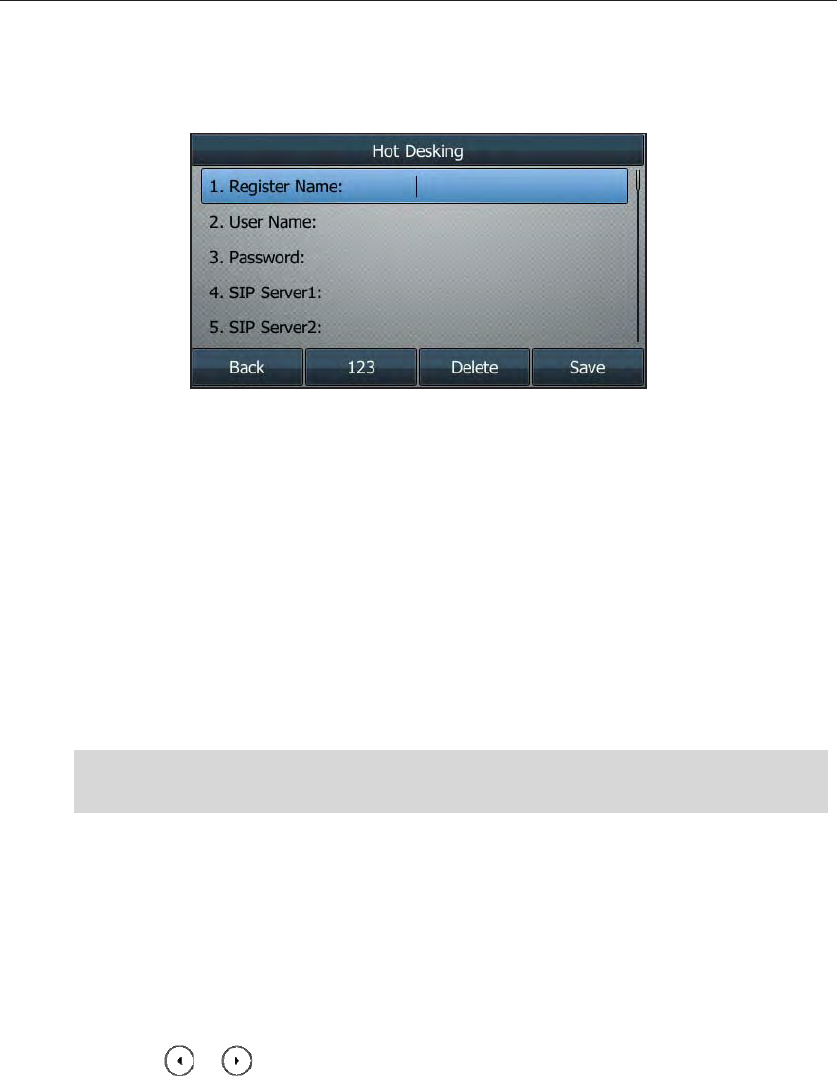
User Guide for the SIP-T48G IP Phone
134
The login wizard will be shown as below:
3. Enter the login information in each field.
4. Press the Save soft key to login or the Back soft key to cancel.
+PVGTEQO
Intercom is a useful feature in an office environment to quickly connect with the
operator or the secretary. You can press the intercom key to automatically connect
with a remote extension for outgoing intercom calls, and the remote extension will
automatically answer the incoming intercom calls.
Note
1WVIQKPI+PVGTEQO%CNNU
To configure an intercom key via phone user interface:
1. Press Menu->Call Features->DSS Keys.
2. Select the desired DSS key.
3. Press or , or the Switch soft key to select Intercom from the Type field.
4. Select the desired line from the Account ID field.
5. (Optional.) Enter the string that will appear on the LCD screen in the Label field.
Intercom is not available on all servers. Contact your system administrator for more
information.
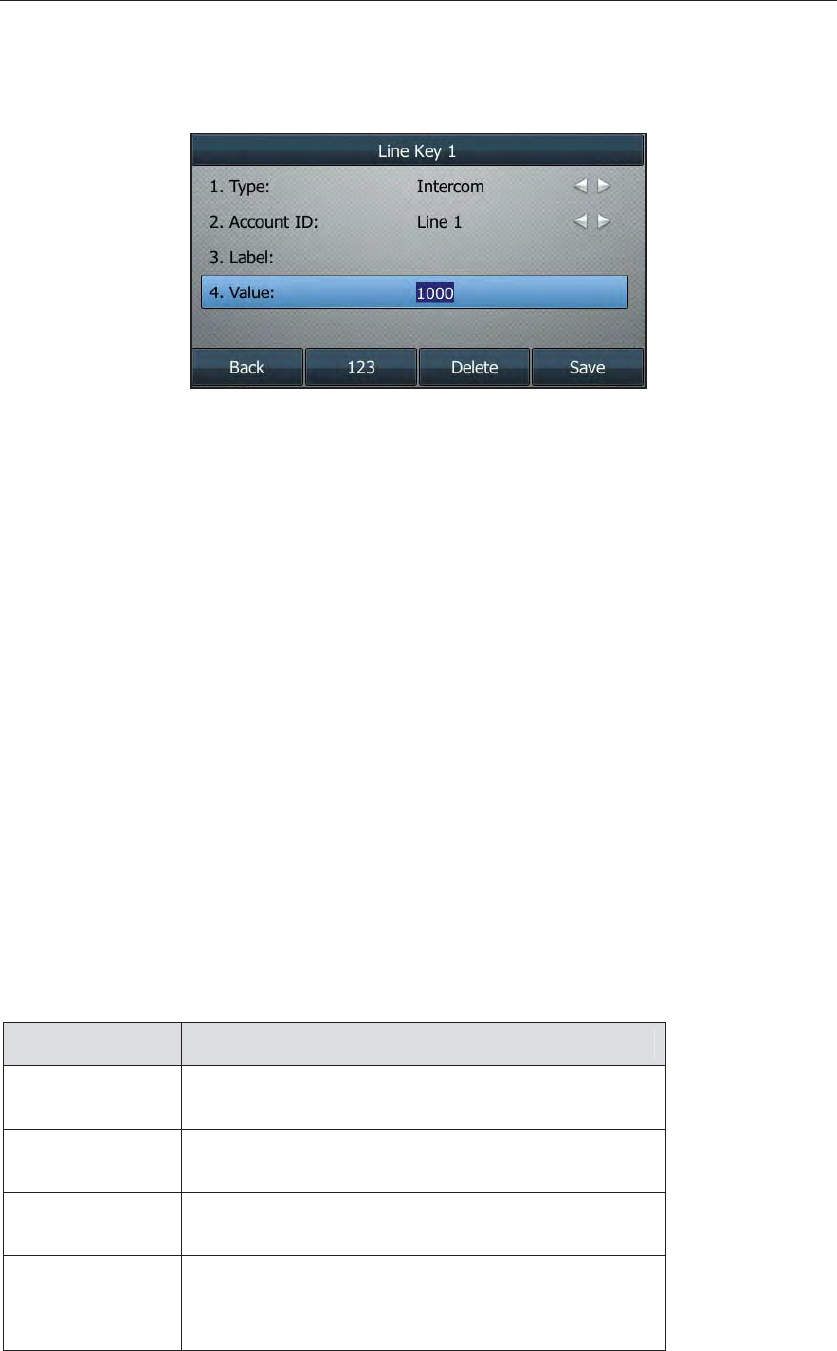
Advanced Phone Features
135
6. Enter the remote extension number in the Value field.
7. Press the Save soft key to accept the change or the Back soft key to cancel.
Intercom key is configurable via web user interface at the path DSSKey->Line Key.
To place an intercom call:
1. Press the intercom key when the phone is idle.
The phone is automatically connected to the extension specified in the Value field.
2. Press the intercom key again or the Cancel soft key to end the intercom call.
+PEQOKPI+PVGTEQO%CNNU
The SIP-T48G IP phone supports automatically to answer an incoming intercom call by
default. The phone automatically plays a warning tone when it receives an incoming
intercom call. In addition, you can enable the phone to mute the microphone when it
automatically answers an incoming intercom call. You can also enable the phone to
automatically answer an incoming intercom call while there is already an active call on
the phone. The active call is placed on hold.
Intercom features you need to know:
Intercom Feature Description
Accept Intercom Enable or disable the IP phone to automatically
answer an incoming intercom call.
Intercom Mute Enable or disable the microphone on the IP phone
for intercom calls.
Warning Tone Enable or disable the IP phone to play a warning
tone when it receives an incoming intercom call.
Intercom Barge
Enable or disable the IP phone to automatically
answer an incoming intercom call while there is
already an active call on the phone.
To configure intercom features via phone user interface:
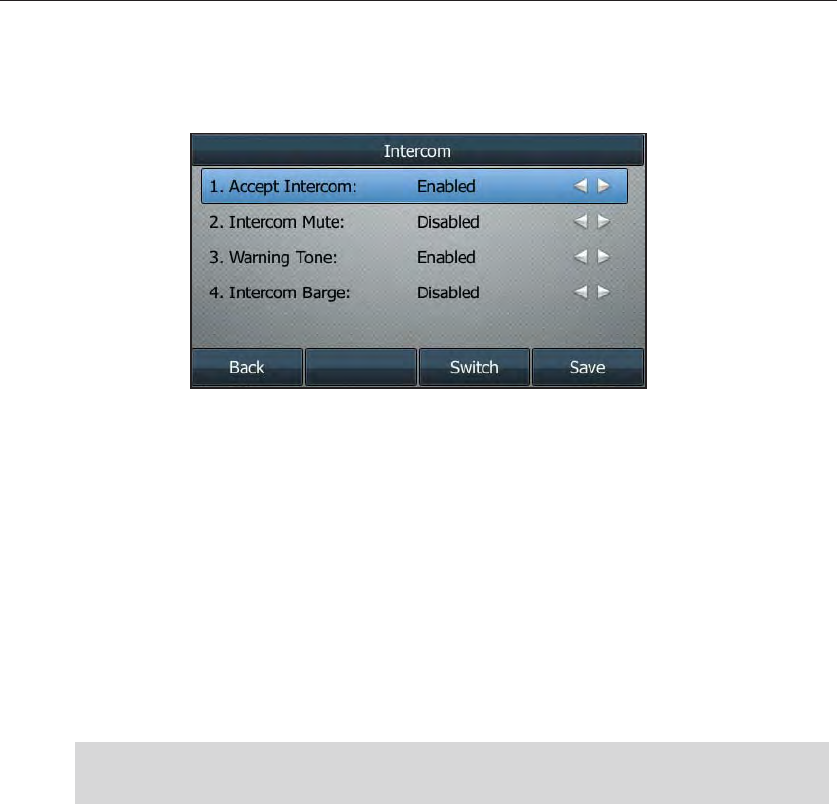
User Guide for the SIP-T48G IP Phone
136
1. Press Menu->Call Features->Intercom.
2. Make the desired changes.
3. Press the Save soft key to accept the change or the Back soft key to cancel.
These specific parameters are configurable via web user interface at the path
Features->Intercom.
Accept Intercom
You can enable or disable the phone to automatically answer an incoming intercom
call. If Accept Intercom is enabled, the phone automatically answers an incoming
intercom call. If Accept Intercom is disabled, the phone rejects incoming intercom calls
and sends a busy message to the caller. Accept Intercom is enabled by default.
Note
Intercom Mute
You can mute or un-mute the microphone on the phone for intercom calls
automatically. If Intercom Mute is enabled, the microphone is muted for intercom calls.
If Intercom Mute is disabled, the microphone works for intercom calls. Intercom Mute is
disabled by default.
Warning Tone
You can enable or disable the phone to play a warning tone when receiving an
intercom call. If Warning Tone is enabled, the phone plays a warning tone before
answering the intercom call. If Warning Tone is disabled, the phone automatically
answers the intercom call without warning. Warning Tone is enabled by default.
Intercom Barge
You can enable or disable the phone to automatically answer an incoming intercom
call while there is already an active call on the phone. If Intercom Barge is enabled, the
phone automatically answers the intercom call and places the active call on hold. If
Intercom Barge is disabled, the phone handles an incoming intercom call like a waiting
call. Intercom Barge is disabled by default.
Your administrator can set a period of delay time before the phone automatically
answers intercom calls. Contact your system administrator for more information.

Advanced Phone Features
137
/WNVKECUV2CIKPI
You can use multicast paging to quickly and easily forward time sensitive
announcements out to people within the multicast group. You can configure a
multicast paging key on the phone, which allows you to send a Real Time Transport
Protocol (RTP) stream to the pre-configured multicast address(es) without involving SIP
signaling. You can configure the phone to receive an RTP stream from pre-configured
multicast listening address(es) without involving SIP signaling. You can specify up to 10
multicast listening addresses.
5GPFKPI4625VTGCO
To configure a multicast paging key via phone user interface:
1. Press Menu->Call Features->DSS Keys.
2. Select the desired DSS key.
3. Press or , or the Switch soft key to select Key Event from the Type field.
4. Press or , or the Switch soft key to select Multicast Paging from the Key
Event field.
5. (Optional.) Enter the string that will appear on the LCD screen in the Label field.
6. Enter the multicast IP address and port number (e.g., 224.5.6.20:10008) in the Value
field.
The valid multicast IP addresses range from 224.0.0.0 to 239.255.255.255.
7. Press the Save soft key to accept the change or the Back soft key to cancel.
Multicast paging key is configurable via web user interface at the path DSSKey->Line
Key.
You can also configure the phone to use a default codec for sending multicast RTP
stream via web user interface.
To configure a default codec for multicast paging via web user interface:
1. Click on Features->General Information.
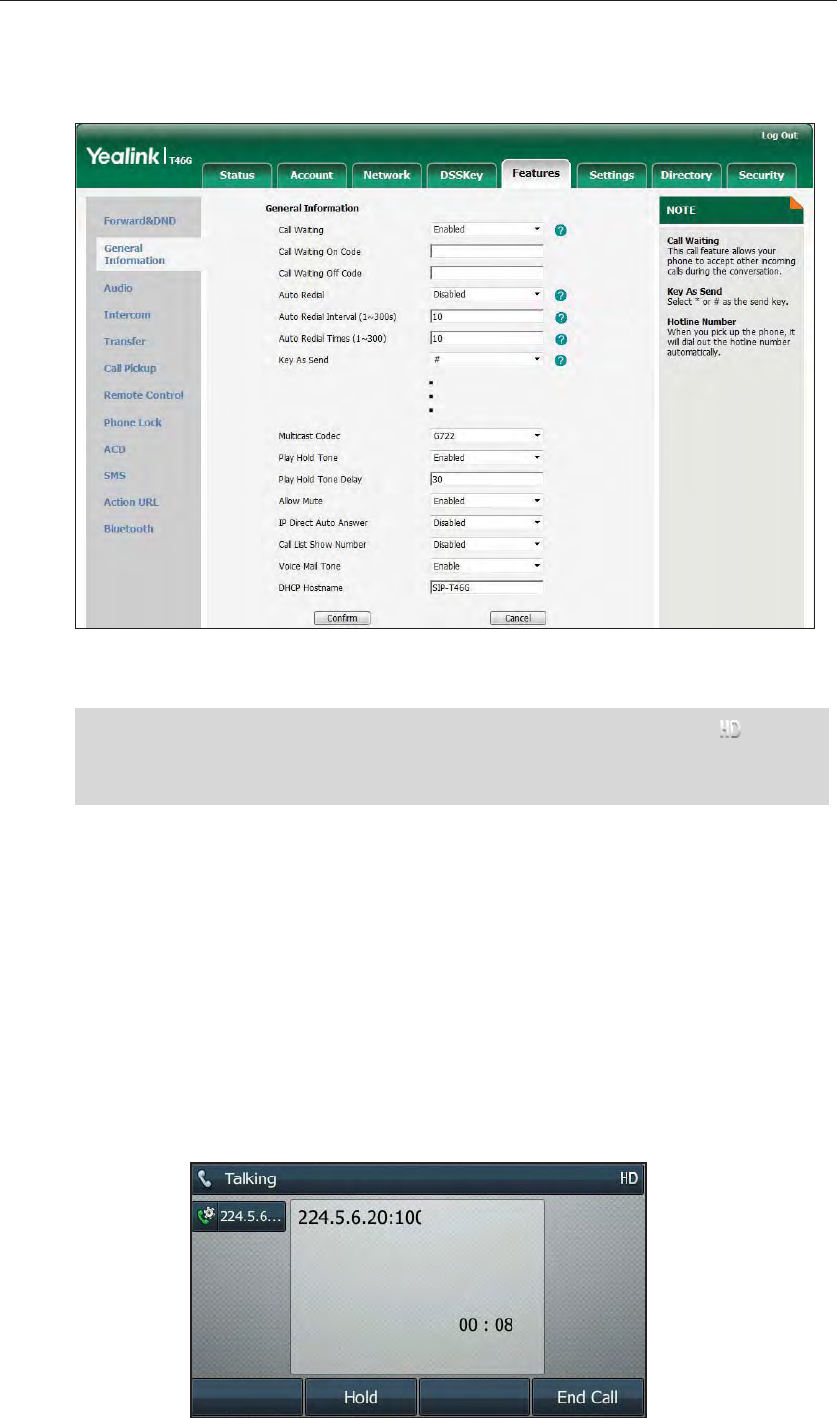
User Guide for the SIP-T48G IP Phone
138
2. Select the desired codec from the pull-down list of Multicast Codec.
The default codec is G722.
3. Click Confirm to accept the change.
Note
To send RTP stream:
1. Press the multicast paging key when the phone is idle.
The phone sends RTP to a preconfigured multicast address (IP: Port). Any phone in
the local network then listens to the RTP on the preconfigured multicast address (IP:
Port). For both sending and receiving of the multicast RTP, there is no SIP signaling
involved.
The multicast paging key LED illuminates solid green.
The following figure shows a multicast RTP session on the phone:
If G722 codec is used for multicast paging, the LCD screen displays the icon to
indicate that is providing high definition voice.
Default codec for multicast paging is configurable via web user interface only.

Advanced Phone Features
139
2. Press the Hold soft key to place the current multicast RTP session on hold.
3. Press the End Call soft key to cancel the multicast RTP session.
Note
4GEGKXKPI4625VTGCO
You can configure the phone to receive a Real Time Transport Protocol (RTP) stream
from the pre-configured multicast address(es) without involving SIP signaling. You can
specify up to 10 multicast addresses that the phone listens to on the network.
How the phone handles incoming multicast paging calls depends on Paging Barge
and Paging Priority Active parameters configured via web user interface.
Paging Barge
Paging barge parameter defines the priority of the voice call in progress. If the priority
of an incoming multicast paging call is lower than that of the active call, it will be
ignored automatically. If Disabled is selected from the pull-down list of Paging Barge,
the voice call in progress takes precedence over all incoming multicast paging calls.
Valid values in the Paging Barge field:
z1 to 10: Define the priority of the active call, 1 with the highest priority, 10 with the
lowest.
zDisabled: The voice call in progress shall take precedence over all incoming paging
calls.
Paging Priority Active
Paging priority active parameter decides how the phone handles incoming multicast
paging calls when there is already a multicast paging call on the phone. If enabled,
the phone will ignore incoming multicast paging calls with lower priorities, otherwise,
the phone will answer incoming multicast paging calls automatically and place the
previous multicast paging call on hold. If disabled, the phone will automatically ignore
all incoming multicast paging calls.
To configure multicast listening addresses via web user interface:
1. Click on Directory->Multicast IP.
2. Select the desired value from the pull-down list of Paging Barge.
3. Select the desired value from the pull-down list of Paging Priority Active.
4. Enter the multicast IP address(es) and port number (e.g., 224.5.6.20:10008) which
the phone listens for incoming RTP multicast in the Listening Address field.
Multicast RTP is one way only from sender to the multicast address(es) (receiver). For
outgoing RTP multicasts, all other existing calls on the phone will be placed on hold.
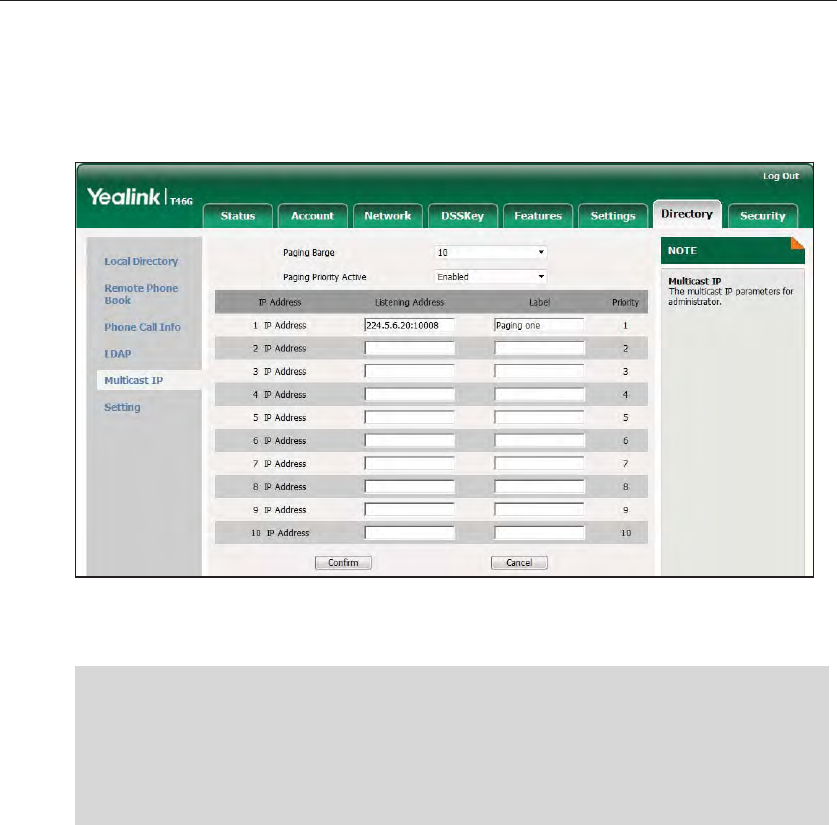
User Guide for the SIP-T48G IP Phone
140
5. Enter the label in the Label field. Label will appear on the LCD screen when
receiving the multicast RTP stream.
6. Click Confirm to accept the change.
Note
/WUKEQP*QNF
Music on hold (MoH) is the business practice of playing recorded music to fill the silence
that would be heard by the party placed on hold. To use this feature, you should
specify a SIP URI pointing to a Music on Hold Server account. When a call is placed on
hold, the phone will send a SIP INVITE message to the Music on Hold Server account.
The Music on Hold Server account automatically answers to the SIP INVITE messages
and immediately plays audio from some source located anywhere (LAN, Internet) to
the held party. Contact your system administrator for the SIP URI.
To configure music on hold server via web user interface:
1. Click on Account.
2. Select the desired account from the pull-down list of Account.
3. Click on Advanced.
The priorities of listening addresses are predefined: 1 with the highest priority, 10 with the
lowest.
Both the multicast paging sender and the receiver play a warning tone when
establishing a multicast paging call.
Multicast listening addresses are configurable via web user interface only.
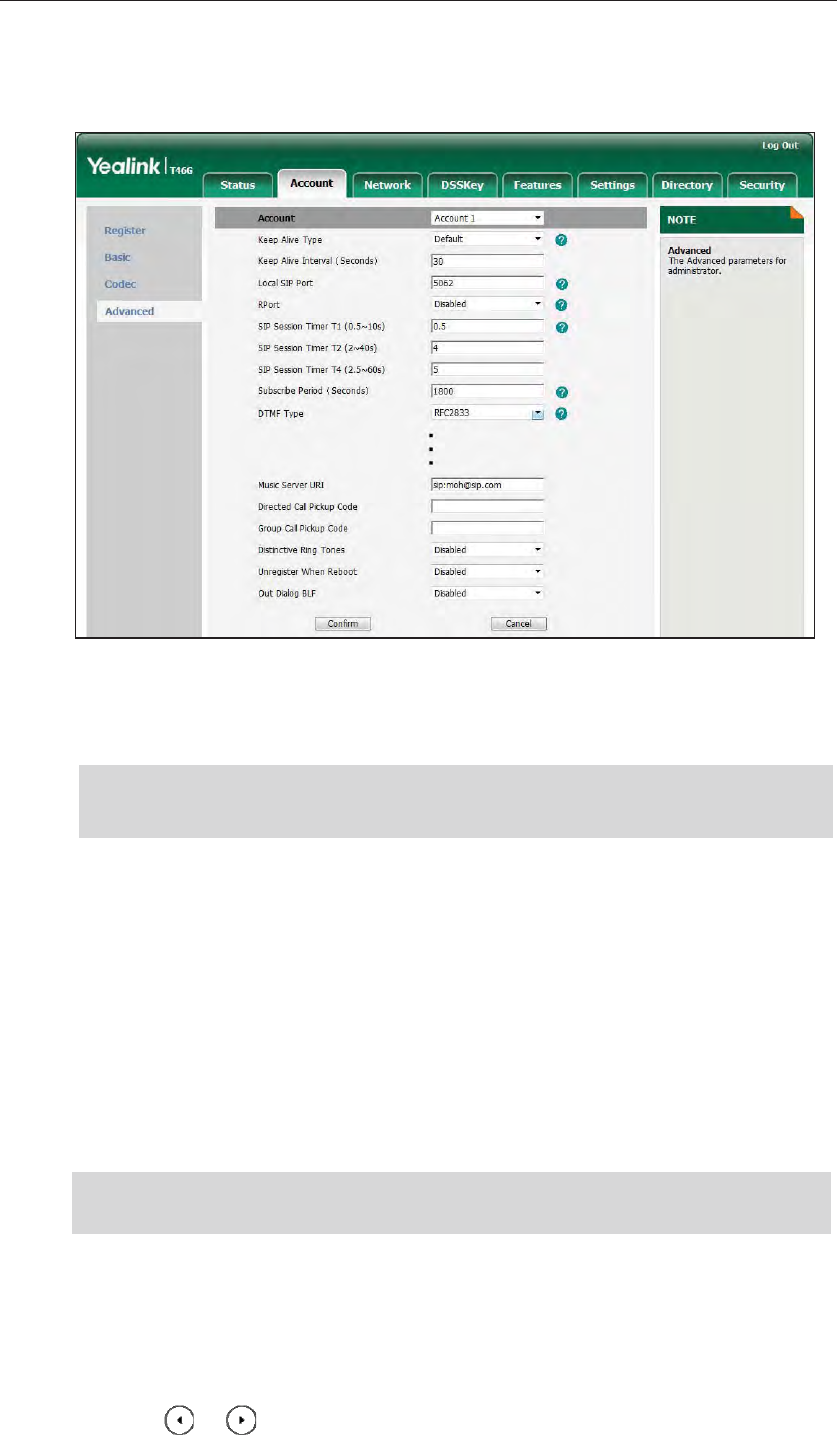
Advanced Phone Features
141
4. Enter the SIP URI (e.g., sip:moh@sip.com) in the Music Server URI field.
5. Click Confirm to accept the change.
When you have placed a call on hold, the held party can hear the music.
Note
#WVQOCVKE%CNN&KUVTKDWVKQP#%&
ACD is often used in offices for customer service, such as call center. The ACD system
handles large volumes of incoming calls from callers who have no need to talk to a
specific person but who require assistance from any of multiple persons at the earliest
opportunity. ACD on the SIP-T48G IP phone allows the ACD system to distribute large
volumes of incoming calls to the registered ACD users. To use this feature, you should
configure an ACD key in advance.
Note
To configure an ACD key via phone user interface:
1. Press Menu->Call Features->DSS Keys.
2. Select the desired DSS key.
3. Press or , or the Switch soft key to select ACD from the Type field.
All involved parties cannot use encrypted RTP (SRTP).
Music on hold server is configurable via web user interface only.
Make sure ACD is enabled on your IP phone. For more information on enabling ACD,
contact your system administrator.

User Guide for the SIP-T48G IP Phone
142
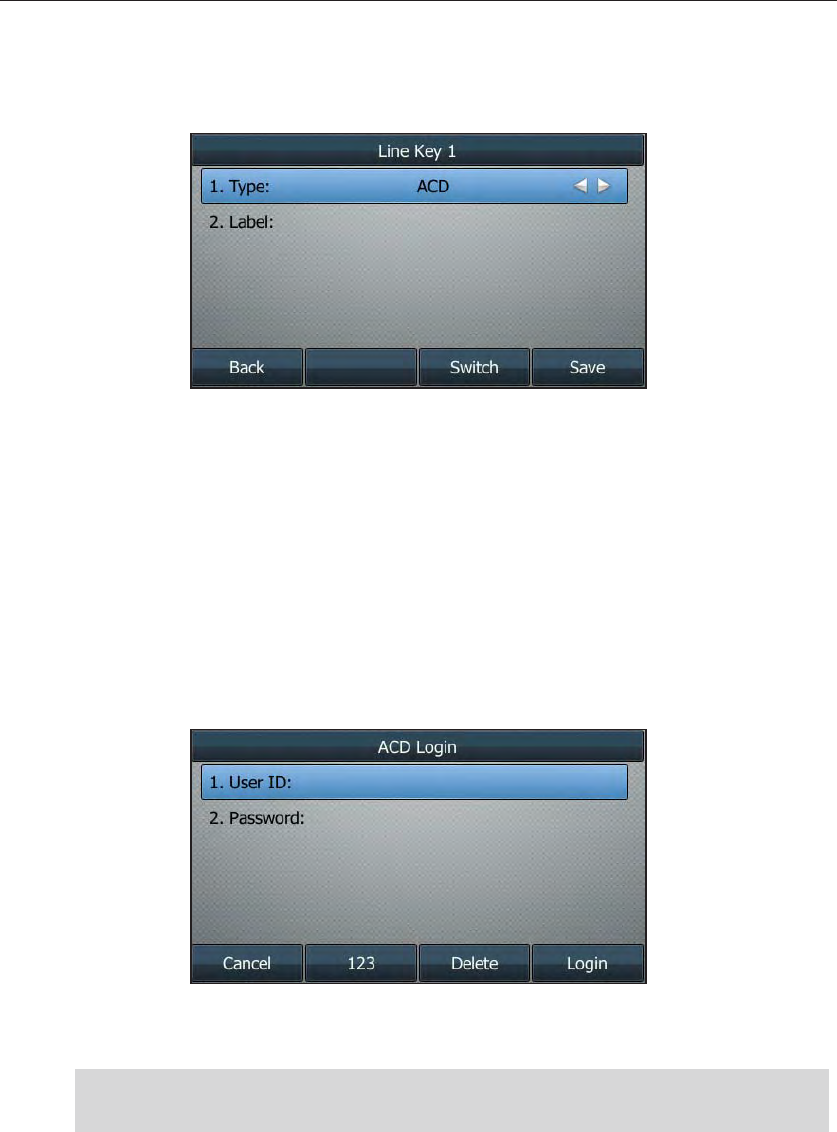
Advanced Phone Features
143
4. (Optional.) Enter the string that will appear on the LCD screen in the Label field.
5. Press the Save soft key to accept the change or the Back soft key to cancel.
ACD key is configurable via web user interface at the path DSSKey->Line Key.
To log into the ACD system:
1. Press the ACD key when the phone is idle.
The LCD screen prompts you the following information:
User ID: the identity used to log into the queue.
Password: the password used to log into the queue.
2. Press the Login soft key to log into.
Note
After configuring an ACD key, you can press the ACD key to log into the ACD system.
After logging in, you are ready to receive calls from the ACD system. You can press the
ACD key to show your current ACD user status. You can press the
Available/Unavailable soft key to change your ACD user status. ACD user status
synchronizes on both IP phone and ACD system.
When you set the ACD user status to be available, the ACD key LED illuminates solid
green, and then the server begins distributing calls to your phone.
Contact your system administrator for the User ID and Password to access the ACD
system.
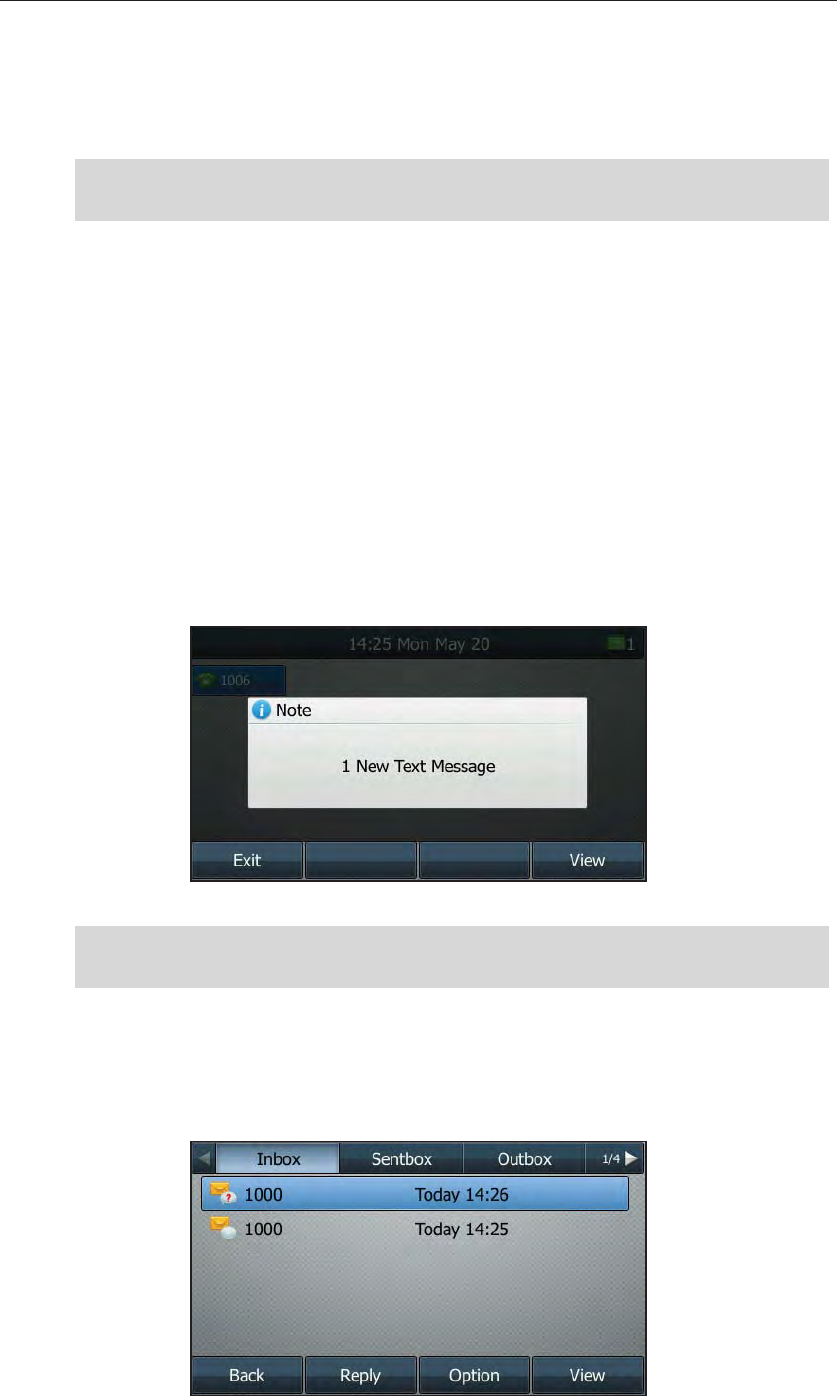
User Guide for the SIP-T48G IP Phone
144
When you set the ACD user status to be unavailable, the ACD key LED flashes green,
and then the server temporarily stops distributing calls to your phone. To log out of the
ACD system, press the Logout soft key.
Note
/GUUCIGU
5JQTV/GUUCIG5GTXKEG5/5
You can send and receive text messages using the SIP-T48G IP phone. New text
messages can be indicated both acoustically and visually. When receiving a new text
message, the phone will play a warning tone. The power indicator LED will slow flash red,
and the LCD screen will prompt receiving new text messages with the number of
waiting messages (e.g., 1 New Text Message) and an icon.
Note
To read a text message:
1. Press Menu->Messages->Text Message->Inbox.
SMS is not available on all servers. Contact your system administrator for more
information.
It is recommended you configure no more than one ACD key per phone. At any time, at
most one ACD key can be in progress on your phone.

Advanced Phone Features
145
2. Select the desired message and press the View soft key.
Note
To send a text message:
1. Press Menu->Messages->Text Message->New Message.
2. Compose the new text message. You can press the abc soft key to change the
input mode.
3. Press the Send soft key.
4. (Optional.) Press or , or the Switch soft key to select the desired account
from the From field.
5. Enter the number you want to send the message to in the To field.
6. Press the Send soft key to send the message or the Back soft key to cancel.
Sending a text message is configurable via web user interface at the path
Features->SMS.
To reply a text message:
1. Press Menu->Messages->Text Message->Inbox.
2. Select the desired message and press the Reply soft key.
3. Compose the new text message. You can press the abc soft key to change the
input mode.
4. Press the Send soft key after completing the content.
To delete a text message:
1. Press Menu->Messages->Text Message->Inbox (Sent Box, Outbox or Draftbox).
If the phone prompts receiving new text messages, you can also press the View soft key
to read the new messages directly.
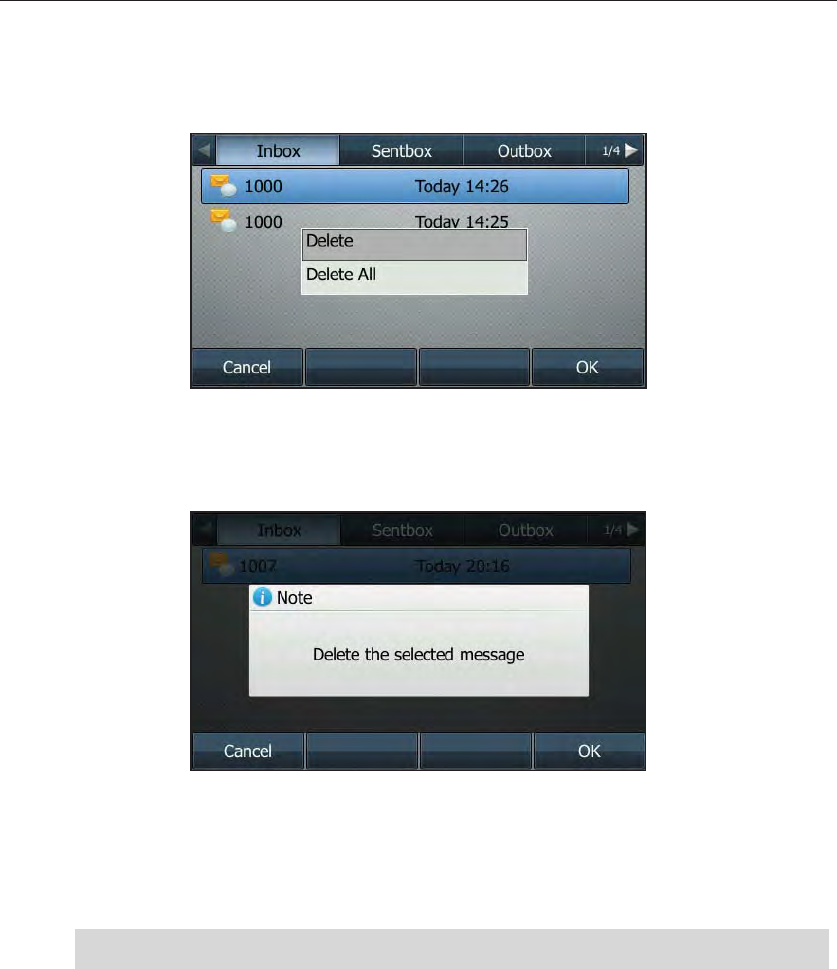
User Guide for the SIP-T48G IP Phone
146
2. Select the desired message and then press the Option soft key.
3. Select Delete to delete the desired message.
The LCD screen prompts "Delete the selected message".
4. Press the OK soft key to delete this message or the Cancel soft key to cancel.
You can also delete all text messages by pressing the Option soft key and then select
Delete All. For more information, refer to the above steps.
Note You can also delete a specific message after retrieving by pressing the Delete soft key.
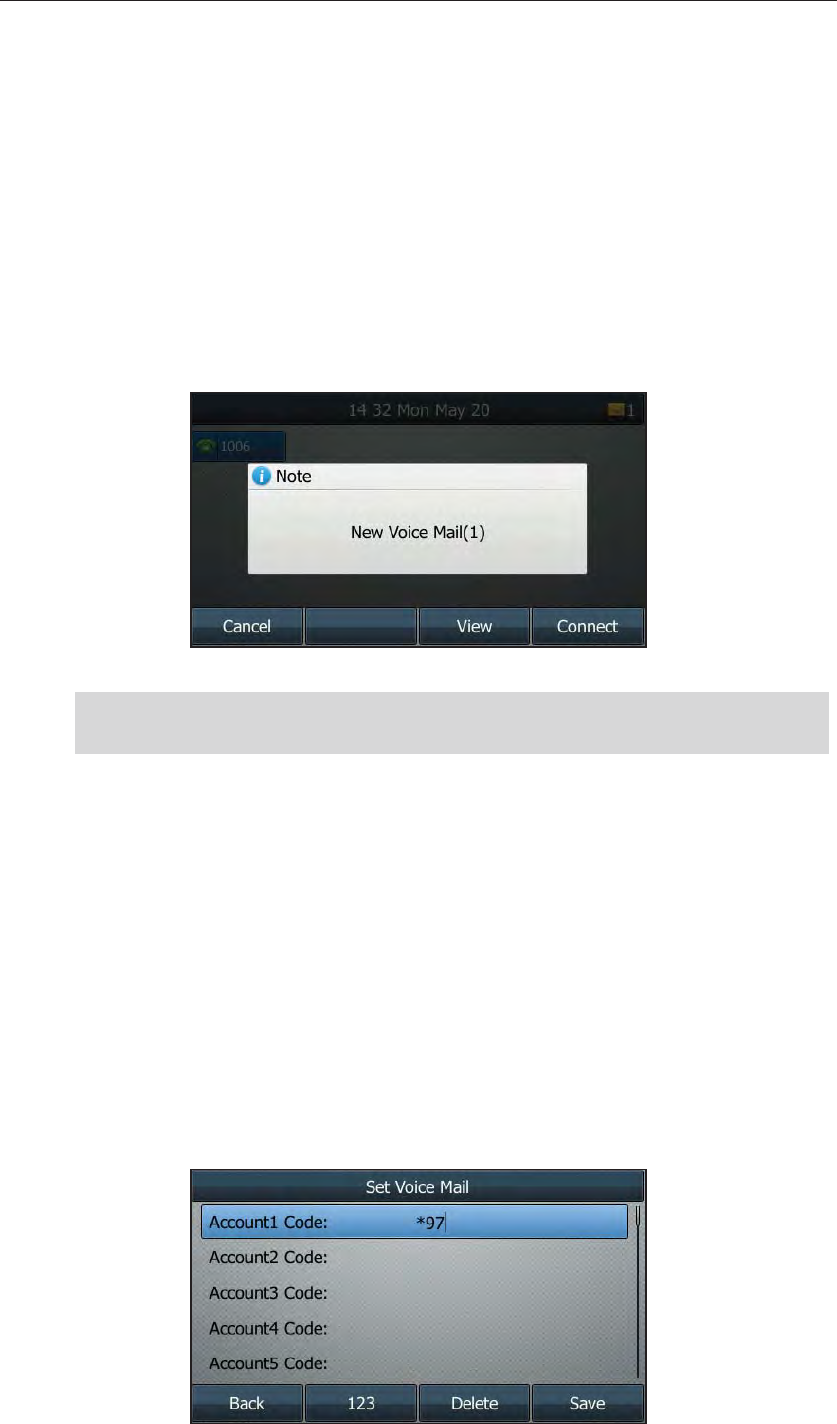
Advanced Phone Features
147
8QKEG/CKN
You can leave voice mails for someone else on the SIP-T48G IP phone. You can also
listen to the voice mails stored in a centralized location. When receiving a new voice
mail, the phone will play a warning tone, and the power indicator LED will slow flash red.
The LCD screen will prompt receiving a new voice mail with the number of waiting
voice mails (e.g., New Voice Mail(1)) and an icon.
Note
To leave a voice mail:
You can leave a voice mail for someone else when he/she is busy or inconvenient to
answer the call. Follow the voice prompt from the system server to leave a voice mail,
and then hang up.
To configure voice mail access codes via phone user interface:
1. Press Menu->Messages->Voice Mail->Set Voice Mail.
2. Press the navigation keys to highlight the account which you want to set.
3. Press the 123 soft key to select the proper input mode and then enter the voice mail
access code (e.g., *97).
Voice Mail is not available on all servers. Contact your system administrator for more
information.

User Guide for the SIP-T48G IP Phone
148
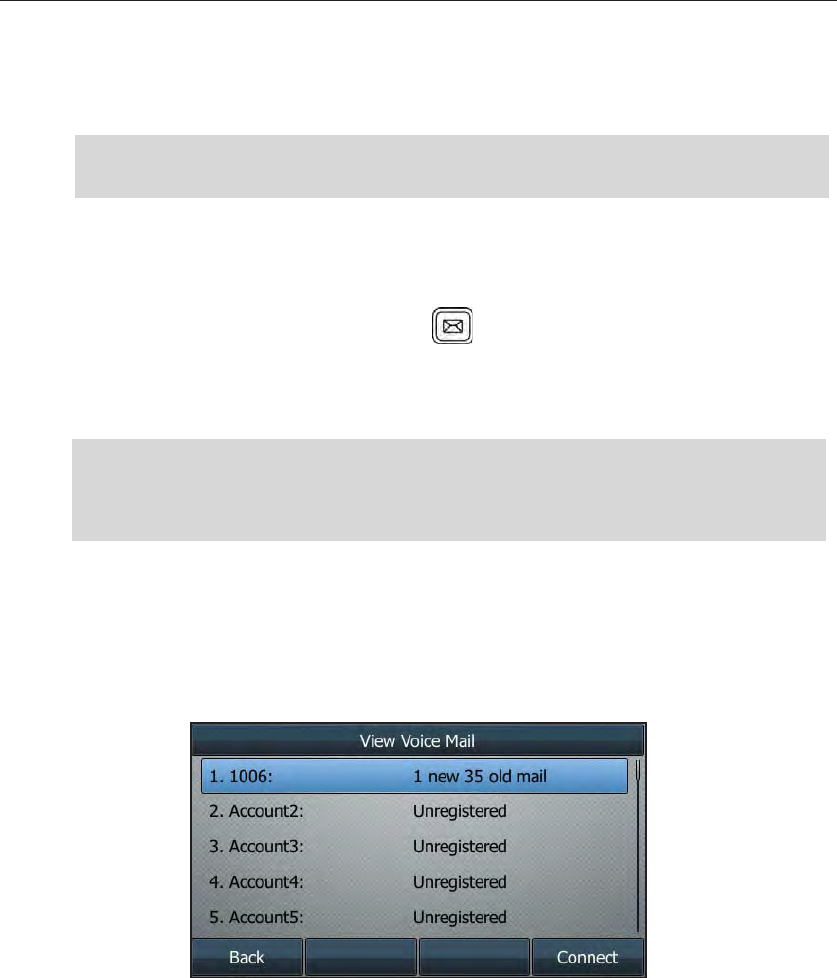
Advanced Phone Features
149
4. Press the Save soft key to accept the change or the Back soft key to cancel.
Note
To listen to the voice mails:
1. When the phone user interface prompts receiving new voice mails and the power
indicator LED slow flashes red, press or the Connect soft key to dial out the
voice mail access code.
2. Follow the voice prompt to listen to voice mails.
Note
To view the voice mail via phone user interface:
1. Press Menu->Messages->Voice Mail->View Voice Mail.
The LCD screen displays the amount of new and old voice mails
2. Select an account and then press the Connect soft key to listen to voice mails.
/GUUCIG9CKVKPI+PFKECVQT/9+
The SIP-T48G IP phone supports MWI when receiving a new voice message. If someone
leaves you a voice mail, you will receive a message waiting indicator. MWI will be
indicated in three ways: a warning tone, an indicator message (including a voice mail
icon) on the LCD screen, and the power indicator LED slow flashes red. This will be
cleared when you retrieve all voice mails or delete them.
Voice mail access code must be predefined on the system server. Contact your system
administrator for the more information.
Before listening to voice mails, make sure the voice mail access code has been
configured.
When all new voice mails are retrieved, the power indicator LED will go out.

User Guide for the SIP-T48G IP Phone
150
The MWI service is unsolicited for some servers, so the SIP-T48G IP phone only handles
the MWI messages sent from the server. But for other servers, the MWI service is solicited,
so the SIP-T48G IP phone must enable subscription for MWI.
Note
The MWI subscription parameters you need to know:
Options Description
Subscribe for MWI Enable or disable a subscription for MWI service.
MWI Subscription Period
Period of MWI subscription. The IP phone sends a
refresh SUBSCRIBE request before initial SUBSCRIBE
expiration.
Subscribe MWI to VM
Enable or disable a subscription to the voice mail
number for MWI service.
To use this feature, you should also configure the
voice mail number.
Note
To configure subscribe for MWI via web user interface
1. Click on Account.
2. Select the desired account from the pull-down list of Account.
3. Click on Advanced.
4. Select Enabled from the pull-down list of Subscribe for MWI.
MWI service is not available on all servers. Contact your system administrator for more
information.
Whether the phone sends SUBSCRIBE messages for MWI service to the account or the
voice number MWI service depends on the server. Contact your system administrator for
more information.
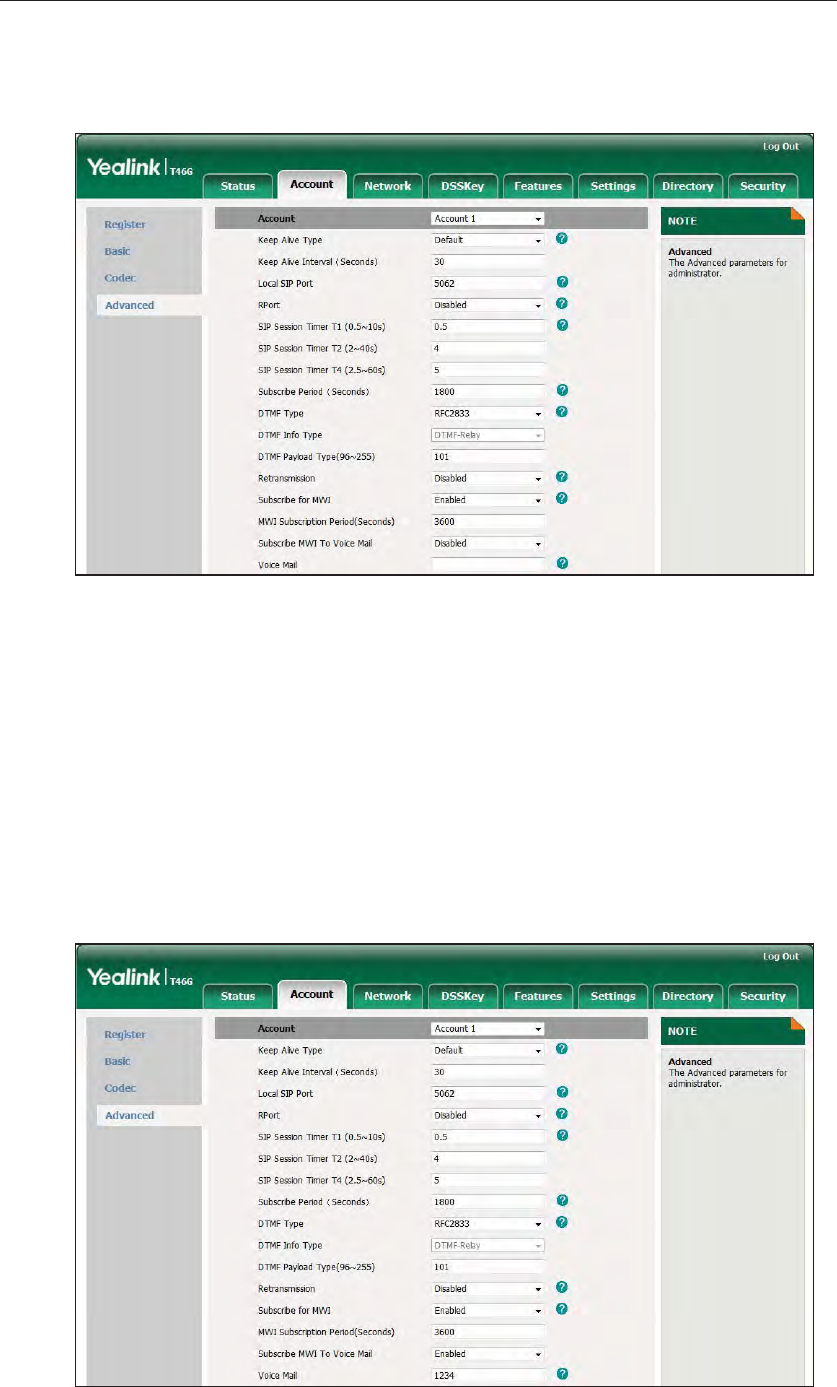
Advanced Phone Features
151
5. Enter the period time in the MWI Subscription Period (Seconds) field.
6. Click Confirm to accept the change.
The IP phone will subscribe to the account number for MWI service by default.
To enable Subscribe MWI to Voice Mail via web user interface:
1. Click on Account.
2. Select the desired account from the pull-down list of Account.
3. Click on Advanced.
4. Select Enabled from the pull-down list of Subscribe MWI To Voice Mail.
5. Enter the desired voice mail number in the Voice Mail field.

User Guide for the SIP-T48G IP Phone
152
6. Click Confirm to accept the change.
The IP phone will subscribe to the voice mail number for MWI service using Subscribe
MWI to Voice Mail.
Note
MWI subscription is configurable via web user interface only.

Troubleshooting
153
6TQWDNGUJQQVKPI
This chapter provides general troubleshooting information to help you solve the
problems you might encounter when using your SIP-T48G IP phone.
If you require additional information or assistance with your new phone, contact your
system administrator.
Why is the LCD screen blank?
zEnsure that the phone is properly plugged into a functional AC outlet.
zEnsure that the phone is plugged into a socket controlled by a switch that is on.
zIf the phone is plugged into a power strip, try to plug it directly into a wall outlet
instead.
zIf the phone is powered from PoE, ensure you use a PoE-compliant switch or hub.
Why does the phone display "Cable Disconnected"?
zEnsure that the Ethernet cable is plugged into the Internet port on the phone and the
Ethernet cable is not loose.
zEnsure that the switch or hub in your network is operational.
Why doesn’t the phone display time and date correctly?
Check if you have configured the phone to obtain the time and date from the SNTP
server automatically. If the phone fails to connect the SNTP server, you need to
configure the time and date manually.
How do I find the basic information of the IP phone?
Press the OK key when the IP phone is idle to check the basic information of the IP
phone, such as IP address and firmware version. For more basic information, refer to
Phone Status on page 19.
How to obtain the MAC address of a phone when the phone is not powered on?
Three ways to obtain the MAC address of a phone:
zYou can ask your supplier for shipping information sheet which includes MAC
addresses according to the corresponding PO (Purchase Order).
zYou can find the MAC address in the label of carton box.
zYou can also find the MAC address from the phone’s bar code on the back of the
phone.

User Guide for the SIP-T48G IP Phone
154
Why can’t I get a dial tone?
zCheck for any loose connections and that the phone has been installed properly. For
the installation instructions, refer to Phone Installation on page 16.
zSwitch between the Handset, Headset (if present) or Hands-Free Speakerphone to
check whether the dial tone is present for one of the audio modes.
If the dial tone exists on another audio mode, connect a different handset or
headset to isolate the problem.
Why doesn’t the phone ring?
Check the ringer volume on the phone. To adjust the ringer volume setting, press the
Volume key when the phone is on-hook and idle. For more information, refer to Volume
on page 36.
Why can’t I receive calls?
zCheck the SIP registration with your system administrator.
zCheck that DND (Do Not Disturb) mode is deactivated on your phone. Refer to Do Not
Disturb (DND) on page 101.
zCheck that call forward is disabled on the phone. Refer to Call Forward on page 105.
zCheck whether the caller number is stored in the blacklist directory. Refer to Blacklist
on page v.
Why is my handset not working?
Check that the handset cord is fully connected to both the handset jack on the phone
and handset. Refer to Phone Installation on page 16.
Why is my headset not working?
zCheck that the headset cord is fully connected to the headset jack on the phone.
Refer to Phone Installation on page 16.
zCheck that the headset mode is activated. Refer to Headset Use on page 59.
zCheck that the headset volume is adjusted to an appropriate level. Refer to Volume
on page 36.
What is the difference between user name, register name and display name?
Both user name and register name are defined by the server. A user name is used to
identify the account while a register name matched with a password is used for
authentication if the server requires. Display name is the caller ID that will be displayed
on the callee’s LCD screen. Server configuration may override the local configuration.
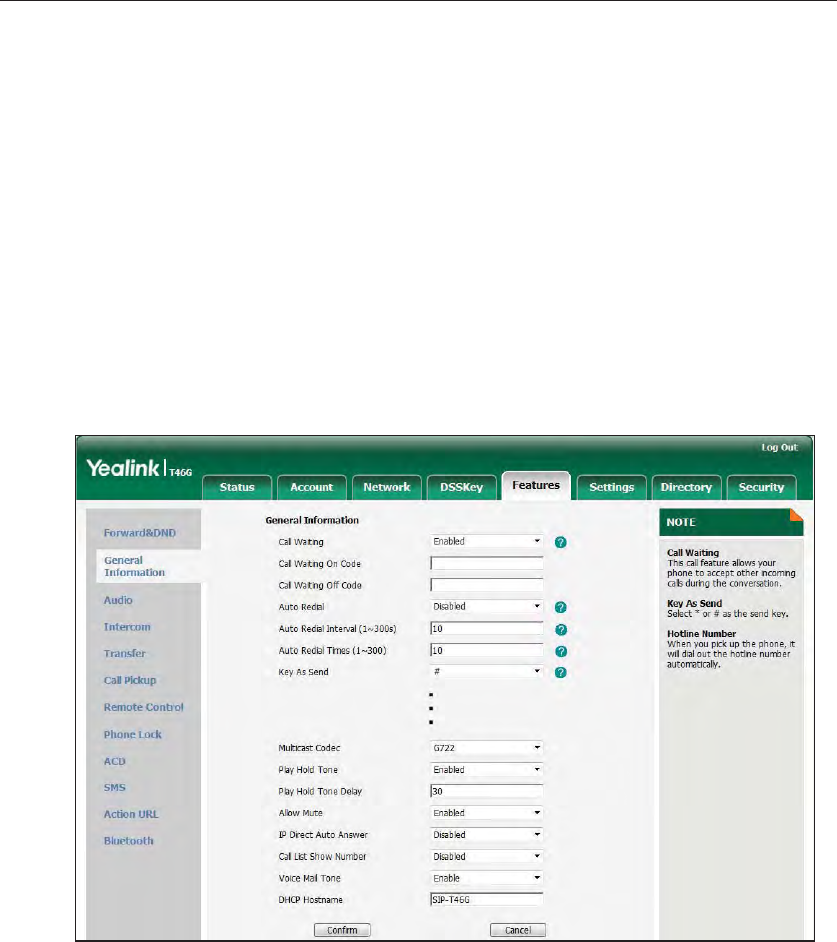
Troubleshooting
155
Why does the phone play a tone when there is a call on hold? How to disable it?
When there is a call on hold, the phone will play a hold tone every 30 seconds. Call hold
tone is enabled by default. Call hold tone and the interval of playing a hold tone are
configurable via web user interface only.
To configure call hold tone and call hold tone delay via web user interface:
1. Click on Features->General Information.
2. Select Enabled or Disabled from the pull-down list of Play Hold Tone.
3. Enter the desired time in the Play Hold Tone Delay field.
4. Click Confirm to accept the change.
Why does the wallpaper has bad display
˛
Do one of the following:
zCheck that the custom image is clear.
zCheck that the file format of the custom image for the wallpaper is .jpg, .png or .bmp.
zCheck that the custom image is not too large or small. The phone will adjust the image
with the short side to display.
zCheck that the picture resolution of the wallpaper. The wallpaper resolution of T48G IP
phone is 480*272 pixels.
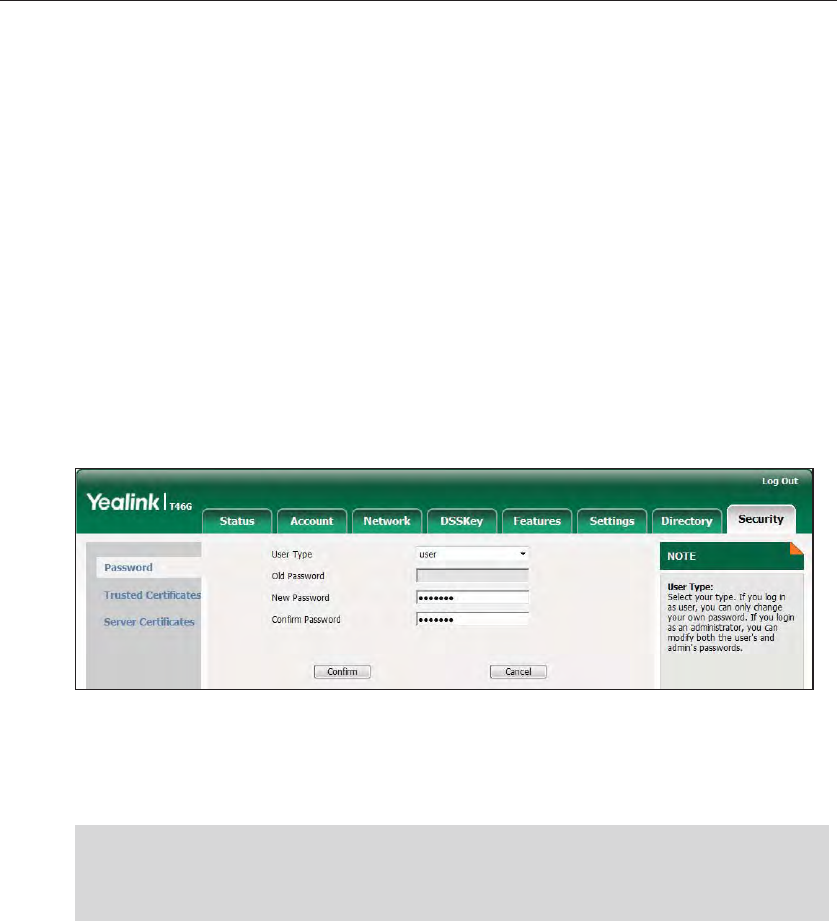
User Guide for the SIP-T48G IP Phone
156
Why I can’t send an SMS to any other phone?
SMS depends on support from a SIP server. Contact your system administrator for more
information.
How to change the user password?
To change the user password via web user interface:
1. Click on Security->Password.
2. Select user from the pull-down list of User Type.
3. Enter the new user password in the New Password field and Confirm Password field.
4. Click Confirm to accept the change.
You can also contact your system administrator for help.
Note
How to make a call using SRTP?
You can enable SRTP to encrypt the audio stream(s) of phone calls. The parties
participating in the call should enable SRTP on a per-line basis.
To enable SRTP on a per-line basis via web user interface:
1. Click on Account.
2. Select the desired account from the pull-down list of Account.
3. Click on Advanced.
If logging into the web user interface of the phone with the user credential, you need to
enter the current user password in the Old Password field.
User password is configurable via web user interface only.
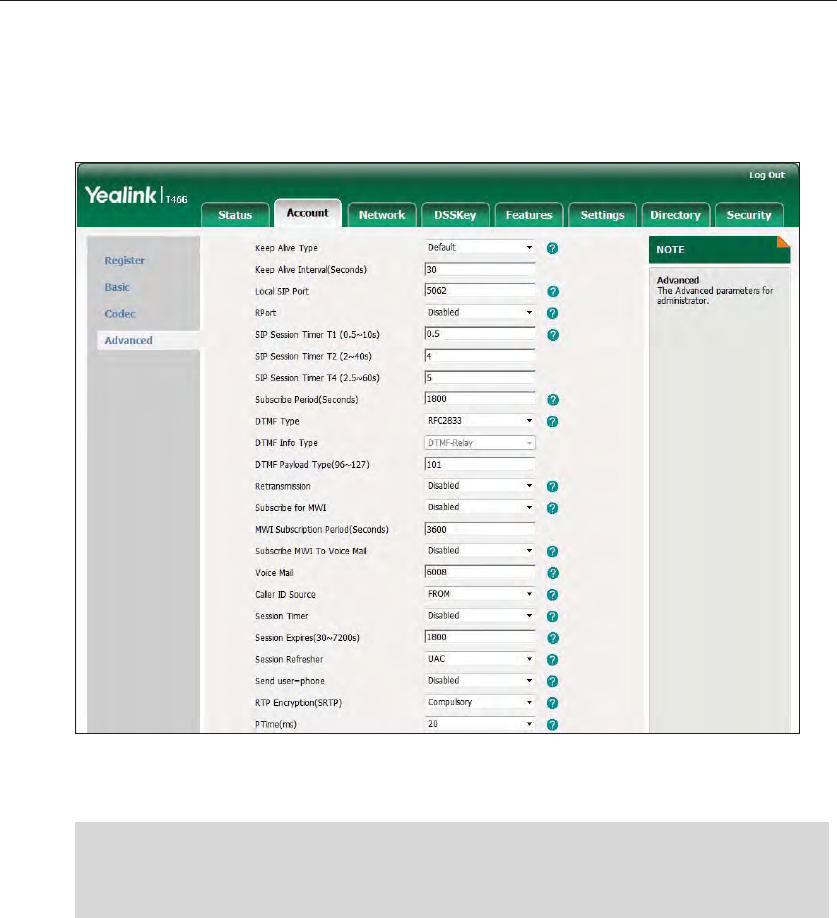
Troubleshooting
157
4. Select the desired value (Optional or Compulsory) from the pull-down list of RTP
Encryption (SRTP).
5. Click Confirm to accept the change.
Note
How to reboot the phone?
To reboot the phone via web user interface:
1. Click on Settings->Upgrade.
2. Click Reboot to reboot the IP phone.
SRTP is not available on all servers. Contact your system administrator for more
information.
SRTP is configurable via web user interface only.
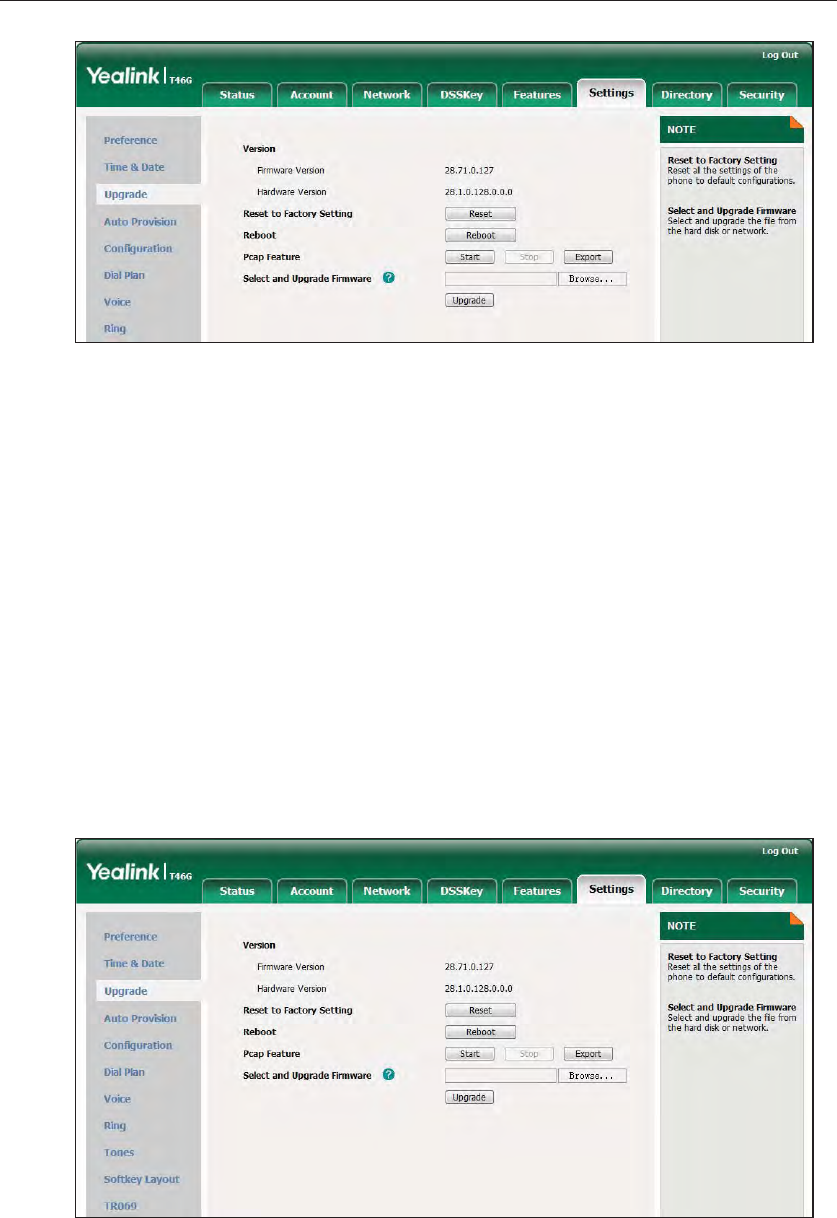
User Guide for the SIP-T48G IP Phone
158
You can also long press the X key to reboot the phone directly. Any reboot of the
phone may take a few minutes.
How to export PCAP trace?
We may need you to provide a PCAP trace to help analyze your problem.
To export a PCAP trace via web user interface:
1. Click on Settings->Upgrade.
2. Click Start to begin capturing signal traffic.
3. Recreate the error to be documented in the trace.
4. Click Stop to stop the capture.
5. Click Export to open file download window, and then save the file to your local
system.
How to export system log?
We may need you to provide a system log to help analyze your problem.
To export the system log to local PC via web user interface:
1. Click on Settings->Configuration.

Troubleshooting
159
2. Select 6 from the pull-down list of System Log Level.
3. Click Confirm to accept the change.
The web user interface prompts “Do you want to restart your machine?”. The
configuration will take effect after reboot.
4. Click OK to reboot the phone.
After the IP phone finishes reboot, the system log level is set as 6, the debug level.
5. Mark the Local radio box in the Export System Log field.
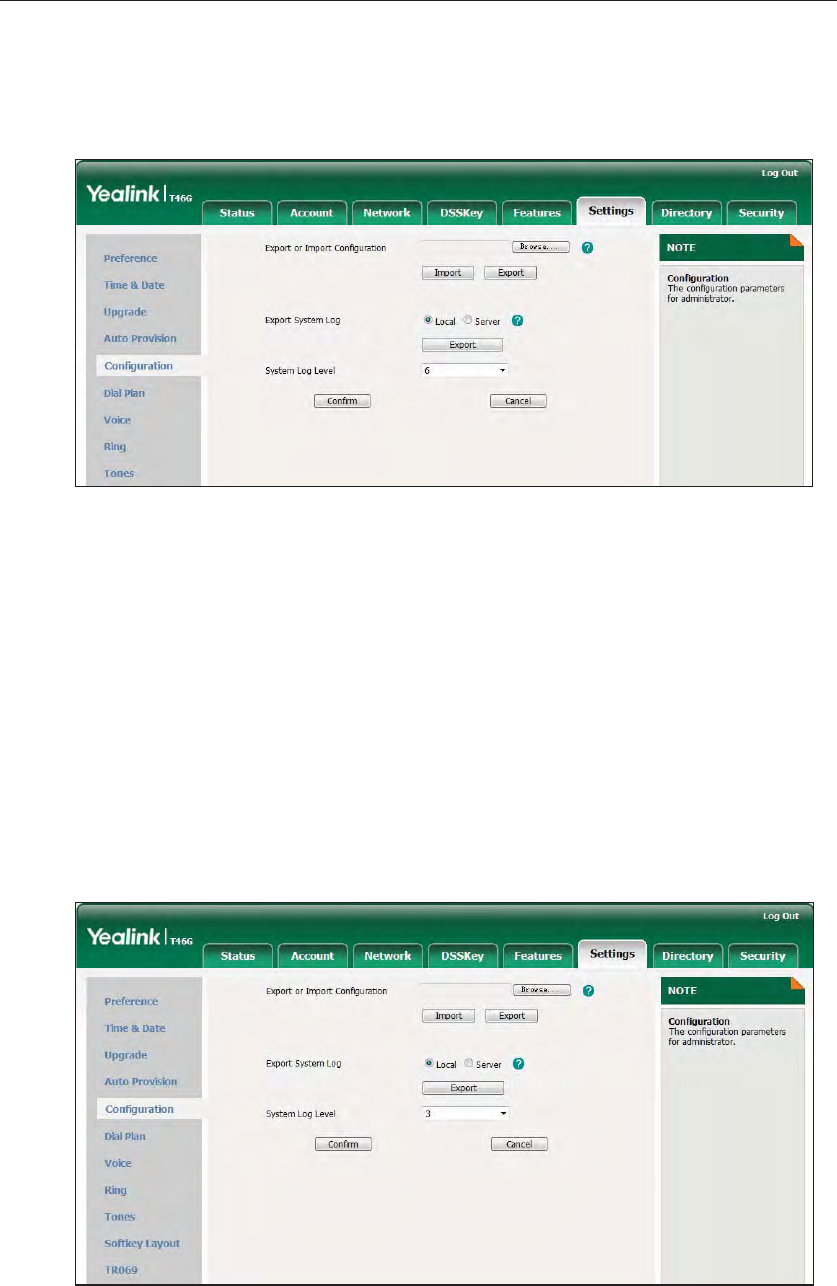
User Guide for the SIP-T48G IP Phone
160
6. Click Export to open file download window, and then save the file to your
local system.
You can also export the system log to a syslog server, contact your system administrator
for more information.
How to export/import the phone configurations?
We may need you to provide the phone configurations to help analyze problem. In
some instance, you may need to import configurations to your phone.
To export the phone configurations via web user interface:
1. Click on Settings->Configuration.
2. Click Export to open file download window, and then save the file to your local
system.
To import the phone configurations via web user interface:
1. Click on Settings->Configuration.
2. Click Browse to locate a configuration file from your local system.
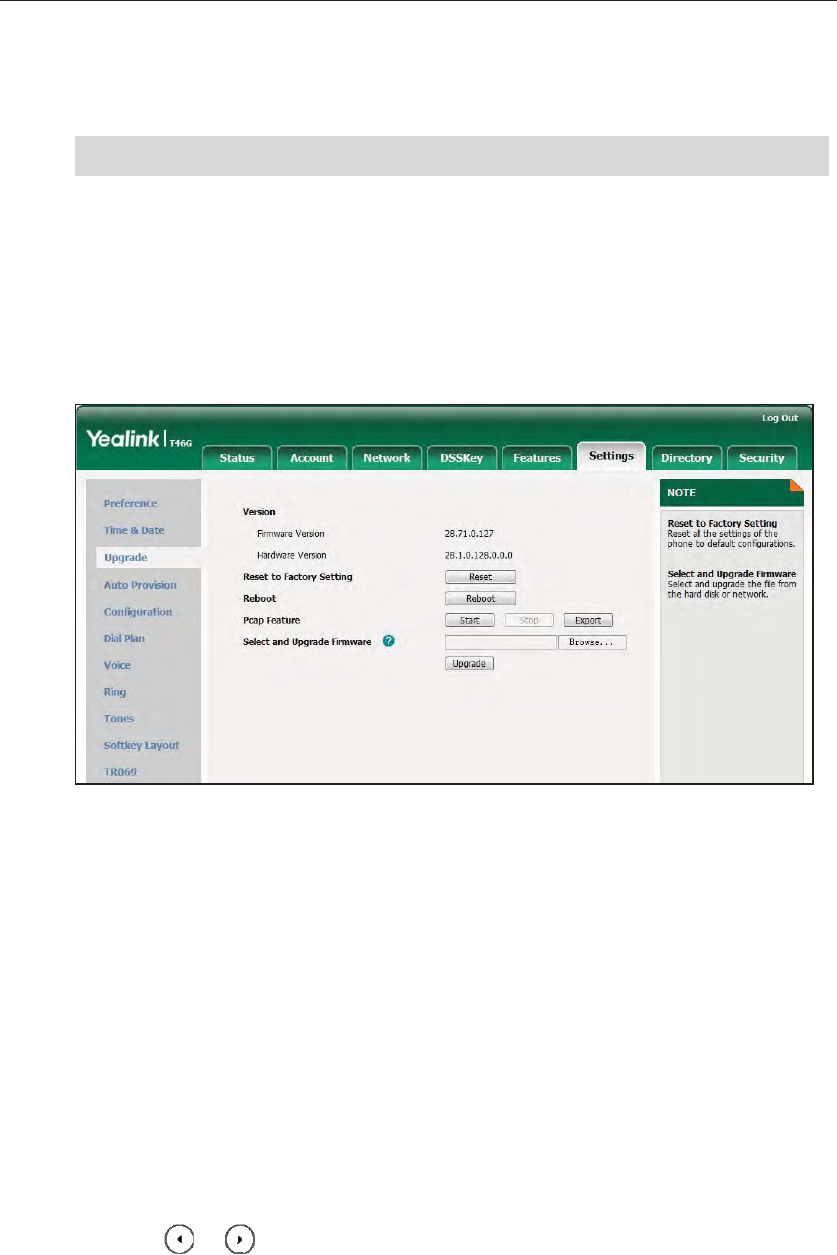
Troubleshooting
161
3. Click Import to import the configuration file.
Note
How to upgrade firmware?
To upgrade firmware via web user interface:
1. Click on Settings->Upgrade.
2. Click Browse to locate the firmware from your local system.
3. Click Upgrade to upgrade the firmware.
The browser pops up the dialog box “Firmware of the SIP Phone will be updated. It
will take 5 minutes to complete. Please don't power off!”.
4. Click OK to confirm upgrading.
How to reset the phone?
Reset the phone to factory configurations after you have tried almost all
troubleshooting suggestions but do not solve the problem. You need to note that all
customized settings will be overwritten after reset.
To reset the phone via phone user interface:
1. Press Menu->Advanced (password: admin) ->Reset & Reboot->Reset to Factory.
2. Press or , or the Switch soft key to select the desired type from Reset Option
field.
3. Press the Save soft key.
The file format of configuration file must be .bin.
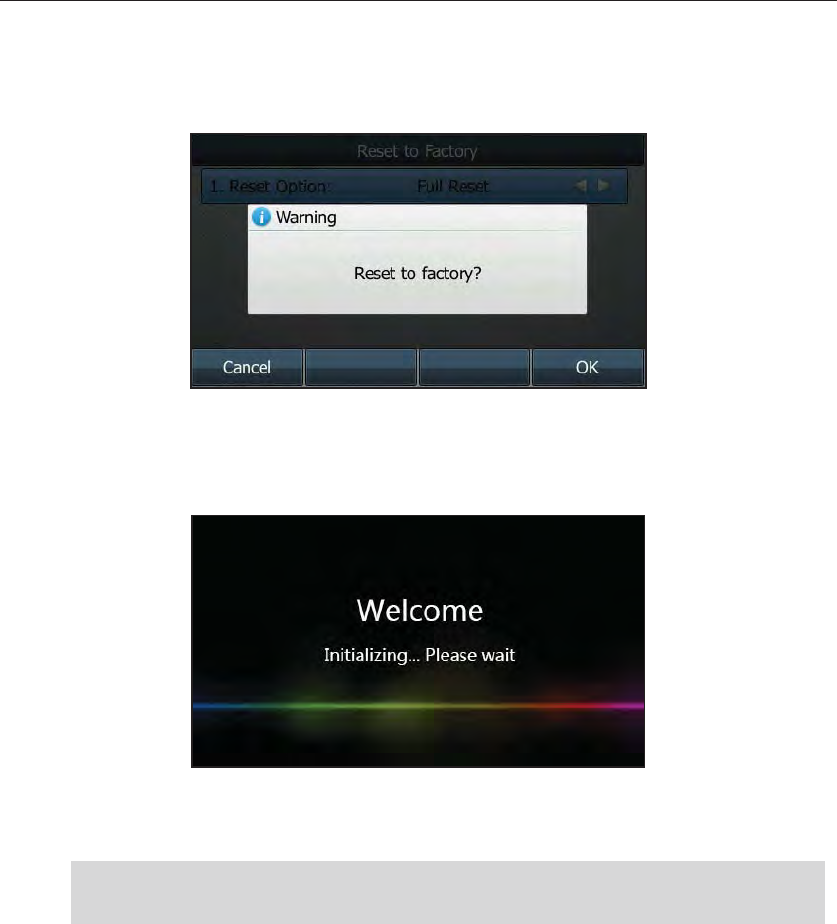
User Guide for the SIP-T48G IP Phone
162
The LCD screen prompts the following warning:
4. Press the OK soft key.
The LCD screen prompts “Welcom Initializing…Please wait”.
The phone will be reset to factory sucessfully after startup.
Note Reset of the phone may take a few minutes. Do not power off until the phone starts up
successfully.

Troubleshooting
163

User Guide for the SIP-T48G IP Phone
164
4GIWNCVQT[0QVKEGU
5GTXKEG#ITGGOGPVU
Contact your Yealink Authorized Reseller for information about service agreements
applicable to your product.
.KOKVCVKQPUQH.KCDKNKV[
TO THE FULL EXTENT ALLOWED BY LAW, YEALINK EXCLUDES FOR ITSELFAND ITS SUPPLIERS
ANY LIABILITY, WHETHER BASED IN CONTRACT OR TORT (INCLUDINGNEGLIGENCE), FOR
INCIDENTAL, CONSEQUENTIAL, INDIRECT, SPECIAL, OR PUNITIVE DAMAGES OFANY KIND,
OR FOR LOSS OF REVENUE OR PROFITS, LOSS OF BUSINESS, LOSS OF INFORMATION
ORDATA, OR OTHER FINANCIAL LOSS ARISING OUT OF OR IN CONNECTION WITH THE
SALE,INSTALLATION, MAINTENANCE, USE, PERFORMANCE, FAILURE, OR INTERRUPTION OF
ITS PRODUCTS,EVEN IF YEALINK OR ITS AUTHORIZED RESELLER HAS BEEN ADVISED OF THE
POSSIBILITY OF SUCHAMAGES, AND LIMITS ITS LIABILITY TO REPAIR, REPLACEMENT, OR
REFUND OF THE PURCHASERICE PAID, AT YEALINK’S OPTION. THIS DISCLAIMER OF
LIABILITY FOR DAMAGES WILL NOT BEAFFECTED IF ANY REMEDY PROVIDED HEREIN SHALL
FAIL OF ITS ESSENTIAL PURPOSE.
5CHGV[+PUVTWEVKQPU
Save these instructions. Read these safety instructions before use!
The following basic safety precautions should always be followed to reduce risk of fire,
electrical shock, and other personal injury.
General Requirements
zBefore you install and use the device, read the safety instructions carefully
and observe the situation during operation.
zDuring the process of storage, transportation, and operation, please always
keep the device dry and clean.
zDuring the process of storage, transportation, and operation, please avoid
collision and crash of the device.
zPlease attempt not to dismantle the device by yourself. In case of any
discrepancy, please contact the appointed maintenance center for repair.
zWithout prior written consent, no organization or individual is permitted to
make any change to the structure or the safety design of the device.
Yealink is under no circumstance liable to consequences or legal issues
caused by such changes.
zPlease refer to the relevant laws and statutes while using the device. Legal
rights of others should be respected as well.
Environmental Requirements
zPlace the device at a well-ventilated place. Do not expose the device
under direct sunlight.
zKeep the device dry and free of dusts.
zPlace the device on a stable and level platform.

Regulatory Notices
165
zPlease place no heavy objects on the device in case of damageand
deformation caused by the heavy load.
zKeep at least 10 cm between the device and the closest object for heat
dissipation.
zDo not place the device on or near any inflammable or fire-vulnerable
object, such as rubber-made materials.
zKeep the device away from any heat source or bare fire, such as a candle
or an electric heater.
zKeep the device away from any household appliance with strong magnetic
field or electromagnetic field, such as a microwave oven or a refrigerator.
Operating Requirements
zDo not let a child operate the device without guidance.
zDo not let a child play with the device or any accessory in case of
accidental swallowing.
zPlease use the accessories provided or authorized by the manufacturer only.
zThe power supply of the device shall meet the requirements of the input
voltage of the device. Pleaseuse the provided surge protection power
socket only.
zBefore plugging or unplugging any cable, make sure that your hands are
completely dry.
zDo not spill liquid of any kind on the product or use the equipment near
water, for example, near a bathtub, washbowl, kitchen sink, wet basement
or near a swimming pool.
zDo not tread on, pull, or over-bend any cable in case of malfunction of the
device.
zDuring a thunderstorm, stop using the device and disconnect it from the
power supply. Unplug the power plug and the Asymmetric Digital Subscriber
Line (ADSL) twisted pair (the radio frequency cable) to avoid lightning strike.
zIf the device is left unused for a rather long time, disconnect it from the
power supply and unplug the power plug.
zWhen there is smoke emitted from the device, or some abnormal noise or
smell, disconnect the device from the power supply, and unplug the power
plug immediately. Contact the specified maintenance center for repair.
zDo not insert any object into equipment slots that is not part of the product
or auxiliary product.
zBefore connecting a cable, connect the grounding cable of the device first.
Do not disconnect the grounding cable until you disconnect all other
cables.
Cleaning Requirements
zBefore cleaning the device, stop using it and disconnect it from the power
supply.
zUse a piece of soft, dry and anti-static cloth to clean the device.
zKeep the power plug clean and dry. Using a dirty or wet power plug may
lead to electric shock or other perils.

User Guide for the SIP-T48G IP Phone
166

Appendix A-Time Zones
167
#RRGPFKZ#6KOG<QPGU
Time Zone Time Zone Name
11:00 Samoa
10:00 United States-Hawaii-Aleutian
10:00 United States-Alaska-Aleutian
09:00 United States-Alaska Time
08:00 Canada(Vancouver, Whitehorse)
08:00 Mexico(Tijuana, Mexicali)
08:00 United States-Pacific Time
07:00 Canada(Edmonton, Calgary)
07:00 Mexico(Mazatlan, Chihuahua)
07:00 United States-Mountain Time
07:00 United States-MST no DST
06:00 Canada-Manitoba(Winnipeg)
06:00 Chile(Easter Islands)
06:00 Mexico(Mexico City, Acapulco)
06:00 United States-Central Time
05:00 Bahamas(Nassau)
05:00 Canada(Montreal, Ottawa, Quebec)
05:00 Cuba(Havana)
05:00 United States-Eastern Time
04:30 Venezuela(Caracas)
04:00 Canada(Halifax, Saint John)
04:00 Chile(Santiago)
04:00 Paraguay(Asuncion)
04:00 United Kingdom-Bermuda(Bermuda)
04:00 United Kingdom(Falkland Islands)
04:00 Trinidad&Tobago
03:30 Canada-New Foundland(St.Johns)
03:00 Denmark-Greenland(Nuuk)
03:00 Argentina(Buenos Aires)
03:00 Brazil(no DST)
03:00 Brazil(DST)
02:00 Brazil(no DST)
01:00 Portugal(Azores)
0 GMT
0 Greenland
0 Denmark-Faroe Islands(Torshavn)
0 Ireland(Dublin)
0 Portugal(Lisboa, Porto, Funchal)
0 Spain-Canary Islands(Las Palmas)
0 United Kingdom(London)
0 Morocco
+01:00 Albania(Tirane)
+01:00 Austria(Vienna)
+01:00 Belgium(Brussels)
+01:00 Caicos
+01:00 Chad
+01:00 Croatia(Zagreb)
+01:00 Czech Republic(Prague)
+01:00 Denmark(Kopenhagen)
+01:00 France(Paris)
+01:00 Germany(Berlin)
+01:00 Hungary(Budapest)
+01:00 Italy(Rome)
+01:00 Luxembourg(Luxembourg)

User Guide for the SIP-T48G IP Phone
168
Time Zone Time Zone Name
+01:00 Macedonia(Skopje)
+01:00 Netherlands(Amsterdam)
+01:00 Namibia(Windhoek)
+02:00 Estonia(Tallinn)
+02:00 Finland(Helsinki)
+02:00 Gaza Strip(Gaza)
+02:00 Greece(Athens)
+02:00 Israel(Tel Aviv)
+02:00 Jordan(Amman)
+02:00 Latvia(Riga)
+02:00 Lebanon(Beirut)
+02:00 Moldova(Kishinev)
+02:00 Russia(Kaliningrad)
+02:00 Romania(Bucharest)
+02:00 Syria(Damascus)
+02:00 Turkey(Ankara)
+02:00 Ukraine(Kyiv, Odessa)
+03:00 East Africa Time
+03:00 Iraq(Baghdad)
+03:00 Russia(Moscow)
+03:30 Iran(Teheran)
+04:00 Armenia(Yerevan)
+04:00 Azerbaijan(Baku)
+04:00 Georgia(Tbilisi)
+04:00 Kazakhstan(Aktau)
+04:00 Russia(Samara)
+04:30 Afghanistan
+05:00 Kazakhstan(Aqtobe)
+05:00 Kyrgyzstan(Bishkek)
+05:00 Pakistan(Islamabad)
+05:00 Russia(Chelyabinsk)
+05:30 India(Calcutta)
+06:00 Kazakhstan(Astana, Almaty)
+06:00 Russia(Novosibirsk, Omsk)
+07:00 Russia(Krasnoyarsk)
+07:00 Thailand(Bangkok)
+08:00 China(Beijing)
+08:00 Singapore(Singapore)
+08:00 Australia(Perth)
+09:00 Korea(Seoul)
+09:00 Japan(Tokyo)
+09:30 Australia(Adelaide)
+09:30 Australia(Darwin)
+10:00 Australia(Sydney, Melbourne, Canberra)
+10:00 Australia(Brisbane)
+10:00 Australia(Hobart)
+10:00 Russia(Vladivostok)
+10:30 Australia(Lord Howe Islands)
+11:00 New Caledonia(Noumea)
+12:00 New Zealand(Wellington, Auckland)
+12:45 New Zealand(Chatham Islands)
+13:00 Tonga(Nukualofa)

Index
169
+PFGZ
A
About This Guide ix
Account Management 78
Account Registration 78
Adding Contacts 43
Administrator password 31
Anonymous Call 124
Anonymous Call Rejection 125
Answering Calls 92
Area Code 83
Attaching Stand 16
Audio Settings 36
Auto Answer 92
Auto Redial 96
Automatic Call Distribution 141
B
Backlight 26
Basic Network Settings 20
Blacklist 53
Block Out 84
Bluetooth 61
Busy Lamp Field (BLF) 127
C
Call Completion 98
Call Forward 105
Call Mute 100
Call HistoryManagement 57
Call Hold/Resume 100
Call Park 119
Call Pickup 120
Call Recording 130
Call Return 99
Call Transfer 113
Call Waiting 115
CE Mark Warning vi
Conference 116
Contact Management 39
Contrast 27
Copyright v
Customizing Your Phone 25
D
Declaration of Conformity vi
Deleting Contacts 47
Dial-now 82
Dial Plan 79
Do Not Disturb (DND) 101
Documentation 11
DSS Keys 66
E
Editing Contacts 46
Emergency Number 85
Ending Calls 94
G
General Settings 25
Getting Started 14
H
Hardware Component Instructions 4
Headset Use 59
Headset Mode Activation/Deactivation
59
Hotline 87
Hot Desking 132
I
Icon Instructions 6
Idle screen 22
Importing/Exporting Contact lists 52
In This Guide v
Incoming Intercom Calls 135
Intercom 134
K
Key as Send 32
Keypad Lock 32
L
Language 28
LED Instructions 8
Limitation of Liability 164
Line Keys 66
Live Dialpad 86
Local Conference 116
Local Directory 41
M
Message Waiting Indicator 149
Messages 144
Multicast Paging 137
Multiple Line Keys per Account 79
Music on Hold 140
N
Network Conference 117
Network Connection 16
P
Packaging Contents 14
Phone Initialization 19
Phone Installation 16
Phone Status 19
Phone User Interface 9

User Guide for the SIP-T48G IP Phone
170
Placing Calls 90
Placing Calls to Contacts 49
Programmable Keys 77
O
Outgoing Intercom Calls 134
Overview 4
R
Recent Call In Dialing 94
Redialing Numbers 94
Registration 22
Regulatory Notices 164
Remote Phone Book 55
Replace Rule 80
Ring Tones 37
S
Safety Instructions 164
Search Source List in Dialing 50
Searching for Contacts 49
Semi-attended Transfer 113
Service Agreements 164
Short Message Service (SMS) 144
System Customizations 59
T
Time & Date 29
Time Zones 167
Troubleshooting 153
V
Voice Mail 147
Volume 36
W
Warranty vi
Wallpaper 25
Web User Interface 9
WEEE Warning vii